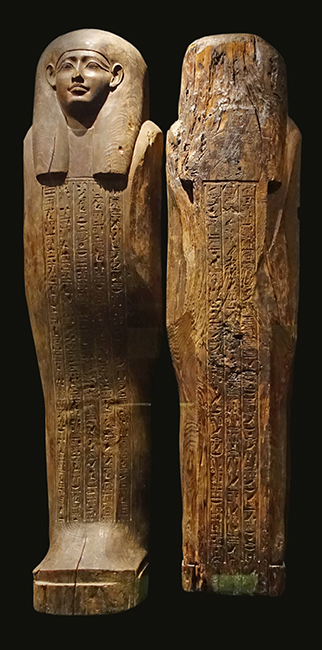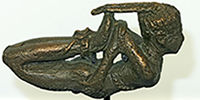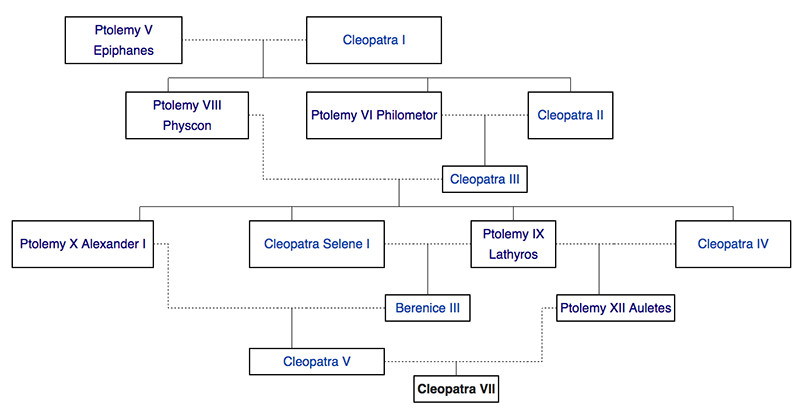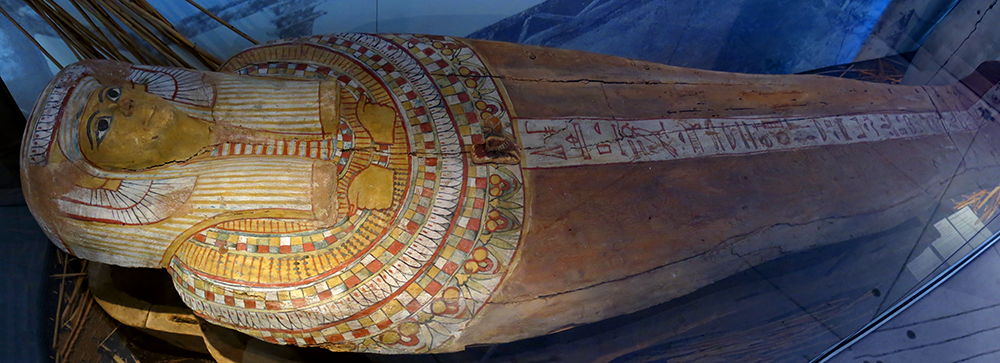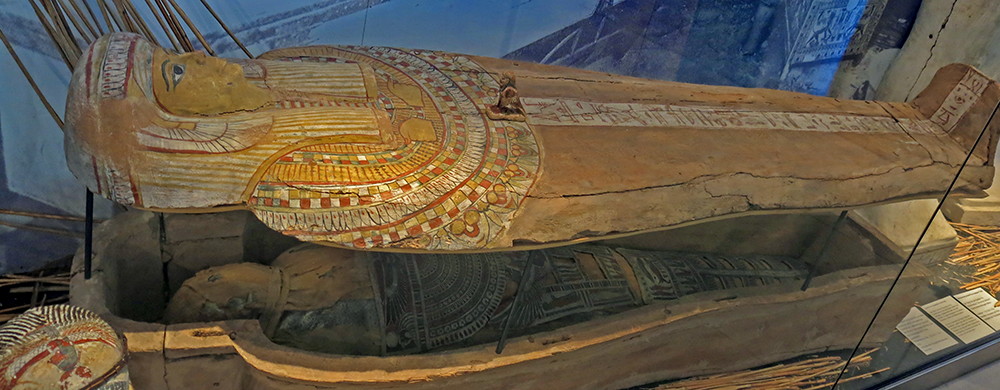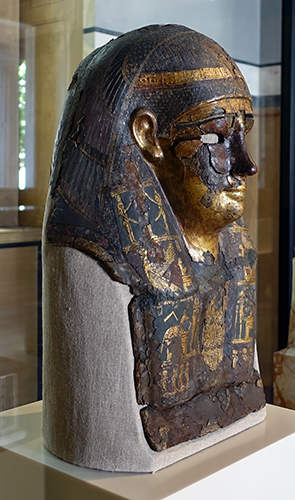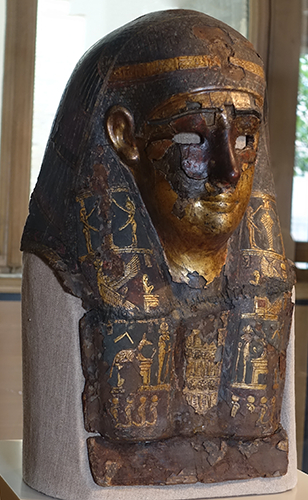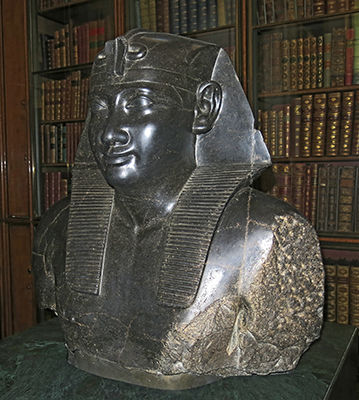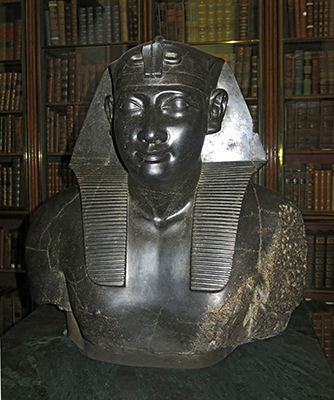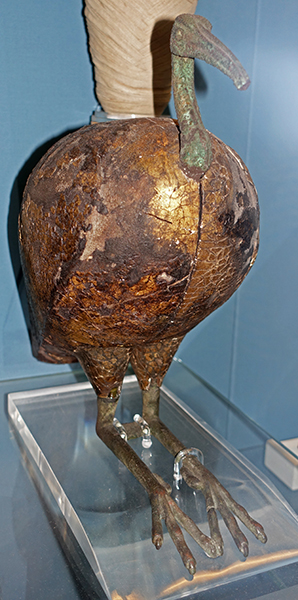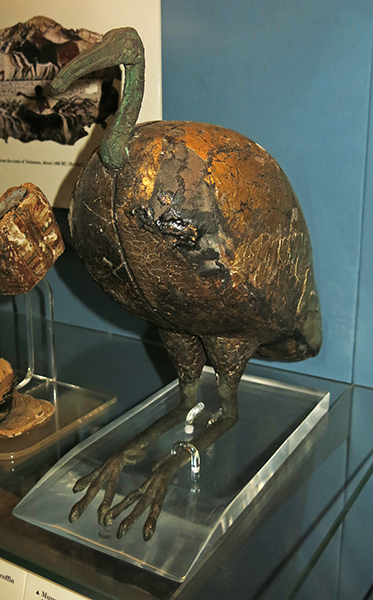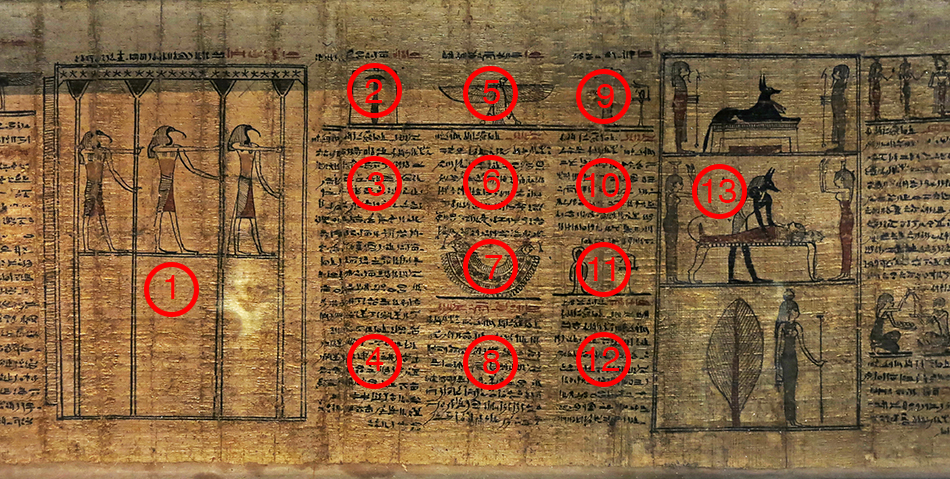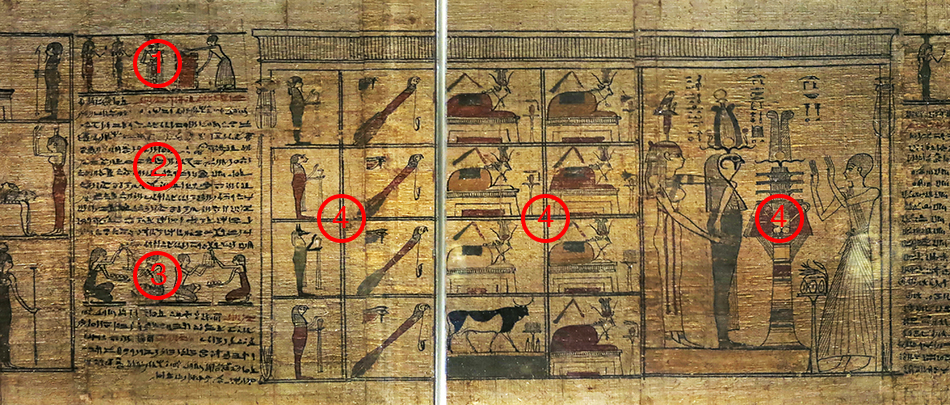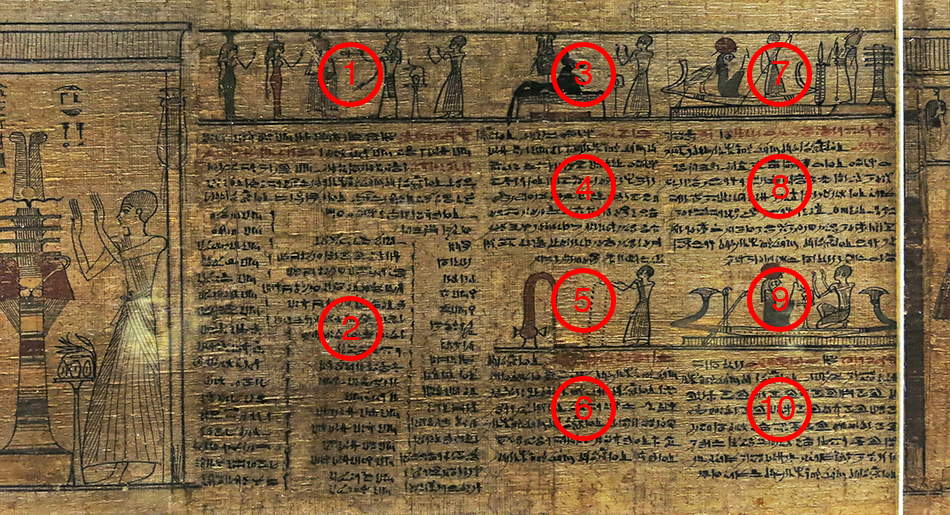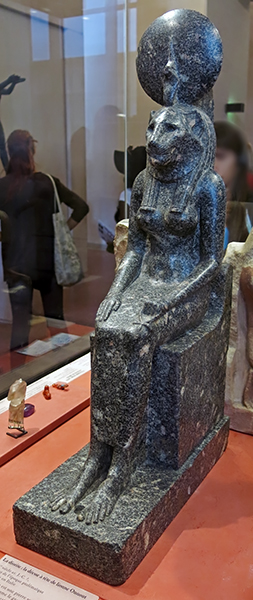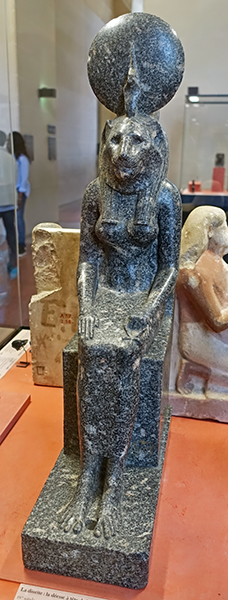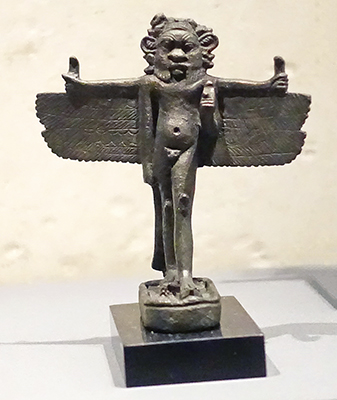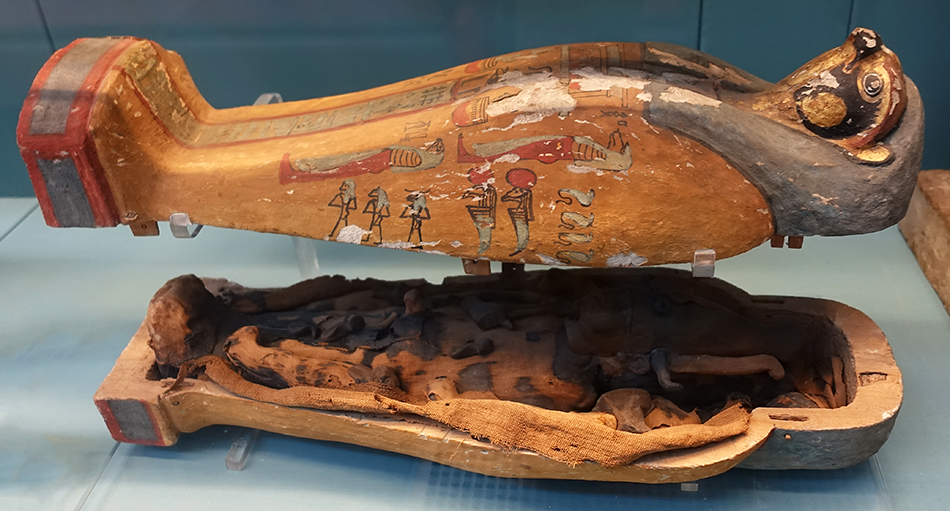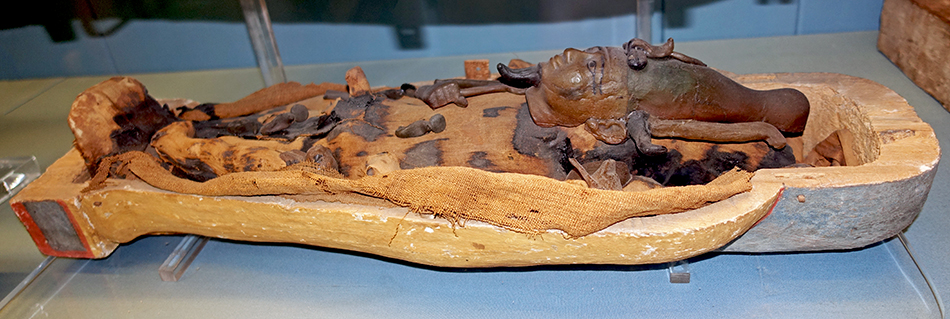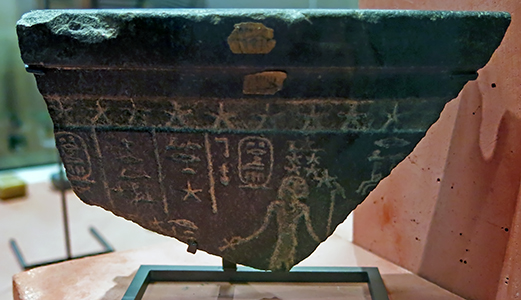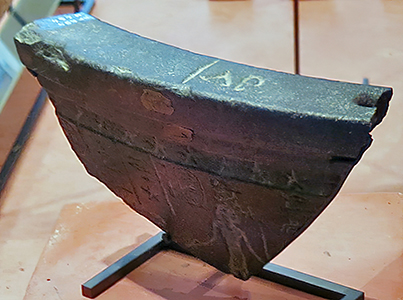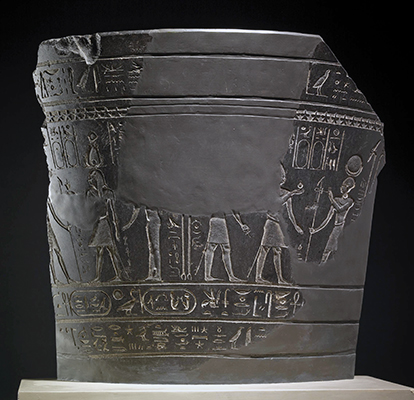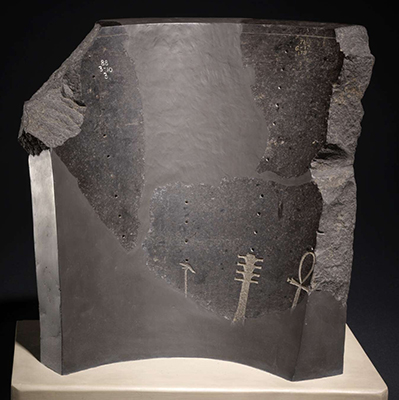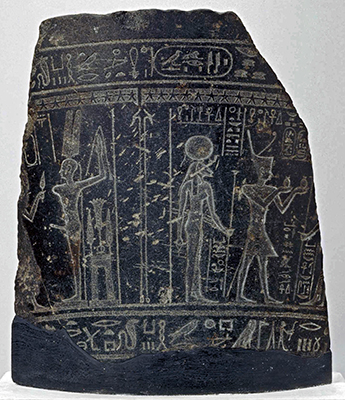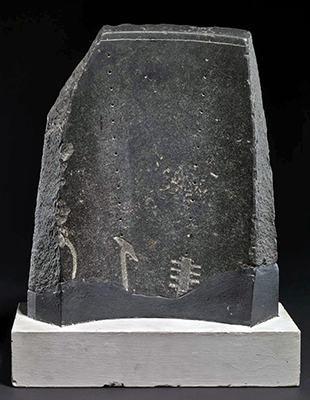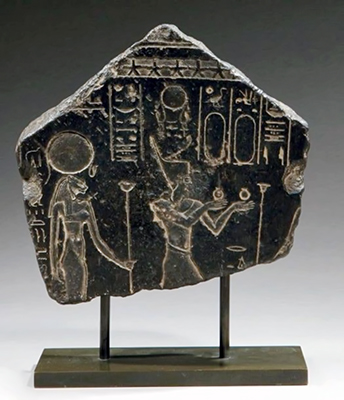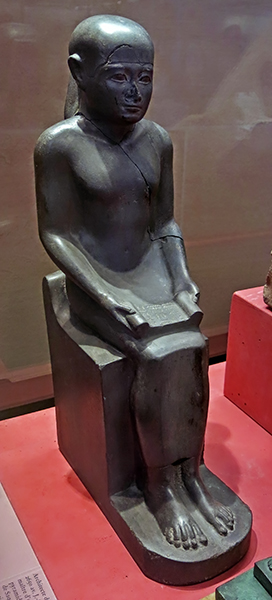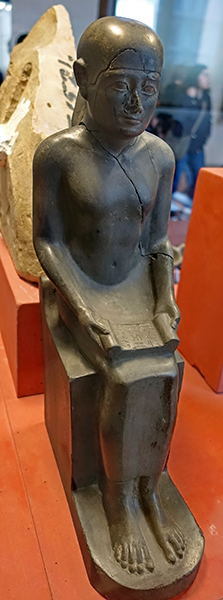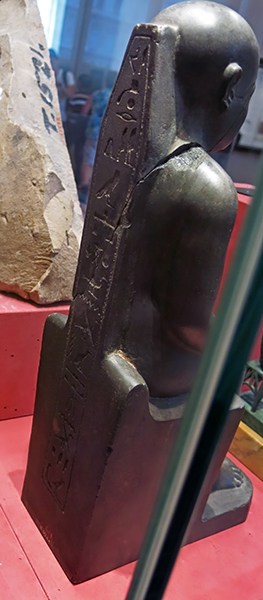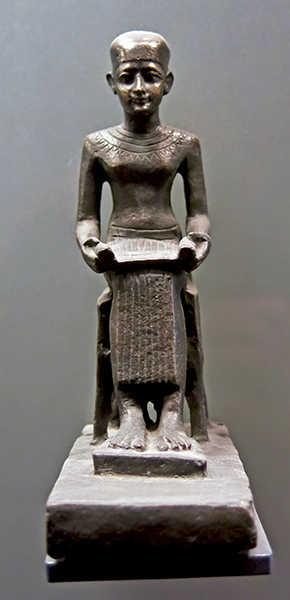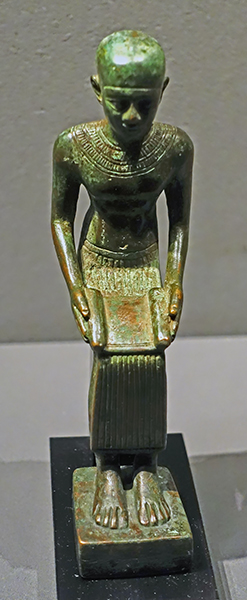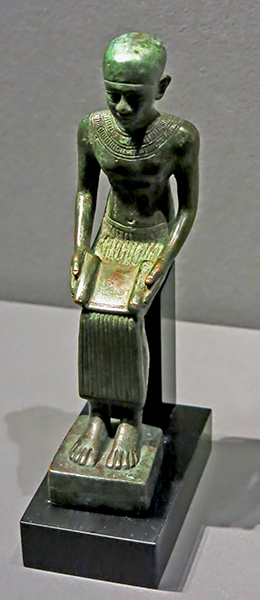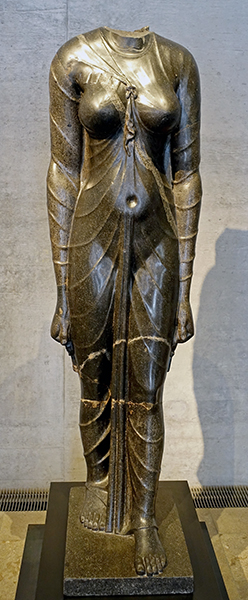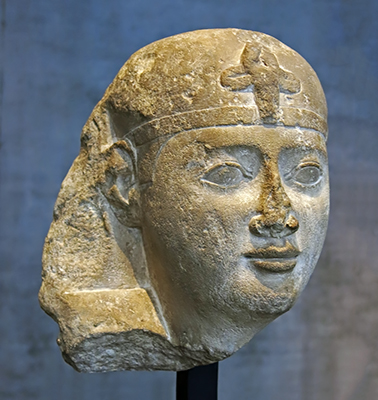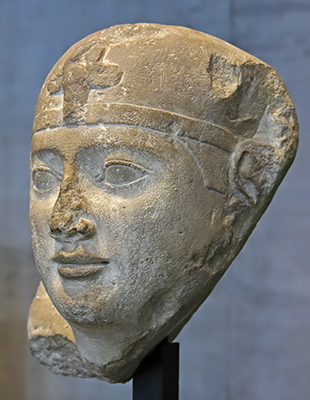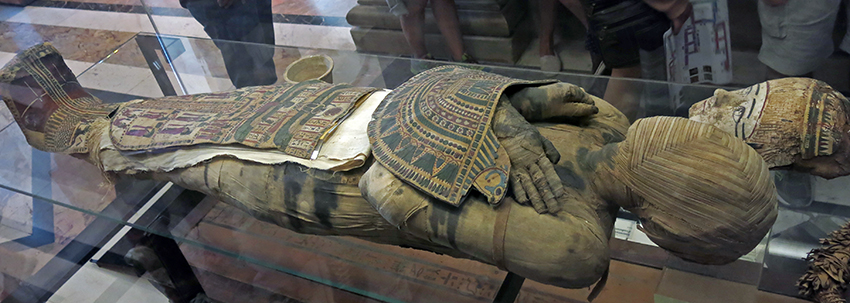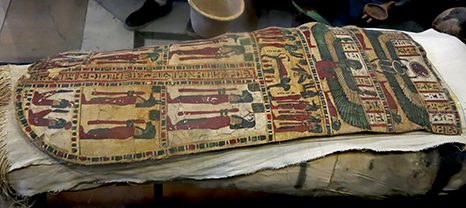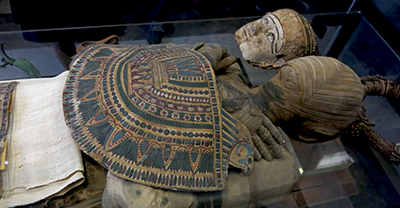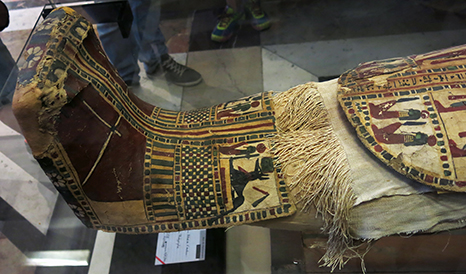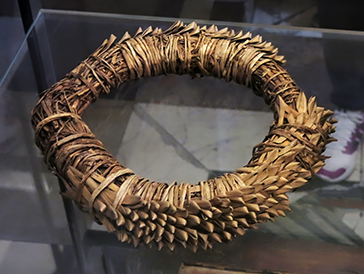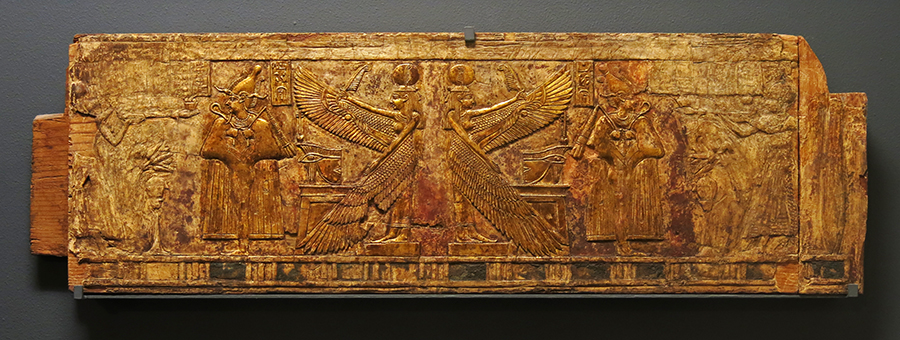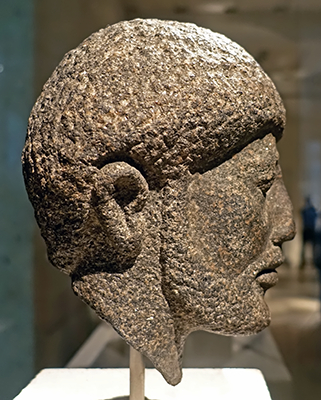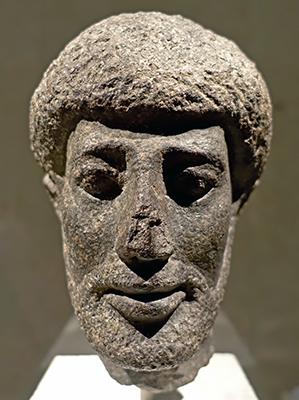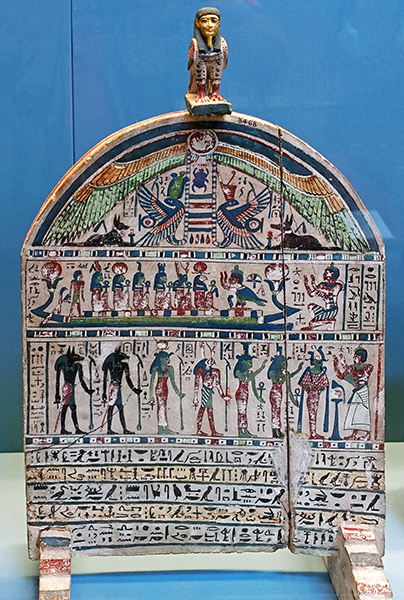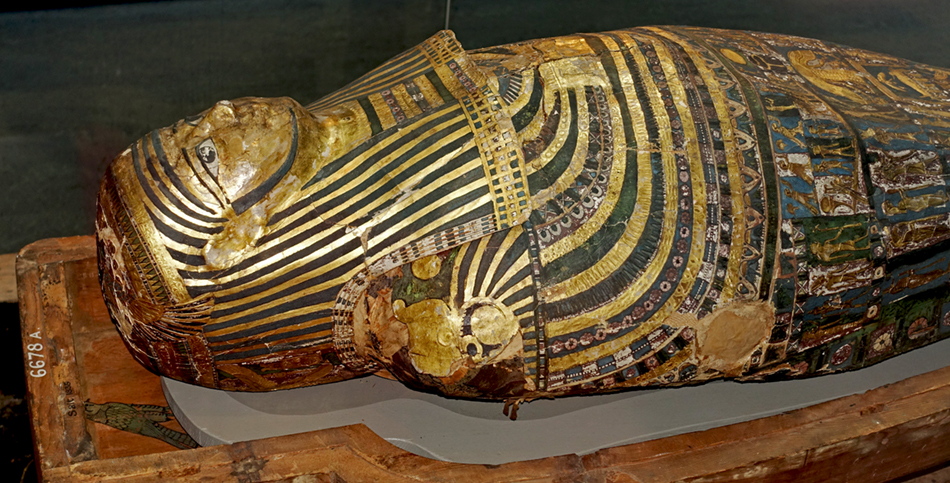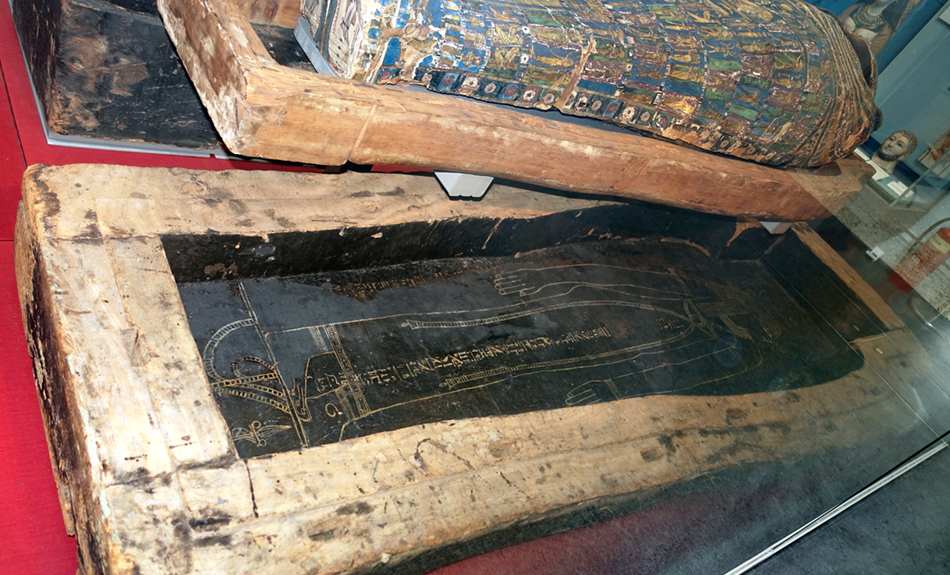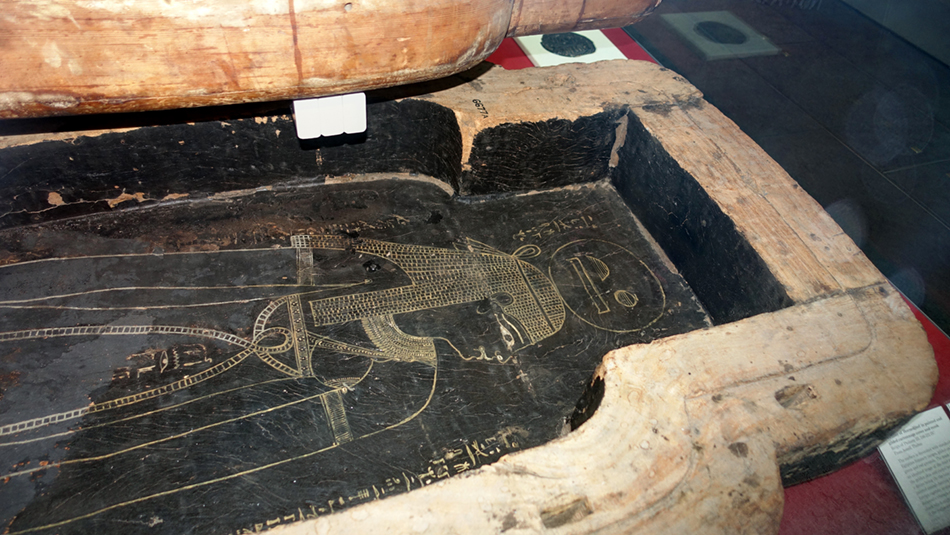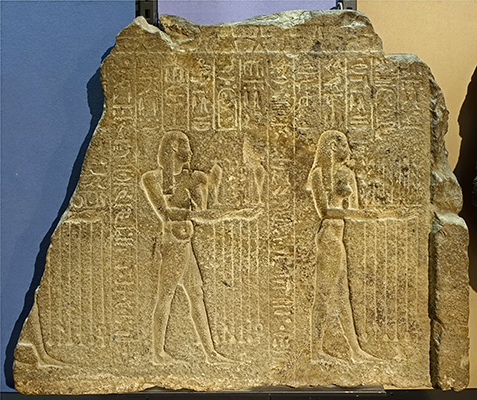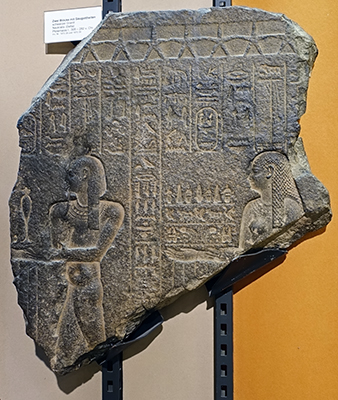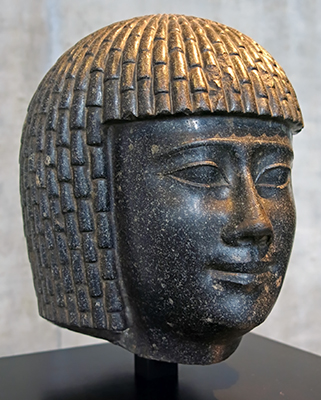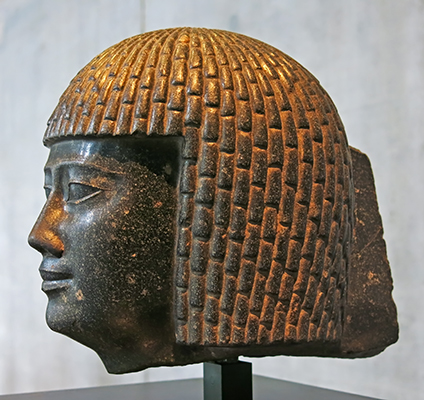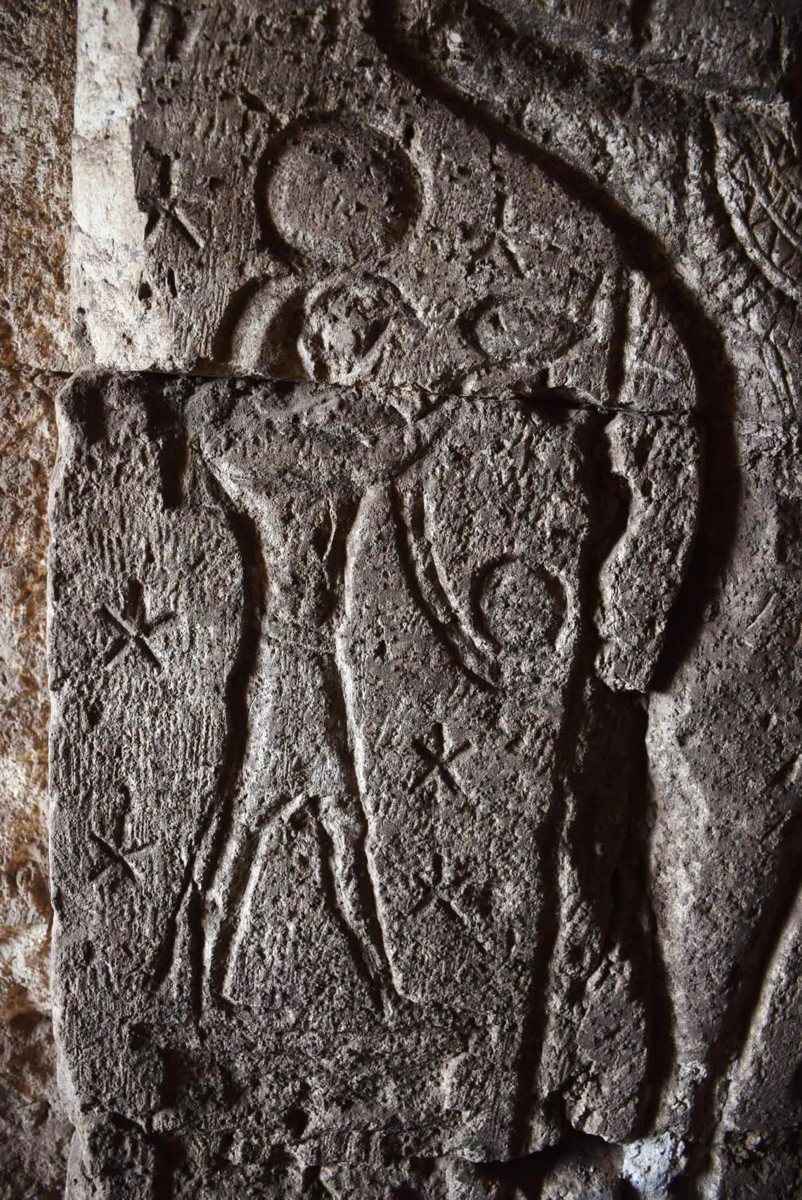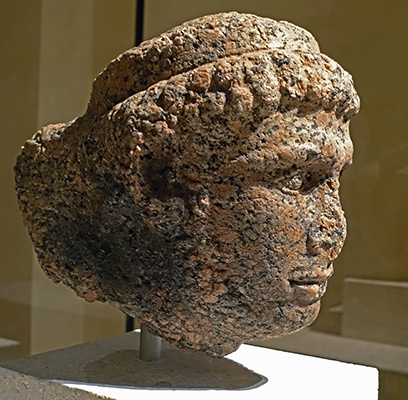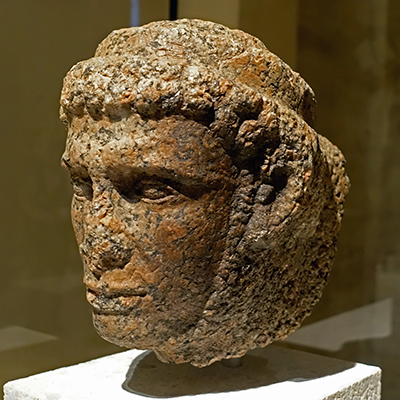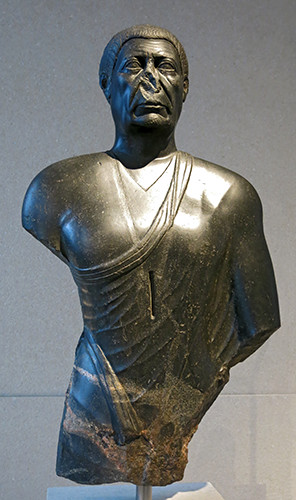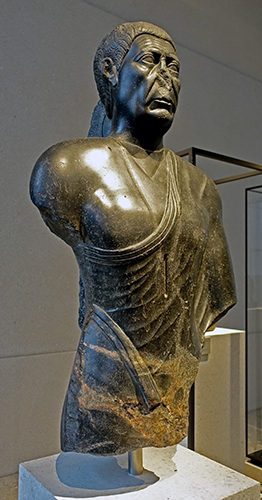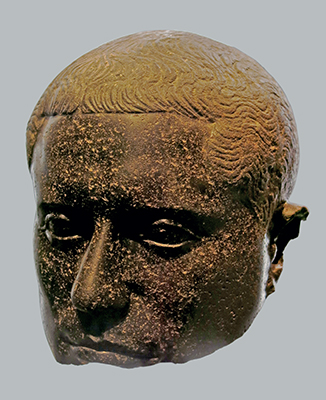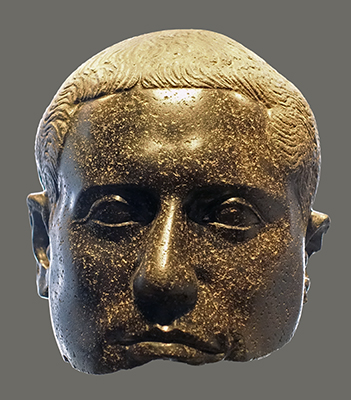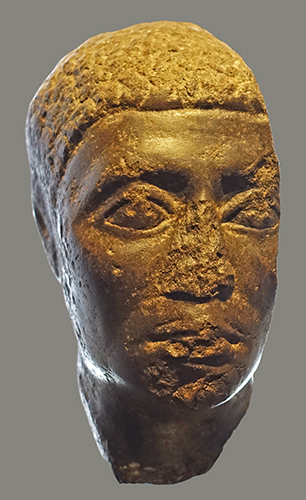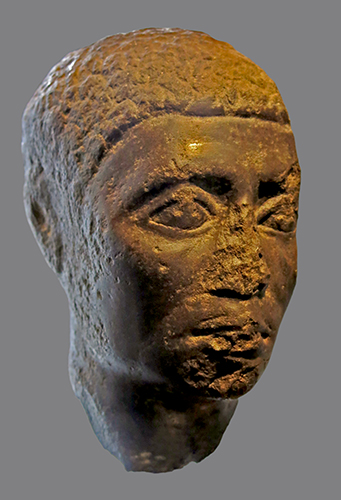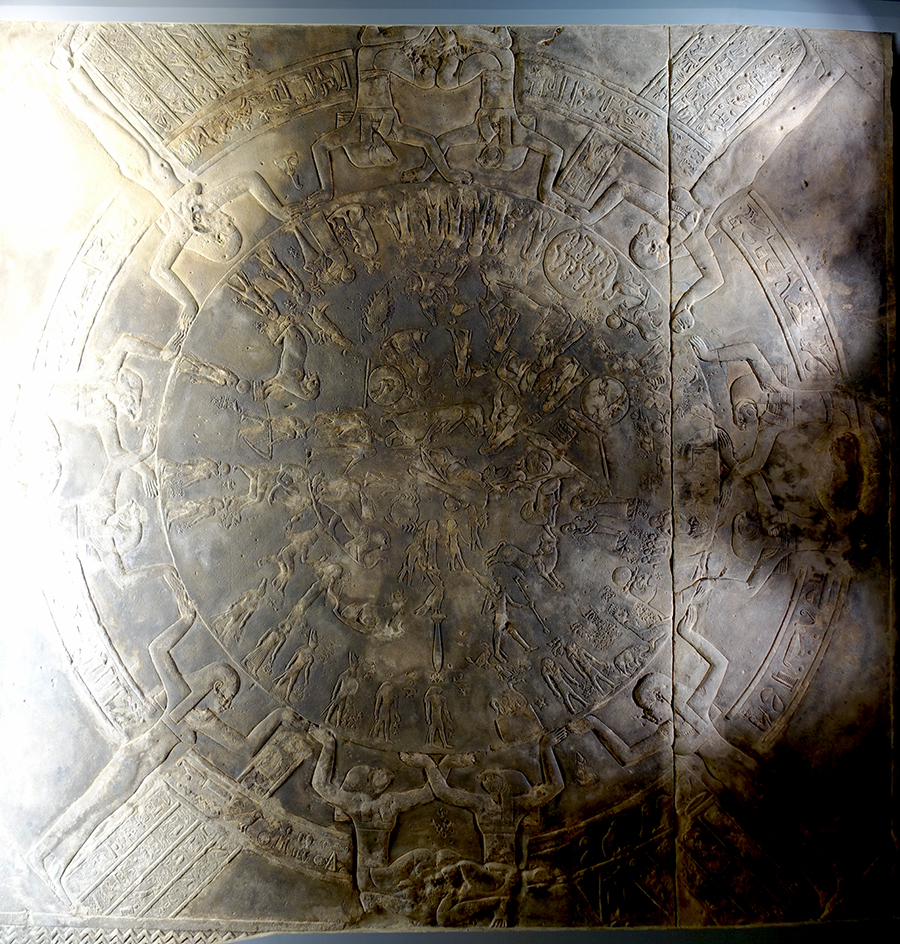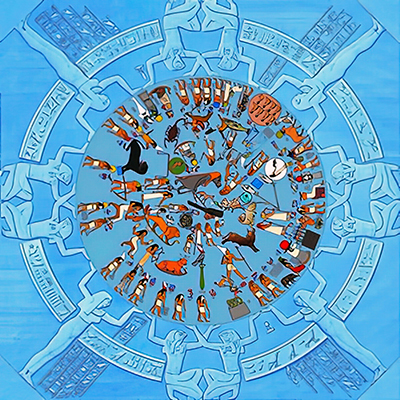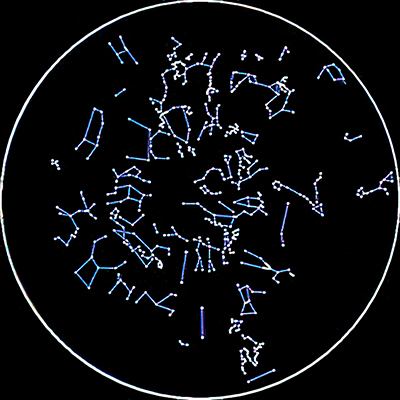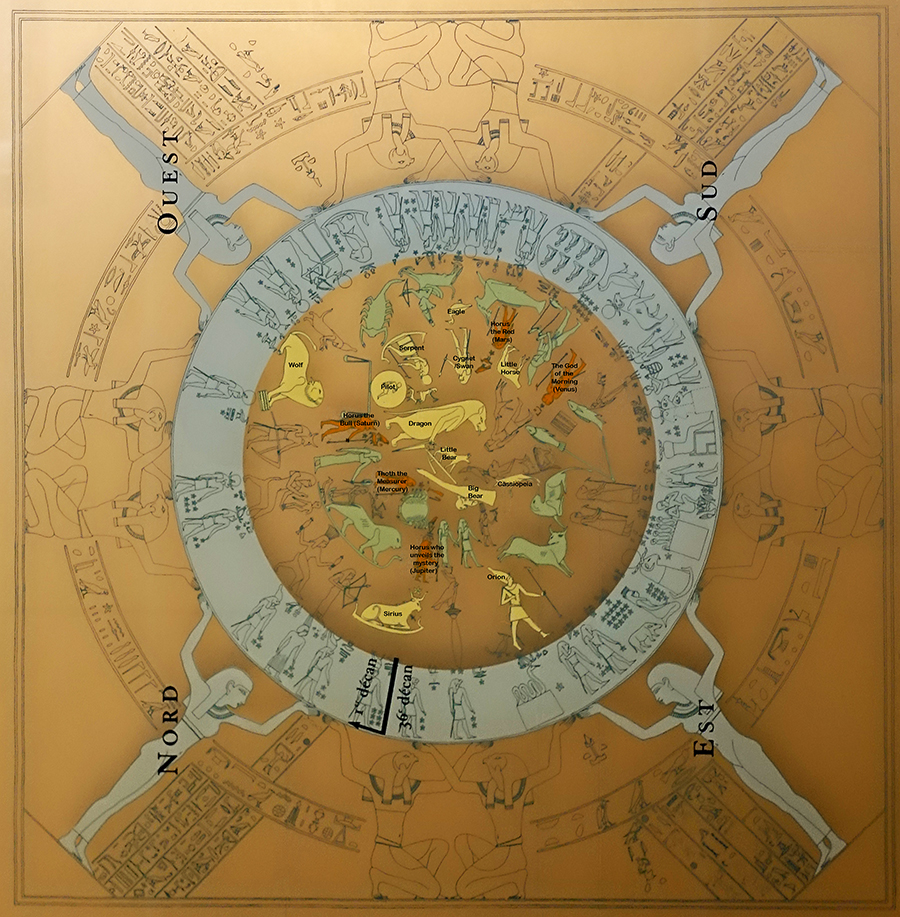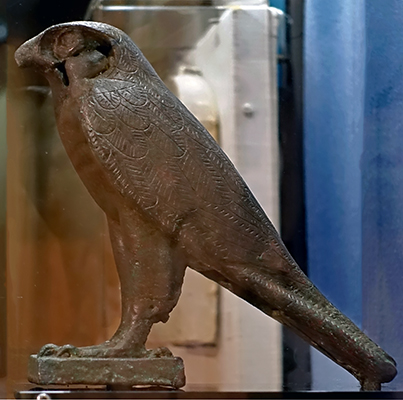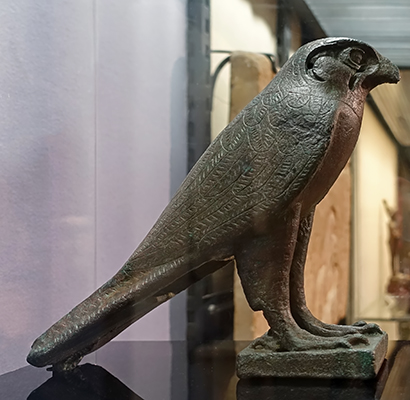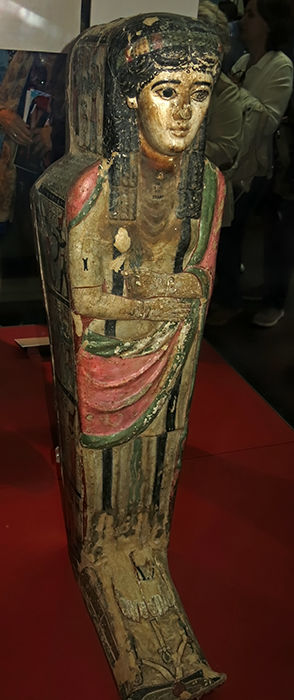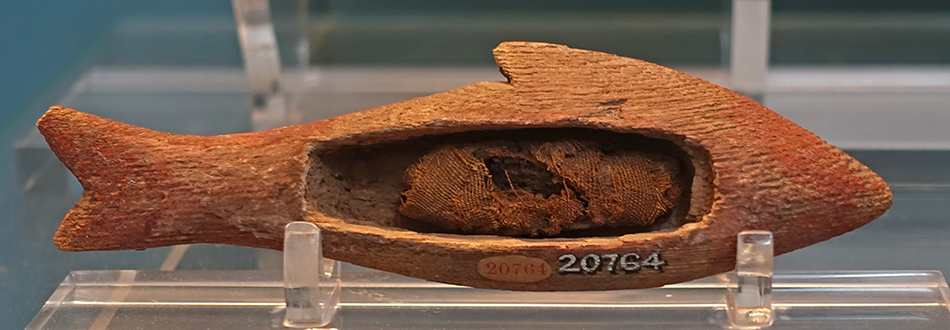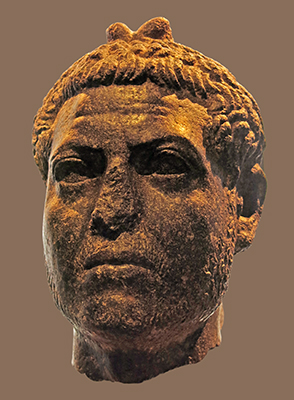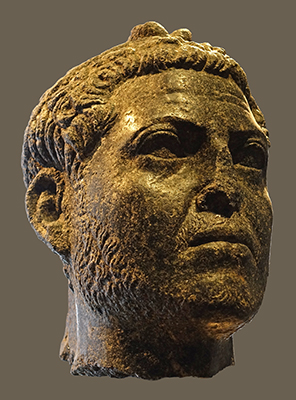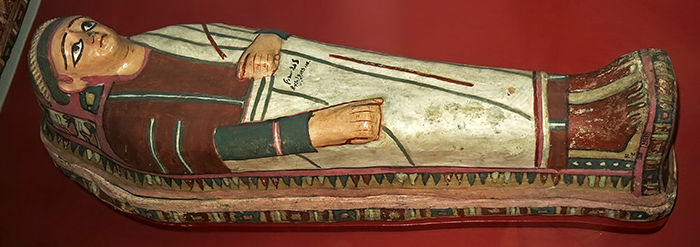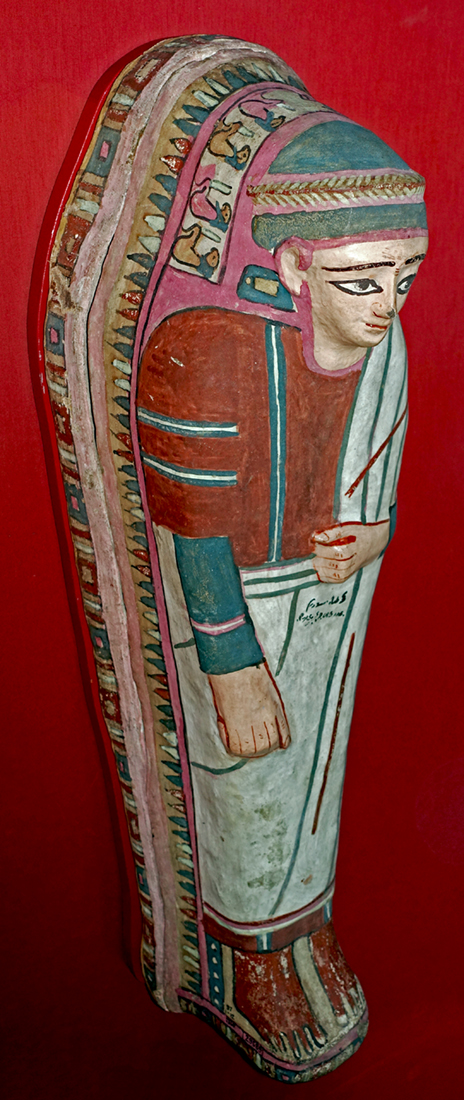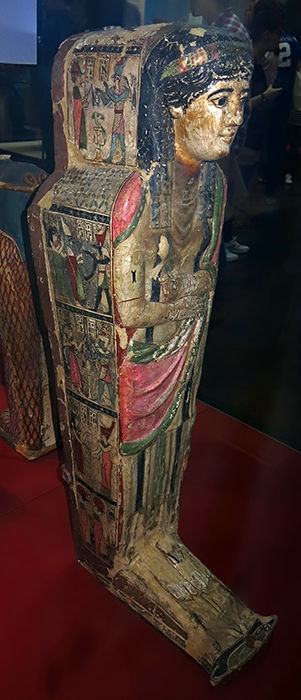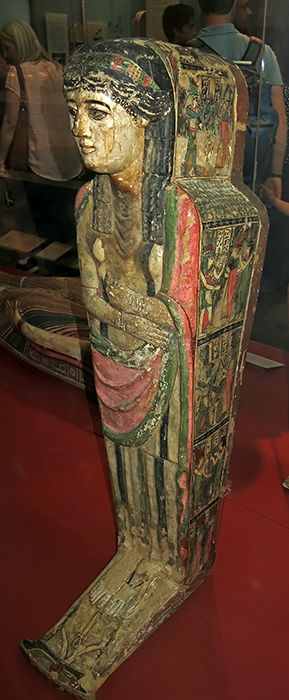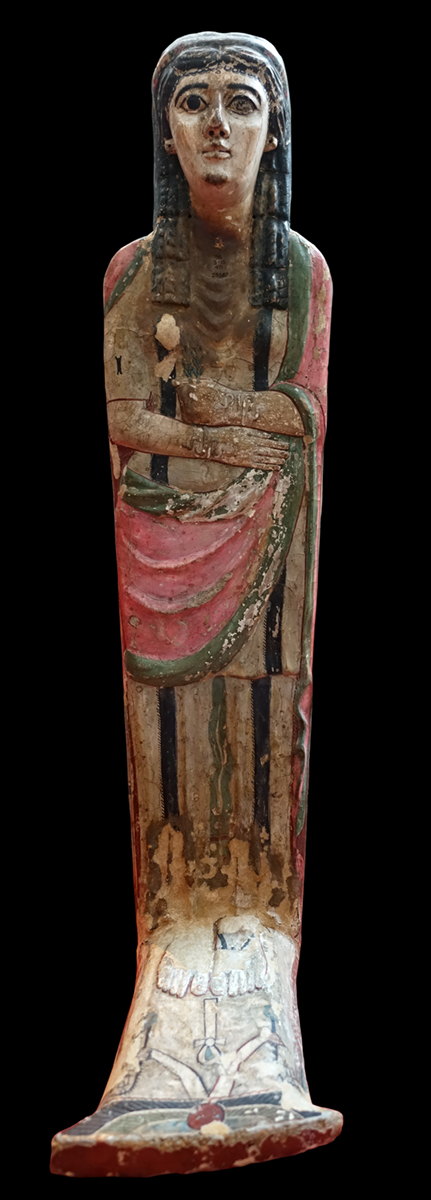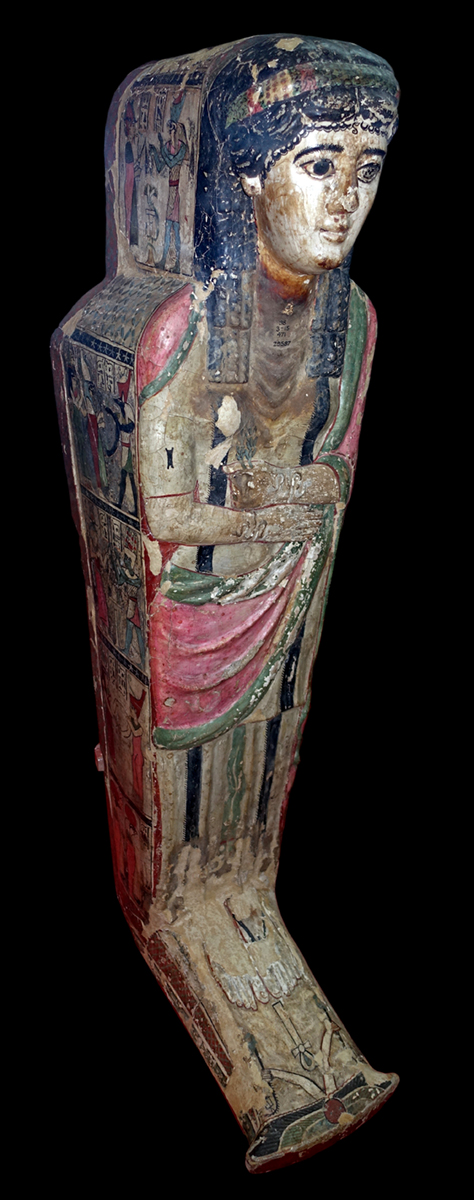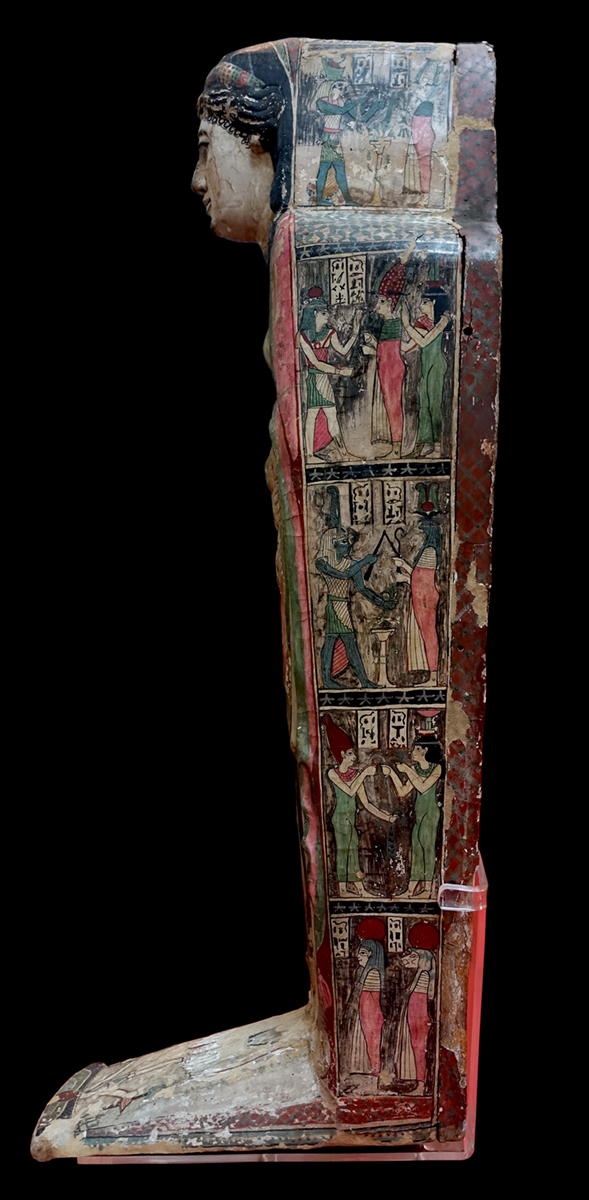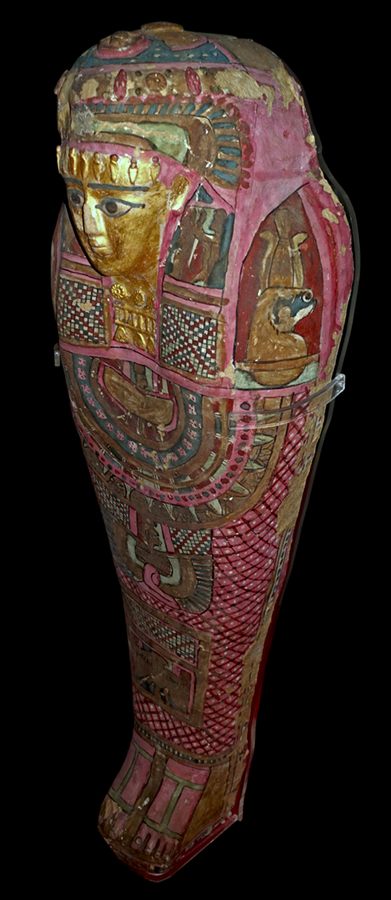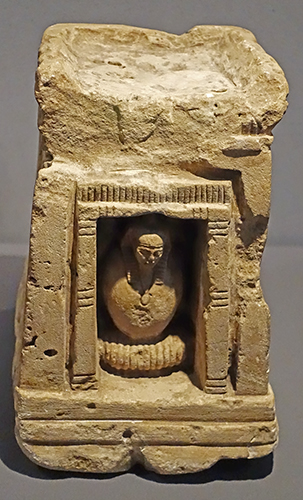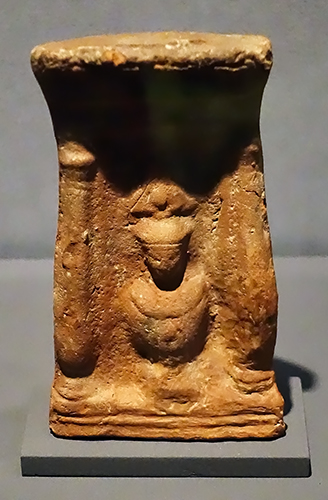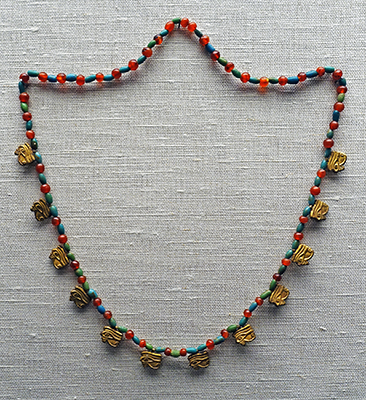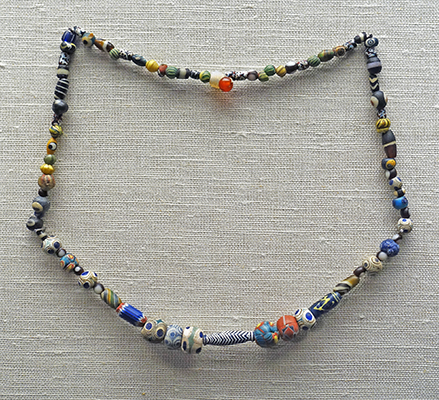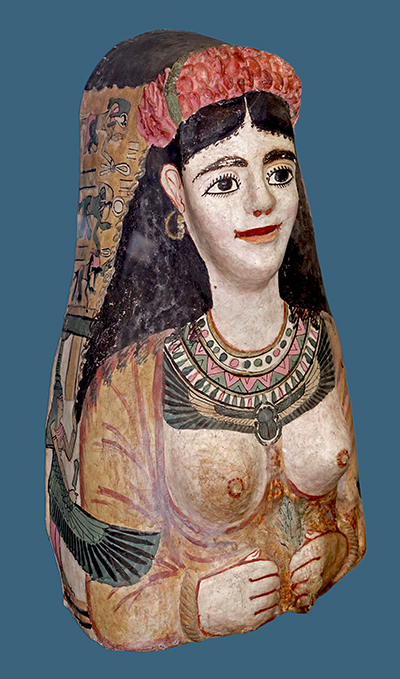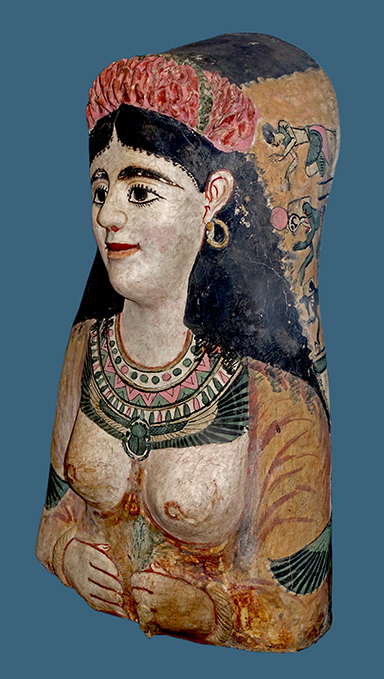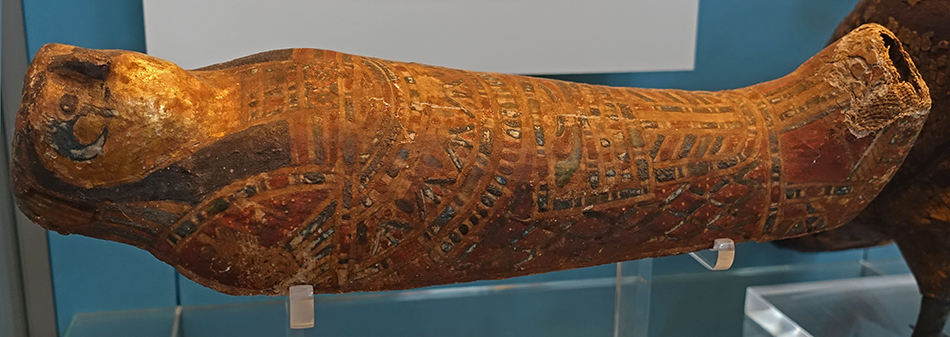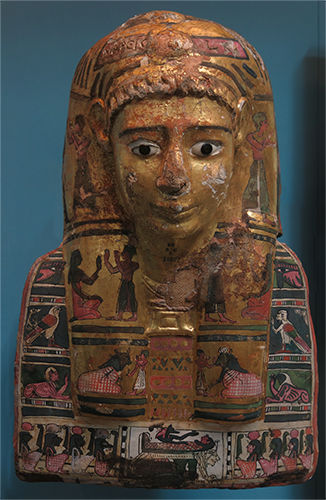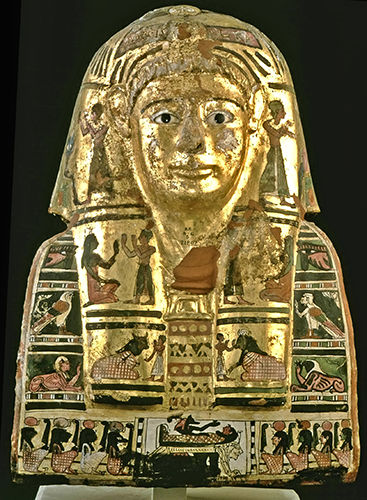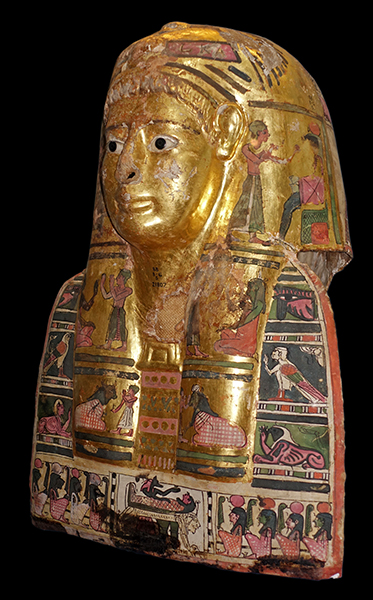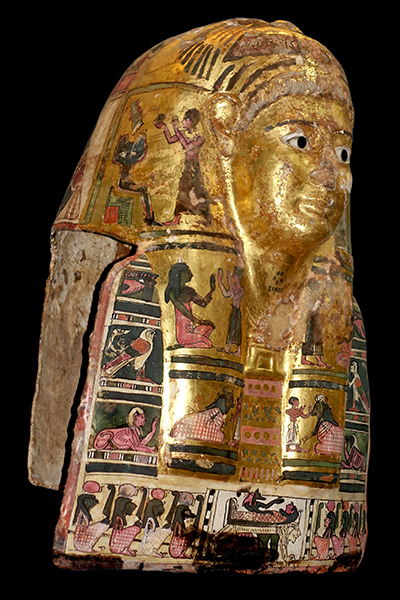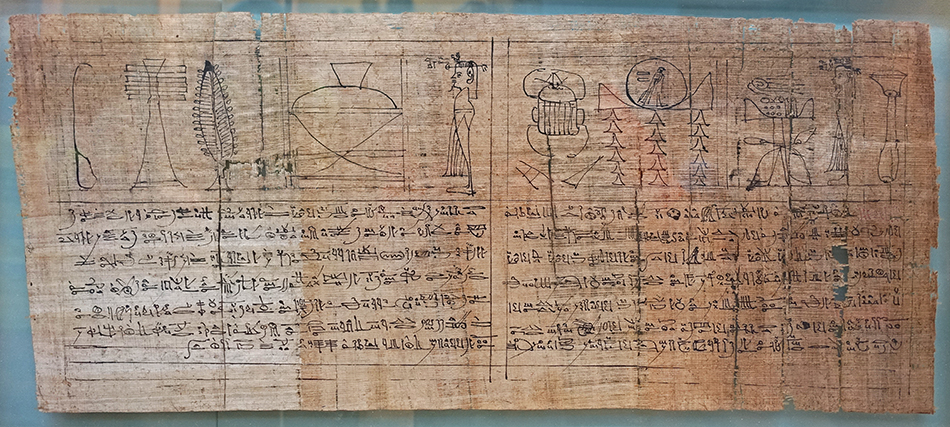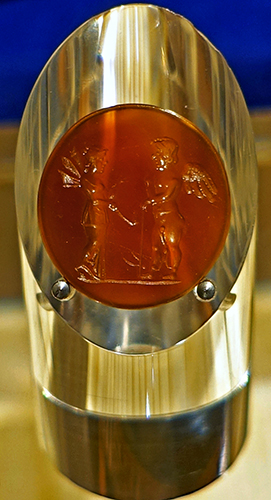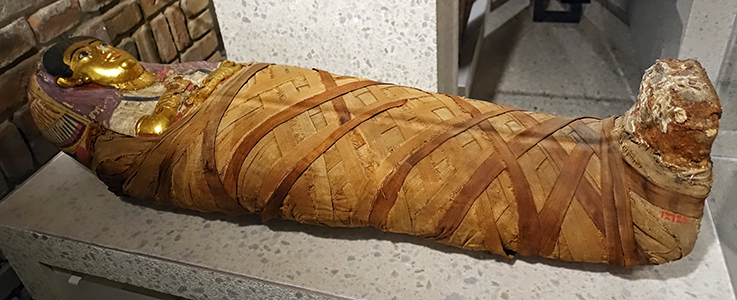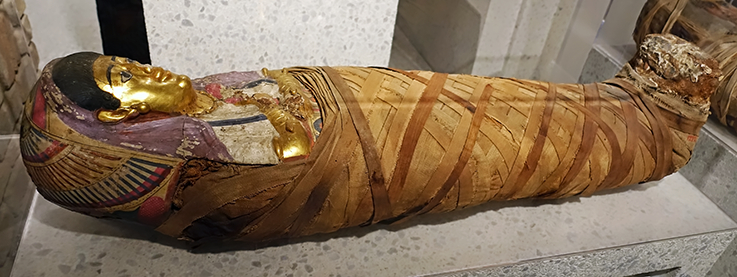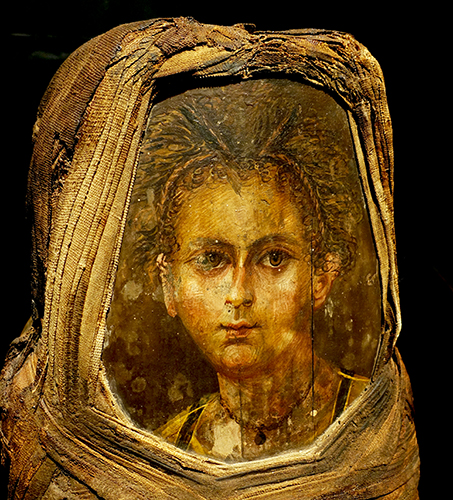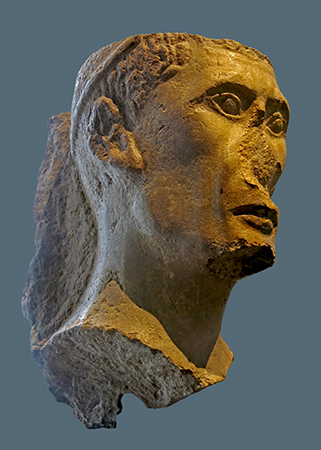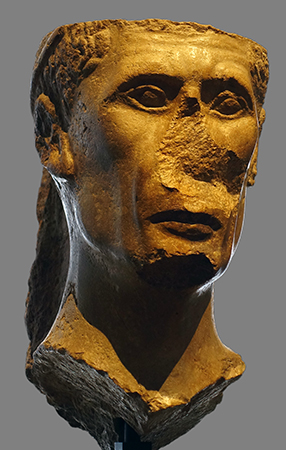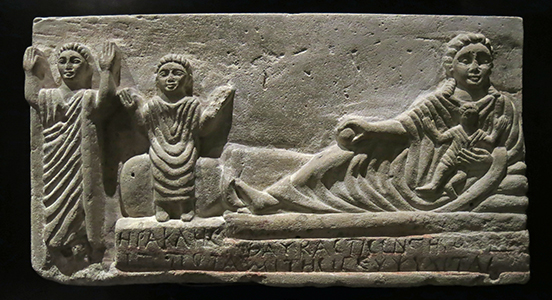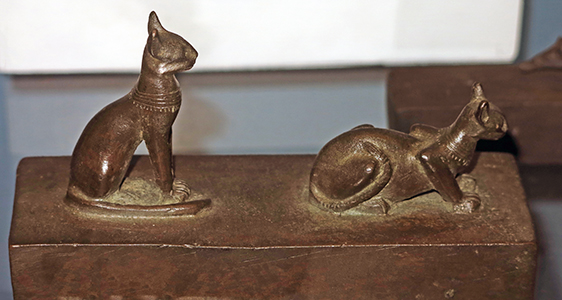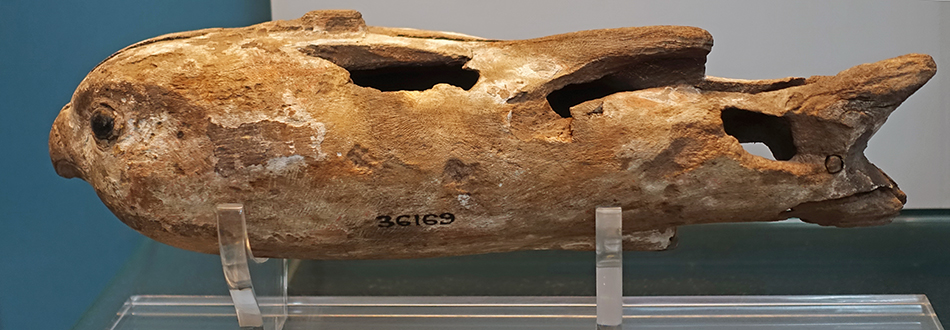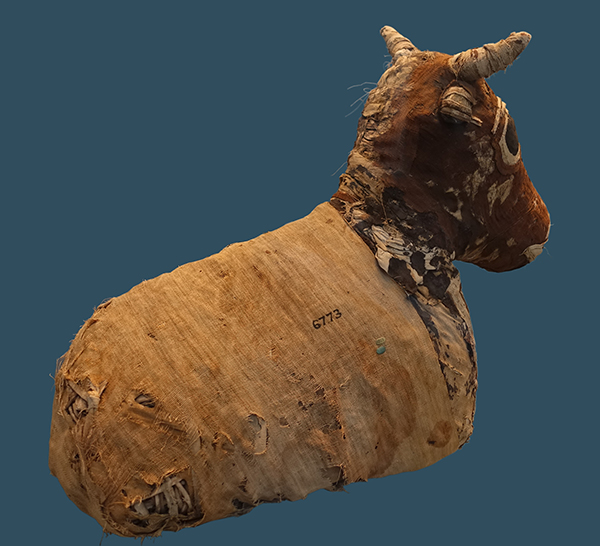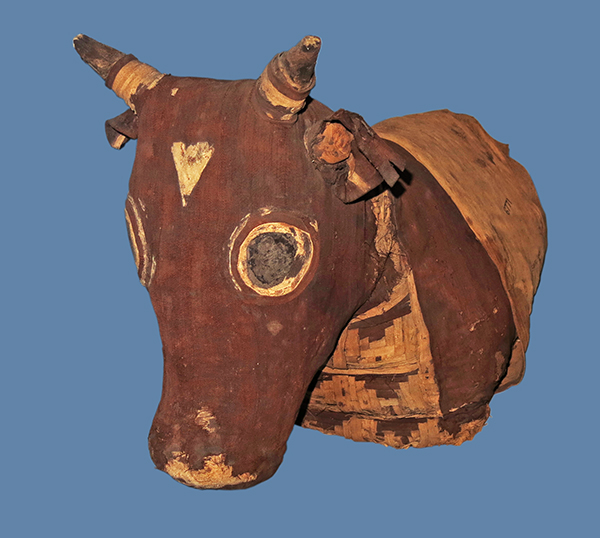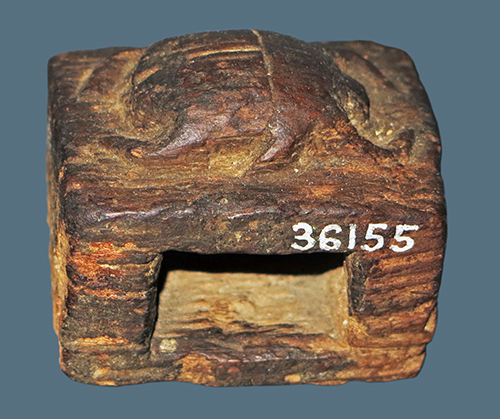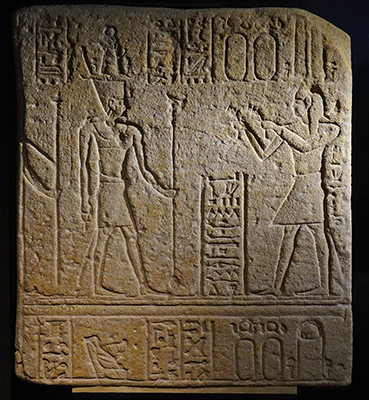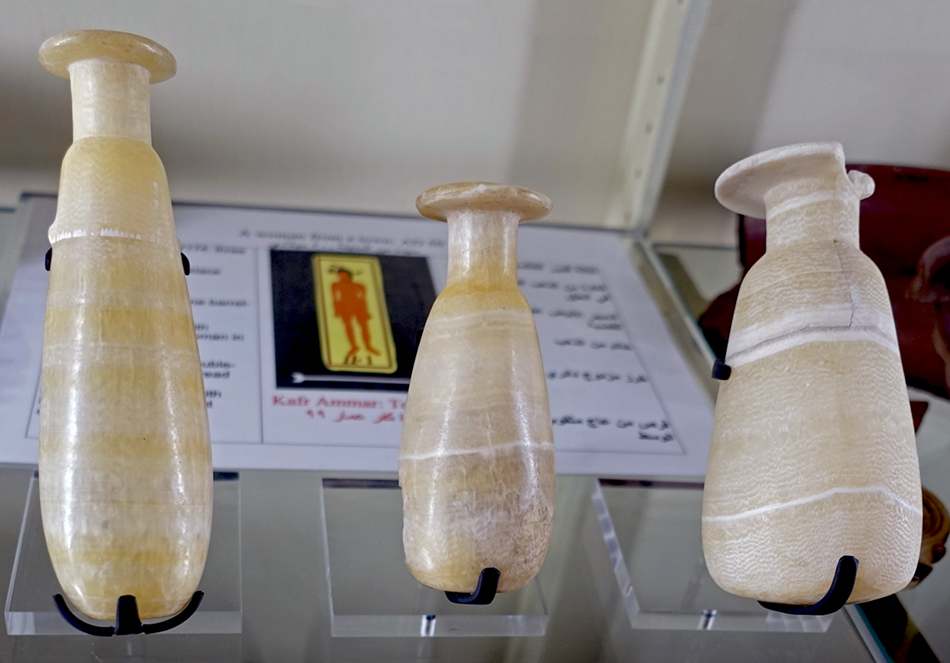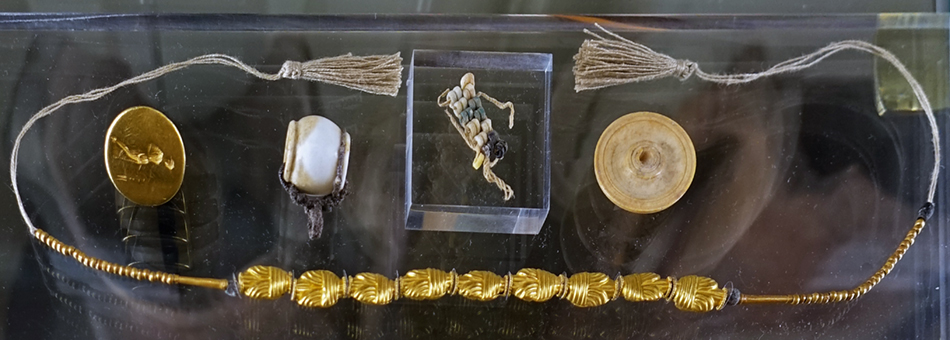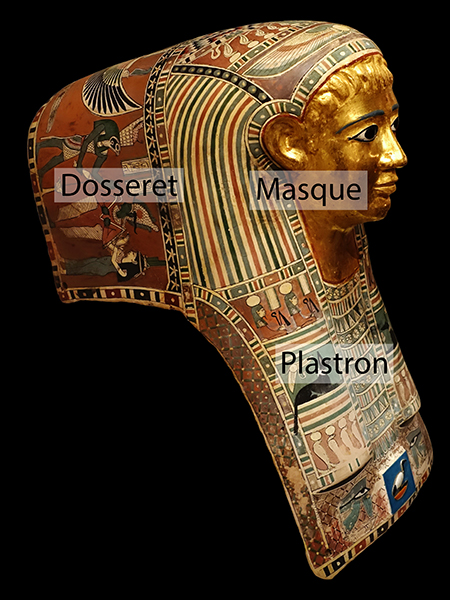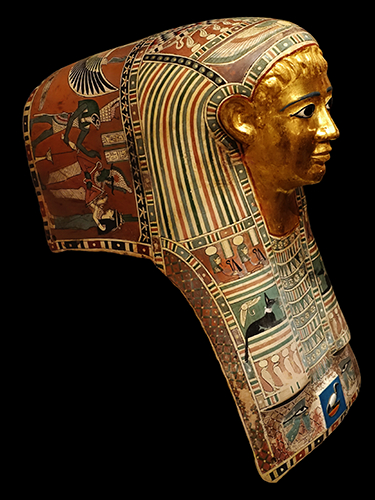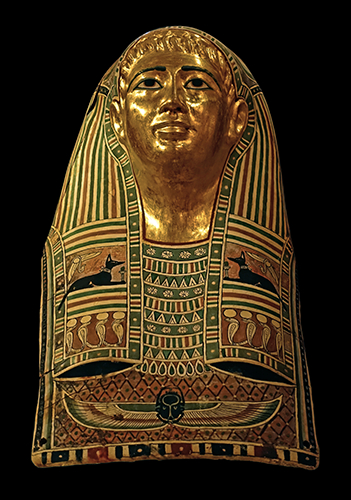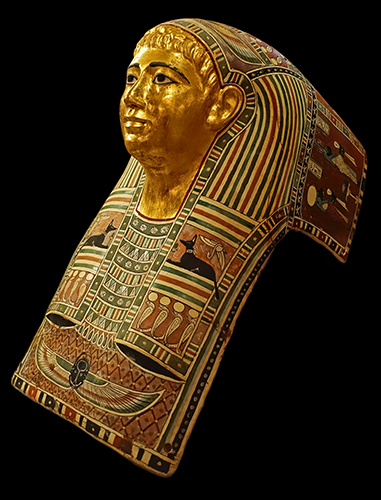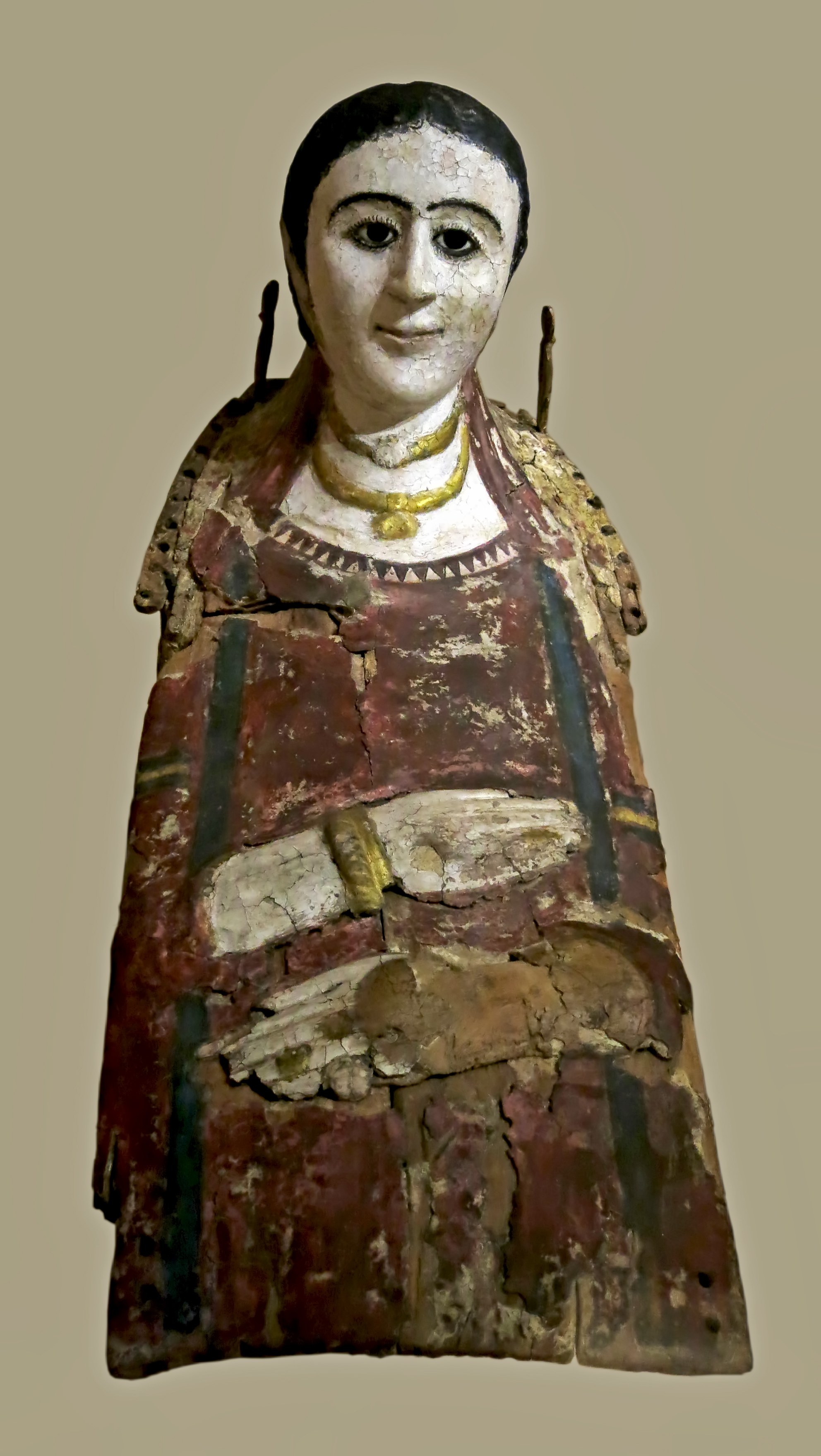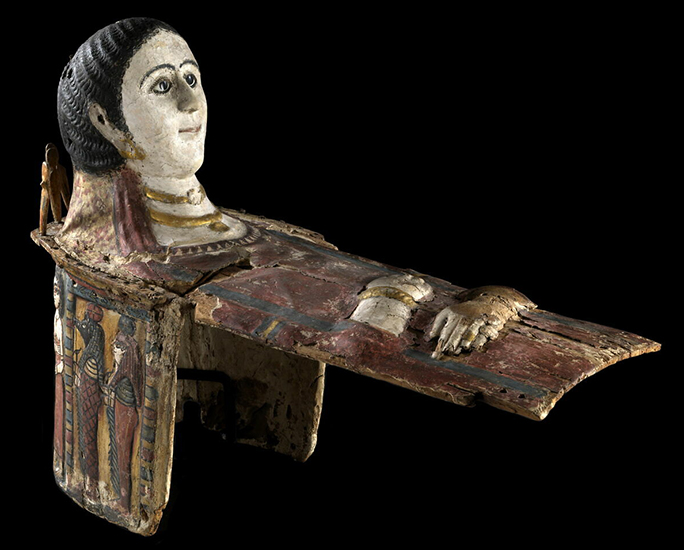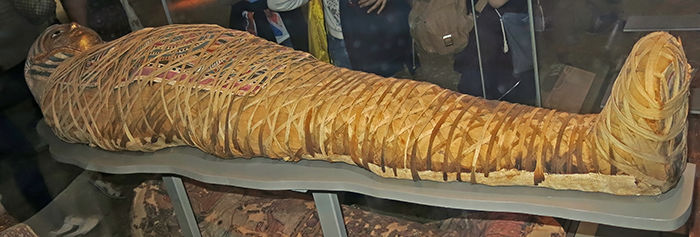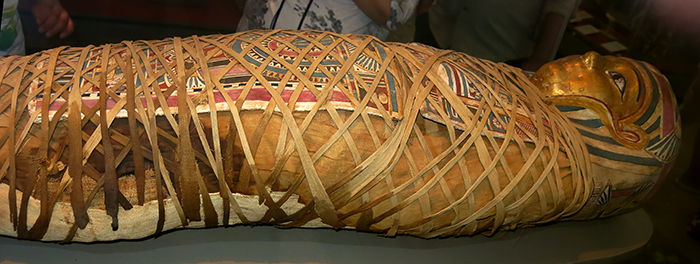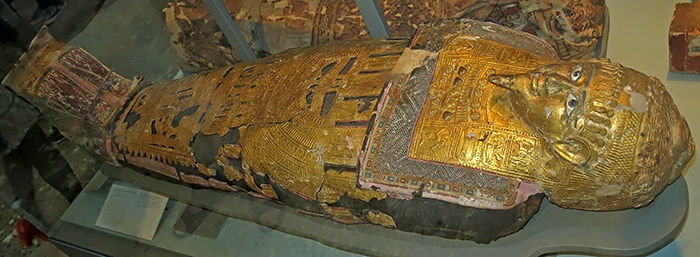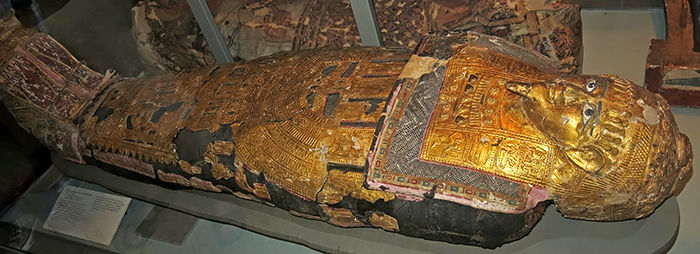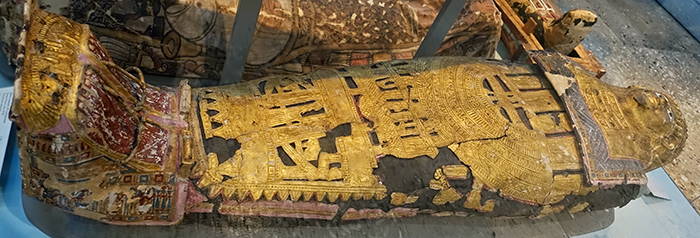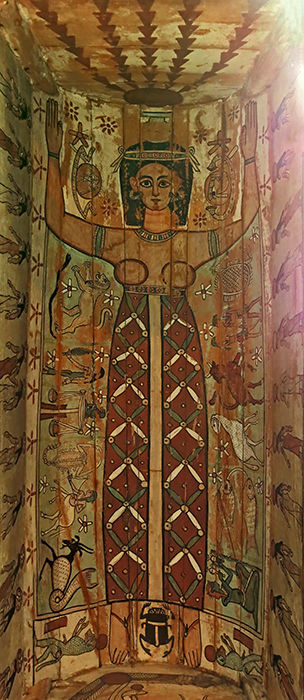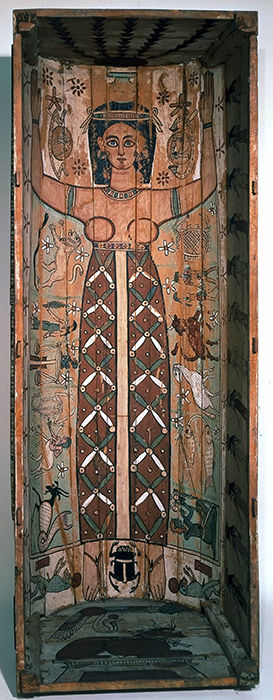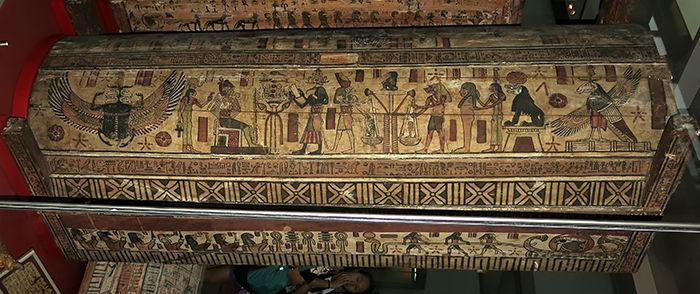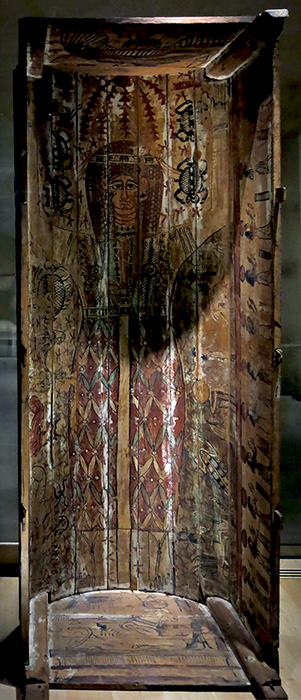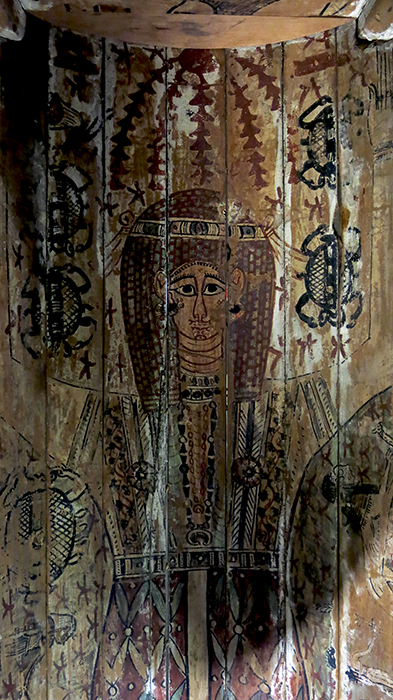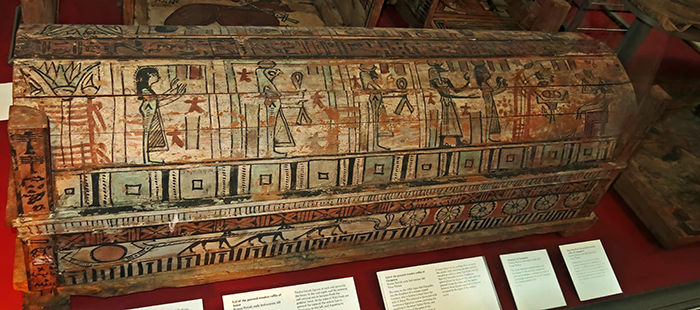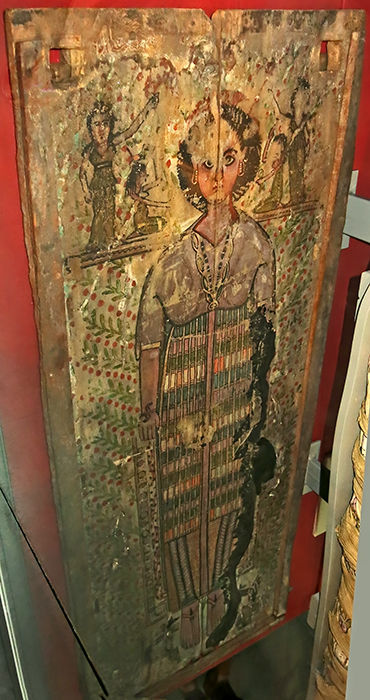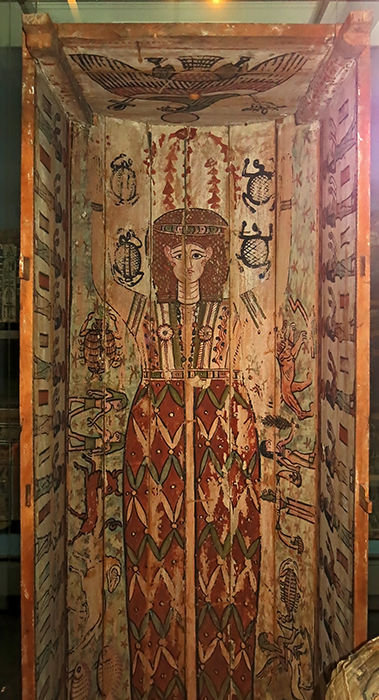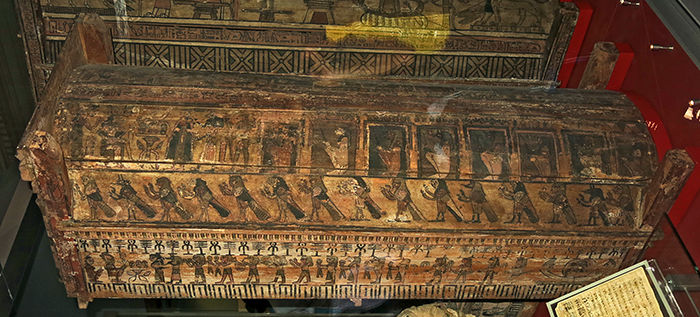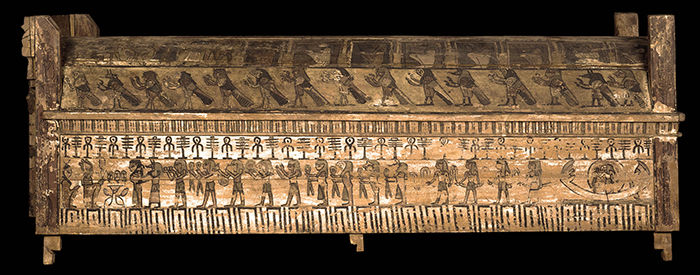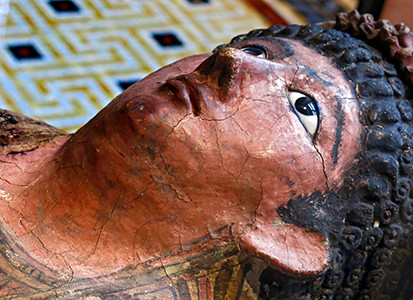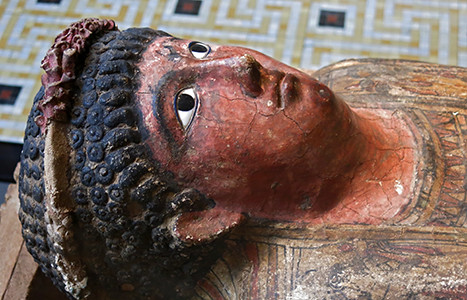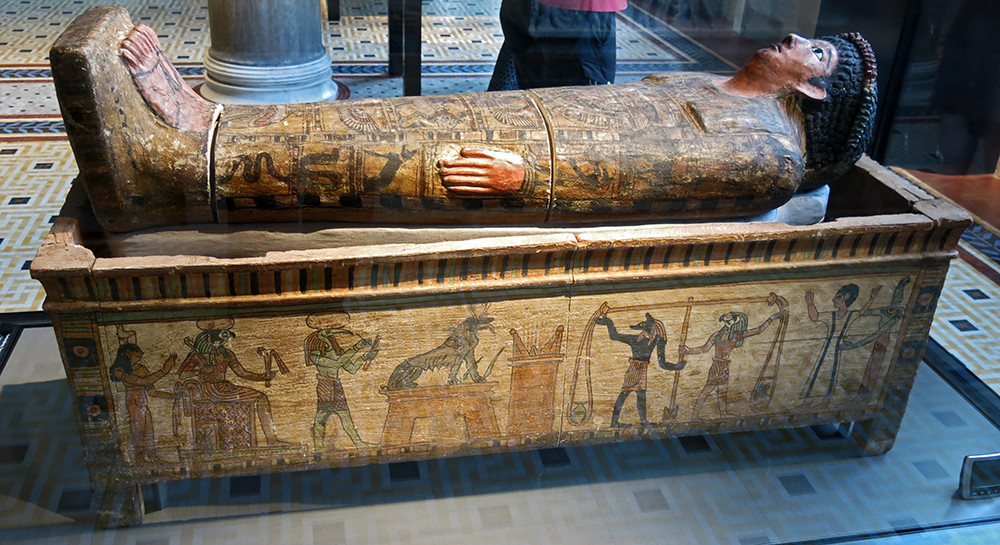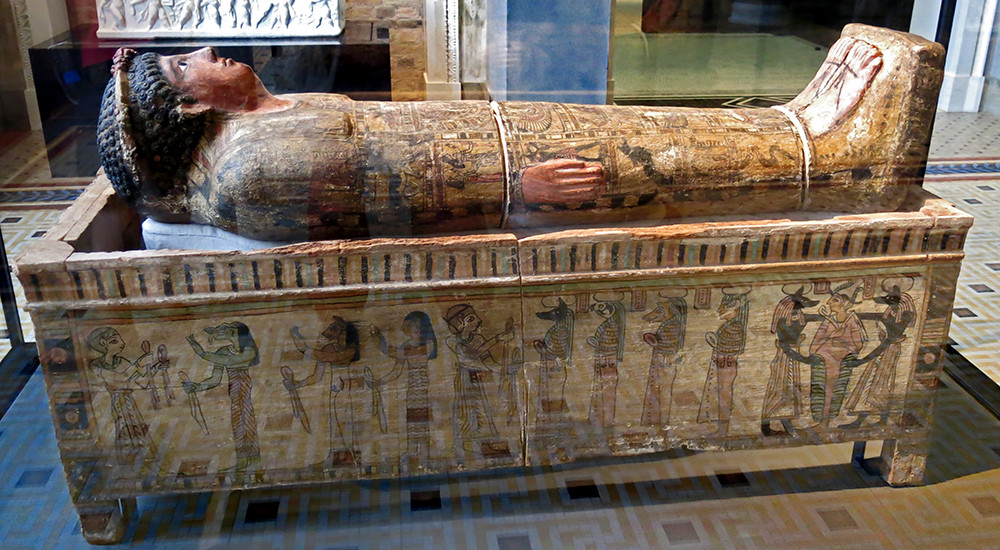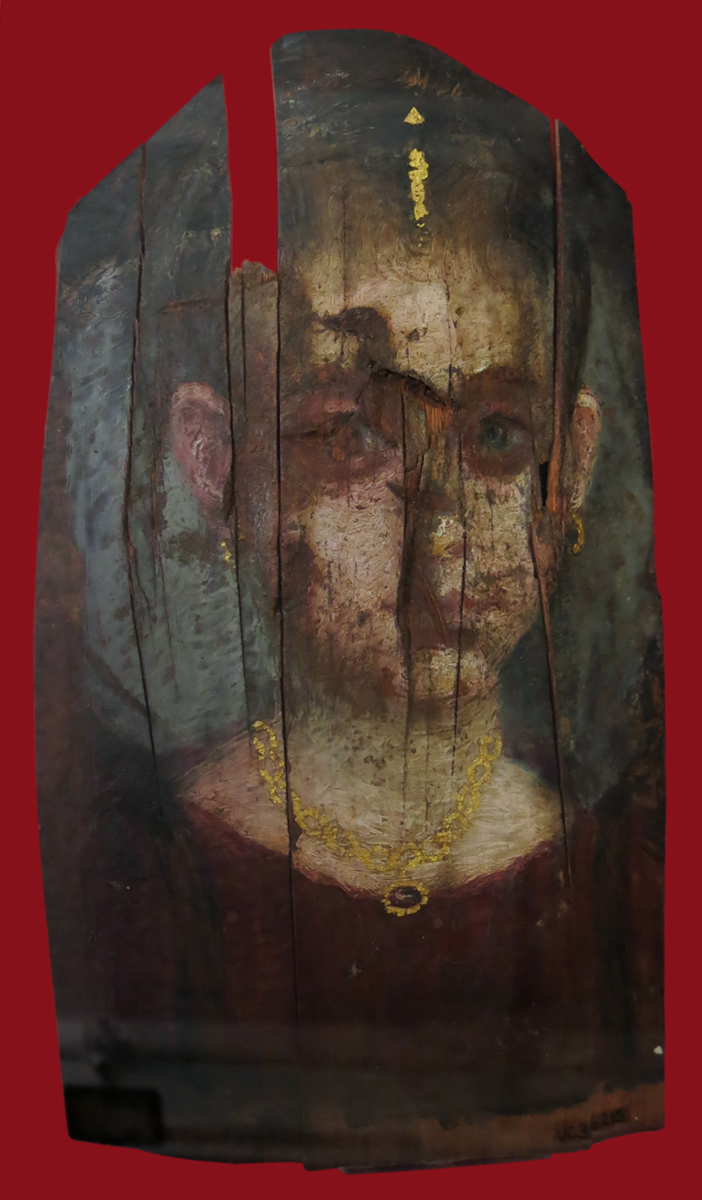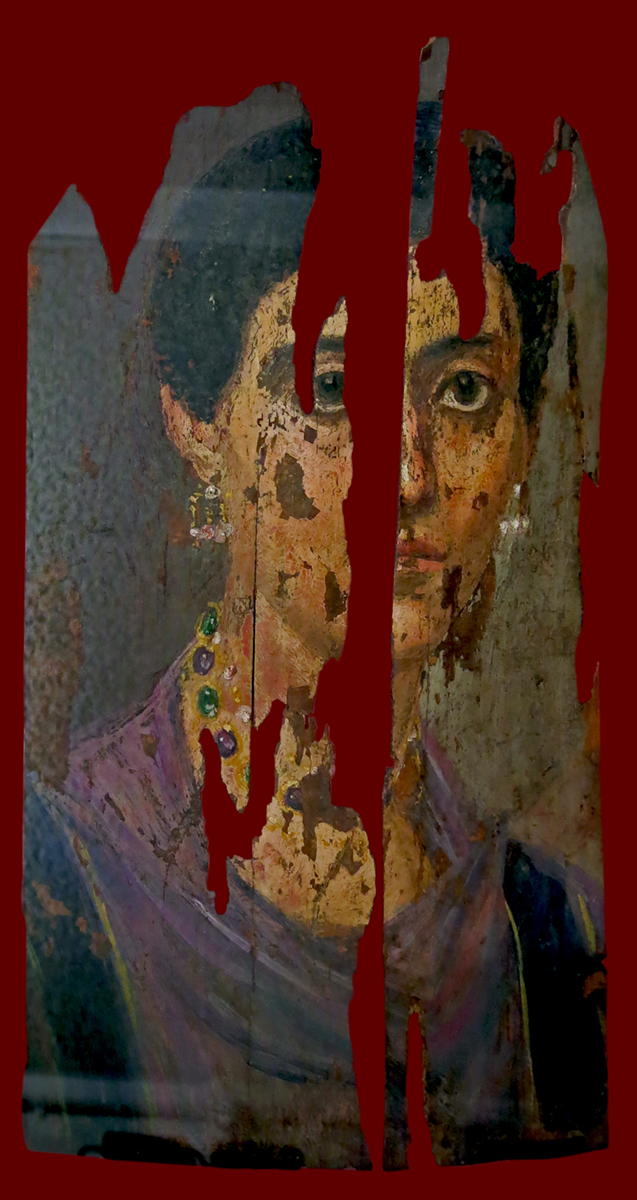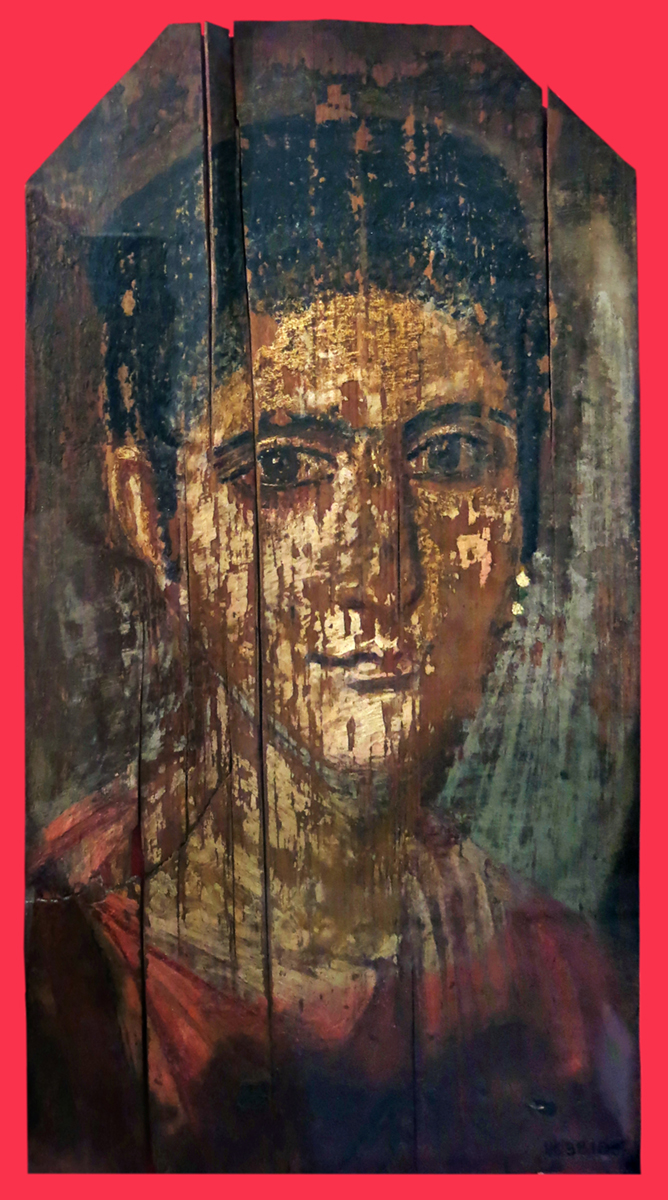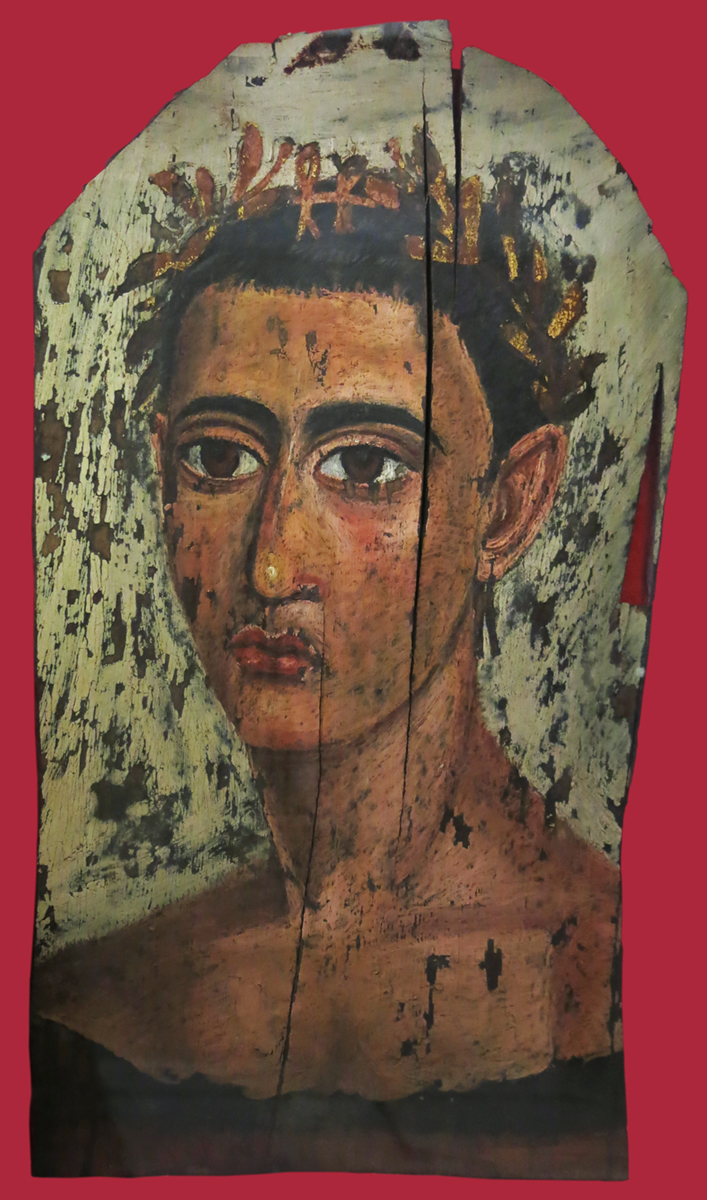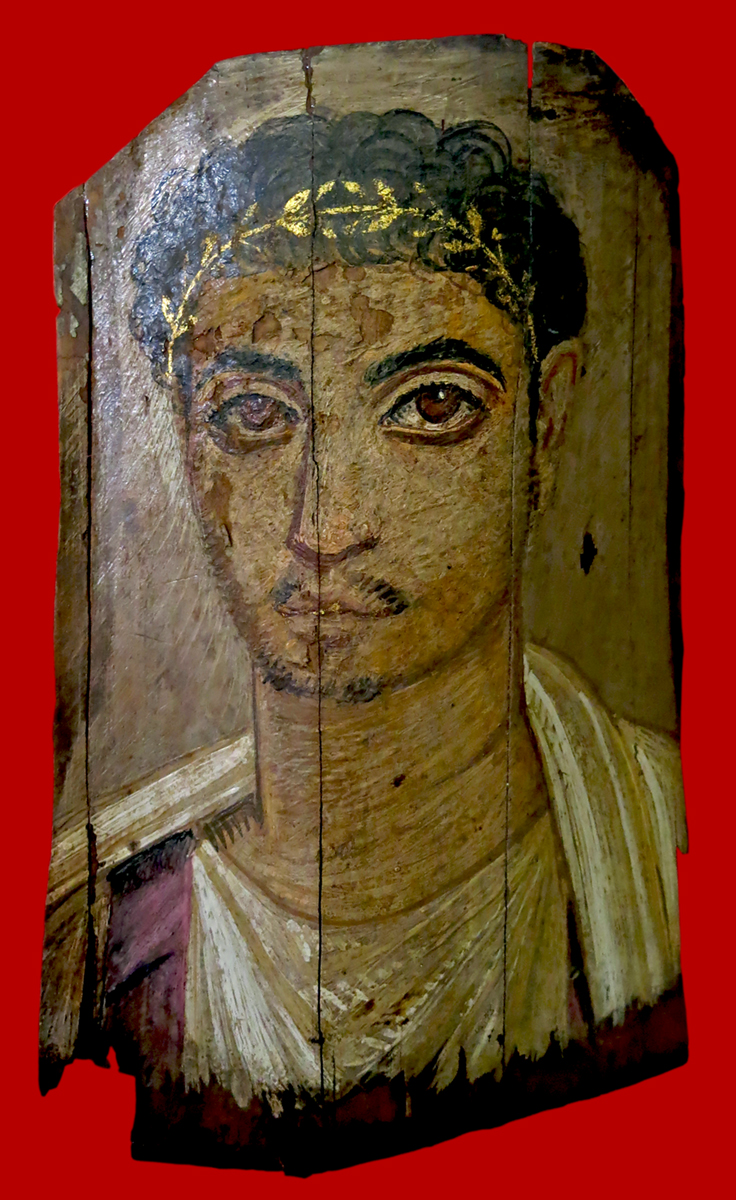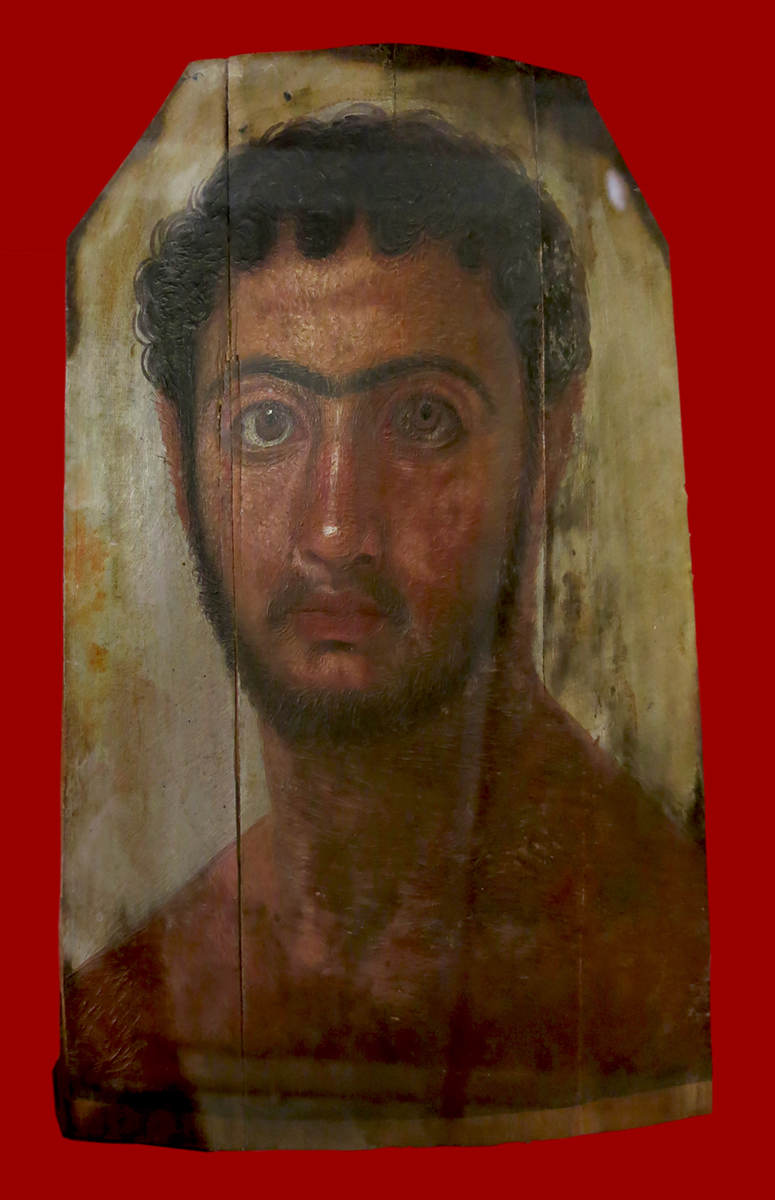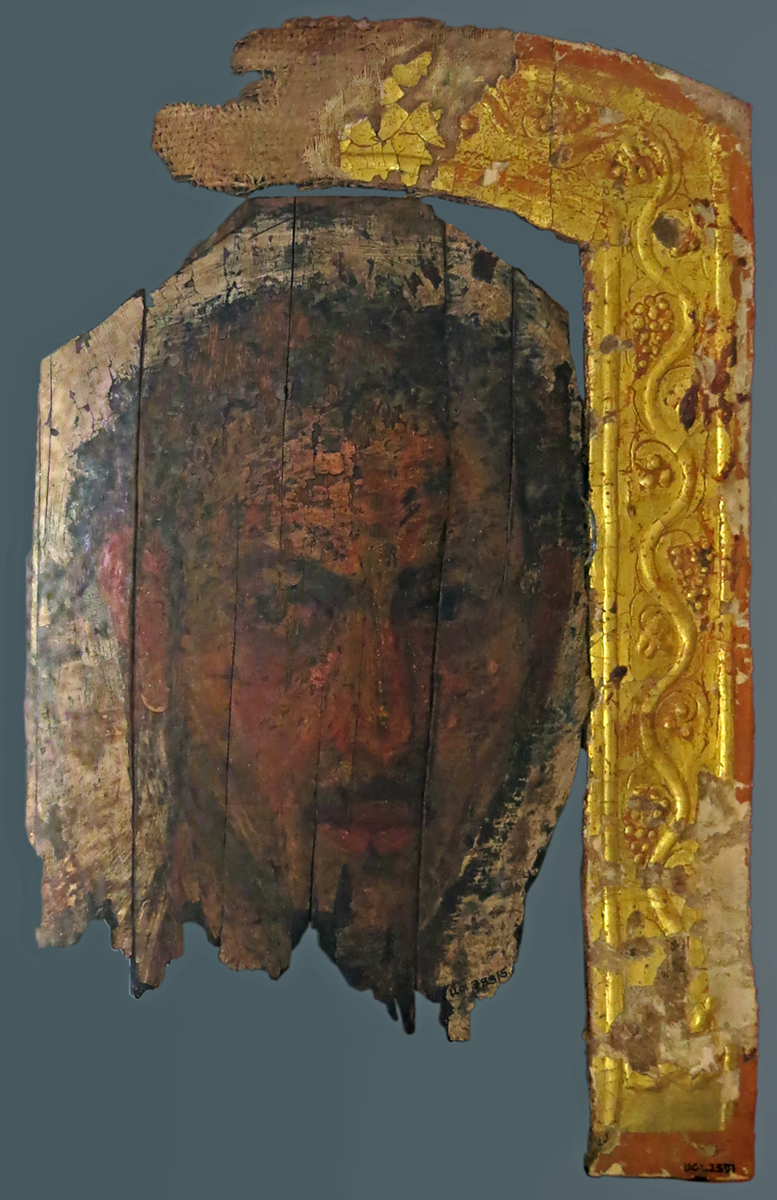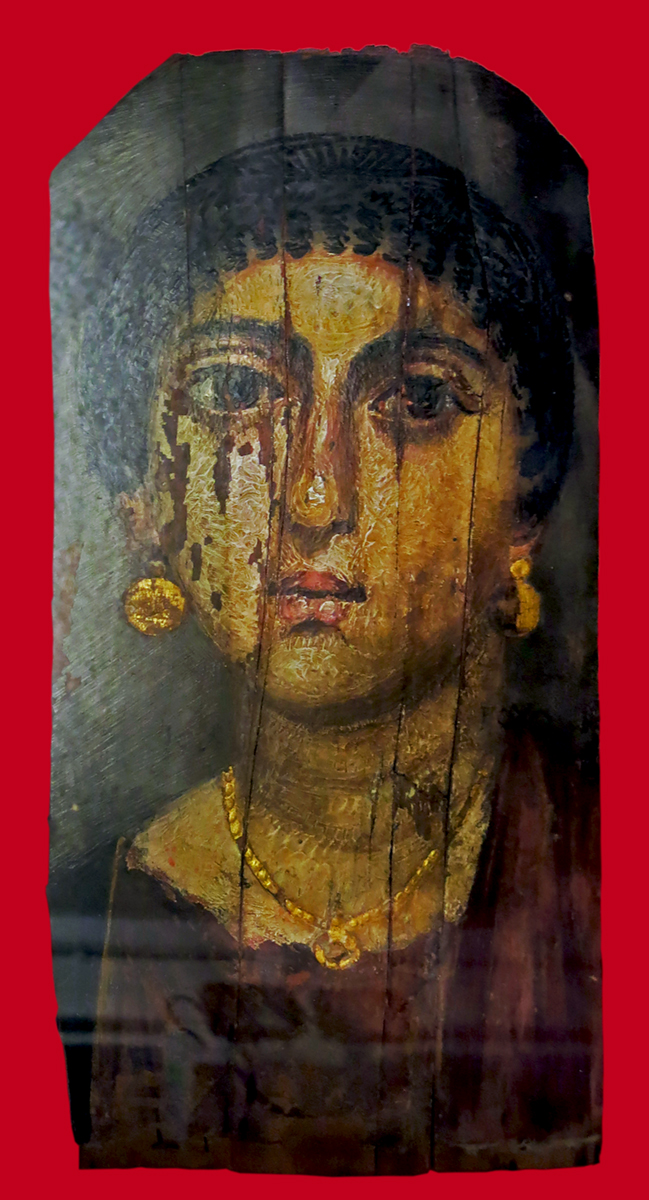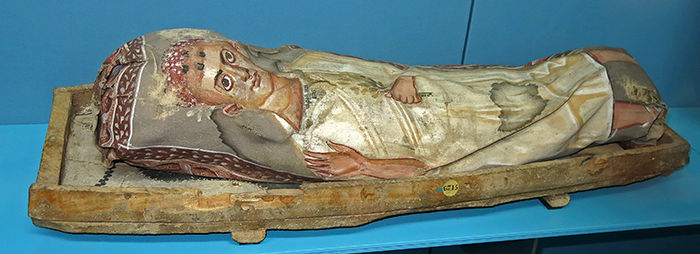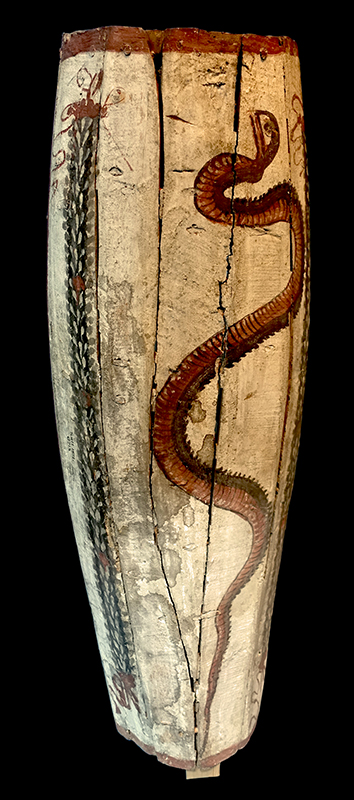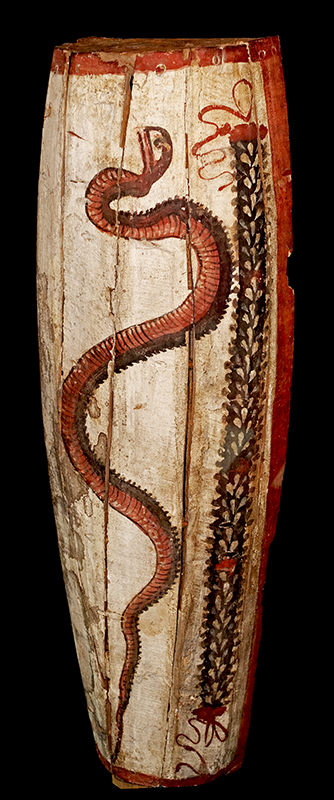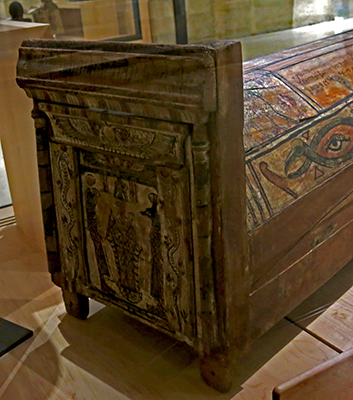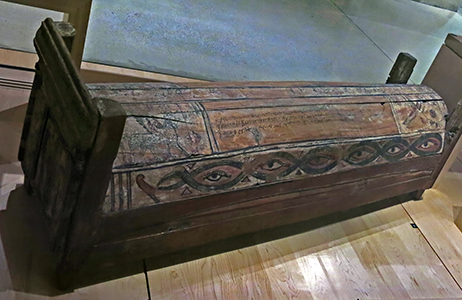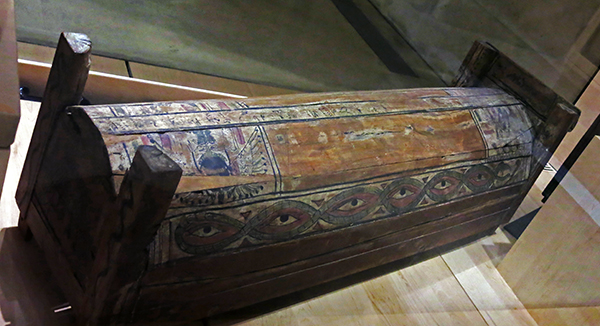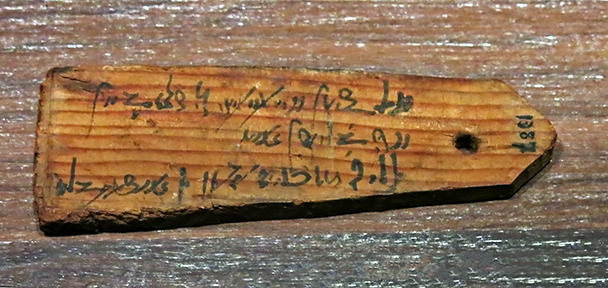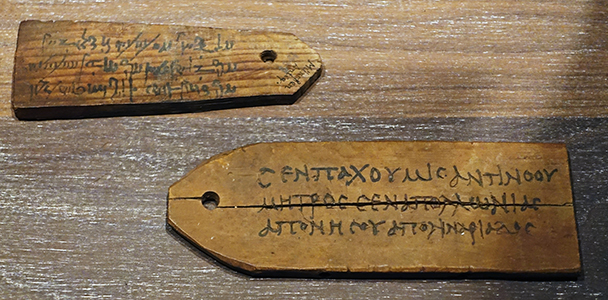Back to Don's Maps
 Back to Archaeological Sites
Back to Archaeological Sites
 Back to Egypt Index Page
Back to Egypt Index Page
Ancient Egyptian Culture, Mummies, Statues, Burial Practices and Artefacts
Ancient Egypt from the conquest of Egypt by Alexander in 332 BC, through the Ptolemaic period, to its decline as a Roman Province
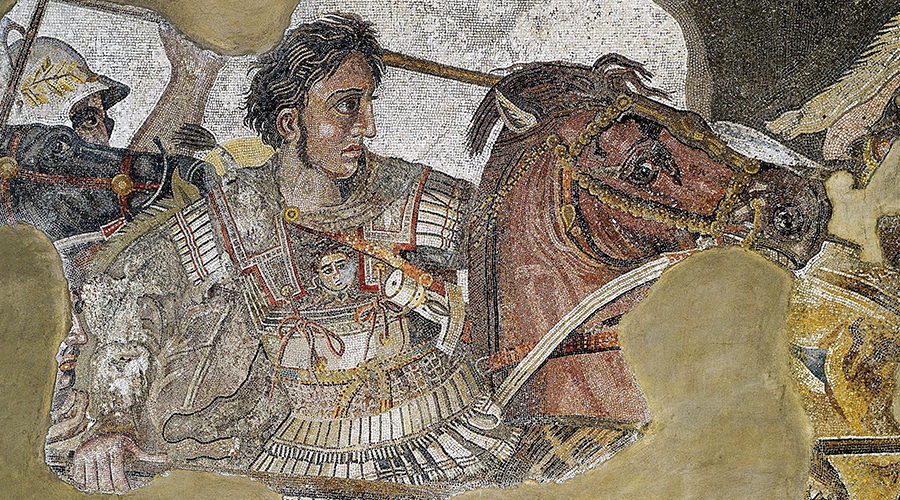
Alexander Mosaic (detail), House of the Faun, Pompeii
Photo: The Guardian (DEA/G Nimatallah/De Agostini/Getty Images)
Permission: Public Domain
Macedonian Period: 332 BC - 305 BC
Alexander's Conquest, and the aftermath
In 332 BC, Alexander the Great, King of Macedon invaded the Achaemenid satrapy of Egypt. He visited Memphis, and traveled to the oracle of Amun at the Oasis of Siwa. The oracle declared him to be the son of Amun. He conciliated the Egyptians by the respect he showed for their religion, but he appointed Macedonians to virtually all the senior posts in the country, and founded a new Greek city, Alexandria, to be the new capital.
The wealth of Egypt could now be harnessed for Alexander's conquest of the rest of the Persian Empire. Early in 331 BC he was ready to depart, and led his forces away to Phoenicia. He left Cleomenes as the ruling nomarch to control Egypt in his absence. He had stayed in Egypt just six months. Alexander never returned to Egypt.
Following Alexander's death in Babylon in 323 BC, a succession crisis erupted among his generals. Initially, Perdiccas ruled the empire as regent for Alexander's half-brother Arrhidaeus, who became Philip III of Macedon, and then as regent for both Philip III and Alexander's infant son Alexander IV of Macedon, who had not been born at the time of his father's death. Perdiccas appointed Ptolemy, one of Alexander's closest companions, to be satrap of Egypt. Ptolemy ruled Egypt from 323 BC, nominally in the name of the joint kings Philip III and Alexander IV. However, as Alexander the Great's empire disintegrated, Ptolemy soon established himself as ruler in his own right. Ptolemy successfully defended Egypt against an invasion by Perdiccas in 321 BC, and consolidated his position in Egypt and the surrounding areas during the Wars of the Diadochi (322–301 BC). In 305 BC, Ptolemy took the title of King. As Ptolemy I Soter ("Saviour"), he founded the Ptolemaic dynasty that was to rule Egypt for nearly 300 years.
Egyptian Chronology
| Egyptian Chronology | ||
|---|---|---|
| Date | Culture | Duration |
| 11 000 BC | Jebel Sahaba | |
| Before 8 000 BC - Palaeolithic in Europe and Northern Asia | ||
| 8 000 BC - Nominal end of the Ice Age | ||
| 8 600 - 4 400 BC | Nabta Playa Neolithic | 4 200 years |
| 6 100 - 5 180 BC | Qarunian (formerly known as Fayum B) | 920 years |
| 5 200 - 4 200 BC | Fayum A | 1 000 years |
| 4 800 - 4 200 BC | Merimde | 600 years |
| 4 600 - 4 400 BC | El Omari | 200 years |
| 4 400 - 4 000 BC | Badarian | 400 years |
| 4 000 - 3 300 BC | Maadi | 700 years |
| 3 900 - 3 650 BC | Naqada I | 250 years |
| 3 650 - 3 300 BC | Naqada II | 350 years |
| 3 300 - 2 900 BC | Naqada III | 400 years |
| 3 100 - 2 670 BC | Early Dynastic | 430 years |
| 2 670 - 2 181 BC | Old Kingdom | 489 years |
| 2 181 - 2 025 BC | First Intermediate Period | 156 years |
| 2 025 - 1 700 BC | Middle Kingdom | 325 years |
| 1 700 - 1 550 BC | Second Intermediate Period | 150 years |
| 1 550 - 1 077 BC | New Kingdom | 473 years |
| 1 077 - 664 BC | Third Intermediate Period | 413 years |
| 664 - 332 BC | Late Period | 332 years |
| 525 - 404 BC | First Persian Period | 121 years |
| 404 - 343 BC | Late Dynastic Period | 61 years |
| 343 - 332 BC | Second Persian Period | 11 years |
| 332 - 305 BC | Macedonian Period | 27 years |
| 305 - 30 BC | Ptolemaic Period | 275 years |
| 30 BC - 395 AD | Roman Period | 425 years |
| 395 AD - 640 AD | Byzantine Period | 245 years |
| 640 AD - 1517 AD | Islamic Period | 877 years |
| 1517 AD - 1867 AD | Ottoman Period (French Occupation 1798-1801) |
350 years |
| 1867 AD - 1914 AD | Khedival Period | 47 years |
| 1914 AD - 1922 AD | Sultanate under Hussein Kamel, as a British Protectorate |
8 years |
| 1922 AD - 1953 AD | Monarchy | 31 years |
| 1953 AD - Present Day | Republic | |
| Macedonian Period | |||
|---|---|---|---|
| Name | Years | Dates | Comments |
| Alexander the Great | 1 | 332 BC - 331 BC | Left newly founded Alexandria for Phoenicia, and left Cleomenes as the ruling Monarch. Alexander never returned to Egypt. |
| Cleomenes | 9 | 331 BC - 322 BC | It is told that his rapacity knew no bounds, that he exercised his office solely for his own advantage. He was executed by Ptolemy, who pocketed Cleomenes' accumulated wealth of 8 000 talents. |
| Ptolemy | 18 | 323 BC - 305 BC | Ptolemy ruled Egypt from 323 BC, nominally in the name of the joint kings Philip III and Alexander IV. However, as Alexander the Great's empire disintegrated, Ptolemy soon established himself as ruler in his own right. Ptolemy successfully defended Egypt against an invasion by Perdiccas in 321 BC, and consolidated his position in Egypt and the surrounding areas during the Wars of the Diadochi (322–301 BC). In 305 BC, Ptolemy took the title of King. As Ptolemy I Soter ('Saviour'), he founded the Ptolemaic dynasty that was to rule Egypt for nearly 300 years. |
Macedonian Period: 332 BC - 305 BC
Nes-Nehemet-awai
Circa 320 BC
Nes-Nehemet-awai with various Afterlife texts.
Catalog: Sycomore wood, Hermopolis (?), ÄS 31a-b
Photo: Don Hitchcock 2018
Source: Original, Ägyptischen Museum München
Text: Museum card, © Ägyptischen Museum München
Nubia and the Kingdom of Kush
Ptolemaic Dynasty: 305 BC - 30 BC
The Ptolemaic dynasty was a Greek royal family, originating from Macedon, which ruled the Ptolemaic Kingdom in Egypt during the Hellenistic period. Their rule lasted for 275 years, from 305 to 30 BC. They were the last dynasty of ancient Egypt.
Ptolemy, one of the seven somatophylakes (bodyguards) who served as Alexander the Great's generals and deputies, was appointed satrap of Egypt after Alexander's death in 323 BC. In 305 BC, he declared himself Ptolemy I, later known as Sōter 'Saviour'.
The Egyptians soon accepted the Ptolemies as the successors to the pharaohs of independent Egypt. Ptolemy's family ruled Egypt until the Roman conquest of 30 BC. All the male rulers of the dynasty took the name Ptolemy. Ptolemaic queens regnant, some of whom were the sisters of their husbands, were usually called Cleopatra, Arsinoe or Berenice. The most famous member of the line was the last queen, Cleopatra VII, known for her role in the Roman political battles between Julius Caesar and Pompey, and later between Octavian and Mark Antony. Her apparent suicide at the conquest by Rome marked the end of Ptolemaic rule in Egypt.
| Ptolemaic Dynasty | ||||
|---|---|---|---|---|
| Name | Consort | Years | Dates | Comments |
| Ptolemy I Soter I | Thaïs Artakama Eurydice Berenice I |
23 | 305 BC - 282 BC | Ptolemy founded a dynasty which ruled Egypt for the next three centuries, turning Egypt into a Hellenistic kingdom and Alexandria into a centre of Greek culture. He assimilated some aspects of Egyptian culture, however, assuming the traditional title pharaoh in 305/4 BC. |
| Ptolemy II | Arsinoe I Arsinoe II (sister) |
37 | 283 BC - 246 BC | A peaceful and cultured king, and no great warrior. However, three years of campaigning at the start of his reign left Ptolemy the master of the eastern Mediterranean, controlling the Aegean islands and the coastal districts of Cilicia, Pamphylia, Lycia and Caria. In the 270s BC, Ptolemy II defeated the Kingdom of Kush in war, gaining control of important gold-mining areas south of Egypt. As a result, the Ptolemies established hunting stations and ports as far south as Port Sudan, from which raiding parties containing hundreds of men searched for war elephants. Hellenistic culture would acquire an important influence on Kush at this time. Ptolemy was eager to increase the Library of Alexandria and to patronise scientific research. He spent lavishly on making Alexandria the economic, artistic and intellectual capital of the Hellenistic world. It is to the academies and libraries of Alexandria that we owe the preservation of so much Greek literary heritage. |
| Ptolemy III | Berenice of Cyrene | 25 | 246 BC - 221 BC | Ptolemy III Euergetes ('the benefactor') abandoned his predecessors' policy of keeping out of the wars of the other Macedonian successor kingdoms, and plunged into the Third Syrian War. Ptolemy marched triumphantly into the heart of the Seleucid realm, as far as Babylonia, while his fleets in the Aegean made fresh conquests as far north as Thrace. This victory marked the zenith of the Ptolemaic power. Egyptian fleets controlled most of the coasts of Asia Minor and Greece. After this triumph Ptolemy no longer engaged actively in war. He patronised the native Egyptian religion more liberally, and he left larger traces among the Egyptian monuments. His reign marks the gradual 'Egyptianisation' of the Ptolemies. |
| Ptolemy IV Philopator | Arsinoë IV (sister) | 17 | 221 BC - 204 BC | Ptolemy IV was a weak and corrupt king under whom the decline of the Ptolemaic kingdom began. His reign was inaugurated by the murder of his mother, and he was always under the influence of royal favourites, male and female, who controlled the government. Nevertheless, his ministers were able to make serious preparations to meet the attacks of Antiochus III the Great on Coele-Syria, and the great Egyptian victory of Raphia in 217 BC secured the kingdom for the remainder of his reign. The arming of Egyptians in this campaign had a disturbing effect upon the native population of Egypt leading to the secession of Upper Egypt under pharaohs Harmachis and Ankmachis. Philopator was devoted to orgiastic religions and to literature. He married his sister Arsinoë, but was ruled by his mistress Agathoclea. Ptolemy is said to have built a giant ship known as the tessarakonteres ('forty'), a huge galley and possibly the largest human-powered vessel ever built. The current theory is that Ptolemy's ship was an oversized catamaran galley, measuring 128 m. |
| Ptolemy V Epiphanes | Arsinoë IV (sister) | 23 | 204 BC - 181 BC | Ptolemy V inherited the throne at the age of five when his father, Ptolemy IV died, and under a series of regents, the kingdom was paralysed. The Rosetta Stone was produced during his reign as an adult. The war between Upper and Lower Egypt continued until 185 BC with the arrest of Ankhmachis by Ptolemaic general Conanus. This victory re-established Ptolemaic rule in Upper Egypt, as well as the region between the first and second cataracts. In 183 BC / 184 BC, the rebels in Lower Egypt surrendered on the basis of terms that Epiphanes had personally promised to honour. However, showing himself treacherous and vindictive, he had them put to death in a cruel manner. The Memphis Decree, published in three languages on the Rosetta Stone and other stelae, announced the rule and ascension to godhood of Ptolemy V, and contained concessions to the priesthood, and has been termed a reward for the priests' support. The elder of Ptolemy V's two sons, Ptolemy VI Philometor (181 – 145 BC), succeeded as an infant under the regency of his mother Cleopatra the Syrian. |
| Ptolemy VI Philometor | Cleopatra II (sister) | 23 | 180 BC - 145 BC | Ptolemy VI succeeded at the age of 6 and ruled jointly with his mother, Cleopatra I, until her death in 176 BC. In 173 BC he married his sister, Cleopatra II. In 164 Ptolemy VI was driven out of Egypt by his brother Ptolemy VIII and went to Rome to seek support. The Romans partitioned the Ptolemaic land, granting Ptolemy VI Cyprus and Egypt, and Ptolemy VIII Cyrenaica. Ptolemy VI died in battle when he fell from his horse and fractured his skull, dying a few days later. |
| Ptolemy VIII Physcon | Cleopatra II (sister) | 23 | 145 BC - 116 BC | During the last century of Ptolemaic rule, Egypt's independence was exercised under Rome's protection and at Rome's discretion. The reign of Ptolemy VIII Physcon (a nickname, potbelly) was marked by generous benefactions to the Egyptian temples, but he was detested as a tyrant by the Greeks, and the historical accounts of the reign emphasise his stormy relations with the Alexandrian populace. Physcon seduced and married Cleopatra III (his wife's daughter) without divorcing Cleopatra II, who became infuriated. Many speculate that Physcon only married Cleopatra II because he was plotting to marry Cleopatra III when she became of marrying age. By 132 or 131 BC, the people of Alexandria had rioted and set fire to the royal palace. Physcon, Cleopatra III, and their children escaped to Cyprus; while Cleopatra II had their twelve-year-old son, Ptolemy Memphitis, acclaimed as king. Physcon was able to get hold of the boy, killed him, and sent the dismembered pieces back to Cleopatra. On his death in 116 BC Physcon left the kingdom to his wife Cleopatra III and her son Ptolemy IX Philometor Soter II. |
| Ptolemy IX / Ptolemy X | 35 | 116 BC - 81 BC | Ptolemy IX Soter II or Lathyros ('grass pea') was king of Egypt three times, from 116 BC to 110 BC, 109 BC to 107 BC and 88 BC to 81 BC, with intervening periods ruled by his brother, Ptolemy X Alexander. Ptolemy IX gained sole control of the country in 88 BC when Ptolemy X was forced by his unpopularity to leave Egypt, and subsequently died at sea. Ptolemy IX then sought to keep Egypt from excessive Roman influence while trying to develop trade with the East. He died in 81 BC, leaving his daughter and widow as his successors. | |
| Ptolemy XII Auletes | Cleopatra Tryphaena | 22, 4 | 80 BC - 58 BC 55 BC - 51 BC |
Ptolemy Auletes (pipe player) - his reign as king was interrupted by a general rebellion that resulted in his exile from 58 BC to 55 BC. Ptolemy XII was often described as a weak, self-indulgent man, a drunkard, and a music lover. During his reign, Ptolemy XII attempted to secure his own fate and the fate of his dynasty by means of a pro-Roman policy, including bribes to Roman leaders. In 58 BC, Ptolemy XII failed to comment on the Roman conquest of Cyprus, a territory ruled by his brother, thereby inciting the Egyptian population to start a rebellion. Egyptians were already aggravated by heavy taxes (to pay for the Roman tribute) and a substantial increase in the cost of living. Ptolemy XII fled to Rome, possibly with his daughter Cleopatra VII, in search of safety. His daughter Berenice IV became his successor. She ruled as coregent with her sister (or possibly mother) Cleopatra VI Tryphaena. A year after Ptolemy XII's exile, Cleopatra VI Tryphaena died and Berenice ruled alone over Alexandria from 57 BC to 56 BC. Ptolemy XII finally recovered his throne by paying Aulus Gabinius 10 000 talents to invade Egypt in 55 BC. Upon entering the palace, Ptolemy had Berenice and her supporters executed. From then on, he reigned until he fell ill in 51 BC. Around two thousand Roman soldiers and mercenaries, the so-called Gabiniani, were stationed in Alexandria to ensure Ptolemy XII's authority on the throne. In exchange, Rome was able to exert its power over the restored king. His daughter Cleopatra VII became his coregent. Before his death, Ptolemy XII chose his daughter Cleopatra VII as his coregent and that she and her brother Ptolemy XIII should rule the kingdom together. |
| Cleopatra VII Philopator | 22, 4 | 51 BC - 30 BC | Cleopatra ruled jointly with Ptolemy XIII Theos Philopator (51 BC - 47 BC), Ptolemy XIV (47 BC - 44 BC) and Ptolemy XV Caesarion (44 BC - 30 BC). Born around 69 BC Cleopatra VII was the last active ruler of Ptolemaic Egypt, briefly survived as pharaoh by her son Caesarion. The Ptolemies spoke Greek throughout their dynasty, and refused to speak Egyptian, which is the reason that Greek as well as Egyptian languages were used on official court documents such as the Rosetta Stone. By contrast, Cleopatra did learn to speak Egyptian and represented herself as the reincarnation of the Egyptian goddess Isis. Cleopatra originally ruled jointly with her father Ptolemy XII Auletes, and later with her brothers Ptolemy XIII and Ptolemy XIV, whom she married as per Egyptian custom, but eventually she became sole ruler. As queen, she consummated a liaison with Julius Caesar that solidified her grip on the throne. She later elevated Caesarion, her son with Caesar, to co-ruler in name. After Caesar's assassination in 44 BC, she aligned with Mark Antony in opposition to Caesar's legal heir Gaius Julius Caesar Octavianus (later known as Augustus). With Antony, she bore the twins Cleopatra Selene II and Alexander Helios, and son Ptolemy Philadelphus (her unions with her brothers had produced no children). In the year 31 B.C., Cleopatra and Antony combined armies to try to defeat Octavian in a raging sea battle at Actium, on Greece’s west coast. The clash, however, proved to be a costly defeat for the Egyptians, forcing Antony and Cleopatra to flee back to Egypt. Antony soon returned to the battlefield, where he was falsely informed that Cleopatra had died. Upon hearing the news, the despondent Roman leader committed suicide by stabbing himself. Cleopatra followed her lover’s demise by ending her life as well by being bitten by an Egyptian cobra. She died on 12th August, 30 BC. The two were buried together, as they had wished, and Egypt became a province of the Roman Empire. Cleopatra was outlived by Caesarion, who was declared pharaoh by his supporters, but he was soon killed on Octavian's orders. Egypt then became the Roman province of Aegyptus. Her legacy survives in numerous works of art and many dramatizations of incidents from her life in literature and other media, such as William Shakespeare's tragedy Antony and Cleopatra, George Bernard Shaw's play Caesar and Cleopatra, Jules Massenet's opera Cléopâtre, and the films Cleopatra (1934) and Cleopatra (1963). |
|
Cleopatra VII's family tree, which shows graphically the marriage of brother and sister, or very close relatives, within the Ptolemaic Dynasty.
Photo: unknown
Source: Wikipedia
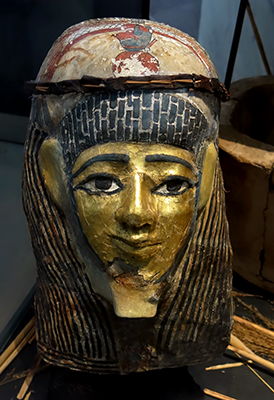
Ptolemaic Dynasty: 305 BC - 30 BC
Mask of the Konstanz mummy.
This mask, reassembled from many fragments, belongs to the mummy of the man in the coffin (pictured below) and originally covered his head. The gilded face symbolises the entrance of the dead into the divine sphere, since gold was considered by the Egyptians to be the flesh of the gods.
The hoop around the head, which was once covered with flowers, is a large, otherwise mostly lost, decoration. The surroundings of the mummy, such as masks and cartonnages, were supposed to protect the body from harm and enable the deceased's intact arrival in the afterlife.
Material: Wood, Ptolemaic period, 305 BC - 30 BC
Loan of the Rosgartenmuseums, Konstanz.
Photo: Don Hitchcock 2015
Source and text: Badisches Landesmuseum Karlsruhe Germany
Ptolemaic Dynasty: 305 BC - 30 BC
Coffin of the Konstanz mummy.
( note the sculpture of the ba bird placed on the coffin lid, representing the power and personality of the deceased, which the ba bird ensured was reunited with the deceased's body after death - Don )
Material: Wood, Ptolemaic period, 305 BC - 30 BC
Loan of the Rosgartenmuseums, Konstanz.
Photo: Don Hitchcock 2015
Source and text: Badisches Landesmuseum Karlsruhe Germany
Ptolemaic Dynasty: 305 BC - 30 BC
Coffin of the Konstanz mummy.
In this image we can see that the mummy in the coffin was itself partly covered with a well painted cartonnage.
Material: Wood, Ptolemaic period, 305 BC - 30 BC
Loan of the Rosgartenmuseums, Konstanz.
Photo: Don Hitchcock 2015
Source and text: Badisches Landesmuseum Karlsruhe Germany
Ptolemaic Dynasty: 305 BC - 30 BC
Gilded mummy mask.
Ptolemaic, cardboard, stucco, textile, primed, painted and gilded.
The mask covers the head and chest of the mummy and consists of a kind of cardboard. The inserts of the eyes made of glass or faience are lost, as are parts of the eyebrow inserts. The lower part of the wig is covered with scenes made of fine gold sheet, including the winged Isis, which protects a human figure on a throne.
Catalog: ÄM 813
Photo (left, centre): Don Hitchcock 2018
Photo (right): Liebpert (1701)
Source and text: Badisches Landesmuseum Karlsruhe Germany
Additional text: https://blog.smb.museum/lackkunst-in-schloss-koepenick-teil-4-das-antikenkabinett-im-berliner-schloss/
Ptolemaic Dynasty: 305 BC - 30 BC
Ptolemy I
Fragment of a basalt statue of Ptolemy I (305 BC - 283 BC), general of Alexander the Great, who founded the Ptolemaic dynasty of Egypt, wearing a royal headdress with a protecting serpent.
Said to have been found in the lining of a well in the Nile Delta.
Fragment of a black basalt Egyptian-style statue of Ptolemy I. The statue is preserved to below the chest. The left shoulder and the head of the uraeus are missing. The 'nemes' headdress and back pillar are damaged and there are further superficial marks on the surface. Only the top of the back pillar, which ends at the middle of the shoulder, survives and is uninscribed.
The 'nemes' headdress, plain at the top but ribbed on the lappets, and the uraeus identify the subject as a ruler. The mouth has drill holes in the corners, forcing the lips into a wide smile. The wide, fleshy nose, cheeks and chin are representative of portraits of the Thirtieth Dynasty and Ptolemaic periods, but the slightly raised eyebrows are carved in a more naturalistic manner than those on Late Period sculpture. The large, fleshy ears are also characteristic of Ptolemaic portraiture.
Height 640 mm, width 660 mm, depth 340 mm.
Because this particular piece does not bear a strong resemblance to the inscribed statues of Ptolemy II, it is, therefore, likely to represent the ruler's father, Ptolemy I. Although the exact provenance of the statue is unknown, it is said to have been found in the lining of a well in the Delta. It was acquired with a number of other objects, but, unfortunately, the site was not named and it has been suggested that the story of its discovery was fabricated to increase interest in the piece.
Catalog: Ptolemaic Period, EA1641
Photo: Don Hitchcock 2015, 2018
Source: Original, British Museum
Text: Card at the British Museum, http://www.britishmuseum.org/, © Trustees of the British Museum, CC BY-NC-SA 4.0
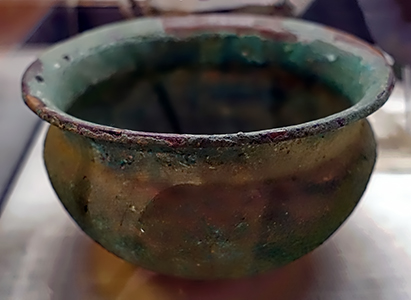
Ptolemaic Dynasty: 305 BC - 30 BC
Bowl
Receptacle for food and drink.
Possibly early Ptolemaic, 3rd century BC
Bronze, height 82 mm, diameter 139 mm
Catalog: Bronze, Inv. Nr. 1935.200.744
Photo: Don Hitchcock 2018
Source and text: Original, printed catalog, Museum August Kestner, Hannover
Ptolemaic Dynasty: 305 BC - 30 BC
Coffin for an Ibis
Gilded wooden and bronze coffin for the mummy of an ibis. Bronze head and feet.
Height 340 mm.
Catalog: Wood, bronze, gold, EA49424
Photo: Don Hitchcock 2018, 2015
Source: Original, British Museum
Text: © Card with the display at the British Museum, http://www.britishmuseum.org/ , © Trustees of the British Museum, CC BY-NC-SA 4.0
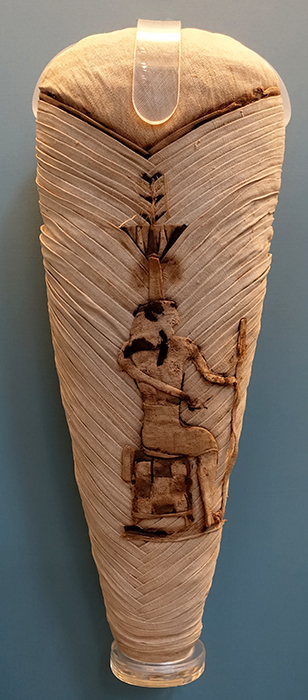
Ptolemaic Dynasty: 305 BC - 30 BC
Mummy of an Ibis
Mummy of an ibis with appliqué figure of the god Nefertum. Linen wrappings in herring-bone pattern; appliqué representation of Nefertum enthroned on front.
Diameter 171 mm, length 470 mm.
( This may be the mummy originally within the coffin for the mummy of an ibis, in the image above - Don )
Catalog: Ibis tissue, linen, South Ibis catacombs, North Saqqara, EA67149
Photo: Don Hitchcock 2018
Source: Original, British Museum
Text: © Card with the display at the British Museum, http://www.britishmuseum.org/ , © Trustees of the British Museum, CC BY-NC-SA 4.0
Relic boxes and bronze votives
Small mummified animals and insects were often placed inside boxes of bronze or wood, bearing a three-dimensional image of the creature within. These containers were dedicated to the god, as were small statuettes, many examples of which have been found deposited in animal cemeteries.
Text above: © Trustees of the British Museum, CC BY-NC-SA 4.0
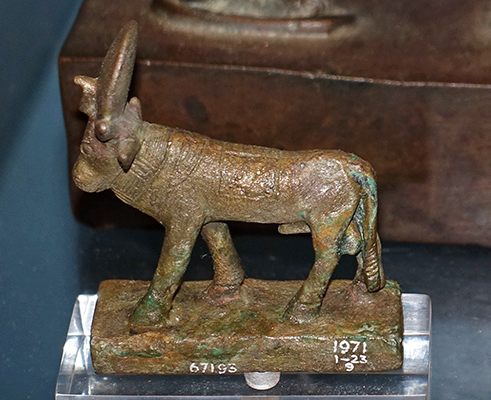
Ptolemaic Dynasty: 305 BC - 30 BC
Apis Bull
Votive figurine of an Apis bull.
Solid-cast copper alloy figure of the Apis Bull with the sun-disc between the horns; incised collar and back-detail including a winged scarab, a saddle-cloth and a vulture; Hieroglyphs on sides of rectangular base.
North Saqqara, Late Period, after 664 BC.
Named in inscription: Hapy, Wahibraseneb (?), Paher.
Height 75 mm, length 52 mm, width 22 mm.
Catalog: Solid-cast copper alloy, North Saqqara, EA67193
Photo: Don Hitchcock 2018
Source: Original, British Museum
Text: © Card with the display at the British Museum, http://www.britishmuseum.org/ , © Trustees of the British Museum, CC BY-NC-SA 4.0
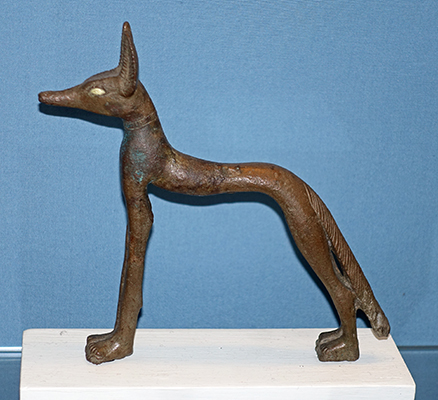
Ptolemaic Dynasty: 305 BC - 30 BC
Jackal
Bronze figure of jackal; inlaid shell eyes.
Height 192 mm, length 181 mm.
Catalog: bronze, shell, North Saqqara, EA67187
Photo: Don Hitchcock 2018
Source: Original, British Museum
Text: © Card with the display at the British Museum, http://www.britishmuseum.org/ , © Trustees of the British Museum, CC BY-NC-SA 4.0
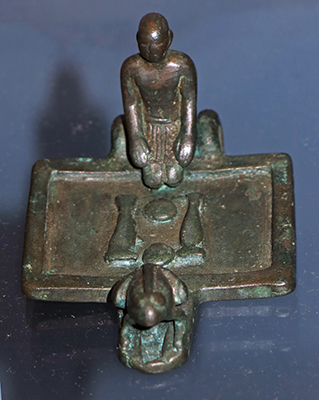
Ptolemaic Dynasty: 305 BC - 30 BC
Miniature offering table
Solid-cast copper alloy model offering-table, rectangular, with a kneeling figure at back, with 2 jars and 2 loaves before, a frog at front above the channel, and 2 suspension loops at the back.
Height 42 mm, length 79 mm, width 59 mm.
Catalog: Copper alloy, Saqqara (Memphis), EA67191
Photo: Don Hitchcock 2015
Source: Original, British Museum
Text: © Card with the display at the British Museum, http://www.britishmuseum.org/ , © Trustees of the British Museum, CC BY-NC-SA 4.0
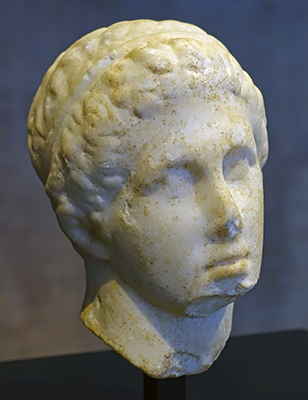
Ptolemaic Dynasty: 305 BC - 30 BC
Male head
Head of a male statue, a king or an athlete.
Early Ptolemaic, 3rd - 2nd century BC
Catalog: Marble, on loan from a private collection.
Photo: Don Hitchcock 2018
Source: Original, Ägyptischen Museum München
Text: Museum card, © Ägyptischen Museum München
The Egyptian Book of the Dead
The Ancient Egyptian designation for this Afterlife guide was 'The Book of Going Out by Day'. It was a collection of chapters chosen and assembled anew for each individual. The term 'Book of the Dead' is modern, as is the numbering of the chapters. The latter were generally preceded by a title - emphasised through the use of red ink - recapitulating the content or meaning of each chapter. Illustrations - the vignettes - explain and round out the texts.
The Book of the Dead was a guide to the Afterlife, designed to familiarise the deceased with the underworld and protect him from danger. Beyond that, it was also meant to secure for him the necessary provisions.
Finally, his Justification is described, his transition into existence as a blessed dead. To this end, he had to answer for his deeds on earth before the Judgment Hall of the Dead and the Lord of the Netherworld, Osiris. If he succeeded, the use of his limbs and organs was returned to him.
( Note that the Book of the Dead contained a total of about 200 chapters, but they were never all together in one collection, a selection was made for each instance - Don )
Text above: Display, © Ägyptischen Museum München
Ptolemaic Dynasty: 305 BC - 30 BC
Pajuheru
Book of the Dead of Pajuheru.
Early Ptolemaic, 3rd - 2nd century BC.
( Click on the image to see the full size image without identification numbers - Don )
( Note that individual spells were often, though not always, combined with specific illustrations, referred to as vignettes, which provided a visual component to the spells' content. The most famous of these is the judgement scene accompanying Chapter 125, in which the heart of the deceased is weighed against the feather of Maat in the hall of Osiris. Some spells consisted only of the illustration itself. Books were often prefabricated in funerary workshops, with spaces being left for the name of the deceased to be written in later. They are often the work of several different scribes and artists whose work was literally pasted together. The cost of a typical book might be equivalent to half a year's salary of a labourer, so the purchase would be planned well in advance of the person's death. The blank papyrus used for the scroll often constituted the major cost of the work, so papyrus was often reused.
Images, or vignettes to illustrate the text, were considered mandatory. The images were so important that often the text is truncated to fit the space available under the image. Whereas the quality of the miniatures is usually done at a high level, the quality of the text is often very bad. Scribes often misspelled or omitted words and inserted the wrong text under the images. - Don )
1. Vignette 154 - Spell for preventing the body from perishing
2. Spell 165 - Spell for mooring (= death). Various deities with unusual names are invoked to protect the deceased's corpse.
3.
Vignette 164 - Another spell to be spoken over a three headed figure of Mut.
( In The Book of the Dead, a spell was spoken over a statue of Mut. The statue had her with three heads - one of the heads was that of a lioness wearing a headdress of two tall plumes, a human head wearing the double crown, and the third being the head of a vulture, again wearing the headdress of two plumes - as well as wings, an erect penis and the paws of a lion. This spell was to protect the dead from being disturbed, and it linked her to Bast, Sekhmet and the sun. In this form she was called Mut, but addressed as Sekhmet-Bast-Ra - Don )
4.
Spell 164 - Another spell. An invocation of various deities protecting the deceased in the realm of the dead.
5.
Vignette 163 Spell for preventing the body of a man to perish in the underworld.
6. Spell 163 - Spell for preventing a man's corpse from putrefying in the realm of the dead.
Catalog: Papyrus, Bayerische Staatsbibliothek
Photo: Don Hitchcock 2015
Source: Original, Ägyptischen Museum München
Text: Display, © Ägyptischen Museum München
Additional text:
Goelet (1998), www.touregypt.net/, www.ucl.ac.uk, oi-idb-static.uchicago.edu/multimedia/239131/oimp39.pdf
Ptolemaic Dynasty: 305 BC - 30 BC
Pajuheru
Book of the Dead of Pajuheru.
Early Ptolemaic, 3rd - 2nd century BC.
( Click on the image to see the full size image without identification numbers - Don )
1. Vignette 161 - Spell for the opening in the sky which the god Thoth made for Wennefer on the day of burial.
( Wennefer was a High Priest of Amun during the end of the Eighteenth Dynasty - Don )
The Ibis headed god of wisdom, Thoth, bears the hieroglyph for the sky and opens up the sky for the four winds (shown here only three times). They are equated with Osiris (north wind), Iah (south wind), Isis (west wind) and Nephthys (east wind), meant to breathe life into the deceased.
2. Vignette 160 - The papyrus-sceptre which Thoth gave at his adoration.
3. Spell 160 - Spell for giving a papyrus-column of green feldspar, given by the god Thoth during his adoration.
4. Spell 161 - Spell for an opening in the sky which Thoth made for Wennefer on the day of interment.
5. Vignette 157 - Vulture of gold placed at the neck of the transfigured spirit.
6. Spell 157 - Spell for a vulture amulet to be placed on the neck of the deceased.
7. Vignette 158 - A broad collar of gold placed at the neck of the transfigured spirit.
8. Spell 158 - Spell for a golden Wesekh broad-collar.
( The Usekh or Wesekh is a personal ornament, a type of broad collar or necklace, familiar to many because of its presence in images of the ancient Egyptian elite. Deities, women, and men were depicted wearing this jewellery. - Don )
9. Vignette 155 - A djed-pillar of gold placed at the neck of the transfigured spirit.
10. Spell 155 - Spell for a Djed pillar of gold to be laid at his throat.
11. Vignette 156 - A tiyet-knot of khenmet-stone placed at the neck of the transfigured spirit.
12. Spell 156 - Spell for a 'blood of Isis' of red jasper to be laid at the throat of the deceased.
( The tiyet or tit symbol, (pronounced teet), illustrates a knotted piece of cloth whose early meaning is unknown, but in the New Kingdom it was clearly associated with the goddess Isis, the great magician and wife of Osiris. By this time, the tit was also associated with blood of Isis. The tit sign was considered a potent symbol of protection in the afterlife and the Book of the Dead specifies that the tit be made of blood-red stone, and placed at the deceased's neck. Knots were widely used as amulets because the Egyptians believed they bound and released magic - Don )
13. Vignette 151 - A vignette meant to assure the protection of the god Anubis for the deceased during embalming.
Catalog: Papyrus, Bayerische Staatsbibliothek
Photo: Don Hitchcock 2015
Source: Original, Ägyptischen Museum München
Text: Display, © Ägyptischen Museum München
Additional text: www.ucl.ac.uk, Wikipedia, www.metmuseum.org
Ptolemaic Dynasty: 305 BC - 30 BC
Pajuheru
Book of the Dead of Pajuheru.
Early Ptolemaic, 3rd - 2nd century BC.
( Click on the image to see the full size image without identification numbers - Don )
1. Vignette 152 - A vignette for building a cult-place which is within the earth.
2. Spell 152 - A spell for building a mansion within the earth. A permanent home in the Netherworld would assure the deceased's provisioning. This spell allows him to call on the gods' help to build one.
3. Vignette 152 - A vignette for building a cult-place which is within the earth.
4. Vignette 148 - A vignette/spell to feed a justified one in the realm of the dead - this means protecting him from all evil.
( The vignette for Spell 148 shows seven cows and a bull, likely associated with the day of burial and seven festivals. The seven celestial cows and their bull were depicted as providers of offerings and rebirth for the deceased. They are also a manifestation of the 'Seven Hathors', who are mentioned in the literary texts as deities of fate, having the skill of predicting the future for the newly born. Spell 148 appears in eight different temples, in several cases more than once. It was likely recited in conjunction with offerings on the day of burial and during seven different festivals. The scene's occurrences in temples were linked with offerings presented to the gods.
This spell provided the names of the Bull of Heaven and his seven cows, providing an eternal supply of food and beer. The names of the cattle are: Mansion of Kas, Mistress of All. Silent One who dwells in her place. She of Chemmis whom the god ennobled. The Much Beloved, red of hair. She who protects in life, the particoloured. She whose name has power in her craft and sucking toes. Storm in the sky which wafts the god aloft. The bull, husband of the cows - Don )
Catalog: Papyrus, Bayerische Staatsbibliothek
Photo: Don Hitchcock 2015
Source: Original, Ägyptischen Museum München
Text: Display, © Ägyptischen Museum München
Additional text: oi-idb-static.uchicago.edu/multimedia/239131/oimp39.pdf, Wikipedia
Ptolemaic Dynasty: 305 BC - 30 BC
Pajuheru
Book of the Dead of Pajuheru.
Early Ptolemaic, 3rd - 2nd century BC.
( Click on the image to see the full size image without identification numbers - Don )
1. Vignette 41 - Spell for fighting off slaughter for a man in the underworld, prevents the deceased from being slaughtered by demonic servants of Osiris.
( Note that this may be Vignette 141, the identification was taken from a digital museum display, and a typo may have occurred - Don )
2. Spell 141 - Book to discern Bas and to know the name of the gods. A list of the gods who received offerings on the 'Festivals of the West'.
3. Vignette 138 - Spell for entering Abydos.
( This Spell shows the deceased praying to Anubis, god of mummification, asking for admission to Abydos, to be near Osiris whose tomb was believed to be there. He hopes to be resurrected like Osiris - Don )
4. Spell 138 - Spell for entering into Abydos. The gods of Abydos greet the deceased once he has successfully passed the Judgement of the Dead.
5. Vignette 63 - Spell for drinking water and not being burned in fire.
6. Spell 137 - Spell for kindling a torch. The torch protects the deceased from the dark of night.
7. Vignette 100 - ( Osiris is pictured on the right with a djed pillar behind him. In front of him is the emblem for the east (Gardiner R15 ![]() ), and on the left of the image is a boat punted by the deceased with a long pole. Behind him sits the sun god and the phoenix - Don )
), and on the left of the image is a boat punted by the deceased with a long pole. Behind him sits the sun god and the phoenix - Don )
8. Spell 100 - Spell for allowing the Ba of a worthy one to rest and permitting him to go down to the Bark of Re with those who are in his suite.
9. Vignette 130 - Spell for making the Ba live for eternity, sending him down to the boat of Ra to pass the circuit of the underworld, to be performed on the day of the birth of Osiris. ( This image depicts the deceased adoring Re while sitting in his Bark - Don )
10. Spell 130 - Spell for preserving a Ba for eternity and letting it enter the Bark of Re together with his crew.
Catalog: Papyrus, Bayerische Staatsbibliothek
Photo: Don Hitchcock 2015
Source: Original, Ägyptischen Museum München
Text: Display, © Ägyptischen Museum München
Ptolemaic Dynasty: 305 BC - 30 BC
Sekhmet
The lioness-headed goddess Sekhmet.
Sekhmet was considered the daughter of the sun god, Ra, and was among the more important of the goddesses who acted as the vengeful manifestation of Ra's power, the Eye of Ra. Sekhmet was said to breathe fire, and the hot winds of the desert were likened to her breath. She was also believed to cause plagues, which were called her servants or messengers, although she was also called upon to ward off disease.
The diorite of which this statue is made is a dark stone with large crystals, extracted, like pink granite, from quarries located south-east of Aswan.
Sekhmet is shown with a sun disk with uraeus on her head, wearing a dress, hands on thighs, holding an ankh sign, sitting on a cubic seat with backrest.
Height 650 mm, width 154 mm, depth 340 mm.
Catalog: Diorite, from Ermant = Hermonthis, found in Italy at the Villa Borghese, Aile Sully, Room 334, Materials and Techniques, Vitrine 4, N 4535, MR 13, AF 547
Photo: Don Hitchcock 2015, 2018
Source and text: Original, Louvre Museum, Paris, France, https://collections.louvre.fr/
Additional text: Wikipedia
Ptolemaic Dynasty: 305 BC - 30 BC
Bes Pantheos
Two figures of Bes Pantheos. Pantheistic deities represent a single god, in this case the dwarf Bes, an apotropaic deity, guardian of young mothers and children, whose attributes and symbols are clearly indicated to the viewer. For the Egyptians of the 1st millennium BC, the accumulation and juxtaposition of all these elements would strengthen the magical power of the god, on the principle that the divine omnipotence could oppose misfortune and evil forces, and protect from their negative effects.
The head of the god Bes has been paired with the body of a young standing man, his left leg placed forward, one arm falling along the body and the other held forward. At his back are a pair of spread wings with two additional arms attached on top of the wings. On the right hand figure, the head gear includes a pair of sinuous ram horns, and two feathers of Amon. Similar additions may once have adorned the head of the left hand figure, which shows damage on the top of the head.
Catalog: Bronze ÄS 920, ÄS 1341
Photo: Don Hitchcock 2018
Source: Original, Ägyptischen Museum München
Text: Museum card, © Ägyptischen Museum München
Additional text: adapted from www.e-tiquities.com
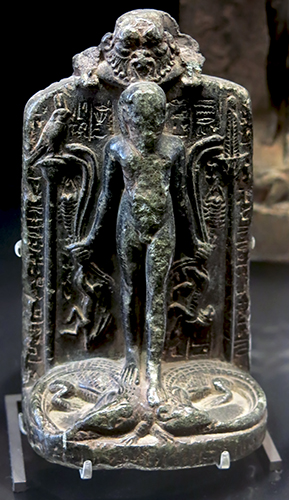
Ptolemaic Dynasty: 305 BC - 30 BC
Stele of Horus
Pendant of serpentite.
This depicts Harpocrates, a deity, standing on crocodiles, slaying pests. Shown nude, with a childhood wick. Also shown are serpents, scorpions, oryx, lion.
Harpocrates was the god of silence, secrets and confidentiality in the Hellenistic religion developed in Ptolemaic Alexandria (and also an embodiment of hope, according to Plutarch). Harpocrates was adapted by the Greeks from the Egyptian child god Horus, who represented the newborn sun, rising each day at dawn.
To the right is the sign for Nefertoum, son of the creator god Ptah, shown, almost without exception, as a beautiful man who wears a crown comprised of a lotus blossom framed by Menat (Hathor) symbols and topped with two tall feathers. The Menats derive from his association with feline goddesses. To the left is Horus as a falcon, on a papyrus stalk.
Above is the head of Bes.
Height 133 mm, length 80 mm, thickness 46 mm.
Catalog: Serpentinite, engraving, high relief, N 4468
Location: Aile Sully, Salle 317, Gods and Magic, Vitrine 2
Photo: Don Hitchcock 2015
Source and text: Original, Louvre Museum, https://collections.louvre.fr/
Additional text: The Met Museum, Wikipedia

Ptolemaic Dynasty: 305 BC - 30 BC
Stele
Horus stele with protective formulas against snake and scorpion bites.
The head of Bes is placed above the child Horus in a protective manner, while Horus controls snakes and scorpions, and stands on crocodiles.
( This format was used for many such steles - Don )
Catalog: Limestone, ÄS 1252
Photo: Don Hitchcock 2015
Source: Original, Ägyptischen Museum München
Text: Museum card, © Ägyptischen Museum München
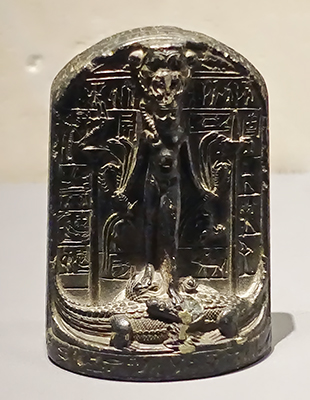
Ptolemaic Dynasty: 305 BC - 30 BC
Horus stela
Horus stela with protective formulas against snake and scorpion bites, 2nd - 1st century BC.
Catalog: Steatite, on loan from a private owner
Photo: Don Hitchcock 2018
Source: Original, Ägyptischen Museum München
Text: Museum card, © Ägyptischen Museum München
Ptolemaic Dynasty: 305 BC - 30 BC
Corn-mummy
Corn-mummy in a wooden coffin. The falcon-headed coffin represents the funerary god Sokar. The corn-mummy has been made in the image of Osiris, and provided with attributes of beeswax and packages representing the Sons of Horus.
Length 559 mm.
Catalog: Tihna el-Gabal, EA41553
Photo: Don Hitchcock 2018
Source: Original, British Museum
Text: © Card with the display at the British Museum, http://www.britishmuseum.org/ , © Trustees of the British Museum, CC BY-NC-SA 4.0

Ptolemaic Dynasty: 305 BC - 30 BC
Ptah-Sokar-Osiris
Painted wooden figure of Ptah-Sokar-Osiris, painted red, yellow, blue, white and green. The face is gilded. The figure is armless, wearing horns, two feathers and sun disc, on a low pedestal, with a figure of Nut below the collar, and a panel at the back of head. The hieroglyphic text on the back and front names the priest Pasenedjemibnakht, son of Hor and Mehythat.
Height 685 mm, height 716 mm.
Catalog: Painted wood, gold, Akhmim, EA16784
Photo: Don Hitchcock 2018
Source: Original, British Museum
Text: © Card with the display at the British Museum, http://www.britishmuseum.org/ , © Trustees of the British Museum, CC BY-NC-SA 4.0
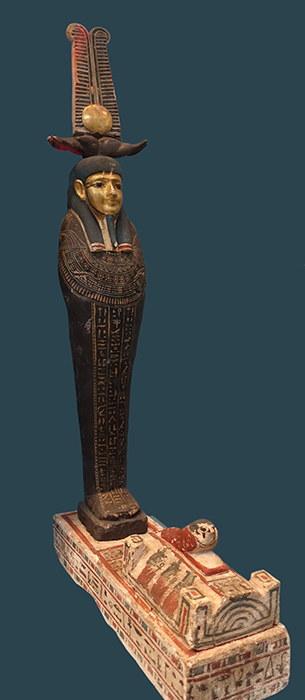
Ptolemaic Dynasty: 305 BC - 30 BC
Ptah-Sokar-Osiris
Painted wooden figure of Ptah-Sokar-Osiris, inscribed for the Neswy.
Circa 250 BC.
The figure has a gilded face and disc; Hieroglyphic text naming Nesuy on plinth; and a compartment with vaulted lid topped with a Sopedu-figure.
Catalog: Painted wood, gold, Thebes (?), EA9737
Photo: Don Hitchcock 2018
Source: Original, British Museum
Text: © Card with the display at the British Museum, http://www.britishmuseum.org/ , © Trustees of the British Museum, CC BY-NC-SA 4.0
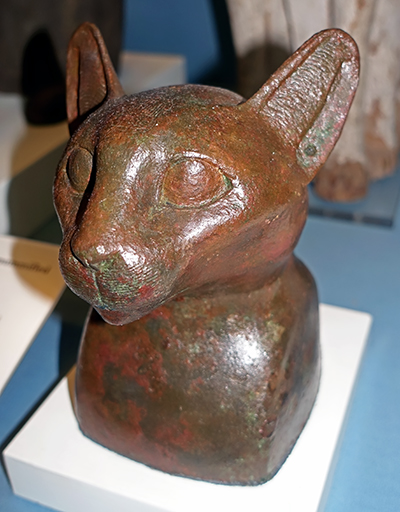
Ptolemaic Dynasty: 305 BC - 30 BC
Bronze Cat Head
Bronze head-piece for a cat mummy, height 127 mm.
Catalog: Bronze, Tell Basta (Bubastis, Nile Delta), EA11561
Photo: Don Hitchcock 2018
Source: Original, British Museum
Text: © Card with the display at the British Museum, http://www.britishmuseum.org/ , © Trustees of the British Museum, CC BY-NC-SA 4.0
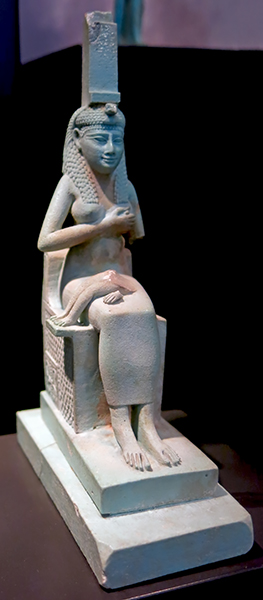
Ptolemaic Dynasty: 305 BC - 30 BC
Isis
The goddess Isis breastfeeding her son Horus. The Christian depictions of Mary with the infant Jesus follow on from this motif.
Early Ptolemaic, circa 300 BC.
Catalog: Faience, Inv 70/9
Photo: Don Hitchcock 2015
Source and text: Badisches Landesmuseum Karlsruhe Germany

Ptolemaic Dynasty: 305 BC - 30 BC
The child Horus
Horus, son of Isis and Osiris, symbolises birth, life and protection from evil powers.
( He is flanked by two representations of Isis, controls two snakes, and stands on crocodiles. A falcon, the sacred animal of Horus, stands on each shoulder - Don )
Catalog: Faience, Inv 62/1
Photo: Don Hitchcock 2015
Source and text: Badisches Landesmuseum Karlsruhe Germany
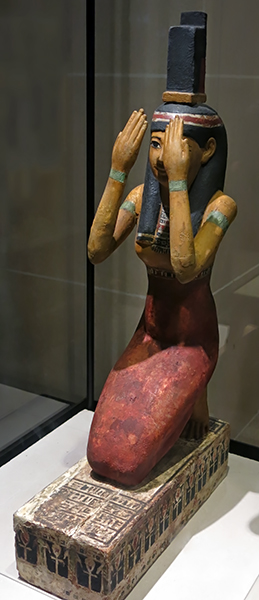
Ptolemaic Dynasty: 305 BC - 30 BC
Isis
![]()
Hieroglyph for Isis, a throne.
Like her sister Nephthys, Isis bears the hieroglyph of her name on her head, in her case the sign for both a throne and Isis.
The statue was dedicated by Irethorrou.
There is a frieze of prophylactic signs around the base.
( This statue is exquisite. It has been carved by a master craftsperson, beautifully painted, and is a masterwork, a delight to contemplate - Don )
Height 605 mm, width 123 mm, depth 315 mm.
Catalog: stuccoed and painted wood, Assassif, West Thebes, TT 414 tomb of Ankhhor, reused for the family of Uahibra, Aile Sully, Room 323, Crypt of Osiris, Vitrine 14, N 4130, Salt no. 3649
Photo and Hieroglyph: Don Hitchcock 2015, 2021
Hieroglyph redrawn after Budge (1920)
Source and text: Original, Louvre Museum, Paris, France, https://collections.louvre.fr/
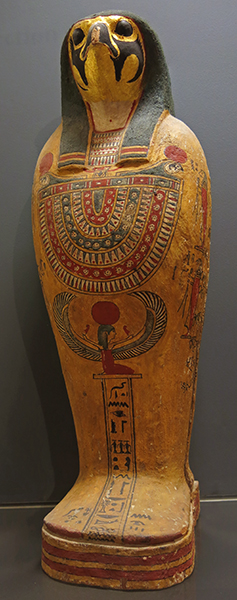
Ptolemaic Dynasty: 305 BC - 30 BC
Osiris
Grave goods consisting of a miniature sarcophagus, and a mummified item (contains a resin mummiform figure of Osiris).
Falcon head with a shroud, Usekh collar, pectoral.
Decoration of a winged goddess kneeling, with a sun disk.
On the sides are the 4 sons of Horus, a series of deities
Inscriptions: Osiris Master of Mernefret
Height 585 mm, width 215 mm, thickness 150 mm.
Catalog: Wood, with gilding, painted and stuccoed, Tehneh = Akoris, east bank Middle Egypt, Aile Sully, Room 323, Crypt of Osiris, Vitrine 6, E 12183
Photo: Don Hitchcock 2015
Source and text: Original, Louvre Museum, Paris, France, https://collections.louvre.fr/
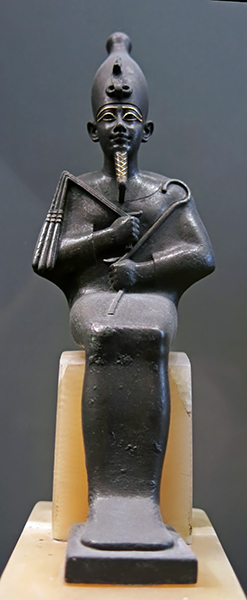
Ptolemaic Dynasty: 305 BC - 30 BC
Osiris
Statuette of Osiris, seated, with a shroud, wearing the Hedjet, the white crown of Egypt, holding a flail and the Heka sceptre, the crook.
Beard, eyes and eyebrows are inlaid with gold.
Height 170 mm.
Catalog: Bronze, gilded, E 3751
Location: Aile Sully, Salle 336, Le Nil, Vitrine 7
Photo: Don Hitchcock 2015
Source and text: Original, Louvre Museum, https://collections.louvre.fr/

Ptolemaic Dynasty: 305 BC - 30 BC
Horresnet
Coffin of Horresnet, a priest of Min, 2nd - 1st century BC.
Catalog: Wood, stucco, gilded, painted, Akhmim, ÄS 1624a-b
Photo: Don Hitchcock 2018
Source: Original, Ägyptischen Museum München
Text: Museum card, © Ägyptischen Museum München
The fragments below are all from a single clepsydra, or water clock
Ptolemaic Dynasty: 305 BC - 30 BC
Water Clock
Fragment of a water clock, or a clepsydra.
As in an hourglass, the water flows through a very small hole drilled at the base; interior graduations indicate the time.
( note that this is a fragment of a large almost cylindrical bowl, with the hours (of the night) marked on the inside - Don )
Height 96 mm, length 101 mm, thickness 30 mm
Catalog: Basalt ( The Louvre catalog says diorite, but it is basalt - Don ), Sully, Rez-de-chaussée, L'écriture et les scribes, Salle 335, Vitrine 6: Poids et mesures, N 664
Photo: Don Hitchcock 2015
Source and text: Original, Louvre Museum, Paris, France
Additional text: http://cartelfr.louvre.fr/cartelfr/visite?srv=car_not_frame&idNotice=3413&langue=fr
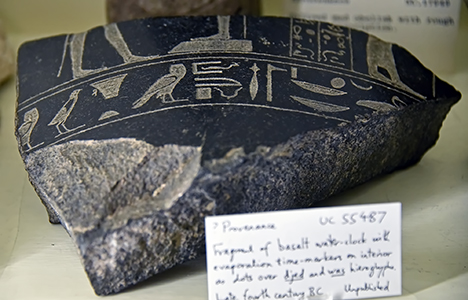
Ptolemaic Dynasty: 305 BC - 30 BC
Water Clock
Another fragment of the water clock above.
Photo: Osama Shukir Muhammed Amin FRCP(Glasg)
Permission: Creative Commons Attribution-Share Alike 4.0 International licence
Ptolemaic Dynasty: 305 BC - 30 BC
Water Clock
Another larger fragment of the water clock above.
Fragment of basalt clepsydra (water clock); on the exterior surface are representations of Philip Arrhidaeus offering to the deities Min, Sekhmet, and an unidentified goddess.
Two bands of hieroglyphic text encircle the top and bottom of the vessel along with a band of stars just below the upper band. On the left, the fragmentary arm of Philip Arrhidaeus offers to the ithyphallic god Min, who wears the double plumes and raises a flail with one arm. Behind Min is a small shine with plant forms and a shen ring. Above are two vertical columns of unfinished hieroglyphic text.
On the right, the goddess Sekhmet stands behind a figure of Philip Arrhidaeus, depicted as a typical Egyptian king. He offers to a goddess of whom only the hand holding a sceptre and feet with the hem of a dress remain. In the inscription, she is named as his mother.
Sekhmet is depicted with the head of a lioness wearing a wig, sun-disc, and sheath dress, and holds a papyrus-sceptre and ankh. Philip Arrhidaeus wears the red crown, projecting kilt with bull’s tail, and offers two nw-jars of wine. On the inner surface are two vertical lines of evenly spaced incised dots.
At the bottom of the fragment are the remaining top halves of a was-sceptre, a djed-pillar, and possibly an ankh carved in sunk relief. The fragment sits on a modern plaster base.
The interior base of this vessel would have been sloped so as to allow water to drip at a fairly steady state from a small hole near the bottom.
( This is not quite correct. The water will drip out fastest when the vessel is full than at any lower height of water no matter what shape the vessel is. However by carefully selecting the shape of the vessel, the water level in the vessel can be made to decrease at a constant rate. When measuring the level of water remaining in the vessel, the time can be measured with uniform graduation. Since the water outflow rate is higher when the water level is higher (due to more pressure), the fluid's shape should be different to a simple cylinder, it should be a frustum of a cone.
In simpler terms, the interior radius should be larger when the water level is higher, and gradually decrease towards the base. This would have been attained by the ancient Egyptians using trial and error, probably using a series of pottery vessels made with different internal slopes, selecting the closest two above and below the true value, then throwing more pots which converged on the correct slope, and using that value for the final basalt water clock. However by applying Torricelli's law to the problem, the radius of the container should change in proportion to the fourth root of its height:
thus r ∝ ∜ h - Don )
The marks on the inside served to measure each hour as the water level decreased. The marks are differently spaced for different seasons because of the change in the length of the night with the seasons. Water clocks were likely used by priests to determine the hours of the night for the performance of temple rituals.
Philip Arrhidaeus, also known as Philip III, succeeded Alexander the Great as king of Macedon and ruler of Egypt, though he only ruled briefly for about six years before he was assassinated. He was a son of Philip II and half-brother to Alexander, and was reputed to be ‘half-witted’. A sanctuary was built in his name in the temple of Karnak on the site of an earlier sanctuary built by Thutmose III.
Dimensions:
Height: 405 mm (Object and Base)
Height: 340 mm (Object)
Weight: 18.60 kilograms
Width: 324 mm (Base)
Width: 30 centimetres (Object: max)
Depth: 146 mm (Base)
Depth: 70 mm (Object: max)
Catalog: Circa 320 BC, Nile Delta area, Tell el-Yahudiya (?), EA933
Photo: © British Museum
Permission: Creative Commons Attribution-NonCommercial-ShareAlike 4.0 International (CC BY-NC-SA 4.0) licence
Source: Original, British Museum
Text: http://www.britishmuseum.org/, © Trustees of the British Museum, CC BY-NC-SA 4.0
Additional text: Wikipedia
Ptolemaic Dynasty: 305 BC - 30 BC
Water Clock
Fragment of a basalt clepsydra (water clock), circa 320 BC. On the exterior surface are representations of Philip Arrhidaeus offering to the deities Min, Sekhmet, and an unidentified goddess and Hieroglyphic text.
Two bands of hieroglyphic text encircle the top and bottom of the vessel along with a band of stars just below the upper band. On the left, the fragmentary arm of Philip Arrhidaeus offers to the ithyphallic god Min, who wears the double plumes and raises a flail with one arm. Behind Min is a small shrine with plant forms and a shen ring.
( a shen ring was a circle with a line tangent to it, often carried in the claw of the falcon god Horus - Don )
Above are two vertical columns of unfinished hieroglyphic text. On the right, the goddess Sekhmet stands behind a figure of Philip Arrhidaeus, depicted as a typical Egyptian king. He offers to a goddess of whom only the hand holding a sceptre and feet with the hem of a dress remain.
In the inscription, she is named as his mother. Sekhmet is depicted with the head of a lioness wearing a wig, sun-disc, and sheath dress, and holds a papyrus-sceptre and ankh. Philip Arrhidaeus wears the red crown, projecting kilt with bull’s tail, and offers two nw-jars of wine.
On the inner surface are two vertical lines of evenly spaced incised dots. At the bottom of the fragment are the remaining top halves of a was-sceptre, a djed-pillar, and possibly an ankh carved in sunk relief. The fragment sits on a modern plaster base.
Catalog: Basalt, Nile Delta, Tell el-Yahudiya, EA938
Photo: © Trustees of the British Museum
Permission: Creative Commons Attribution-NonCommercial-ShareAlike 4.0 International (CC BY-NC-SA 4.0) licence
Source: Original, British Museum
Text: http://www.britishmuseum.org/, © Trustees of the British Museum, CC BY-NC-SA 4.0
Ptolemaic Dynasty: 305 BC - 30 BC
Water Clock
Fragment of a clepsydra whose outer face is finely engraved with a pharaoh holding two libation vases, it is topped with the red crown of Lower Egypt and wears a short loincloth. Behind him a leonine deity holds a sceptre and is crowned with a solar disc. This is Sekhmet.
In front of the pharaoh must have been the goddess Hathor (known from the text before her). These two goddesses symbolise two of the months of the Nile flood. The scene is surmounted by a hieroglyphic inscription and two unfinished cartouches (probably those of Alexander the Great according to the study of the Egyptologist Guy Lodomez). A band of star motifs surmounts the scene.
On the reverse side the piece is pierced with several equidistant holes aligned vertically. This fragment comes from the same clepsydra as the three fragments preserved in the Louvre (E 30890), the British Museum (EA 933) and Berlin (30508). Two of these fragments mention Alexander the Great.
Basalt.
Egypt, Ptolemaic Period, period of Alexander the Great (332-323 BC) 18.7 x 17 cm.
The clepsydra, or water clock, certainly appeared during the reign of Amenhotep III (18th dynasty, 1417-1379 BC). The most classical form of the Egyptian clepsydra is that of a conical vase, from which water escaped through a hole in the base.
Twelve months are engraved all around, on the upper part of the vase. Under each of these months, 11 circular marks represent the hours of the night, engraved vertically. The distance between these marks depends on the month. The clepsydras were also engraved with deities related to the months of the year and astronomical representations.
The clepsydra is of great importance in Egyptian rituals: specialised priests (Hours Officers) calculated the hours of the night, thus enabling the smooth running of cosmic and mythological night rituals.
Text: Bianchi, R.S., Satrapenstel
Source: https://www.gazette-drouot.com/en/lots/5495753
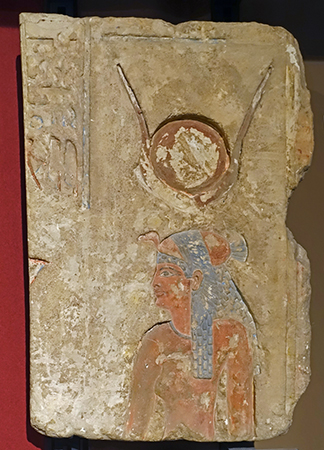
Ptolemaic Dynasty: 305 BC - 30 BC
Hathor
Relief of the goddess Hathor, 3rd - 2nd century BC.
Catalog: Painted limestone, Herakleopolis (?), Inv. Nr. 1956.18
Photo: Don Hitchcock 2018
Source and text: Original, Museum August Kestner, Hannover
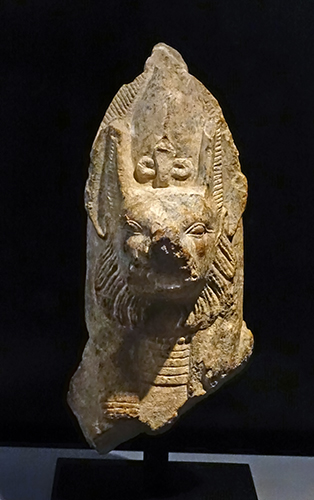
Ptolemaic Dynasty: 305 BC - 30 BC
Anubis
Upper half from a figure of the god Anubis, 3rd - 2nd century BC.
Catalog: Limestone, ÄS 7211
Photo: Don Hitchcock 2018
Source: Original, Ägyptischen Museum München
Text: Museum card, © Ägyptischen Museum München
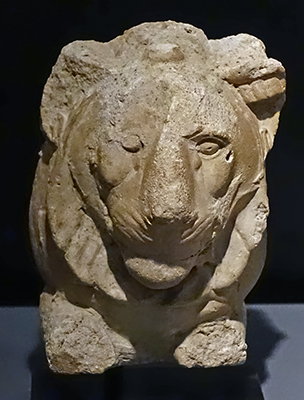
Ptolemaic Dynasty: 305 BC - 30 BC
Lion's Head
Antique moulding of a sculptor's model for a lion's head, 3rd - 2nd century BC.
Catalog: Plaster, ÄS 1382
Photo: Don Hitchcock 2018
Source: Original, Ägyptischen Museum München
Text: © Ägyptischen Museum München
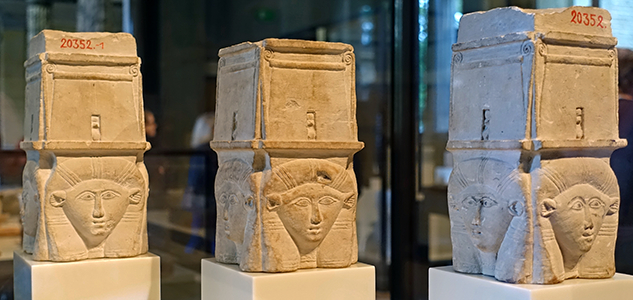
Ptolemaic Dynasty: 305 BC - 30 BC
Hathor capitals
Hathor capitals with demotic inscriptions (architectural models)
Circa 323 BC - 230 BC
These Hathor columns with representations on four sides relate to an understanding of Hathor as a cosmic and powerful goddess, her face directed to the four corners of the earth.
165 x 103 x 102 mm ÄM 20351/2
This capital belongs to the group of sculptor models. It depicts the head of the goddess Hathor on all four sides in a frontal view. Characteristic features of the representation of the goddess Hathor are her cow ears and the powerful wig. On the top of her head she carries a divine Naos (shrine symbol) in which a uraeus snake is recognisable. In addition, on the outsides sit two elongated volutes (spiral scrolls). (J. Helmbold-Doyé)
165 x 103 x 102 mm for ÄM 20351/02
183 x 104 x 104 mm for ÄM 20352/1
Catalog: painted limestone, Tuna el-Gebel (?), 20352/1, ÄM 20351/2, 20352/3
Photo: Don Hitchcock 2018
Source: Original, Staatliche Museen zu Berlin, Neues Museum, Germany
Text: © Card at the Staatliche Museen zu Berlin, http://www.smb-digital.de/, (CC BY-NC-SA 3.0 DE)
Additional text: https://www.metmuseum.org/art/collection/search/553852
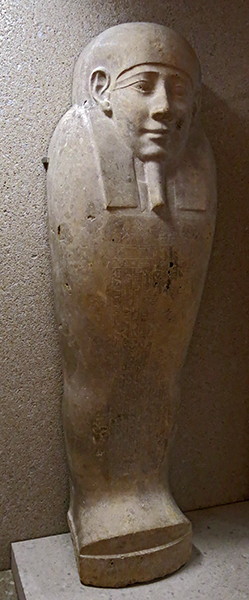
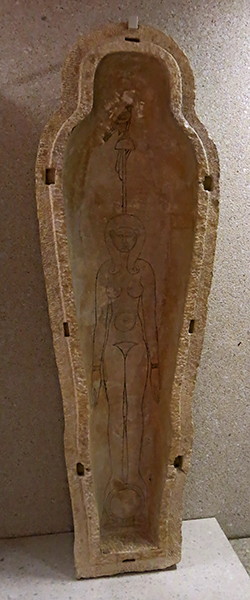
Ptolemaic Dynasty: 305 BC - 30 BC
Wennefer
Sarcophagus of Wennefer, figure of the goddess of the necropolis.
Catalog: Limestone, ÄM 46
Photo: Don Hitchcock 2015
Source: Original, Staatliche Museen zu Berlin, Neues Museum, Germany
Text: © Card at the Staatliche Museen zu Berlin, (CC BY-NC-SA 3.0 DE)
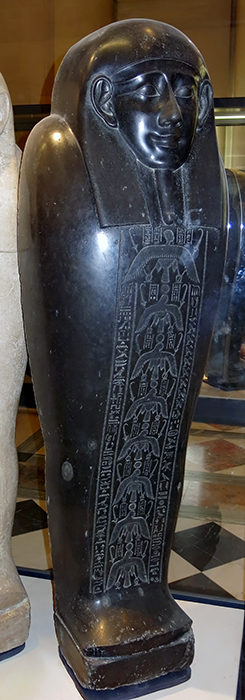
Ptolemaic Dynasty: 305 BC - 30 BC
Ankhmerut
Sarcophagus, shroud, tripartite wig, coiled false beard.
Decoration: Sun discs and Ba-birds, wings outstretched, holding Shen rings.
Length 1885 mm, width 630 mm.
Catalog: Basalt, Salle 321, The sarcophagi, Vitrine 1, D 7, N 343
Photo: Don Hitchcock 2015
Source and text: Original, Louvre Museum, Paris, France, https://collections.louvre.fr/
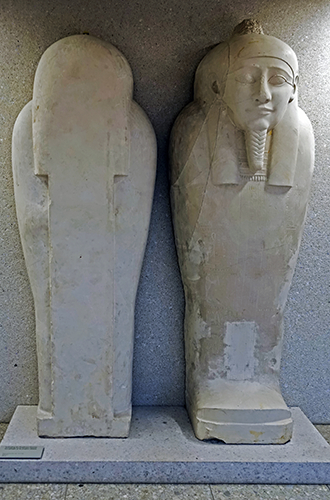
Ptolemaic Dynasty: 305 BC - 30 BC
Ahmose
Sarcophagus of the prophet Ahmose.
Catalog: Limestone, ÄM 38
Photo: Don Hitchcock 2018
Source: Original, Staatliche Museen zu Berlin, Neues Museum, Germany
Text: © Card at the Staatliche Museen zu Berlin, (CC BY-NC-SA 3.0 DE)
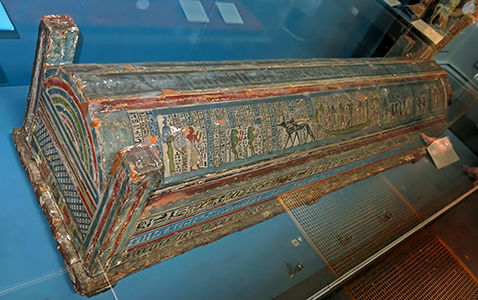
Ptolemaic Dynasty: 305 BC - 30 BC
Ankh-hap
Painted wooden coffin of Ankh-hap, also known as Hapiankh.
Ptolemaic Period, 305 BC - 030 BC, probably from Thebes / Luxor.
The coffin was made for the temple singer Ankh-hap, son of Djehuty-maa and Tadineferhotep. Ankh-hap's mummy is that of a young man. A pair of bronze cymbals lay on it when it was discovered.
It consists of a painted wooden baseboard and vaulted cover of the wooden coffin of Hapiankh, Doorkeeper of Amun. The rectangular baseboard is painted white on the interior and decorated with a full-length representation of Nut in red outline; the cover is rectangular with a vaulted top and four corner posts, covered with stucco and brightly decorated.
One gable end is decorated with a winged solar disc and wedjat-eyes, the sides are decorated with three horizontal registers of hieroglyphs, the top is decorated with, on one side, a funerary boat, towed by jackals, which conveys the mummified body of the deceased through the underworld, with canopic jars beneath the bier, and the four Sons of Horus behind.
Baboons greet the cortege and, on the other side, a boat transports the standard of Abydos with Horus and Thoth, Maat looks out from the prow, Amentet is represented, standing with the deceased, on both sides.
These scenes are surrounded by registers of text, with a central register along the top; this coffin contained the mummy 6711 when it entered the collection.
Catalog: EA6710
Photo: Don Hitchcock 2015
Source: Original, British Museum
Text: http://www.britishmuseum.org, card with the display at the British Museum, © Trustees of the British Museum
Ptolemaic Dynasty: 305 BC - 30 BC
Horsanakht
Painted wooden coffin of Horsanakht.
Ptolemaic Period, 305 - 030 BC, from Kharga Oasis.
The proportions of this coffin, with large wig, high shoulders, and broad pedestal, are characteristic of the Ptolemaic Period.
The breast is decorated with a very large collar with falcon-head terminals. Below this is the winged goddess Nut, the mummy on a bier tended by Anubis, and a series of protective deities. The hieratic text has been crudely inserted into a space left blank for this purpose by the painter.
Base and lid of the anthropoid wooden coffin of Harsinakht, with rich polychrome painted decoration on a black ground: elaborate wig and floral collar with a pectoral, with squatting figures of Osiris, Isis and a solar deity; Nut, with outstretched wings, flanked by crowned and winged uraei, protects the abdomen; a vignette, showing Anubis in the act of mummifying the deceased, flanked by figures of Isis and Nephthys in the attitude of mourning, below; and a vertical register of crude hieratic, giving the name of the deceased, runs down the legs between two columns of underworld deities, the inscription was probably added when the coffin was purchased from the workshop.
Representations of Osiris, Isis, Nut, Anubis, Nephthys.
Catalog: Painted wood, Kharga Oasis, EA52949
Photo: Don Hitchcock 2015, 2018
Source: Original, British Museum
Text: Card with the display at the British Museum, © Trustees of the British Museum
Ptolemaic Dynasty: 305 BC - 30 BC
Horsanakht
Painted wooden coffin of Horsanakht, close up.
Catalog: EA52949
Photo: Don Hitchcock 2018
Source: Original, British Museum
Text: www.britishmuseum.org/, card at the display in the British Museum, © Trustees of the British Museum, CC BY-NC-SA 4.0
Ptolemaic Dynasty: 305 BC - 30 BC
Imhotep
The wise and learned Imhotep.
Statue dedicated by Ouahibre. On the papyrus that Imhotep holds, one can read: 'May the water of the cup of each scribe (be offered in libation) to your ka, Imhotep'.
The stone used is described as greywacke by the museum card, and basalt by the online catalog.
Height: 455 mm, width 110 mm, depth 240 mm.
Imhotep, 'the one who comes in peace', was an Egyptian chancellor to the Pharaoh Djoser, probable architect of Djoser's step pyramid, and high priest of the sun god Ra at Heliopolis. Very little is known of Imhotep as a historical figure, but in the 3 000 years following his death, he was gradually glorified and deified.
Traditions from long after Imhotep's death treated him as a great author of texts of wisdom and especially as a physician. No text from his lifetime mentions these capacities and no text mentions his name in the first 1 200 years following his death.
Apart from the three short contemporary inscriptions that establish him as chancellor to the Pharaoh, the first text to reference Imhotep dates from the time of Amenhotep III, circa 1 391 BC - 1353 BC. It is addressed to the owner of a tomb, and reads:
The wab-priest may give offerings to your ka. The wab-priests may stretch to you their arms with libations on the soil, as it is done for Imhotep with the remains of the water bowl.
It appears that this libation to Imhotep was done regularly, as they are attested on papyri associated with statues of Imhotep until the Late Period, circa 664 BC - 332 BC. Wildung explains the origin of this cult as a slow evolution of intellectuals' memory of Imhotep, from his death onward. Gardiner finds the cult of Imhotep during the New Kingdom (circa 1 550 BC - 1077 BC) sufficiently distinct from the usual offerings made to other commoners that the epithet 'demi-god' is likely justified to describe his veneration.
The first references to the healing abilities of Imhotep occur from the Thirtieth Dynasty (circa 380 BC - 343 BC) onward, some 2 200 years after his death.
Imhotep is among the few non-royal Egyptians who were deified after their deaths, and until the 21st century, he was thought to be only one of two commoners – along with Amenhotep, son of Hapu – to achieve this status. The centre of his cult was in Memphis. The location of his tomb remains unknown, despite efforts to find it. The consensus is that it is hidden somewhere at Saqqara.
Catalog: Ptolemaic, N 4541
Photo: Don Hitchcock 2015, 2018
Source and text: Original, Louvre Museum, Paris, France, https://collections.louvre.fr/
Additional text: Wikipedia
Ptolemaic Dynasty: 305 BC - 30 BC
Imhotep
Imhotep with a shaved head, seated on a chair, wearing a skirt, an Usekh necklace, and holding a papyrus scroll.
Height 130 mm, width 44 mm, thickness 97 mm.
Catalog: (left) Bronze, E 4216
Location: Room 336, Le Nil, Vitrine 7
Photo: Don Hitchcock 2015
Source and text: Original, Louvre Museum, Paris, France, https://collections.louvre.fr/
Catalog: (centre and right) Bronze, 6th - 5th Century BC, ÄS 5314
Photo: Don Hitchcock 2018, 2015
Source: Original, Ägyptischen Museum München
Text: Museum card, © Ägyptischen Museum München
Deified MortalsText above: Poster, © Ägyptischen Museum München
In some rare cases, historical figures could be integrated into the circe of gods - men who had become cultural heroes through innovative accomplishments, who had at first been revered simply as wise men and finally been deified. Among them are two architects: Imhotep, who had erected the earliest monumental stone structure around 2 650 BC, the step pyramid of Djoser; and Amenhotep-Son-of-Hapu, who had designed the monumental temples of Amenhotep III around 1 375 BC.
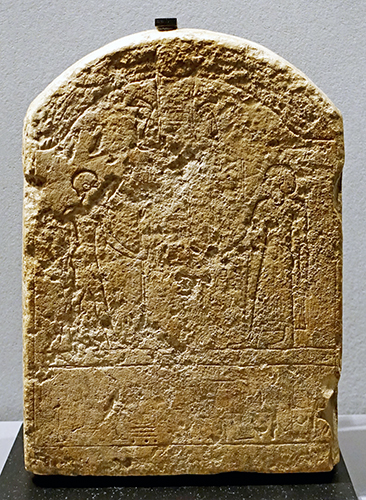
Ptolemaic Dynasty: 305 BC - 30 BC
Stele
Stele depicting two famous architects, Imhotep and Amenhotep-Son-of-Hapu, here rendered as gods. Circa 150 BC - 100 BC.
Catalog: Limestone, on loan from a private collection
Photo: Don Hitchcock 2018
Source: Original, Ägyptischen Museum München
Text: Museum card, © Ägyptischen Museum München
Additional text: Wikipedia
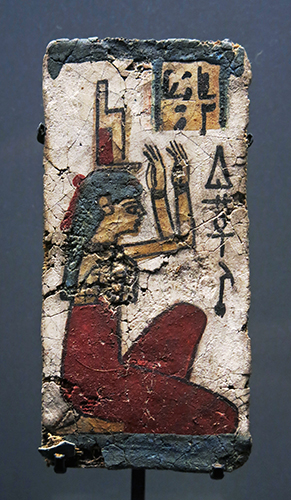
Ptolemaic Dynasty: 305 BC - 30 BC
Weeping Isis
Isis is shown kneeling, arms raised, weeping. She is wearing the headdress of Isis on this fragment of the trim from a mummy.
Height 88 mm, width 42 mm.
Catalog: Stuccoed fabric, AF 258
Location: Aile Sully, Salle 336, Le Nil, Vitrine 7
Photo: Don Hitchcock 2015
Source and text: Original, Louvre Museum, https://collections.louvre.fr/
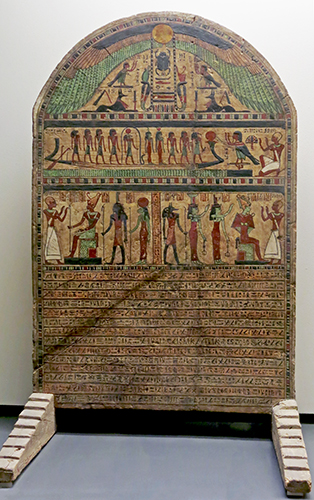
Ptolemaic Dynasty: 305 BC - 30 BC
Osiris
Circa 299 BC - 200 BC
Arch register at top:
Winged solar disc with uraei, one with the red crown, one with the white (shown here as green), two ba-birds with arms, worshipping, two images of Wepwawet depicted as a wolf or jackal, and in a central frame formed of alternating rectangles, an image of a scarab.
First register, below the arch register: adoration scene. A man in a skirt, sash, with a shaved head, is kneeling, worshipping. Between him and a worshipping ba-bird is a fan. Taking up much of the width of the register is the boat of Ra. Ra is shown as a ram-headed god, with the headdress of a sun disc, holding a was sceptre, with a serpent forming an arch over his head. Ra is flanked by nine deities.
In the second register is a pair of worship scenes, symmetrical, with a man in a skirt with sash, shaved head, standing and worshipping. Atum is shown seated on the left, wearing the pschent crown, with Shu behind him, god of the air and supporter of the sky, created by Atum by his own power, without the aid of a woman. Shu and his sister and companion, Tefnut (lion-headed goddess of moisture, standing behind Shu), were the first couple of the group of nine gods called the Ennead of Heliopolis.
On the right is Osiris, seated, Isis standing behind him with her distinctive headdress, Nephthys behind her with her headdress, and behind them is Anubis, the dog-headed god.
The decree of Osiris reads:
'Royal decree promulgated by His Majesty the king of Upper and Lower Egypt Unnefer (Osiris): You, the great gods of the necropolis of Abydos, the blessed in the court of Osiris, the deceased in the great court... you, the gods and goddesses in the hill of Djame, the perfect blessed in the west of Thebes, you, the gods in their totality, keep silent, keep silent and listen to the decision of Amun-Ra, master of the thrones of the double country and chief of Karnak, of Atum, master of the double country and chief of Heliopolis, of Ptah who is south of his wall, lord of Memphis, of Nun the ancestor, father of the gods, who have declared: The first priest of Amun Usirur, son of the first priest of Amun Nespattaoui and of the musician of Amun-Ra Nehemesrattaoui, enters your house. Introduce him into the first court of the West, the secret palace of the master of the universe; be propitious to him when he appears in the world of the dead, as to Ra when he emerges from the earth; pay him homage and prostrate yourselves before him; make him stand beside his deathbed...
...grant him strength, let him eclipse the souls of the gods; let him reach the pure abode of Ra without falling into the snares of the wicked; fill him with life, let his old age be green, let his gait be sure and his vigour great, let him be noble among the noble; open to him the fountains of life, let his throat be quenched. Give him access to the secret dwelling, since he is under the protection of the one south of his wall; place him on the great funeral bed, with Isis to mourn him and Nephthys to watch over him, since he is under the protection of Osiris Unnefer, ruler of the West; give him consideration, since he is under the protection of Horakhti with shimmering plumage (...)'.
Height 847 mm, width 530 mm, thickness 30 mm.
Catalog: Painted wood, N 2699, Durand no. 297
Location: Aile Sully, Salle 323, Crypt of Osiris, Vitrine 11
Photo: Don Hitchcock 2015
Source and text: Original, Louvre Museum, https://collections.louvre.fr/

Ptolemaic Dynasty: 305 BC - 30 BC
Neniset
This is an adoration scene, with a woman, Neniset, standing, worshipping. Horakhty Ra, a falcon-headed god, is standing wearing a solar disc with uraeus. Atum is standing, wearing a pschent crown.
Within the arch above is an offering table, a winged solar disc with uraeus, a boat of Ra, flanked by two wedjat eyes.
Neniset's father is listed as Irurdjat, her mother, householder, as Taimenetnesouttaouy.
Height 460 mm, width 280 mm, thickness 33 mm.
Catalog: Painted wood, E 20044
Location: Aile Sully, Salle 323, Crypt of Osiris, Vitrine 11
Photo: Don Hitchcock 2015
Source and text: Original, Louvre Museum, https://collections.louvre.fr/
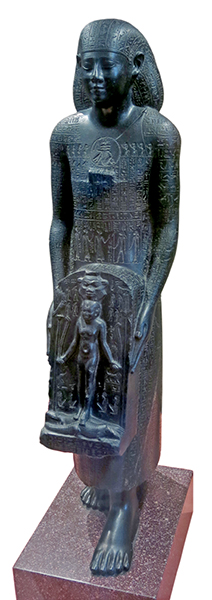
Ptolemaic Dynasty: 305 BC - 30 BC
Harpocrates
Healing statue of Harpocrates slaying pests.
A man is standing, in a high skirt, wearing a 'pocket wig' (his hair or wig is covered with cloth), presenting a stele of Harpocrates.
Harpocrates is standing on two crocodiles, holding snakes. The head of Bes is above him. There are a series of deities as decoration on the stele, and on the chest and skirt of the man. The statue is entirely covered with texts.
Height 677 mm, total height 760 mm, total width 195 mm, total weight 80 kg.
Catalog: Basalt, E 10777
Location: Aile Sully, Salle 323, Crypt of Osiris, Vitrine 11
Photo: Don Hitchcock 2015
Source and text: Original, Louvre Museum, https://collections.louvre.fr/
Ptolemaic Dynasty: 305 BC - 30 BC
Isis
Standing figure of the goddess Isis.
Circa 3rd Century BC.
Catalog: Granite, Gl.WAF 26b
Photo: Don Hitchcock 2015, 2018
Source: Original, Ägyptischen Museum München
Text: Museum card, © Ägyptischen Museum München
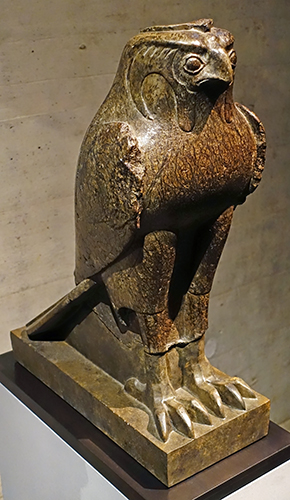
Ptolemaic Dynasty: 305 BC - 30 BC
Horus
Figure of the god Horus as a falcon.
Circa 3rd Century BC.
Catalog: Granite, Upper Egypt, Gl.133
Photo: Don Hitchcock 2018
Source: Original, Ägyptischen Museum München
Text: Museum card, © Ägyptischen Museum München
Ptolemaic Dynasty: 305 BC - 30 BC
Head of a royal statue
2nd century BC
Catalog: Basalt, ÄS 5302
Photo: Don Hitchcock 2015, 2018
Source: Original, Ägyptischen Museum München
Text: Museum card, © Ägyptischen Museum München
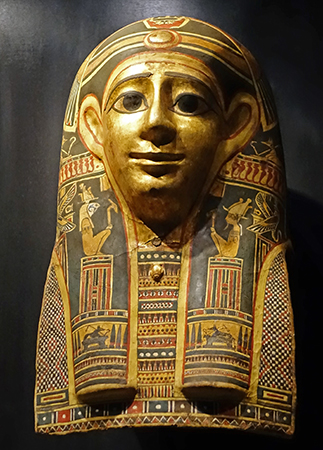
Ptolemaic Dynasty: 305 BC - 30 BC
Mummy Mask
Mummy mask with a winged scarab and images of gods, 2nd century BC.
( The scarab is only partially visible on the back of the head of the mask. The gods include Horus, the falcon headed god, shown here on the left with a Was sceptre and wearing a crown, with Osiris on the right. Below are two matching images of Anubis, each with a crook and a flail - Don )
Catalog: Cartonnage, gold. no catalog number ascribed.
Photo: Don Hitchcock 2018
Source: Original, Ägyptischen Museum München
Text: Museum card, © Ägyptischen Museum München
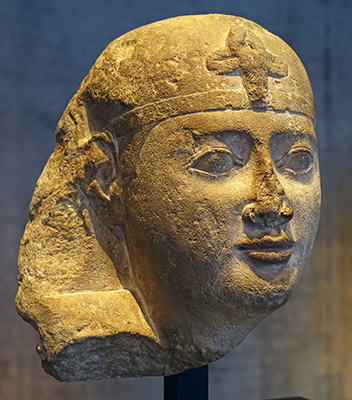
Ptolemaic Dynasty: 305 BC - 30 BC
Head of a royal statue
Circa 3rd century BC.
From el Behnasa, or Oxyrhynchus.
Oxyrhynchus is a city in Middle Egypt located about 160 km south-southwest of Cairo in Minya Governorate. It is also an archaeological site, considered one of the most important ever discovered. Since the late 19th century, the area around Oxyrhynchus has been excavated almost continually, yielding an enormous collection of papyrus texts dating from the Ptolemaic Kingdom and Roman Egypt. Among the texts discovered at Oxyrhynchus are plays of Menander, fragments from the Gospel of Thomas, and fragments from Euclid's Elements. They also include a few vellum manuscripts, and more recent Arabic manuscripts on paper (for example, the medieval P. Oxy. VI 1006)
Catalog: Limestone, el Behnasa (Oxyrhynchus), ÄS 5526
Photo: Don Hitchcock 2015, 2018
Source: Original, Ägyptischen Museum München
Text: Museum card, © Ägyptischen Museum München
Additional text: Wikipedia
Ptolemaic Dynasty: 305 BC - 30 BC
Male mummy
Male mummy, mummy trim (boot, leggings, pectoral). The mummy is covered with cartonnage that may have been added to it and does not necessarily belong to it.
Names and titles: Pacheri (?); Tariut (mother)
Height: 1660 mm.
Also included is a wreath, possibly for the head as a form of crown.
Catalog: Linen, glued fabric and stucco, N 2627
Location: Aile Sully, Salle 322, La Momie, Vitrine 1
Photo: Don Hitchcock 2015
Source and text: Original, Louvre Museum, https://collections.louvre.fr/
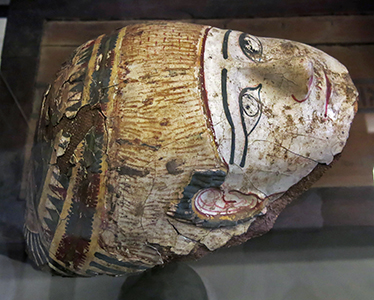
Ptolemaic Dynasty: 305 BC - 30 BC
Mummy mask from the mummy above.
Catalog: Linen, glued fabric and stucco, N 2627
Location: Aile Sully, Salle 322, La Momie, Vitrine 1
Photo: Don Hitchcock 2015
Source and text: Original, Louvre Museum, https://collections.louvre.fr/
Ptolemaic Dynasty: 305 BC - 30 BC
Chest
Decoration: two men standing, one on each side presenting a censer, two carvings of Osiris standing, wearing a shroud, cloak, and atef crown, two winged goddesses standing, each with a sun disk headdress and ostrich feather, two wedjat eyes on cornice plinths.
( This is a superbly made bas relief in wood, expertly stained and varnished - Don )
Height 146 mm, length 475 mm, thickness 24 mm.
Catalog: Wood, gilded, painted, stuccoed, Aile Sully, Salle 323, Crypte d'Osiris, Vitrine 8, N 3733, CC 77
Photo: Don Hitchcock 2015
Source and text: Original, Louvre Museum, Paris, France, https://collections.louvre.fr/
Additional text: Wikipedia
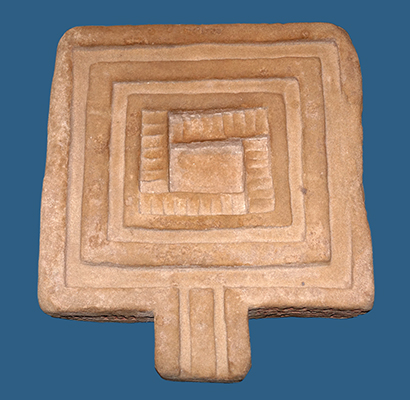
Ptolemaic Dynasty: 305 BC - 30 BC
Offering Table
Sandstone offering table from the burial of a Buchis bull. Central square well with steps and hieroglyphic inscription.
Circa 332 BC - 30 BC
Height 70 mm, length 310 mm, width 280 mm.
The hieroglyphic inscription contains a prayer to the sacred Buchis bull.
Catalog: Armant, EA1778
Photo: Don Hitchcock 2018
Source: Original, British Museum
Text: Card with the display at the British Museum, https://www.britishmuseum.org/, © Trustees of the British Museum, CC BY-NC-SA 4.0
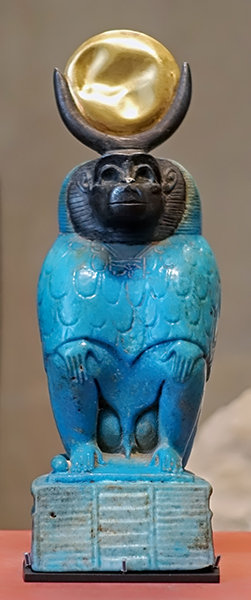
Ptolemaic Dynasty: 305 BC - 30 BC
Thoth as a baboon
Thoth portrayed as a baboon, with hands on thighs and a golden disc on his head.
He is often represented, as shown in this figurine, as the reckoner of times and seasons by a headdress of the lunar disk sitting on top of a crescent moon resting on his head.
Height 150 mm, width 50 mm, thickness 56 mm.
Made of faience, with additions of silver and gold.
Catalog: Ptolemaic, Touna el-Gebel, Tanis Superior (Middle Egypt - Western shore of Middle Egypt), E 17496
Photo: Don Hitchcock 2018
Source and text: Original, Louvre Museum, Paris, France, https://collections.louvre.fr/
Additional text: Wikipedia
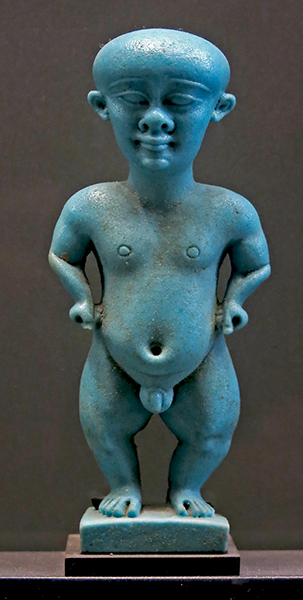
Ptolemaic Dynasty: 305 BC - 30 BC
Dwarf figurine
This light blue dwarf is standing, naked.
Ancient Egypt was one of the most advanced and productive civilisations in antiquity, spanning 3 000 years before the 'Christian' era. Ancient Egyptians built colossal temples and magnificent tombs to honour their gods and religious leaders. Their hieroglyphic language, system of organisation, and recording of events give contemporary researchers insights into their daily activities. Based on the record left by their art, the ancient Egyptians documented the presence of dwarfs in almost every facet of life.
Due to the hot dry climate and natural and artificial mummification, Egypt is a major source of information on achondroplasia in the old world. The remains of dwarfs are abundant and include complete and partial skeletons. Dwarfs were employed as personal attendants, animal tenders, jewelers, and entertainers. Several high-ranking dwarfs especially from the Old Kingdom (2 700 BC - 2 190 BC) achieved important status and had lavish burial places close to the pyramids. Their costly tombs in the royal cemeteries and the inscriptions on their statutes indicate their high-ranking position in Egyptian society and their close relation to the king. Some of them were Seneb, Pereniankh, Khnumhotpe, and Djeder.
There were at least two dwarf gods, Ptah and Bes. The god Ptah was associated with regeneration and rejuvenation. The god Bes was a protector of sexuality, childbirth, women, and children. He was a favoured deity particularly during the Greco-Roman period. His temple was recently excavated in the Baharia oasis in the middle of Egypt. The burial sites and artistic sources provide glimpses of the positions of dwarfs in daily life in ancient Egypt. Dwarfs were accepted in ancient Egypt; their recorded daily activities suggest assimilation into daily life, and their disorder was not shown as a physical handicap. Wisdom writings and moral teachings in ancient Egypt commanded respect for dwarfs and other individuals with disabilities.
Height 91 mm.
Catalog: Faience, AF 1667
Location: Aile Sully, Salle 336, Le Nil, Vitrine 7
Photo: Don Hitchcock 2015
Source and text: Original, Louvre Museum, Paris, France, https://collections.louvre.fr/
Additional text: https://pubmed.ncbi.nlm.nih.gov/16380966/

Ptolemaic Dynasty: 305 BC - 30 BC
Diptah
Coffin of Diptah
The carving of the dead man has a golden face, a sign of divinity.
Wood; site Achim; 300-250 BC, Ptolemaic Dynasty.
Photo: Don Hitchcock 2014
Source: Original, Rijksmuseum van Oudheden, National Museum of Antiquities, Leiden.
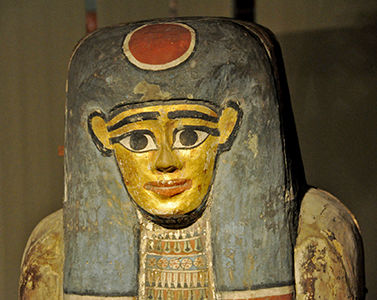
Ptolemaic Dynasty: 305 BC - 30 BC
Diptah
Coffin of Diptah, close up.
Photo: © Michiel 2005, http://www.ipernity.com/doc/288839/18779683
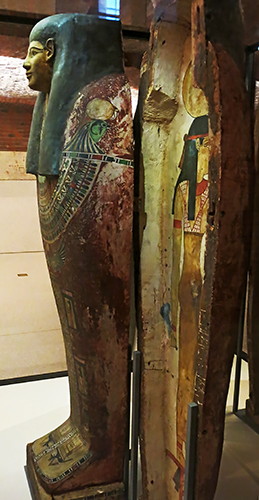


Ptolemaic Dynasty: 305 BC - 30 BC
Woman called Hat (or Het)
Lid and case of the anthropomorphic coffin of the woman called Hat.
Dimensions: 1770 x 550 x 450 mm.
As early as the beginning of the 18th century travellers described the Achmimer necropolitan area. From the extensive necropolis in Achmim there were many valuable finds. This includes this anthropomorphic coffin of Hat from the Ptolemaic Period, which is in a very good state of preservation.
The Berlin Museum took delivery in 1884 of the coffin of Hat, daughter of Pa-di-Chonsu-ii and his wife Udja-nabes, together with the mummy. Whether other coffins belonged to this funeral remains unclear.
Both the bulbous shape of the coffin and the voluminous neck collar, which covers almost half the lid, are typical design features of the coffins for the place of manufacture. Below the flower-neck collar with the falcon heads as endings, the winged goddess Nut kneels on a facade-like structure, followed by a broad inscription volume with genealogical indications and sacrificial formulas.
Catalog: Achmim, primed and painted wood, painted stucco, ÄM 8501
Photo: Don Hitchcock 2015, 2018
Source: Original, Staatliche Museen zu Berlin, Neues Museum, Germany
Text: © Card at the Staatliche Museen zu Berlin, http://www.smb-digital.de/ (CC BY-NC-SA 3.0 DE)
Additional text: I. Liao for: Helmbold-Doyé, J. / Jancziak, J. (Eds.), 'Alternating Identities' An exhibition with works by Gelbbas, special editions of the Egyptian Collection 4, Berlin 2015, The results of a multidisciplinary research project, Regensburg 2009, p. 135.
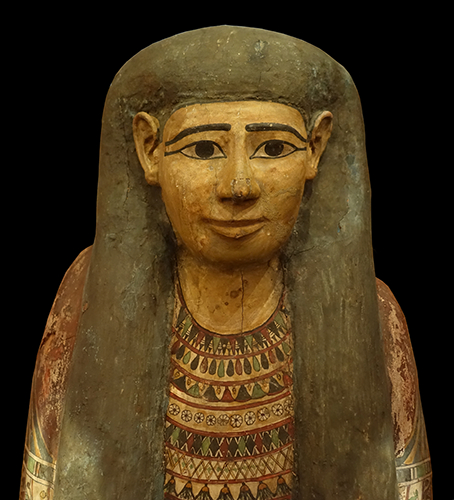
Ptolemaic Dynasty: 305 BC - 30 BC
Woman called Hat (or Het)
Closeup of the head on the lid of the coffin of the woman called Hat
( note that on all images of both the coffin case and lid, from multiple sources, the right shoulder of the woman is higher than the left - Don )
Catalog: Achmim, primed and painted wood, painted stucco, ÄM 8501
Photo: Don Hitchcock 2018
Source: Original, Staatliche Museen zu Berlin, Neues Museum, Germany
Text: © Card at the Staatliche Museen zu Berlin, http://www.smb-digital.de/ (CC BY-NC-SA 3.0 DE)

Ptolemaic Dynasty: 305 BC - 30 BC
Woman called Hat (or Het)
Case of the anthropomorphic coffin of the woman called Hat.
Catalog: Achmim, primed and painted wood, painted stucco, ÄM 8501
Photo: Stitched from two or more photos, Don Hitchcock 2018
Size: 34 Megapixels
Source: Original, Staatliche Museen zu Berlin, Neues Museum, Germany
Text: © Card at the Staatliche Museen zu Berlin
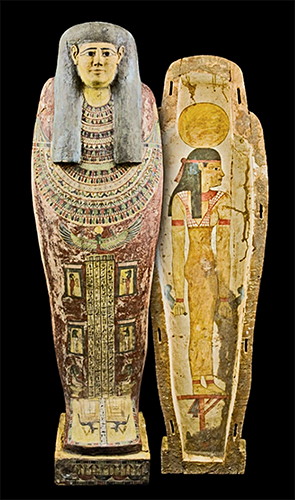
Ptolemaic Dynasty: 305 BC - 30 BC
Woman called Hat
Lid and case of the anthropomorphic coffin of the woman called Hat.
Following Ptolemaic theology, deceased women have two forms of existence on the other side of death. Therefore Hat is referred to in the inscriptions as both 'Osiris Hat' and 'Hathor Hat'. At the side, two Horus dynasties in the shrines, as well as the mourning goddesses Isis and Nephthys, decorate the coffin lid. The Anubis jackals lying on the closed shrines form the end of the decorations.
On the underside of the box-shaped pedestal decorated with protection symbols for life and well-being on the sides, the running Apis bull is shown in a 'ring' symbol for eternity. On the back of Apis the mummy of the deceased is placed; the Ba-bird flies over it and holds a ring between its claws. Since the Saitian period, the bull running to the grave, often carrying the mummy of the dead on its back, was called 'Osiris, the living Apis' and also a symbol of protection. Frequently, he was painted on the base of coffins or cartonnage. In addition, the heavenly goddess groove is shown again in the coffin case. She stands on a stand and holds Maat feathers in her hands.
Catalog: Achmim, primed and painted wood, painted stucco, ÄM 8501
Photo: © Sandra Steiß, Egyptian Museum and Papyrus Collection of the Staatliche Museen zu Berlin - Prussian Cultural Heritage, (CC BY-NC-SA 3.0 DE)
Source: Original, Staatliche Museen zu Berlin, Neues Museum, Germany
Text: © Card at the Staatliche Museen zu Berlin, http://www.smb-digital.de/ (CC BY-NC-SA 3.0 DE)
Additional text: I. Liao for: Helmbold-Doyé, J. / Jancziak, J. (Eds.), 'Alternating Identities' An exhibition with works by Gelbbas, special editions of the Egyptian Collection 4, Berlin 2015, The results of a multidisciplinary research project, Regensburg 2009, p. 135.
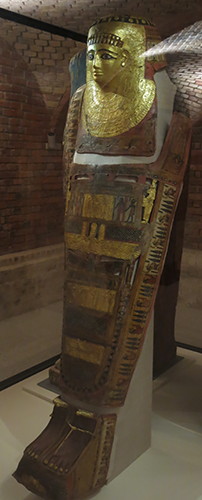
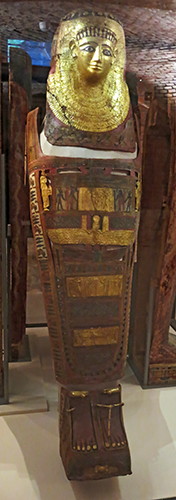
Ptolemaic Dynasty: 305 BC - 30 BC
Hor
Tripartite mummy cover of Hor.
Catalog: Hawara, cartonnage, stucco, painted and gilded. ÄM 13463
Photo: Don Hitchcock 2015
Source: Original, Staatliche Museen zu Berlin, Neues Museum, Germany
Text: © Card at the Staatliche Museen zu Berlin, http://www.smb-digital.de/ (CC BY-NC-SA 3.0 DE)
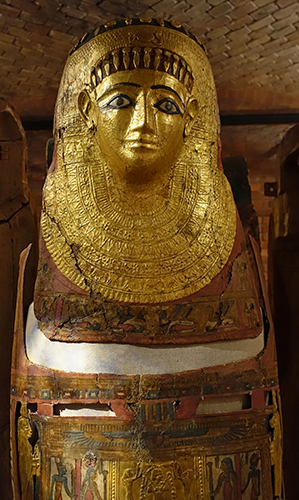
Ptolemaic Dynasty: 305 BC - 30 BC
Hor
Closeup of the gilded head of the tripartite mummy cover of Hor.
Catalog: Hawara, cartonnage, stucco, painted and gilded. ÄM 13463
Photo: Don Hitchcock 2018
Source: Original, Staatliche Museen zu Berlin, Neues Museum, Germany
Text: © Card at the Staatliche Museen zu Berlin, http://www.smb-digital.de/ (CC BY-NC-SA 3.0 DE)
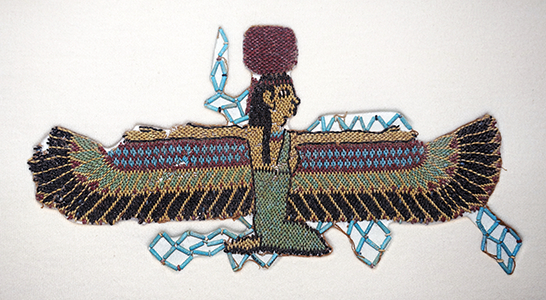
Ptolemaic Dynasty: 305 BC - 30 BC (?)
Winged Goddess
Figure of a winged goddess in mosaic beadwork, from a bead net.
Fragment of a bead-net comprising red, yellow, green, light- and dark-blue glazed composition short cylinder beads, strung together to represent a figure of Isis, crowned with solar disc, kneeling with outstretched wings, with fragments of a net, consisting of light-blue glazed composition cylinder beads strung diagonally, remaining at edges.
Catalog: Provenance unknown, Ptolemaic?, EA66616
Photo: Don Hitchcock 2018
Source: Original, British Museum
Text: Card with the display at the British Museum, https://www.britishmuseum.org/, © Trustees of the British Museum, CC BY-NC-SA 4.0
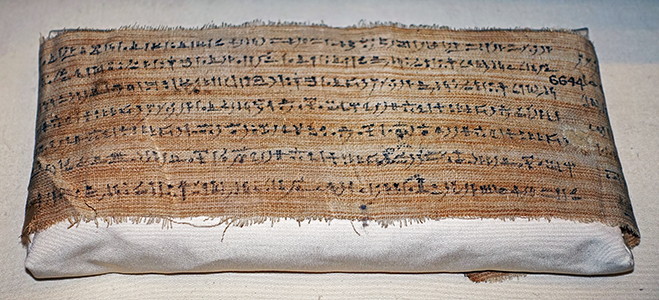
Ptolemaic Dynasty: 305 BC - 30 BC
Book of the Dead
Mummy linen inscribed with portions of the Book of the Dead.
Late Period, 4th century BC or later.
Beginning in the 4th century BC, funerary texts from the Book of the Dead were inscribed in hieratic directly on the wrappings of the mummy. Here, the deceased is named as Djedher, son of Sekhmetnefret.
The textile fragment is a torn strip of undyed, fine weave linen mummy-wrapping bearing Hieroglyphic text, stained with bitumen. The weave is plain [warp-faced simple tabby] and the threads are S-spliced and S-twisted; the stitch gauge is warp c.43 ends per 10mm and weft c.19 picks per 10mm.
Dimensions: length 405 mm, width 73 mm.
Catalog: Ptolemaic (?), Tomb of Bakenrenef, Saqqara, EA6644
( note that the MetMuseum gives the date of the Tomb of Bakenrenef as 664 BC - 610 BC - Don )
Photo: Don Hitchcock 2018
Source: Original, British Museum
Text: Card with the display at the British Museum, https://www.britishmuseum.org/, © Trustees of the British Museum, CC BY-NC-SA 4.0
Additional text: https://www.metmuseum.org/art/collection/search/549495
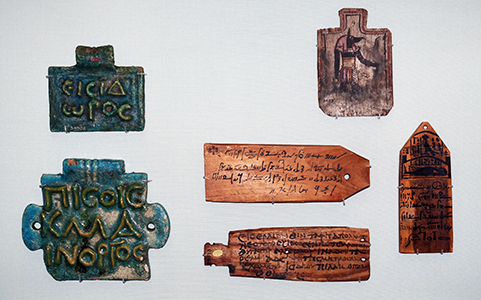
Ptolemaic Dynasty: 305 BC - 30 BC
Mummy Labels
Mummies of the Ptolemaic and Roman periods were often identified by labels attached to the wrapped bodies. Usually made of wood, but occasionally of faience, these are inscribed in Greek or Egyptian demotic (often both) with personal details including names, age at death, family relationships, occupation and abode. They served to identify the bodies in the embalmer's workshop, awaiting transport to the necropolis. The names are often indicative of ethnic background and social status.
(top right) Painted wooden label, decorated on one side with figure of Anubis.
Roman Period, after 30 BC.
Dimensions: Height 104 mm, width 70 mm.
Catalog: Provenance unknown, EA8487
(left) Two faience mummy labels with Greek inscriptions.
Roman Period, after 30 BC.
Provenance unknown.
These were made to be attached to the mummies of the persons named Pisois and Isidorus. The use of faience is unusual.
(upper left)
Mummy-label, made of green glazed composition, rectangular, with large suspension loop, Greek inscription of Isidorus, raised, in two lines.
Dimensions: Height 81 mm, width 90 mm.
Catalog: Provenance unknown, EA34908
(Lower left) Green glazed composition mummy-label of Pisois, with Greek inscription.
Dimensions: Height 115 mm, width 140 mm.
Inscription position: Three lines, raised, Greek, one side.
Catalog: Provenance unknown, EA34907
(middle top) Pinewood label inscribed on one side in demotic and Greek for Tasherithorsiese, daughter of Pa-akhem-hor and Tasheritpashy.
Roman Period, 2nd century AD
Dimensions: Height: 54 mm, length 156 mm.
Painted. 3 lines of Greek on one side, 4 lines of Demotic on the other.
Catalog: Akhmim, EA23207
(middle lower) Trapezoidal pinewood label inscribed in Greek with arrangements for transport of a mummy.
Roman Period, 1st - 3rd century AD, from Thebes.
The text, of five lines, states that the mummy, that of a man named Apollos, is to be delivered to his aunt, Taremphis, a priestess of Isis of Philae who was resident at Hermonthis (Armant) in Upper Egypt
Dimensions: Height 51 mm, length 157 mm.
Catalog: Thebes, EA29513
(right) Pinewood label inscribed on one side in hieroglyphic and demotic for a priest of Amun at Karnak, called Nespameter.
Ptolemaic Period, 1st century BC.
Probably from Thebes.
Mummy-label of Espmetis, son of Imuthes
Height: 125 mm, width 50 mm.
Painted in hieroglyphic in seven lines on one side, painted in Demotic on the other side in six lines.
Catalog: Theban type, EA14438
Photo: Don Hitchcock 2018
Source: Original, British Museum
Text: Card with the display at the British Museum, https://www.britishmuseum.org/, © Trustees of the British Museum, CC BY-NC-SA 4.0
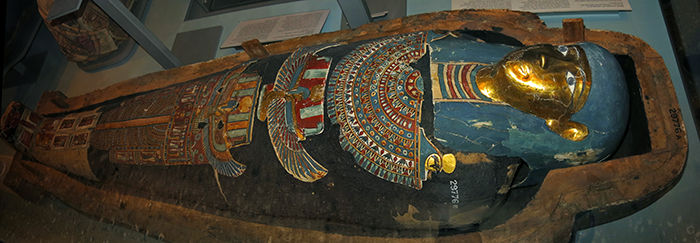
Ptolemaic Dynasty: 305 BC - 30 BC
Djedhor
Painted wooden coffin and mummy of Djedhor
Ptolemaic Period, about 250 BC, from Akhmim. The outer wrappings of this mummy have been carefully coated with a black substance, which has been identified chemically as asphalt from the Dead Sea. This supports statements of classical historians such as Diodorus Siculus and Strabo (1st Century AD) that Dead Sea asphalt was exported to Egypt for use in mummification.

Over this black coating have been placed a gilded mask and a group of painted cartonnage plaques, representing the goddess Nut with outstretched wings, the Sons of Horus, Isis and Nephthys and other deities. Since most of these figures are duplicated, it is possible that some of them were originally made for another mummy. CAT scans of the mummy show that the skeleton, that of an adult man, is in good condition.

The arms are crossed on the breast. Damage to the nasal area is visible, indicating that the brain was removed via this orifice. Solidified fluid, probably resin, lies in the back of the skull, and artificial eyes are visible in the orbits. The chest and abdominal cavities appear empty, but an object - perhaps a rolled papyrus - lies between the legs.
Catalog: EA29776
Photo: Don Hitchcock 2015
Source: Original, British Museum
Text: Card in museum, © Trustees of the British Museum

Ptolemaic Dynasty: 305 BC - 30 BC
Djedhor
View of the painted wooden coffin and mummy of Djedhor from above.
This image allows us to see clearly the duplicated figures of the goddess Nut and other deities, possibly originally made for another mummy.
Catalog: EA29776
Photo: © Trustees of the British Museum
Source: Original, British Museum
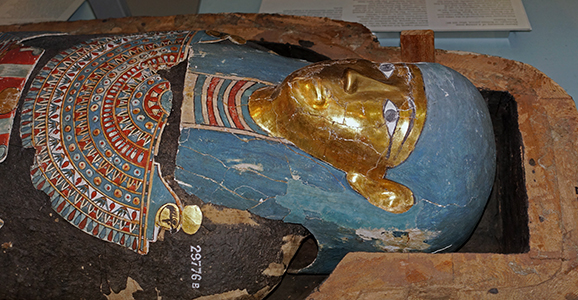
Ptolemaic Dynasty: 305 BC - 30 BC
Djedhor
Close up of the head region of the exhibit.
Catalog: EA29776
Photo: Don Hitchcock 2018
Source: Original, British Museum
Text: Card in museum, © Trustees of the British Museum
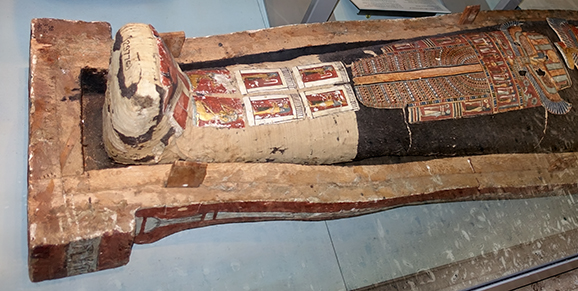
Ptolemaic Dynasty: 305 BC - 30 BC
Djedhor
This gives a close up view of the figures over the legs, including the four sons of Horus, Imsety, Duamutef, Hapi, and Qebehsenuef.
Catalog: EA29776
Photo: Don Hitchcock 2018
Source: Original, British Museum
Text: Card in museum, © Trustees of the British Museum
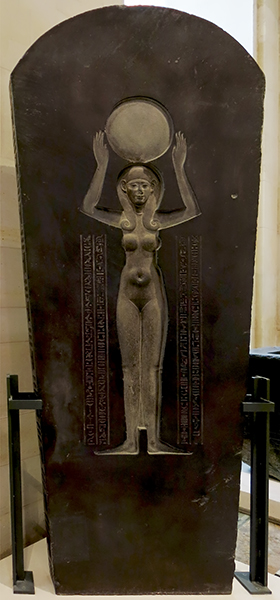
Ptolemaic Dynasty: 305 BC - 30 BC
Djedhor
Outer sarcophagus of the dignitary Djedhor. Djedhor was a royal scribe as well as a priest of Min and Hathor.
Note that this is not the still-undiscovered sarcophagus of Pharaoh Djedhor (better known as Teos/Tachos) of the 30th Dynasty.
( this is the lid of the sarcophagus - Don )
Length 2850 mm, width 1210 mm.
Catalog: Diorite, Saqqara (Memphite region, Memphite necropolis), Aile Sully, Room 321, the Sarcophagi, Vitrine 1, N 345, D 9
Photo: Don Hitchcock 2015
Source and text: Original, Louvre Museum, Paris, France, https://collections.louvre.fr/
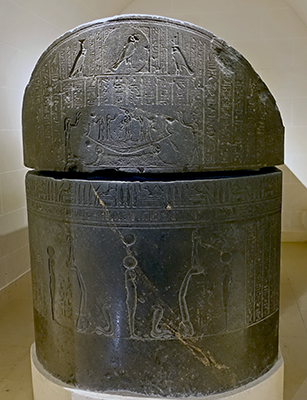
Ptolemaic Dynasty: 305 BC - 30 BC
Djedhor
Sarcophagus of the priest Djedhor.
Note that this is not the still-undiscovered sarcophagus of Pharaoh Djedhor (better known as Teos/Tachos) of the 30th Dynasty.
Decoration: Journey of the sun.
Height 1670 mm, length 2820 mm, width 1380 mm, weight 4 500 kg.
Catalog: Granodiorite, Saqqara (Memphite region, Memphite necropolis), N 344, D 8, CC 41
Location: Aile Sully, Salle 323 - Crypte d'Osiris, not in a vitrine.
Photo: Don Hitchcock 2018
Source and text: Original, Louvre Museum, Paris, France, https://collections.louvre.fr/
Ptolemaic Dynasty: 305 BC - 30 BC
Head of a bearded man
First century BC.
Catalog: Granite, ÄM 10660
Photo: Don Hitchcock 2018
Source: Original, Staatliche Museen zu Berlin, Neues Museum, Germany
Text: © Card at the Staatliche Museen zu Berlin, (CC BY-NC-SA 3.0 DE)

Ptolemaic Dynasty: 305 BC - 30 BC
Djedhor
Bronze hypocephalus of Djedhor.
From Abydos, cemetery G, tomb of Djedhor.
Note the four-headed Ram of Mendes adored by baboons, as well as the barques. Diameter 20 cm.
These inscribed discs, usually of plastered linen and less frequently of papyrus or bronze, were placed beneath the heads of mummies during the Late Period and the Ptolemaic era. The texts written on them are taken from spell 162 of the Book of the Dead, and were intended to provide life-giving heat to ensure the resurrection of the dead. Images of deities connected with the notions of creative power and renewed life supplemented the potency of the texts.
Catalog: EA37330
Photo: Don Hitchcock 2015
Source: Original, British Museum
Text: Card in museum, http://www.britishmuseum.org/ , © Trustees of the British Museum
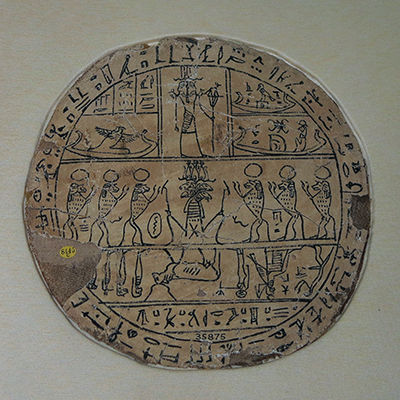
Ptolemaic Dynasty: 305 BC - 30 BC
Hypocephalus
Stuccoed linen hypocephalus decorated with four painted registers of universal deities surrounded by a border of Hieroglyphs.
Ptolemaic period, 305 BC - 30 BC, probably from Thebes / Luxor. Diameter 212 mm.
( note that this hypocephalus is almost identical to the one of Neshorpakhered shown below. It has almost exactly the same design elements, and clearly came from the same tradition and time period, and possibly even from the same workshop, although it is of inferior artistic quality - Don )
Catalog: EA35875
Photo: Don Hitchcock 2015
Source: Original, British Museum
Text: Card in museum, http://www.britishmuseum.org/, © Trustees of the British Museum
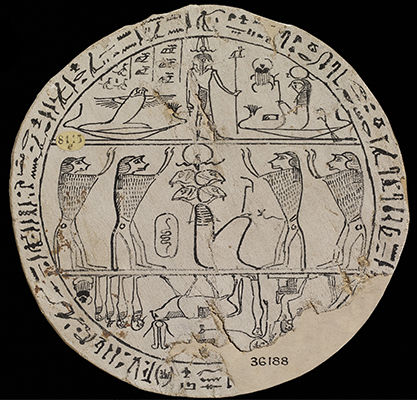
Ptolemaic Dynasty: 305 BC - 30 BC
Neshorpakhered
Hypocephalus of Neshorpakhered, 140 mm diameter.
Ptolemaic (?) Late Period (?), Thebes / Luxor, plaster/linen, Fourth to Third century BC.
At the top is a two-headed deity in human form who holds a sceptre in which is the image of the jacekal-headed god Wepwawet. Two gods appear in boats: on the left is a falcon with outspread wings, and on the right is a mummiform falcon-headed figure clearly recognisable as the sun god wearing the solar disc as his headdress. The scarab beetle, another manifestation of the sun, is depicted in front of him.
In the next register the god Amun Ra is depicted as a mummiform deity with four ram-heads, adored by pairs of baboons. Rotating the disc 180 degrees, one faces another scene, in which a cow is the principal figure, facing the Four Sons of Horus and a scarab beetle. The cow, at least, can be clearly related to spell 162 of 'The Book of the Dead', which is put in the mouth of an 'ihet' cow, there described as the mother of Ra. Behind the cow is a female figure whose head is the 'wedjat' eye within a disc, and a seated figure with upraised arm who faces a serpent with human legs. This part of the object is partly damaged.
Catalog: EA36188
Photo: Google Arts and Culture Project, https://www.google.com/, © Trustees of the British Museum
Source: Original, British Museum
Text: http://www.britishmuseum.org/, © Trustees of the British Museum
Ptolemaic Dynasty: 305 BC - 30 BC
Neswy Stela
A gilded wooden statuette represents the ba of Neswy perching at the top of the stela. The painted scenes show, from top to bottom: the winged sun disc flanked by the goddesses Nekhbet and Wadjet as serpents, and by jackals representing Anubis, the deceased adoring the sun god and other deities in the solar barque; and the deceased before Osiris, Isis, Nephthys, Horus, Hathor, Anubis, and Wepwawet.
From the online catalog:
Sycomore fig wood funerary stela of Neswy: this round-topped stela is divided into four separate sections. At the top under a curved sky-sign appears a winged sun-disk with winged uraei enclosing a scarab beetle. On each side is a recumbent jackal holding a sceptre. In the second register Neswy kneels on the right in adoration of the solar barque. A 'ba'-bird on the prow of the bark worships Ra, Atum, Khepri, Shu, Tefnut, and Geb who are seated and behind whom stands the helmsman.
In the third register the deceased on the right stands in worship before an altar on which rests an offering cooled by a lotus-flower. Behind stand Osiris, Isis, Nephthys, Hornedjitef, Hathor, Anubis, and Wepwawet. The fourth register consists of five lines with a prayer to Ra-Horakhty and Khepri and names the deceased, Neswy, born of the lady Tʒ-kwr-hb. The stela rests on two stepped pedestals and there is a 'ba'-bird on its top. The stela is cracked down one side where a separate plank which helped to form this stela had broken away and been rejoined in modern times. The surface is cracked in several places and the colours are faded.
The background of the stela is grey-white. The sky at the top is blue. The disk is red with a white rim. The tripartite wings are blue, yellow with black details, and green with black details, with yellow patches and a red upper and lower rim, and white between the divisions. The uraei have blue upper bodies, red and blue-striped wings, and blue-striped bodies on grey-white with red and blue-feathered green crowns respectively. They enclose on one side a blue beetle below which is blue and red decoration and on the other side blue šn-signs with red centres. The jackals are black with red sashes, blue flags, and blue and red sceptres. The texts are black between blue lines where indicated. There is a border consisting of blue, red, blue, green rectangles separated by one black and two white lines and edged on both sides by white borders between the first and second register. The deceased has a red body, black features, blue wig with green top, and blue-striped grey-white garment apart from the area under his arm which is striped black. The barque is blue at both ends and green in the middle with red and grey-white stripes between these divisions and red disks and lotus-centres at the top of the prow and stern.
The 'ba'-bird has a red body and legs, blue back and wig, and green underbody and cone. His fan is blue with red diagonal lines on grey-white and his flag red and his feather blue. The seated gods have red bodies, blue-striped collars, blue wigs, and blue-black ankh-signs. Ra has a grey-white face with black details, a blue sceptre, and a red disk with black horns. Atum has a blue face and a red and grey-white crown. The next four deities have green faces. Khepri and Shu have blue head-dresses; Tefnut's is red, while that of Geb is red and blue. The deities rest on a platform made up of blue, grey-white, and red rectangles. The helmsman has a red body, blue collar and wig, and green and grey-white kilt. The boat rests on blue water. The texts here and in the following register are black with blue dividing lines.
In the third register the deceased has a red body, blue wig and eyebrow, green cone, blue-green collar and underarm garment, and white garment with black details and a blue belt. The altar is blue with a red pot and blue lotus, Osiris has a red body with blue sceptres and streamers, green face, blue collar, and grey-white crown with blue feathers, black horns, and a red centre dot. The two goddesses have green bodies, red dresses, blue wigs, and blue and red head-dresses and carry blue-black 'ankhs'. Hornedjitef has a red body, grey-white face with black details, blue wig, blue striped and green kilt, and grey-white and red crown and carries a blue-black sceptre and black ankh. Hathor is similar to the other goddesses apart from her red disk with black horns, blue-black sceptre, and black 'ankh'.
The dividing lines between the names of Isis and Nephthys and the extreme right border are red rather than the normal blue. The border between the third and fourth register is composed of blue, white, and green squares, the white having a black dot in the centre. The text in the fourth register is black on alternate grey-white and yellow backgrounds between blue dividing lines. The sides and back are plastered white apart from the bottom edge. There is a red stripe in the centre of the sides. The pedestals are white with blue and red steps. The 'ba'-bird has a gold face, blue wig, and upper body with a grey-white red-feathered centre stripe. The underbody is grey-white with black, blue, and red details. The feet are red and rest on a base which has a grey-white upper surface and blue sides.
There is a prayer to Ra-Horakhty and Khepri painted in five rows of hieroglyphic text.
Height 535 mm, width 455 mm.
Catalog: Sycomore fig wood, painted, plastered, gilded, Thebes, EA8468
Photo: Don Hitchcock 2018
Source: Original, British Museum
Text: Card in museum, http://www.britishmuseum.org/, © Trustees of the British Museum
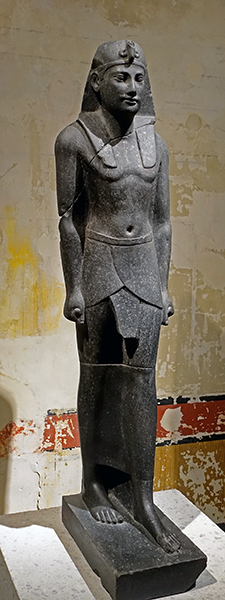
Ptolemaic Dynasty: 305 BC - 30 BC
Ptolemy III
Standing figure of Pharaoh Ptolemy III (Ptolemaios III), misplaced lower part.
Ptolemy III Euergetes ('the benefactor') was a king of the Ptolemaic Empire, and ruled from 246 to 221 BC.
Catalog: Basalt, ÄM 14764
Photo: Don Hitchcock 2018
Source: Original, Staatliche Museen zu Berlin, Neues Museum, Germany
Text: © Card at the Staatliche Museen zu Berlin
Additional text: Wikipedia
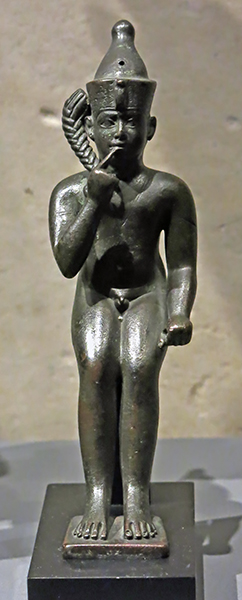
Ptolemaic Dynasty: 305 BC - 30 BC
Harpocrates
A youthful Harpocrates, god of silence, in bronze.
Catalog: Bronze, 3rd Century BC, ÄS 5312
Photo: Don Hitchcock 2018
Source: Original, Ägyptischen Museum München
Text: Museum card, © Ägyptischen Museum München
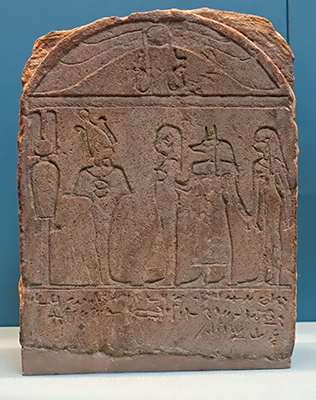
Ptolemaic Dynasty: 305 BC - 30 BC
Stela
Sandstone stela showing the deceased presented to Osiris by Anubis.
Round-topped sandstone stela divided into three registers:
1 - Winged sun-disc with pendent uraei.
2 - Scene of Anubis with a mummy and female figure before Osiris, standard of Osiris behind.
3 - Three lines of Demotic text.
Height 270 mm, width 210 mm, thickness 90 mm.
Catalog: Sandstone, EA837
Photo: Don Hitchcock 2018
Source and text: Original, card at the British Museum, http://www.britishmuseum.org/, © Trustees of the British Museum, CC BY-NC-SA 4.0
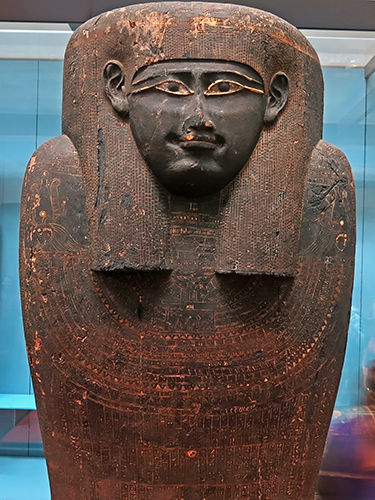
Ptolemaic Dynasty: 305 BC - 30 BC
Hornedjitef
The lid of the outer wooden coffin of Hornedjitef, son of Nekhthorheb, who held a large number of priestly offices.
Reign of Ptolomy III, 246 BC - 222 BC. From Asasif, Thebes / Luxor.
Catalog: EA6677
Photo: Don Hitchcock 2015
Source: Original, British Museum
Text: http://www.britishmuseum.org/ © Trustees of the British Museum
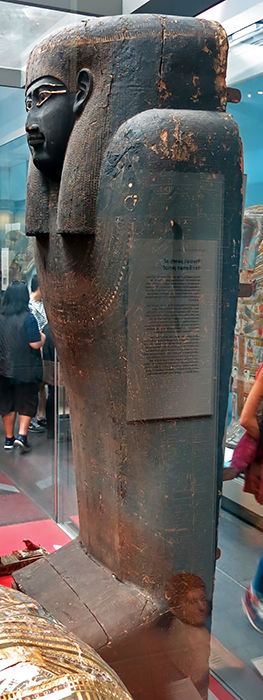
Ptolemaic Dynasty: 305 BC - 30 BC
Hornedjitef
Side view of the lid of the outer wooden coffin of Hornedjitef.
Catalog: EA6677
Photo: Don Hitchcock 2015
Source: Original, British Museum
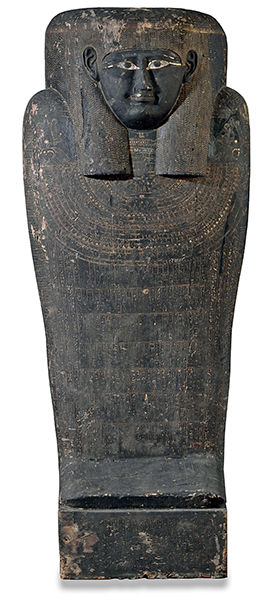
Ptolemaic Dynasty: 305 BC - 30 BC
Hornedjitef
The lid of the outer wooden coffin of Hornedjitef.
Base and lid of the anthropoid outer coffin of Hornedjitef, son of Nekhthorheb, who held a large number of priestly offices, made of sycomore fig wood, stained black, eyes gilded, lid is inscribed with texts from the Book of the Dead with a representation, in central panel, of Isis and Nephthys shown mourning over the deceased, interior of the base is decorated with a standing figure of Nut.
Catalog: EA6677
Photo: Google Arts and Culture Project, © Trustees of the British Museum
Source: Original, British Museum
Text: http://www.britishmuseum.org/ © Trustees of the British Museum
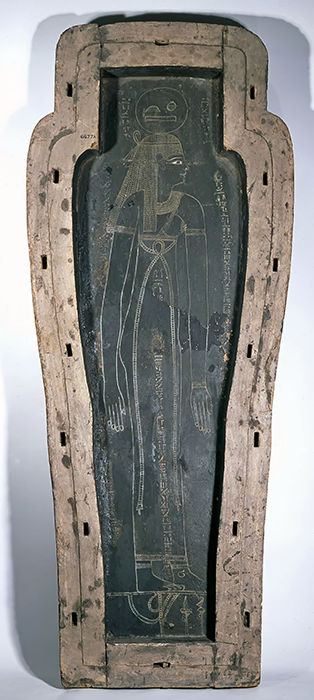

Ptolemaic Dynasty: 305 BC - 30 BC
Hornedjitef
A large figure of the goddess Nut is painted on the floor of the outer wooden coffin of Hornedjitef.
Catalog: EA6677
Photo (left): © Trustees of the British Museum
Photo (right): Don Hitchcock 2015
Source: Original, British Museum
Text: Card in museum, © Trustees of the British Museum
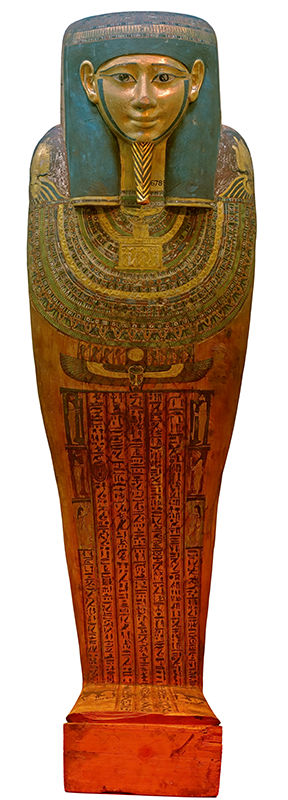
Ptolemaic Dynasty: 305 BC - 30 BC
Hornedjitef
Base and lid of the anthropoid wooden inner coffin of Hornedjitef, son of Nekhthorheb, who held a large number of priestly offices.
Reign of Ptolomy III, 246 BC - 222 BC. From Asasif, Thebes / Luxor.
Polychrome painted and gilded face, wig, collar and pectoral, winged scarab across breast, body inscribed with vertical registers of painted hieroglyphs, flanked by deities.
The rest of the surface is unelaborated, the interior of the base is also decorated.
Length 1945 mm, width 600 mm.
Registration Number 6678
Photo: Don Hitchcock 2015
Source: Original, British Museum
Text: Card in museum, http://www.britishmuseum.org/, © Trustees of the British Museum
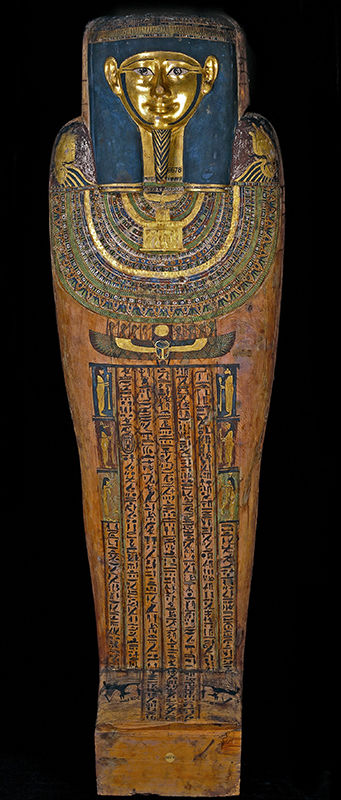
Ptolemaic Dynasty: 305 BC - 30 BC
Hornedjitef
Mummy of Hornedjitef (inner coffin).
Reign of Ptolomy III, 246 BC - 222 BC. From Asasif, Thebes / Luxor.
This, the inner coffin, has a fine gilded face, with curled and tapering beard and a richly decorated collar with terminals in the form of falcon heads. In the centre of this collar is depicted an image of the ba, and a pectoral (chest) ornament incorporating a scene in which Hornedjitef adores four deities.
Below the collar is an image of the sun-god as a winged scarab beetle, flanked by baboons who worship the rising sun disc. A funerary text is inscribed in hieroglyphs below. Either side of the text are figures of deities: the four Sons of Horus and the goddesses Isis and Nephthys.
The interior of the lid is decorated with many figures, mostly relating to astronomy. Their position on the lid of the coffin is particularly appropriate, as the lid was symbolically identified with the heavens stretched above the deceased.
The central, full-face figure is that of the sky-goddess Nut, on whose body is written the text of chapter 89 of the Book of the Dead. To her left is a list of planets and decans (stars that rose every 10 days, by which the passage of time could be reckoned during the night). To the right of the goddess are the constellations of the northern hemisphere.
Photo: © Trustees of the British Museum
Source: Google Arts and Culture Project
Text: Card in museum, © Trustees of the British Museum, © https://www.google.com/culturalinstitute/beta/asset/mummy-of-hornedjitef-inner-coffin/vgHJIobGkBxTQg
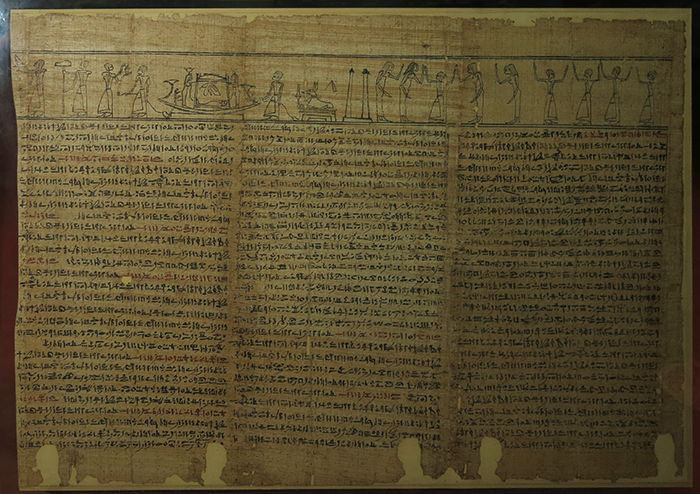
Ptolemaic Dynasty: 305 BC - 30 BC
Hornedjitef
Section of the Book of the Dead papyrus of Hornedjitef, sheet 1, length 630 mm, height 438 mm.
Reign of Ptolemy III, 246 BC - 222 BC, from Asasif, Thebes / Luxor.
This hieratic papyrus, containing a selection from chapters 1 - 42 of the Book of the Dead, was found lying on the lid of the inner coffin. Another papyrus belonging to the same man, and now in the Pierpont Morgan Library, New York, contains a further selection, from chapters 110 - 161.
Catalog: EA10037/1
Photo: Don Hitchcock 2015
Source: Original, British Museum
Text: Card at museum display, http://www.britishmuseum.org/, © Trustees of the British Museum
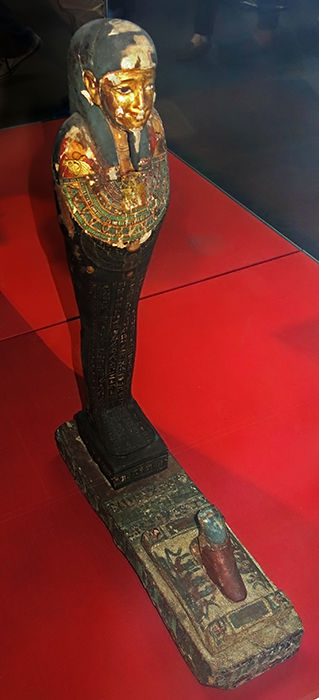
Ptolemaic Dynasty: 305 BC - 30 BC
Hornedjitef
Ptah-Sokar-Osiris statue of Hornedjitef.
Reign of Ptolemy III, 246 BC - 222 BC, from Asasif, Thebes / Luxor.
The statuette, of painted and gilded wood, represents the composite deity Ptah-Sokar-Osiris, whose function was to promote the resurrection of the deceased. In the long plinth is a cavity covered with a miniature sarcophagus, containing a small corn-mummy. This wrapped package of grain symbolised the regenerative power of Osiris as expressed through the germination of the corn.
Heights 575 mm and 175 mm, width 115 mm, length 402 mm
Catalog: EA9736
Photo: Don Hitchcock 2015
Source: Original, British Museum
Text: Card at museum display, http://www.britishmuseum.org/, © Trustees of the British Museum
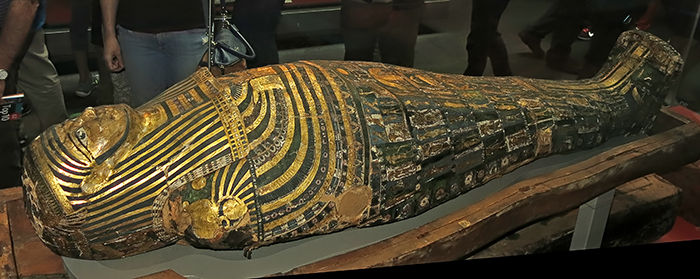
Ptolemaic Dynasty: 305 BC - 30 BC
Hornedjitef
Mummy of Hornedjitef in painted and gilded cartonnage cover and mask.
Reign of Ptolomy III, 246 BC - 222 BC. From Asasif, Thebes / Luxor.
The surface is decorated with standard Egyptian funerary images, gilded on blue, green and red grounds. The mask presents an idealised image of the dead man, with the golden skin and curled beard (lost) of a divine being.
On the base of the foot are painted sandals bearing images of bound foreign captives, to symbolise the deceased's triumph over the forces of chaos which might threaten his survival in the netherworld.
Catalog: 6679
Photo: Don Hitchcock 2015
Source: Original, British Museum
Text: Card, British Museum, © Trustees of the British Museum
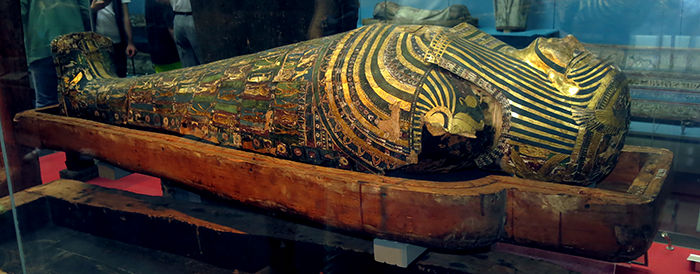
Ptolemaic Dynasty: 305 BC - 30 BC
Hornedjitef
Mummy of a man, aged 55-65, in a gilded and painted cartonnage mummy-case and separate mask, bearing the name Hornedjitef.
Skull - Almost totally obscured by the mask and wrappings.
Thorax and Abdomen - There is a profusion of small amulets at the base of the neck and upper part of the thorax. Within an otherwise almost empty body-cavity there are four large cylindrical masses of solidified linen and resin.
Catalog: EA6679
Photo: Don Hitchcock 2015
Source: Original, British Museum
Text: http://www.britishmuseum.org/, © Trustees of the British Museum
Ptolemaic Dynasty: 305 BC - 30 BC
Hornedjitef
Close up of the upper part of the coffin.
Catalog: Asasif (Thebes), EA6679
Photo: Don Hitchcock 2018
Source: Original, British Museum
Text: www.britishmuseum.org/, © Trustees of the British Museum

Ptolemaic Dynasty: 305 BC - 30 BC
Hornedjitef
There are no obvious fractures of the ribs or spinal column, but the bodies of the lumbar and dorsal vertebrae show well-marked arthritic changes, especially in the lumbar region. No obvious fractures of hips or pelvis.
Catalog: EA6679
Photo: Don Hitchcock 2015
Source: Original, British Museum
Text: http://www.britishmuseum.org/, © Trustees of the British Museum
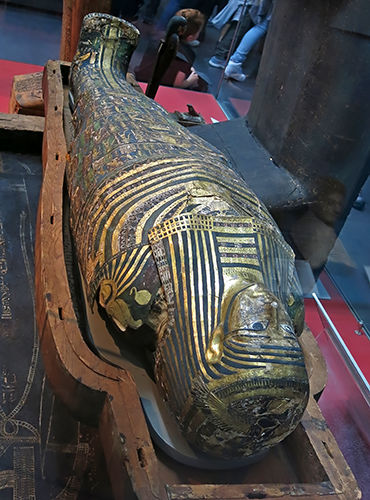
Ptolemaic Dynasty: 305 BC - 30 BC
Hornedjitef
Arms - Flexed at the elbows, the forearms crossed over the upper abdomen.
Legs - No fractures, dislocations, or lines of arrested growth. There is an opacity between the knees which may represent a linen pad. Anklets of some non-metallic material are present.
Catalog: EA6679
Photo: Don Hitchcock 2015
Source: Original, British Museum
Text: Card in museum, © Trustees of the British Museum
Ptolemaic Dynasty: 305 BC - 30 BC
Hornedjitef
The design on the floor of the coffin.
Catalog: Asasif (Thebes), EA6679
Photo: Don Hitchcock 2018
Source: Original, British Museum
Text: www.britishmuseum.org/, © Trustees of the British Museum
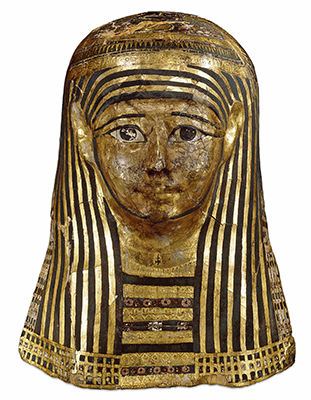
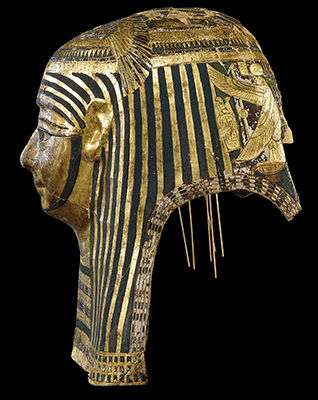
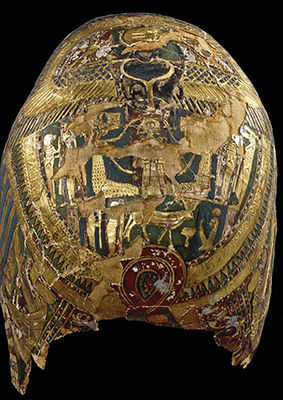
Ptolemaic Dynasty: 305 BC - 30 BC
Hornedjitef
Gilded mask of Hornedjitef, in the form of a helmet.
Catalog: EA6679
Photo: © Trustees of the British Museum
Source: Original, British Museum
Ptolemaic Dynasty: 305 BC - 30 BC
Gaugods
Two blocks from Naukratis showing Gaugods. These were gods of a particular Nome or district.
Naukratis was a city of ancient Egypt, on the Canopic branch of the Nile river, and 72 km southeast of the open sea and Alexandria.
Circa 305 BC - 282 BC.
( Note that although these blocks are both listed as being of black granite, the block on the left looks light enough in colour to be sandstone - Don )
Catalog: Black granite, Naukratis (Delta), Inv. Nr. 1970.38 and 1970.39
Photo: Don Hitchcock 2018
Source and text: Original, Museum August Kestner, Hannover
Additional text: Wikipedia

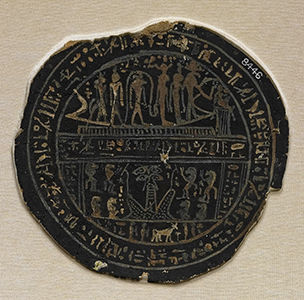
Ptolemaic Dynasty: 305 BC - 30 BC
Hornedjitef
Hypocephalus of Hornedjitef
Reign of Ptolomy III, 246 BC - 222 BC. From Asasif, Thebes / Luxor.
The hypocephalus is a disc of linen covered with plaster, painted and inscribed. Chapter 162 of the Book of the Dead, versions of which are inscribed on the hypocephali, state that its purpose was to provide the mummy with life-giving fire. It was placed inside the inner coffin, close to the mummy's head.
Catalog: EA8446
Photo (left): Don Hitchcock 2015
Photo (right): © Trustees of the British Museum
Source: Original, British Museum
Text: Card, British Museum, © Trustees of the British Museum
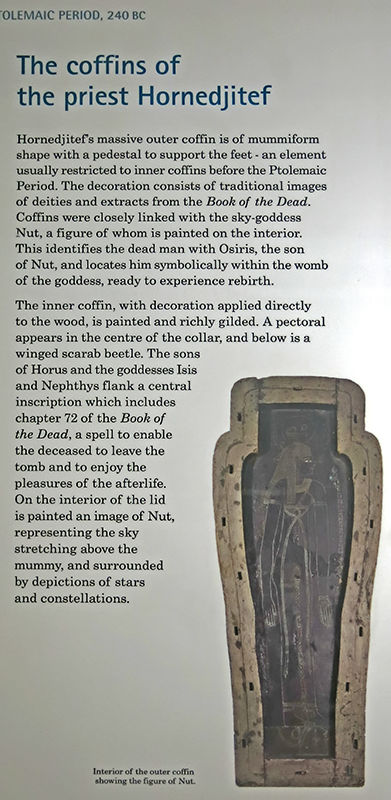
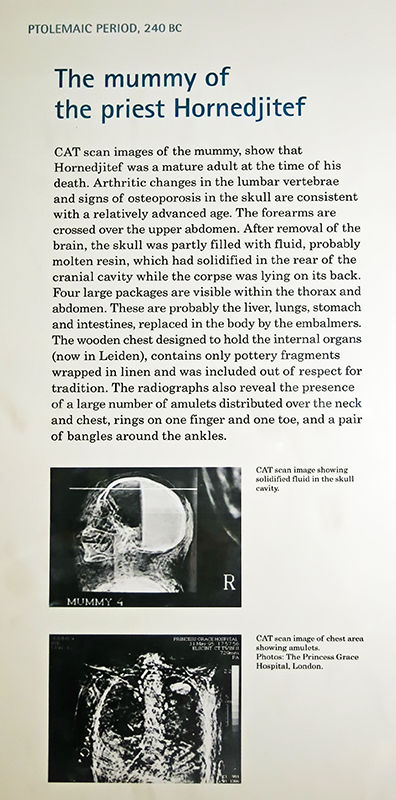
Ptolemaic Dynasty: 305 BC - 30 BC
Hornedjitef
Posters in the British Museum with information on the coffins and mummy of the priest Hornedjitef.
Photo/text: © Trustees of the British Museum
Rephotography: Don Hitchcock 2015
Source: British Museum
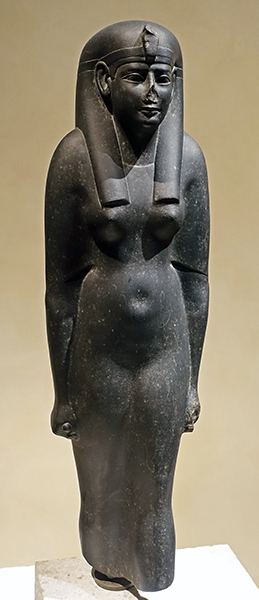
Ptolemaic Dynasty: 305 BC - 30 BC
Standing figure of a queen, early Ptolemaic, circa 300 BC.
Catalog: Greywacke, ÄM 21763
Photo: Don Hitchcock 2018
Source: Original, Staatliche Museen zu Berlin, Neues Museum, Germany
Text: © Card at the Staatliche Museen zu Berlin
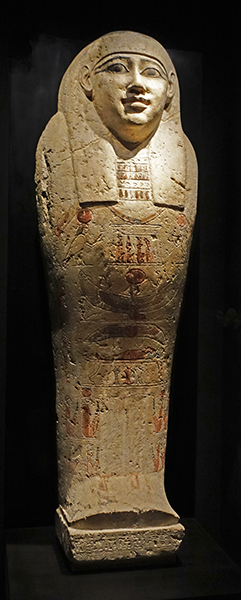
Ptolemaic Dynasty: 305 BC - 30 BC
Sarcophagus lid
Early Ptolomaic Period, 350 - 300 BC.
Limestone Gl. 34
Photo: Don Hitchcock 2018
Source: Original, Ägyptischen Museum München
Text: Museum card, © Ägyptischen Museum München
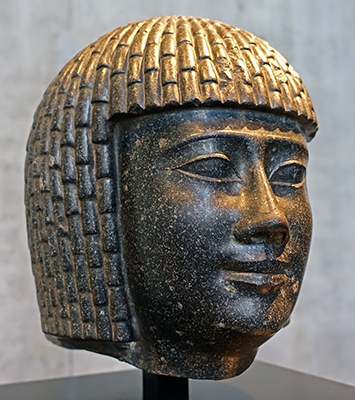
Ptolemaic Dynasty: 305 BC - 30 BC
Priest
Head from the statue of a priest, circa 330 BC.
Catalog: Diorite, Gl.WAF 26a
Photo: Don Hitchcock 2015, 2018
Source: Original, Ägyptischen Museum München
Text: © Ägyptischen Museum München
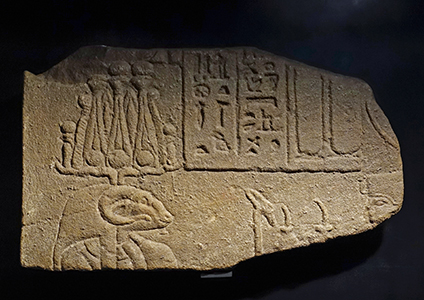
Ptolemaic Dynasty: 305 BC - 30 BC
Temple Relief
Temple relief, Pharaoh before a ram-headed god, 3rd - 2nd century BC.
Khnum, also spelled Khnemu, was an ancient Egyptian god of fertility, associated with water and with procreation. Khnum was worshipped from the 1st dynasty into the early centuries AD. He was represented as a ram with horizontal twisting horns or as a man with a ram's head.
( Here, Khnum is wearing the hemhem crown, a more elaborate version of the atef crown - Don )
Catalog: Sandstone, ÄS 7264
Photo: Don Hitchcock 2018
Source: Original, Ägyptischen Museum München
Text: © Ägyptischen Museum München
Additional text: Wikipedia

Ptolemaic Dynasty: 305 BC - 30 BC
Shrine
Naos, traces of a closing system, mortices and recesses.
Decoration: on top a frieze of uraei, winged solar disc with uraeus, below a king standing, loincloth with triangular apron, animal tail, blue crown, arms raised, bearing a sign of the sky. Frieze of prophylactic signs.
Reign of Ptolemy VIII, 145 BC - 116 BC
Height 2355 mm, width 980 mm, thickness 1200 mm, weight 7 000 kg.
Catalog: Pink granite, bas relief, Philae, Aswan region islands , N 382, D 30, Salt n° 3832
Location: Salle 324, Le temple
Photo: Don Hitchcock 2018
Source and text: Original, Louvre Museum, Paris, France, https://collections.louvre.fr/
Ptolemaic Dynasty: 305 BC - 30 BC
Reign of Ptolemy VIII, 145 BC - 116 BC
Decan
The northern tower of a recently discovered temple held a forgotten chamber likely used as a storage room. A decorated corridor led into the roughly 20 foot by 10 foot space, officials said. Near the chamber’s entrance, archaeologists found a carving of a fertility god next to a pair of very rare figures: an ibis bird and a decan, a star used as a clock at night, with a falcon head. A photo shows the carved decan figure.
The decans are 36 constellations used in the ancient Egyptian astronomy to conveniently divide the 360 degree ecliptic into 36 parts of 10 degrees each, both for theurgical elating to theurgy, (the practice of persuading a god or supernatural power to act in a certain way) and telling the time by the rising of constellations or stars purposes. The decans each appeared, geocentrically, to rise consecutively on the horizon throughout each daily Earth rotation. The rising of each decan marked the beginning of a new decanal 'hour' of the night for the ancient Egyptians, and they were used as a sidereal star clock beginning by at least the 9th or 10th Dynasty (circa 2 100 BC).
Because a new decan also appears every ten days (that is, every ten days, a new decanic star group reappears in the eastern sky at dawn right before the Sun rises. The ancient Greeks called them dekanoi or 'tenths'.
Decans gave way to a lunar division of 27 or 28 lunar stations, also known as manzil, lunar mansions or nakshatras and thence to a zodiac of 12 signs, based on an anthropomorphic pattern of constellations, and their use can be seen in the Dendera zodiac dated to circa 50 BC.
Location: Found near the ancient storage chamber of a recently discovered temple.
Photo: Marcus Müller and the Athribis Project via the University of Tübingen
Proximate source and text: Miami Herald, Aspen Pflughoeft, November 25, 2024
Additional text: Wikipedia
Ptolemaic Dynasty: 305 BC - 30 BC
Bound Papyrus Scroll
Bound papyrus scroll, worn as an amulet.
2nd century BC.
Catalog: Memphis, papyrus, ÄS 5885
Photo: Don Hitchcock 2015
Source: Original, Ägyptischen Museum München
Text: Museum card, © Ägyptischen Museum München
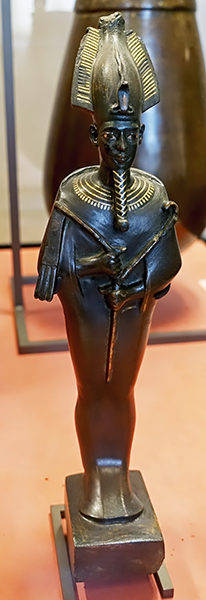
Ptolemaic Dynasty: 305 BC - 30 BC
Osiris
Bronze statue of a standing Osiris with black patina, inlaid with gold thread, the eyes are silver.
Height 280 mm.
Osiris is the god of fertility, agriculture, the afterlife, the dead, resurrection, life, and vegetation in ancient Egyptian religion. He was classically depicted as a green-skinned deity with a pharaoh's beard, partially mummy-wrapped at the legs, wearing a distinctive atef crown, and holding a symbolic crook and flail.
He was one of the first to be associated with the mummy wrap. When his brother, Set, cut him up into pieces after killing him, Isis, his wife, found all the pieces and wrapped his body up, enabling him to return to life.
Catalog: Bronze inlaid with gold, Aile Sully, Room 334, Materials and Techniques, Vitrine 2, E 3753
Photo: Don Hitchcock 2018
Source and text: Original, Louvre Museum, Paris, France, https://collections.louvre.fr/
Additional text: Wikipedia
Ptolemaic Dynasty: 305 BC - 30 BC
Ptolemy X.
Head of a statue of King Ptolemy X, Ptolemios X.
Ptolemy X Alexander I was King of Egypt from 110 BC to 109 BC and from 107 BC till his death in 88 BC, in co-regency with his mother Cleopatra III until 101 BC, and then possibly with his niece-wife Berenice III. He was a son of Ptolemy VIII Physcon and Cleopatra III.
Ptolemy X was exiled around 88 BC when his citizens and army turned against him. He fled to Syria, and upon his return with a new army became infamous for melting down and looting the golden sarcophagus of Alexander the Great, in order to pay the mercenaries who had put him back on the throne, and replaced the former sarcophagus with one made of glass. The citizens of Alexandria were so outraged at this act that they exiled him again almost immediately and attempted to wipe out all record of him. He would later be killed on his way to Cyprus.
Catalog: Pink granite, ÄM 14079
Photo: Don Hitchcock 2018
Source: Original, Staatliche Museen zu Berlin, Neues Museum, Germany
Text: © Card at the Staatliche Museen zu Berlin
Additional text: Wikipedia
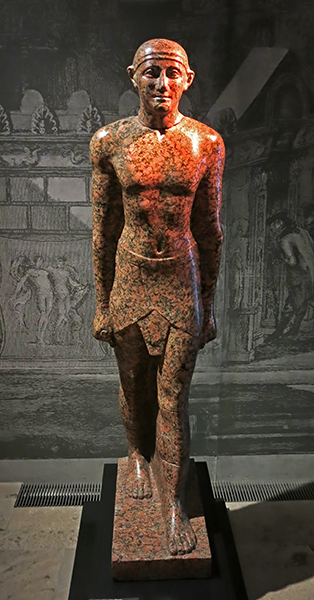
Ptolemaic Dynasty: 305 BC - 30 BC
Statue of a man
Standing - striding figure of a man.
Late Ptolemaic Period, circa 1st Century BC.
( This is a superb piece of art by a master craftsperson - Don )
Catalog: Pink granite, Villa Hadriana (Tivoli), Gl.WAF 27
Photo: Don Hitchcock 2015
Source: Original, Ägyptischen Museum München
Text: Museum card, © Ägyptischen Museum München
Ptolemaic Dynasty: 305 BC - 30 BC
Two Goddesses
Limestone wall-relief block, with heads and torsos of two goddesses facing left in low relief, background left rough, as for UC14518.
Width 340 mm, height 210 mm, Accession Number LDUCE-UC14519.
Photo: Don Hitchcock 2018
Source: Original, Petrie Museum, London, England
Text: Card / online catalogue, the Petrie Museum, © 2015 UCL. CC BY-NC-SA license.
Ptolemaic Dynasty: 305 BC - 30 BC
Hor-sa-tutu
Standing figure of Hor-sa-tutu (Horos, son of Thotoes), commander in chief in Lower Egypt.
Dimensions: 1150 x 670 x 330 mm
This statue of Horsatutu is undoubtedly one of the finest works of the late Ptolemaic era, and was commissioned by private individuals. Horsatutu has a lower and upper shirt, which can be seen mainly from the round and pointed cut-outs. On the left shoulder is a coat, which also covers a large part of the upper body. Beneath the thoracic arch was a vertical oblong incision for the attachment of an amulet - possibly a figure of the goddess Neith.
The rectangular shape of the head is dominated by sharply modelled facial creases. The hair surrounds the head like a cap and is divided into short crescent curls.
The inscription on the back pillar identifies the statue as Horos, the commander of the troops in the delta, who at the same time was priest of the goddess Neith in Sais. Originally the statue was placed in the temple of the goddess there. At a later date the hairstyle was reworked and the hair band as well as the necklace removed. These changes probably occurred at the time the sculpture was later moved during the rule of Caesar Augustus to Alexandria, the later place of discovery.
Catalog: Black Granite, Sais, ÄM 2271
Photo: Don Hitchcock 2015, 2018
Source: Original, Staatliche Museen zu Berlin, Neues Museum, Germany
Text: © Card at the Staatliche Museen zu Berlin, J. Helmbold-Doyé at http://www.smb-digital.de/ (CC BY-NC-SA 3.0 DE)
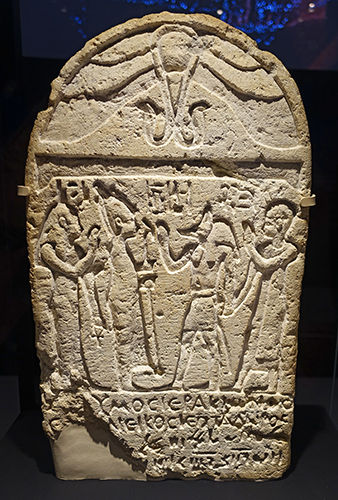
Ptolemaic Dynasty: 305 BC - 30 BC
Funerary stela
100 BC - 100 AD
Limestone
Egypt's powerful Ptolemaic Dynasty began with Ptolemy I, a Greek general under Alexander the Great. Greek became the official language of state administration but the new rulers needed to communicate with their Egyptian subjects. This funerary stela records the death of a man named Didymos, who died at the age of 27. The message is written in three different scripts: Greek, hieroglyphs, and Demotic, which was the everyday script used by literate Egyptians. As such, it was comprehensible to multiple levels of Egyptian society. After the death of Cleopatra VII in 30 BC Egypt became part of the Roman Empire.
Funerary stela of Didymos: a round-topped limestone funerary stela of 'D(id)ymos'. The stela is divided into two registers, topped by a winged sun-disk with pendant uraei or serpents. Below this is a scene of the deceased being led by Anubis before Osiris and Isis, whose names are written in hieroglyphs beside them. The hieroglyphic script is, significantly, used only in the pictorial space depicting the gods. In the bottom register are two horizontal lines of incised Greek text above two lines of incised demotic, crudely incised and virtually unintelligible.
Height 550 mm, width 325 mm, depth 90 mm, weight 20 kg.
Catalog: Abydos, EA838, 1857,0811.13
Photo: Don Hitchcock 2017
Text: Card, http://www.britishmuseum.org/, © Trustees of the British Museum
Source: Exhibition by the British Museum at the National Museum of Australia, Canberra
Ptolemaic Dynasty: 305 BC - 30 BC
Head of a man
Head from the standing-striding figure of a man, second century BC.
Catalog: Basalt, Gl.WAF 328
Photo: Don Hitchcock 2015, 2018
Source: Original, Ägyptischen Museum München
Text: Museum card, © Ägyptischen Museum München
Ptolemaic Dynasty: 305 BC - 30 BC
Head of a priest
Head from the statue of a priest, third century BC.
Catalog: Quartzite, ÄS 7166
Photo: Don Hitchcock 2018, 2015
Source: Original, Ägyptischen Museum München
Text: Museum card, © Ägyptischen Museum München

Ptolemaic Dynasty: 305 BC - 30 BC
Oudjahor
Mummiform sarcophagus, with shroud, false beard.
Clothing indicates that he was a priest and/or scribe.
Decorations include Osiris on the wig, and a Ba-bird on the chest.
Length 1950 mm, width 600 mm, thickness 570 mm.
Catalog: Limestone, Aile Sully, Room 321, the Sarcophagi, Vitrine 2, D11, CC 92, N 347
Photo: Don Hitchcock 2015
Source and text: Original, Louvre Museum, Paris, France, https://collections.louvre.fr/

Ptolemaic Dynasty: 305 BC - 30 BC
Dioskourides
Mummiform sarcophagus, with shroud, tripartite wig, plaited false beard.
General, servant of Horemheb.
Mention of Ptolomy VI Philometor, thus circa 180 BC - 145 BC
Length 2010 mm, width 680 mm, thickness 525mm.
Catalog: Greywacke, dark green, Aile Sully, Room 321, the Sarcophagi, Vitrine 2, D 40, E 83, N 353
Photo: Don Hitchcock 2015
Source and text: Original, Louvre Museum, Paris, France, https://collections.louvre.fr/

Ptolemaic Dynasty: 305 BC - 30 BC
Queen
Standing-striding figure of a queen.
Circa 2nd - 1st Century BC.
Catalog: Granite, ÄS 7153
Photo: Don Hitchcock 2015
Source: Original, Ägyptischen Museum München
Text: Museum card, © Ägyptischen Museum München
Ptolemaic Dynasty: 305 BC - 30 BC
Zodiac of Denderah
Zodiac of Denderah, ceiling relief.
March - September 50 BC, because of astronomical events shown in the zodiac.
The sky disc is centred on the north pole star, with Ursa Minor depicted as a jackal. An inner disc is composed of constellations showing the signs of the zodiac. Some of these are represented in the same Greco-Roman iconographic forms as their familiar counterparts (e.g. the Ram, Taurus, Scorpio, and Capricorn), whilst others are shown in a more Egyptian form: Aquarius is represented as the flood god Hapy, holding two vases which gush water. Rogers noted the similarities of unfamiliar iconology with the three surviving tablets of a Seleucid zodiac and both relating to kudurru ('boundary stone') representations: in short, Rogers sees the Dendera zodiac as 'a complete copy of the Mesopotamian zodiac'.
Four women and four pairs of falcon-headed figures, arranged at 45° from one another, hold up the sky disc, the outermost ring of which features 36 figures representing the 36 asterisms used to track both the 36 forty-minute "hours" that divided the Egyptian night, as well as the 36 ten-day "weeks" (decans) of the Egyptian year (with 5 days excluded). The square of the overall sculpture is oriented to the walls of the temple.
This sculptural representation of the zodiac in circular form is unique in ancient Egyptian art. More typical are the rectangular zodiacs which decorate the same temple's pronaos.
Sylvie Cauville of the Centre for Computer-aided Egyptological Research at Utrecht University and Éric Aubourg dated it to 50 BC through an examination of the configuration it shows of the five planets known to the Egyptians, a configuration that occurs once every thousand years, and the identification of two eclipses. The solar eclipse indicates the date of March 7, 51 BC: it is represented by a circle containing the goddess Isis holding a baboon (the god Thoth) by the tail. The lunar eclipse indicates the date of September 25, 52 BC: it is represented by an Eye of Horus locked into a circle.
Length 2550 mm, width 2530 mm.
Catalog: Denderah, west bank of Asyut in Thebes, Temple of Hathor, east chapel of Osiris on the roof, west half of the ceiling of the central room, E 13482, D 38
Location: Aile Sully, Salle 325, Les chapelles, not in a vitrine
Photo: Don Hitchcock 2018
Source and text: Original, Louvre Museum, https://collections.louvre.fr/
Additional text: Wikipedia
(left) Dendera zodiac with original colours (reconstructed) - courtesy of Alexandre N. Isis.
Photo and text: Alice-astro
Permission: Creative Commons Attribution-Share Alike 3.0 Unported license.
(right) With the kind permission of Alexandre N. Isis, researcher in Egyptian astronomy.
The 48 constellations of Claudius Ptolemy can be easily observed; these constellations are located precisely where they should be in the sky, but also according to their respective distances from each other.
Other constellations, especially some from the southern hemisphere, are also visible.
But there are also constellations not listed by the IAU.
Photo and text: Alice-astro
Permission: Creative Commons Attribution-Share Alike 3.0 Unported license.
Ptolemaic Dynasty: 305 BC - 30 BC
Zodiac of Denderah
Zodiac of Denderah, ceiling relief.
As always, click on the image to see the full size version. Depending on your browser, you made need to click twice.
Location: Aile Sully, Salle 325, Les chapelles, not in a vitrine
Image: Poster, © Louvre Museum, https://collections.louvre.fr/
Rephotography: Don Hitchcock 2018
Source and text: Poster, Louvre Museum, https://collections.louvre.fr/

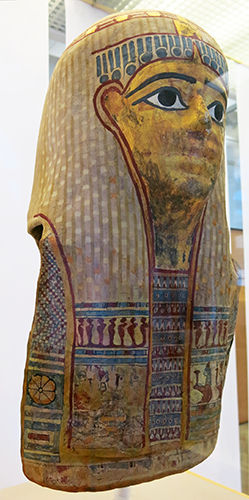
Ptolemaic Dynasty: 305 BC - 30 BC
Helmet mask for a mummy
Cartonnage, painted and gilded, Ptolemaic Period, ca 1st century BC, from Qubbet el-Hawa.
This type of mask was placed over the head of the mummy during this period. The youthful features were not intended as a likeness of the deceased, but projected an idealised image for their existence in the afterlife. The mask also provided physical protection and could act as a substitute should the mummy's head be lost or damaged.
Photo: Don Hitchcock 2014
Source: Original, Ägyptische Museum der Universität Bonn
Additional text: http://www.britishmuseum.org/explore/highlights/highlight_objects/aes/e/egyptian_mummy_mask.aspx, © Trustees of the British Museum
Ptolemaic Dynasty: 305 BC - 30 BC
Horus
Horus Falcon, middle of the First Century BC.
Catalog: Bronze, hollow casting, Inv. Nr. 2545
Photo: Don Hitchcock 2018
Source and text: Original, Museum August Kestner, Hannover
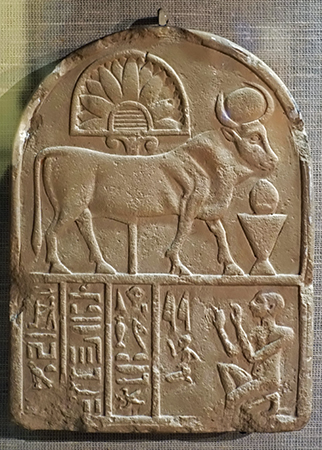
Ptolemaic Dynasty: 305 BC - 30 BC
Mnevis bull
Api worships the Mnevis bull, middle of the First Century BC.
Catalog: Limestone, probably from Heliopolis, Inv. Nr. 1935.200.695
Photo: Don Hitchcock 2018
Source and text: Original, Museum August Kestner, Hannover
The Graeco-Roman period
In many cases, it is not possible to identify artefacts to a narrow range of dates, but the style of the pieces irrevocably ties them to this latter stage of ancient Egyptian history, so they are grouped by many scholars under this heading
The Graeco-Roman Period (332 BC -395 AD) marks the end of Persian rule over Egypt. The Persians (who came from what is now Iran) were defeated by the Greek conqueror, Alexander the Great, who occupied Egypt and founded a new capital city at Alexandria. When Alexander's empire was divided after his death in 323 BC, his general Ptolemy acquired Egypt and established the Ptolemaic dynasty. Greek was the official language of Egypt under the Ptolemies. Greek influence in art, administration and military organisation continued for the next 300 years. The traditional gods were still worshipped but new gods were also introduced. The Romans gradually began to intervene in Egyptian affairs and in 30 BC they conquered Egypt. It became a province of the Roman empire. Roman influence affected every part of Egyptian life, from household utensils to religion. Roman emperors continued to be depicted as traditional pharaohs on temple reliefText above: http://www.globalegyptianmuseum.org/

Graeco-Roman Period: 332 BC - 395 AD
Shroud
Painted linen shroud of the Dancer of Min, Seusertsetes.
Ptolemaic Period, 332 - 30 BC.
The painted decoration of the shroud imitates the trappings of more elaborately prepared mummies: a face mask, collar and bead net incorporating figures of the winged scarab beetle and the Sons of Horus.
Dimensions: 1525 mm x 315 mm.
Catalog: Akhmim, EA17177
Photo: Don Hitchcock 2018
Source: Original, British Museum
Text: Card with the display at the British Museum, https://www.britishmuseum.org/, © Trustees of the British Museum, CC BY-NC-SA 4.0
Graeco-Roman Period: 332 BC - 395 AD
Mummy of a fish
Ichthyform animal coffin, hollowed out on one side, ends of tail chipped, with traces of red colour surviving, containing the mummy of a small fish, wrapped in linen, damaged in one place.
After 305 BC.
Length 152 mm (coffin, maximum).
Catalog: Painted wood, fish tissue, Akhmim, EA20764
Photo: Don Hitchcock 2018
Source: Original, British Museum
Text: Card with the display at the British Museum, https://www.britishmuseum.org/, © Trustees of the British Museum, CC BY-NC-SA 4.0
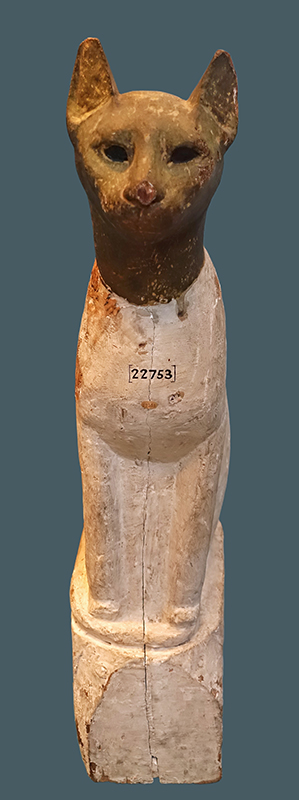
Graeco-Roman Period: 332 BC - 395 AD
Mummy case for a cat
Wooden mummy case for a mummified cat in the form of a seated cat. The head is painted green, the body white.
Height 700 mm.
Catalog: Painted wood, Tell Basta (Bubastis, Nile Delta), EA22753
Photo: Don Hitchcock 2018
Source: Original, British Museum
Text: Card with the display at the British Museum, https://www.britishmuseum.org/, © Trustees of the British Museum, CC BY-NC-SA 4.0
Graeco-Roman Period: 332 BC - 395 AD
Head of a man
Head from the standing-striding figure of a man wearing a lotus-bud diadem, first century BC.
Catalog: Granite, Soknopaiou Nesos (modern Dimé), Gl.30
Photo: Don Hitchcock 2015, 2018
Source: Original, Ägyptischen Museum München
Text: Museum card, © Ägyptischen Museum München
Graeco-Roman Period: 332 BC - 395 AD
Mummy of a young man
Discovered in the 1820s, later radiography has shown that the teeth are in excellent condition, suggesting an age at death of less than 21. The skeleton and soft tissues are well preserved. Mummification has been performed very carefully, the brain has been extracted through the nose, and the viscera through a large incision slightly to the left of the centre of the abdomen. The chest cavity contains cloth and elongated packages. These resembel bundles containing the internal organs, but cracks visible on CAT scans suggest that they may be clay dummies.
Catalog: EA6704
Photo: Don Hitchcock 2018
Source: Original, British Museum
Text: Card in museum, © Trustees of the British Museum
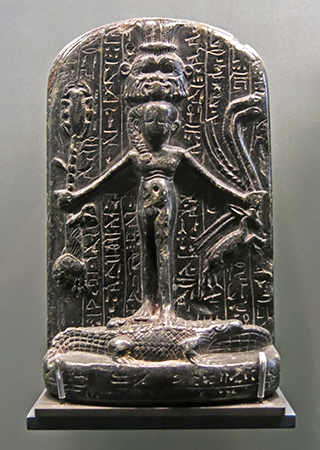
Graeco-Roman Period: 332 BC - 395 AD
Stele of Horus
Circa 379 BC - 30 AD
Harpocrates, shown naked, with the wick of childhood, is shown with a scorpion, lion, oryx, two serpents, and standing on two crocodiles.
Above is the head of Bes.
Height 188 mm, width 86 mm, thickness 58 mm.
Catalog: Serpentinite, Aile Sully, salle 336, Le Nil, Vitrine 7, E 3642
Photo: Don Hitchcock 2015
Source and text: Original, Louvre Museum, Paris, France, https://collections.louvre.fr/
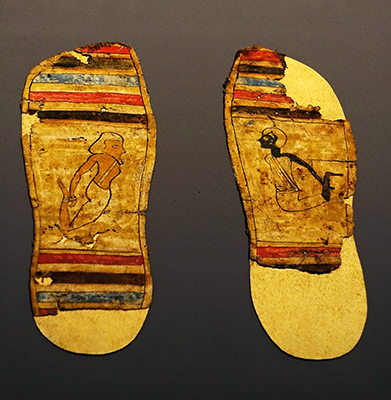
Graeco-Roman Period: 332 BC - 395 AD
Decorated Sandal Soles
Soles from a mummy-cover with depictions of bound foreigners (Syrian, Nubian).
Circa 1st century BC - 1st century AD.
Catalog: Linen, ÄS 750
Photo: Don Hitchcock 2018
Source: Original, Ägyptischen Museum München
Text: Museum card, © Ägyptischen Museum München

Graeco-Roman Period: 332 BC - 395 AD
Mummy Shroud
Mummy shroud with a painted broad collar of flowers and inscribed bands, 1st century BC - 1st century AD.
Catalog: Linen, ÄS 7079
Photo: Don Hitchcock 2018
Source: Original, Ägyptischen Museum München
Text: Museum card, © Ägyptischen Museum München
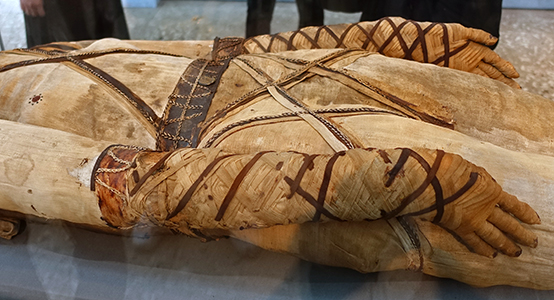
Graeco-Roman Period: 332 BC - 395 AD
Mummy of a young man
This shot of the torso gives a close up of an unusual but interesting leather belt.
Catalog: EA6704
Photo: Don Hitchcock 2018
Source: Original, British Museum
Text: Card in museum, © Trustees of the British Museum
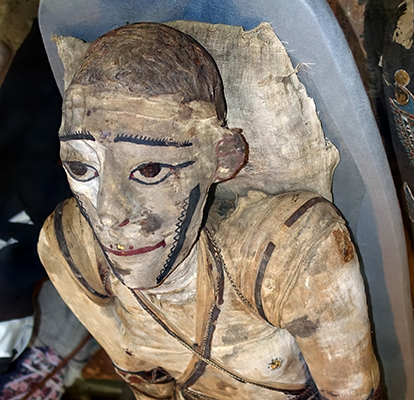
Graeco-Roman Period: 332 BC - 395 AD
Mummy of a young man
Before wrapping, the embalmer carefully modelled the facial features using resin soaked linen, and fillet out the limbs with granular material to create a life like appearance. The facial features were painted on the wrappings, and the crown of the head left exposed so that the natural hair should remain visible. The limbs have been wrapped separately and the fingers and toes individually bandaged. The feet have been wrapped to imitate sandals. Finely patterned wrapping was applied to the forearms, and the body was adorned with a belt, armlets and straps.
In this image we can see that the orginal hair on the head has been allowed to show through the wrappings.
The elaborate preparation of this mummy is highly idiosyncratic, and recalls the style of mummification used in the Old Kingdom. Other mummies brought from Egypt in the 1820s - 1830s and now in the museums of Liverpool, Leiden and Munich were prepared in an almost identical manner and all may have been discovered in a single tomb.
( see the mummy of Pasheryentaihet exhibited in the Leiden Museum immediately below - Don )
Catalog: EA6704
Photo: Don Hitchcock 2018
Source: Original, British Museum
Text: Card in museum, © Trustees of the British Museum
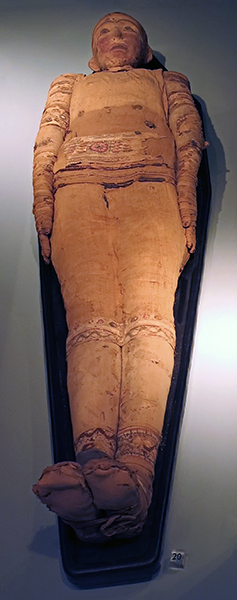
Graeco-Roman Period: 332 BC - 395 AD
Pasheryentaihet
Mummy of Pasheryentaihet
All limbs are individually wrapped, the bandages imitate clothes. Also unique are the painted decorative bands.
Mummy, linen; site Thebes / Luxor; 200-300 AD. Roman Imperial Period
The exterior aspect of this mummy carefully reproduces a body with all limbs clearly visible, the arms pressed against the sides with outstretched fingers. The facial features and ears have been modelled to regain their natural aspect and are covered by a single piece of fine linen, onto which the details have been painted: black for the eyebrows and the rims, irises, and cosmetic stripes of the eyes; dark red for the corners of the eyes, the wings of the nose and nostrils, the lips, and the details of the ears; bright red for the blushes. Above, this sheet of linen ends with a narrow turn-up around the forehead; the top of the head has not been wrapped and shows the close-cropped natural hair (reddish brown), with a bit of bare skull at the back of the head.
Two bands of linen (36 mm wide) lie over the shoulders and form a 'collar' in front; the remains of a leaf garland still lie on top of this collar, fixed with drops of resin or bitumen. The front of the torso is covered by a 'bodice' of a single sheet of fine linen (warp-faced tabby weave, 15 x 40 threads/cm 2), folded over along the lateral edges, with a second sheet lying over the front and sides of the thighs. The back shows that there is a second layer of sheets underneath, with irregular strata of narrow bandages and some diagonal bands visible through the damaged patches and the gap along the centre of the back. Traces of bitumen, (modern) glue, and leaves across the stomach betray the presence of another garland in that position, possibly the amulettes en feuilles dorées mentioned by Anastasi. Just above the lower border of the bodice lies a transverse band of painted linen; it is 93 mm wide and much frayed at the ends.
The decoration consists of a central frieze of a rosette flanked by two squares with a pattern of overlapping scales or petals, with guilloche bands along the edges. The colours are black, red, pink, and yellow on a white ground. Just below this band, the upper border of the next sheet covering the thighs is accompanied by three parallel strips of linen (12 mm wide, alternating dark brown, plain, and dark brown), each with a plaited string of white and dark brown thread along the centre. The sheet over the thighs has some water stains and is tucked in between the legs. There are two more painted bands around the knees (50 mm wide), each with an upper frieze of oval leaves (shaded white/pink/red or white/yellow/green on a cream ground) and a lower frieze with a stylized grapevine (black, yellow, and green between red bands).
The lower legs are separately wrapped in bleached linen 'stockings', rather damaged and showing water stains. Painted bands with up-turned borders (7.5 cm wide) and two different designs have been applied just above the ankles. The one on the right shows a succession of a grapevine, a strip of zigzag design (with the individual triangles coloured white, red, and yellow), and a large red leaf pattern; the lower half of the band has a large black stain. The left ankle shows a central grapevine flanked by zigzag strips and strips of unclear black designs. The ankles and feet have been wrapped in narrow strips of linen, but the toes are shown as individual rolls of cloth, with thin strips pressed down between the toes. The toenails have been applied as tiny folded pieces of dark-stained linen.
Soles of folded linen were fixed under the feet, with separate bands around the front edges. Triple strings of plyed linen run down from the insteps in imitation of sandal straps. The two feet are bound together by a single strap knotted under the soles. The arms are wrapped in sheets of bleached linen, with separate pieces covering the tips of the shoulders.
The linen is much damaged and soiled and shows a hole in the side of the left upper arm. There are painted bands around the upper arms (57 mm wide, showing the same design as the knee bands, upside down on the right arm), the elbows (8.8 cm wide with up-turned borders, rather similar to the ankle bands), and the wrists (92 mm wide, up-turned borders, similar design). The hands are wrapped in narrow concentric bandages applied in spiral fashion from the palms of the hands upwards. The fingers are wrapped individually, with dark-stained nails indicated.
Photo: Don Hitchcock 2014
Source: Original, Rijksmuseum van Oudheden, National Museum of Antiquities, Leiden.
Text: https://www.rmo.nl/collectie/collectiezoeker/collectiestuk/?object=438
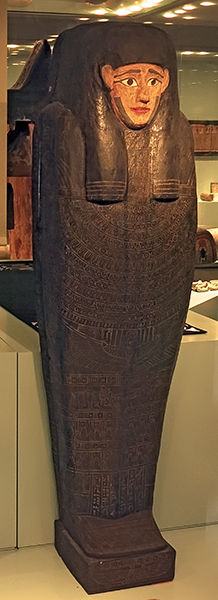
Graeco-Roman Period: 332 BC - 395 AD
Coffin of Hor
Wood, site Achim.
(Note that apart from the painted face, the rest of the coffin lid has been carved and engraved rather than painted - Don )
Catalog: Wood, Achim, AdS 2
Photo: Don Hitchcock 2014
Dimensions: 20 x 48 x 184 cm
Photo: http://www.rmo.nl/collectie/zoeken?object=AdS+2
Source and text: Original, Rijksmuseum van Oudheden, National Museum of Antiquities, Leiden.


Graeco-Roman Period: 332 BC - 395 AD
Mummy of Hor
Mummies from the Greek era often have loose masks and panels of cartonnage (layers of linen or papyrus covered with plaster)
Wood, Mummy, linen; site Achim; 305 BC - 030 BC Ptolemaic Dynasty, the last Dynasty of Ancient Egypt.
Mummy of an adult, very heavy and hard and displaying well-defined anatomical details (e.g. the calves). The bandages are applied in close concentric windings with a considerable overlap and an exposed part of no more than 2-4 cm wide. On the front part of the mummy, the wrappings are stained black due to the application of resin.
The linen is a medium-fine warp-faced tabby weave (about 24 x 12 threads/cm2). Several elements made of cartonnage (stucco and linen), much damaged and badly restored, lie on top of the wrappings. These comprise the following items, painted in red, blue, green, yellow, and black on white:
- mask: face and ears gilt, lips red, eyes and brows black and white, row of black dots along the forehead. Blue semicircle surrounded by border with radial lines under the chin, presumably depicting a beard. Tripartite wig blue with a red and white border. There are nine horizontal ranges of a necklace between the front lappets: a succession of tabs, roundels, and petals, with drops below. The crown of the head has been decorated with a winged scarab (black with yellow lines, wings with three zones: red hatching, white, and black feathers) surmounted by a sun disk (red).
- torso cover of tapering shape: Six sections from top to bottom, separated by block friezes: ba, facing right with wings spread out and claws holding disks, flanked by the two falcon-headed clasps of the collar and two kneeling goddesses with one hand raised; collar with eleven semicircular ranges of roundels, petals, and tabs with drops below; kneeling goddess, facing right, with hands holding feathers and extended wings, a disk on the head, and flanked by uraeus serpents and wedjat eyes; mummy on bier, flanked by two kneeling goddesses, with six vases below; five squatting demons with knives, all human-headed; serekh pattern. The last three sections are flanked by side-strips showing the four Sons of Horus, all human-headed.
- leg cover: slightly tapering panel with rounded end and four successive sections, separated by block friezes. From top to bottom: mummy on bier, wings above, flanked by two mummiform figures (jackal-headed left, falcon-headed right) and two kneeling goddesses, eight vases below; seven squatting demons holding knives (various heads); five bulls recumbent on shrines; twenty ranges of roundels, petals, and tabs, surrounded by a border of triangular petals and with a central column for inscriptions (blank).
- foot cover: top with eight squatting gods; two red feet, outlines and sandal straps white, nails gilt; block frieze around the sides, soles showing sandals with mosaic pattern in red, blue, and white.
Dimensions: 350 x 1590 x 245 mm
Catalog: mummy, linen, cartonnage, AdS 1
Photo (left): Don Hitchcock 2014
Photo (right): http://www.rmo.nl/collectie/zoeken?object=AdS+1
Text: https://www.rmo.nl/collectie/collectiezoeker/collectiestuk/?object=438
Source: Original, Rijksmuseum van Oudheden, National Museum of Antiquities, Leiden.
Graeco-Roman Period: 332 BC - 395 AD
Mummy of a young boy
Painted mummy case of a boy named Horemsah or Pemsais, first Century BC - first century AD, Graeco-Roman Period, from Akhmim.
This case appears to be made of mud with an outer layer of linen. Pamsais wears Hellenistic Greek costume, consisting of a blue undertunic (seen on the right forearm in this image), a red tunic with blue and white stripes, and a white mantle. His name is written in demotic beneath his left hand. He wears a blue and pink headdress with a raised band, perhaps a garland. At the back of the head is a mummification scene showing deities depicted in Egyptian style.
Length 890 mm, width 270 mm, height 245 mm.
Base and lid of a polychrome painted cartonnage mummy-case for the mummy of a young boy, called Pemsais, wearing a short tunic, with a cloak wrapped around the waist and draped over the left shoulder from behind, the name, in black painted Demotic, appears below the left hand, with mythological group represented on the top of the head.
Catalog: EA29589
Photo: Don Hitchcock 2015
Source: Original, British Museum
Text: Card at museum display, © Trustees of the British Museum
Graeco-Roman Period: 332 BC - 395 AD
Mummy of a young boy
Base and lid of a polychrome painted cartonnage mummy-case for the mummy of a young boy, called Horemsah or Pemsais, anthropoid, wearing a short tunic, with a cloak wrapped around the waist and draped over the left shoulder from behind, the name, in black painted Demotic, appears below the left hand, with mythological group represented on the top of the head.
Length 890 mm, width 270 mm, height 245 mm.
Inscription script Demotic, translation 'Recitation by the Osiris of Horemsah, son of Hor'.
Circa 100 BC - 100 AD.
Catalog: Sohag (Governorate), Akhmim, EA29589
Photo: Don Hitchcock 2018
Source: Original, British Museum
Text: © Card at the Museum, www.britishmuseum.org/research/ © Trustees of the British Museum, CC BY-NC-SA 4.0

Painted and gilded mummy case of an unnamed woman, Akhmim.
Graeco-Roman Period: 332 BC - 395 AD
Mummy Case
This case from the Graeco-Roman Period, 1st century BC - 1st century AD, is constructed from reused pieces of papyrus on which traces of writing are visible. The plastered exterior surface represents the dead woman dressed in a pink undertunic, a second tunic which is coloured blue with red stripes, and a striped linen mantle. A blue and gold lotus bud appears between the breasts, which are covered with gilded discs. The apron has a decorated border showing dancing figures and plant scrolls. Over the wig is a bound garland of pink, gold and blue flowers.
Length 165 cm, width 47 cm, height 36 cm.
Catalog: EA29585
Photo: Don Hitchcock 2015
Source: Original, British Museum
Text: Card with the display at the British Museum, http://www.britishmuseum.org/, © Trustees of the British Museum

Graeco-Roman Period: 332 BC - 395 AD
Mummy Case
The soles of the sandals appear to be at least partly woven.
Photo: Don Hitchcock 2015
Source: Original, British Museum
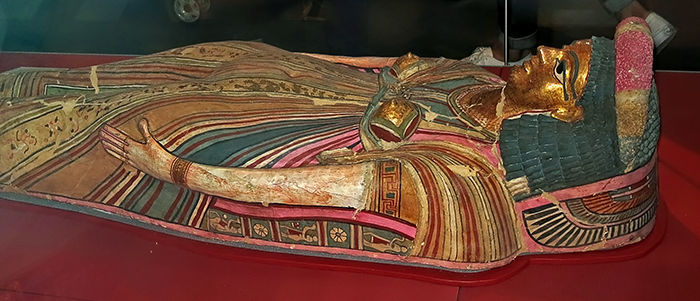
Graeco-Roman Period: 332 BC - 395 AD
Mummy Case
Another view of the mummy case, from the left.
It is interesting that the sculptor has attempted to show the form of the woman's body beneath her clothing, with the navel and abdomen clearly indicated.
Catalog: EA29585
Photo: Don Hitchcock 2015
Source: Original, British Museum
Text: Card with the display at the British Museum, © Trustees of the British Museum

Graeco-Roman Period: 332 BC - 395 AD
Nun and Naunet
Two gods, Nun (male) and Naunet (female, consort of Nun), deities of chaos and water, 1st Century BC.
Catalog: Sandstone, Inv. Nr. 1970.28
Photo: Don Hitchcock 2018
Source and text: Original, Museum August Kestner, Hannover
Additional text: Various sources
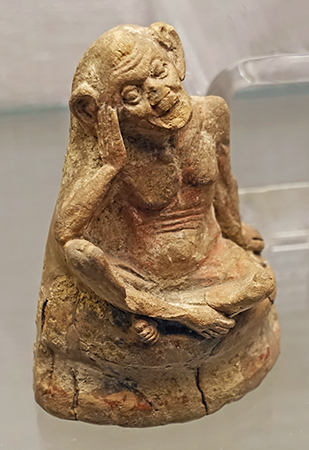
Graeco-Roman Period: 332 BC - 395 AD
Figure of a singer
Numerous pictorial representations and many preserved musical instruments as well as frequently documented titles referring to temple musicians show that the Egyptians liked to make music.
Although there was no musical notation, so that musical structures, beats and melodies cannot be reconstructed, the instruments at least give an impression of the sound.
The statuette of this beggar-like old singer, who presumably performed his songs at markets and popular festivals, is worked in the Hellenistic style. Like his ancestors of the classical Egyptian epochs and along with very many singers in today's Orient (also with the Koran reciters and the prayer callers on the minarets), he has in common with them their gesture of putting a hand to the cheek and ear, since they can hear the sound of their voice more clearly, especially when singing or chanting in a noisy environment.
Dimensions: Height 88 mm, width 63 mm.
Catalog: Origin unknown, terracotta, on loan from Ellen Hickmann
Photo: Don Hitchcock 2018
Source and text: Original, Museum August Kestner, Hannover
Additional text: Paper Catalogue, Museum August Kestner, Hannover.
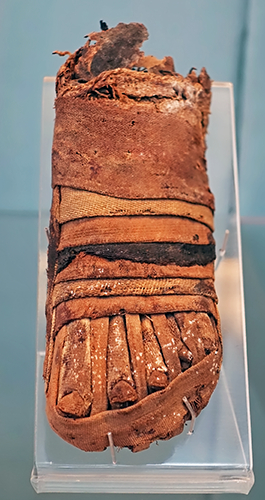
Graeco-Roman Period: 332 BC - 395 AD
Child's foot
Roman Period, after 30 BC
Mummified left foot of child, with wrappings imitating the toes protruding from a sandal.
Catalog: Qurna, EA6723a
Photo: Don Hitchcock 2018
Text: Card at museum display © Trustees of the British Museum, CC BY-NC-SA 4.0
Source: Original, British Museum
Graeco-Roman Period: 332 BC - 395 AD
Coffin
Painted wooden coffin of a young woman.
The front of the coffin represents the dead girl dressed in classical costume. Her long cream-coloured tunic has black stripes, or clavi, and a woven black H-motif on the right sleeve. A pink mantle with green edging is worn over the tunic. The feet are represented wearing black thonged sandals. A wreath is painted over the hair, and earrings, now lost, were originally inserted into holes in the ears.
Snake bracelets are painted on both wrists, and in the left hand are two sprigs, perhaps of myrtle. In front of the feet is an inverted scene in Egyptian style, showing the winged solar disc, from which emerge human arms holding tally-sticks, and the hieroglyphic sign ankh, signifying 'life'. The group is probably to be interpreted as a promise of eternal life through the power of the sun-god.
The sides of the coffin are decorated with figures of Egyptian deities arranged in registers.
Wooden base and lid of an anthropoid wooden coffin: for the body of a young girl, with extended foot-board, covered with moulded stucco and painted: the girl, with long black hair, is shown wearing a red mantle, with a green fringe, over a long white tunic, with a snake-bracelet on each wrist, holding sprigs of laurel in her left hand
Length 1090 mm, width 270 mm.
Catalog: Sohag (Governorate): Akhmim, EA29587
Photo: Don Hitchcock 2018
Source: Original, British Museum
Text: www.britishmuseum.org/research/ and card at the Museum, © Trustees of the British Museum, CC BY-NC-SA 4.0
Graeco-Roman Period: 332 BC - 395 AD
Coffin
Wooden base and lid of an anthropoid wooden coffin for the body of a young girl, with extended foot-board, covered with moulded stucco and painted. The girl, with long black hair, is shown wearing a red mantle, with a green fringe, over a long white tunic, with a snake-bracelet on each wrist, holding sprigs of laurel in her left hand.
Length 1090 mm, width 270 mm.
Catalog: Sohag (Governorate): Akhmim, EA29587
Photo: Don Hitchcock 2018
Source: Original, British Museum
Text: www.britishmuseum.org/research/ and card at the Museum, © Trustees of the British Museum, CC BY-NC-SA 4.0
Graeco-Roman Period: 332 BC - 395 AD
Coffin
Painted wooden coffin of a young woman.
Catalog: Sohag (Governorate): Akhmim, EA29587
Photo: Don Hitchcock 2018
Source: Original, British Museum
Text: www.britishmuseum.org/research/ and card at the Museum, © Trustees of the British Museum, CC BY-NC-SA 4.0

Graeco-Roman Period: 332 BC - 395 AD
Coffin
Over the feet, painted so as to be seen by the deceased, is a winged sun-disc, with arms supporting festive symbols, and an ankh beneath, the relatively high sides of the base are decorated with representations of funerary deities and inscriptions, damaged in places.
Catalog: EA29587
Photo: Don Hitchcock 2015
Source: Original, British Museum
Text: http://www.britishmuseum.org/research/, © Trustees of the British Museum
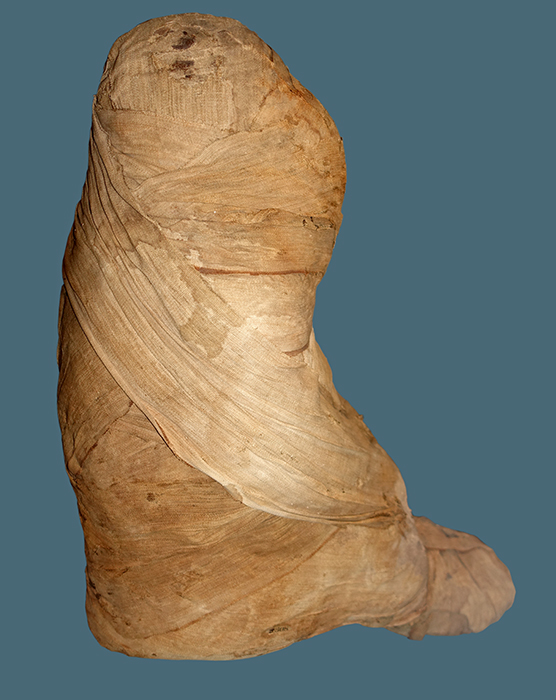
Graeco-Roman Period: 332 BC - 395 AD
Baboon mummy
Mummified baboon with linen wrappings.
Catalog: EA35857
Photo: Don Hitchcock 2018
Source: Original, British Museum
Text: © Card with the display at the British Museum, http://www.britishmuseum.org/ , © Trustees of the British Museum, CC BY-NC-SA 4.0
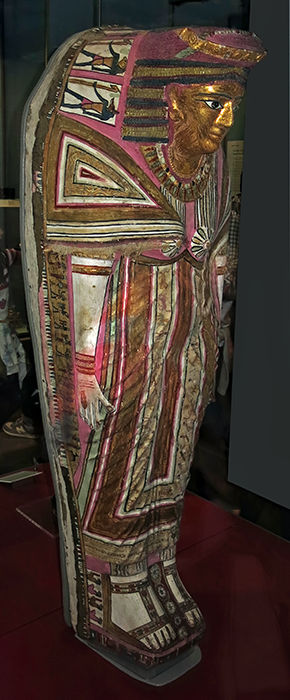
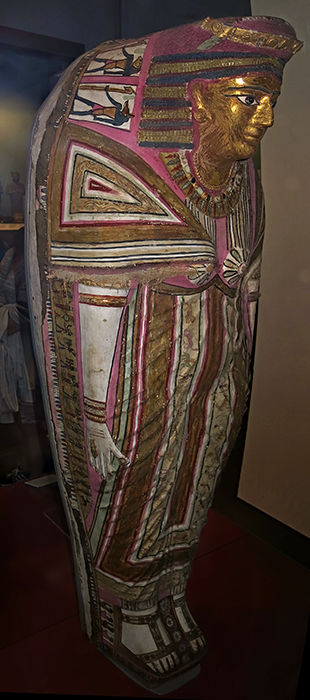
Graeco-Roman Period: 332 BC - 395 AD
Taminis
Taminis from Akhmim, Graeco-Roman Period, 1st century BC - 1st century AD.
Base and lid of a polychrome painted cartonnage mummy-case for the mummy of Taminis, daughter of Peteminis (or Spemminis), face and hair gilded, wearing a short-sleeved tunic, the border being decorated with hunting scenes and vignettes of domestic activities, which reaches to the ankles, the mantle, knotted between the breasts, covers the right shoulder and the loose end is drawn over the left shoulder from behind, and sandals; the name, in black painted Demotic, appears on the left shoulder; other funerary deities are represented around the edges of the lid; colours now faded.
Length 151 cm, width 54 cm, height 48 cm.
Catalog: EA29586
Photo: Don Hitchcock 2018
Source: Original, British Museum
Text: Card with the display at the British Museum, http://www.britishmuseum.org/, © Trustees of the British Museum
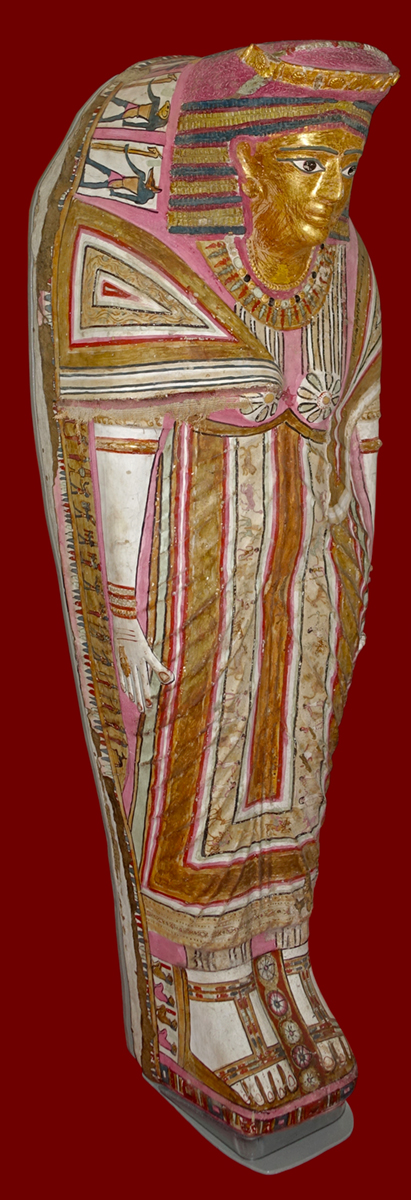
Graeco-Roman Period: 332 BC - 395 AD
Taminis
Tamanis is represented dressed in classical costume and jewellery. She wears a pink undertunic and a striped linen shawl over the shoulders. A demotic inscription (ancient Egyptian script derived from northern forms of hieratic used in the Nile Delta, and the stage of the Egyptian language written in this script, following Late Egyptian and preceding Coptic) on the left shoulder gives the name and parentage of the dead woman. A second tunic is visible on the arms and shins. The skirt is decorated with a figured scene of hunting, dancing to the music of flutes, and brewing beer. The jewellery includes earrings with bull's head terminals of late Hellenistic Greek type, necklaces, bracelets, and a variety of different rings.
Catalog: EA29586
Photo: Don Hitchcock 2018
Source: Original, British Museum
Text: Card with the display at the British Museum, www.britishmuseum.org/, © Trustees of the British Museum
Graeco-Roman Period: 332 BC - 395 AD
Girl from Akhmim
Painted and gilded mummy case of a girl from Akhmim, Graeco-Roman Period, 1st century BC - 1st century AD.
This case appears to be made of mud, plastered on the outside and whitewashed on the interior. The painted decoration reproduces typical features of the trappings of a mummy of the Ptolemaic Period, with bead-net, gilded mask, large collar with falcon-head terminals, and cartonnage plaques. The feet are represented wearing sandals.
The painted bead-net includes a representation of Nut, with outstretched wings on the breast, with the falcon of Horus beneath.
Length 1100 mm, width 359 mm.
Catalog: EA29590
Photo: Don Hitchcock 2015, 2018
Source: Original, British Museum
Text: Card with the display at the British Museum, http://www.britishmuseum.org/, © Trustees of the British Museum
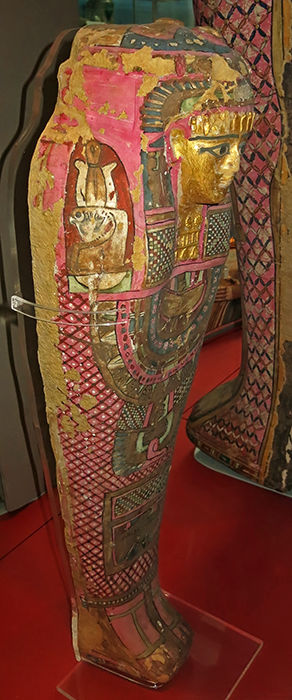
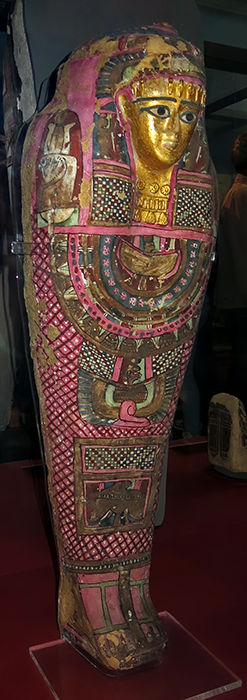
Graeco-Roman Period: 332 BC - 395 AD
Girl from Akhmim
Painted and gilded mummy case of a girl from Akhmim, Graeco-Roman Period, 1st century BC - 1st century AD, as above.
Catalog: EA29590
Photo: Don Hitchcock 2015
Source: Original, British Museum
Text: Card with the display at the British Museum, http://www.britishmuseum.org/, © Trustees of the British Museum


Graeco-Roman Period: 332 BC - 395 AD
Man from Akhmim
Bearded man from Akhmim, Graeco-Roman Period, 1st century BC - 1st century AD.
The case is made from mud mixed with straw or chaff, with an outer skin of textile and an inner coating of plaster.
Catalog: EA29584
Photo: Don Hitchcock 2015
Source: Original, British Museum
Text: Card with the display at the British Museum, http://www.britishmuseum.org/, © Trustees of the British Museum

Graeco-Roman Period: 332 BC - 395 AD
Man from Akhmim
Bearded man from Akhmim, Graeco-Roman Period, 1st century BC - 1st century AD.
The decoration is in traditional Egyptian style, the surface painted to represent a bead-net incorporating a collar, with a winged sun-disc and cartonnage or textile plaques decorated with figures of gods.
Catalog: EA29584
Photo: Don Hitchcock 2018
Source: Original, British Museum
Text: Card with the display at the British Museum, http://www.britishmuseum.org/, © Trustees of the British Museum
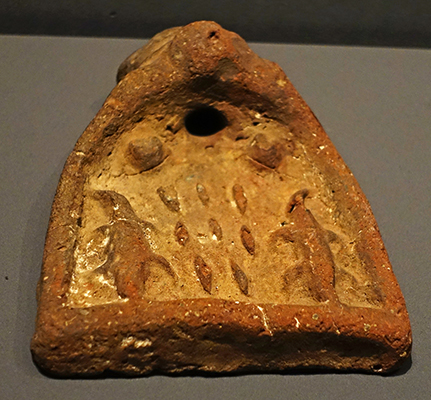
Graeco-Roman Period: 332 BC - 395 AD
Libation basin
Libation basin with crocodiles and offerings, 1st century BC - 1st century AD.
Catalog: Ceramic, ÄS 7235
Photo: Don Hitchcock 2018
Source: Original, Ägyptischen Museum München
Text: Museum card, © Ägyptischen Museum München
Graeco-Roman Period: 332 BC - 395 AD
Models of a Naos
Models of a naos with the naos harbouring the god Canopus, 2nd century BC - 2nd century AD.
In Greek mythology, Canopus or Canobus was the pilot of the ship of King Menelaus of Sparta during the Trojan War.
Catalog: Limestone and ceramic, ÄS 7091, ÄS 7097
Photo: Don Hitchcock 2018
Source: Original, Ägyptischen Museum München
Text: Museum card, © Ägyptischen Museum München
Additional text: Wikipedia
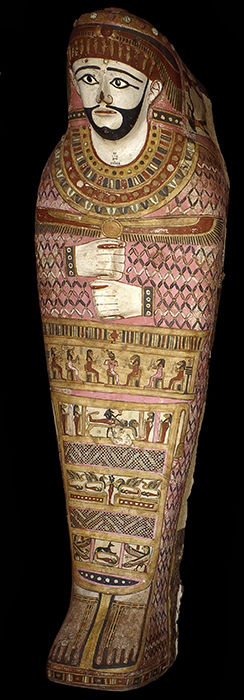
Graeco-Roman Period: 332 BC - 395 AD
Man from Akhmim
The feet are represented wearing sandals. Unusually, a naturalistic beard and moustache are painted on the face. The eyes are inlaid with glass.
Length 1740 mm, width 525 mm, height 480 mm.
Catalog: EA29584
Photo: © Trustees of the British Museum
Source: Original, British Museum
Text: Card with the display at the British Museum, http://www.britishmuseum.org/, © Trustees of the British Museum
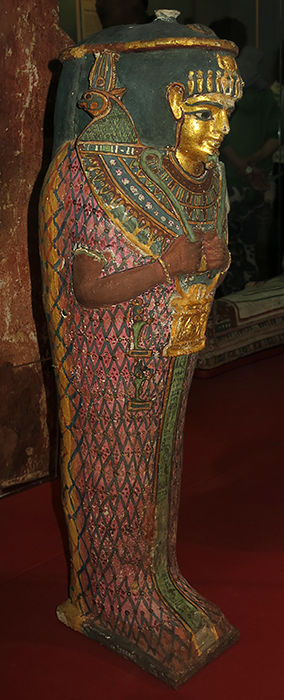
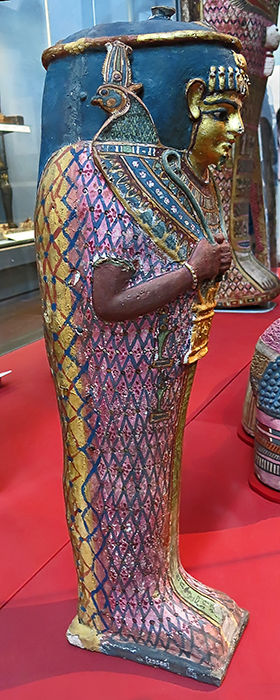
Graeco-Roman Period: 332 BC - 395 AD
Mummy case of an infant
Painted and gilded mummy case of an infant, from Akhmim, Graeco-Roman Period, 1st century BC - 1st century AD.
The constructional details of this case are not fully visible, but the materials used included linen and other plant fibre. A painted bead-net on a pink background imitates the garment often shown worn by Osiris. The modelled arms and hands grasping the crook and flail sceptres emphasise the symbolic association between the dead child and the god. The elaborate falcon=head terminals of the collar are unusually represented as shown standing proud of the shoulders.
A gold pectoral is represented on the breast, and figures of the four Sons of Horus are painted on the sides. The gilded face-mask is surmounted by a row of gilded uraeus-serpents and a solar disc. The support for a crown, now lost, survives at the top of the head.
Catalog: EA29588
Photo: Don Hitchcock 2015
Source: Original, British Museum
Text: Card with the display at the British Museum, © Trustees of the British Museum
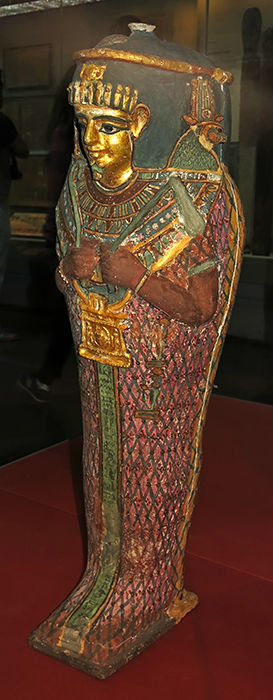
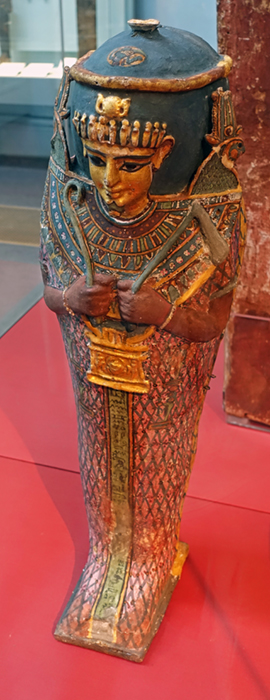
Graeco-Roman Period: 332 BC - 395 AD
Mummy case of an infant
Painted and gilded cartonnage mummy case of an infant, sex uncertain, from Akhmim, Graeco-Roman Period, 1st century BC - 1st century AD.
Skull - Flexed. No obvious fractures. Thorax and Abdomen - Owing to tight bandaging, the thoracic cage has been compressed and some of the ribs are fractured. A segment of the dorsal spine has been dislocated and is displaced to the left. A dense, cylindrical object lies in the right hemithorax. A similar object lies in the left hemithorax.
Pelvis - Apparently empty. The pelvic bones and hips appear normal. Arms - Crossed on the breast (right over left). The palms of the hands, fingers extended, lie just below the shoulders. No fractures or dislocations seen. Legs - The bones and joints appear normal. No fractures or dislocations seen.
The mummy-case is made in the form of Osiris. The face is gilded, the head originally surmounted by a crown. There is a gilded pectoral around neck, showing in relief a scarab flanked by falcons, crowned with solar discs, that surmounts an elaborate collar with free-standing falcon-headed terminals. The arms are not crossed, but the figure does hold crook and flail and wears bracelets. The body is painted to represent a bead-net and decorated with painted amulets, in the form of the four Sons of Horus, with a vertical register of corrupt hieroglyphs down centre of body.
Length 810 mm, width 235 mm, length 780 mm (mummy).
Catalog: EA29588
Photo: Don Hitchcock 2015, 2018
Source: Original, British Museum
Text: http://www.britishmuseum.org/, © Trustees of the British Museum
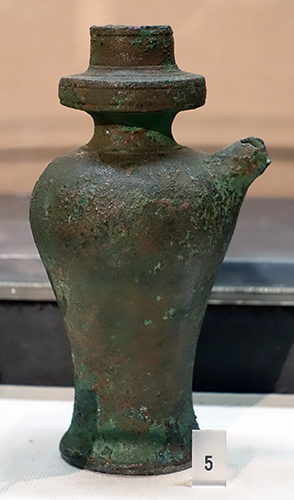
Graeco-Roman Period: 332 BC - 395 AD
Jug
Bronze jug with spout, height 164 mm, diameter 90 mm.
Catalog: Bronze, Inv. Nr. 1935.200.764
Photo: Don Hitchcock 2018
Source and text: Original, printed catalog, Museum August Kestner, Hannover
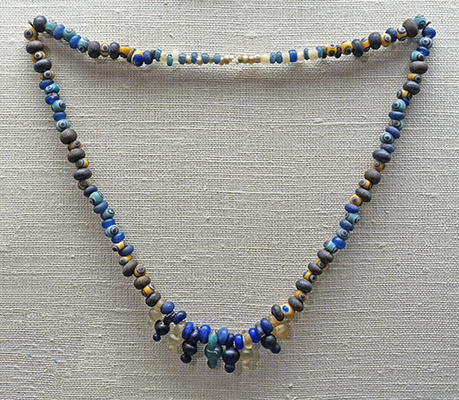
Graeco-Roman Period: 332 BC - 395 AD
Necklaces
Necklaces composed of semi-precious stones, gold amulets, and glass pastes.
Catalog: Semi-precious stones, gold amulets, and glass pastes, Inv. Nr. 1955.142, 1954.6, 1955.2
Photo: Don Hitchcock 2018
Source and text: Original, Museum August Kestner, Hannover
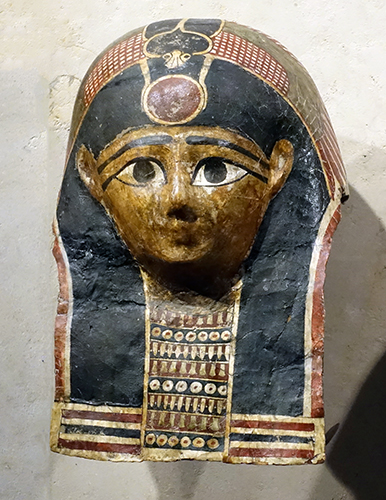
Graeco-Roman Period: 332 BC - 395 AD
Mummy Mask
Circa 1st century BC - 2nd century AD.
The shape of the wig framing the face on the mummy masks also places the deceased in the vicinity of the gods: it is the so-called 'Strähnen' or stranded wig with long plaits falling on the chest and a broad neck section which, in the case of chimaeric deities, connects the human body with an animal head.
On the top of the head, a winged scarab spreads its wings protectively.
Photo: Don Hitchcock 2018
Source: Original, Ägyptischen Museum München
Text: Museum card, © Ägyptischen Museum München
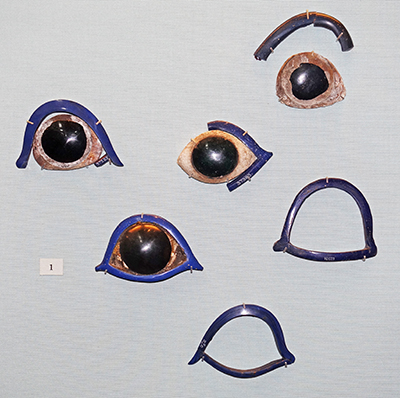
Graeco-Roman Period: 332 BC - 395 AD
Bull's Eyes
Eyes for insertion into bull mummy-masks
Some mummified bulls were provided with gilded cartonnage masks. These incorporated eyes made of black glass or obsidian, and white stone, set within rims of blue glass.
Catalog: EA16627, EA16629, EA37382-4, EA63382
Photo: Don Hitchcock 2018
Source: Original, British Museum
Text: Card with the display at the British Museum, https://www.britishmuseum.org/, © Trustees of the British Museum, CC BY-NC-SA 4.0
The Roman / Byzantine Period
30 BC - 619 AD
The Roman province of Egypt was established in 30 BC after Octavian (the future emperor Augustus) defeated his rival Mark Antony, deposed his lover Queen Cleopatra VII and annexed the Ptolemaic Kingdom of Egypt to the Roman Empire. The province encompassed most of modern-day Egypt except for the Sinai Peninsula (which would later be conquered by Trajan). Aegyptus was bordered by the provinces of Creta et Cyrenaica to the West and Iudaea (later Arabia Petraea) to the East.Text above: Adapted from Wikipedia and http://www.ancient.eu/Western_Roman_Empire/
The province came to serve as a major producer of grain for the empire and had a highly developed urban economy. Aegyptus was by far the wealthiest Eastern Roman province. In Alexandria, its capital, it possessed the largest port, and the second largest city, of the Roman Empire.
By 285 AD the Roman Empire had grown so vast that it was no longer feasible to govern all the provinces from the central seat of Rome. The Emperor Diocletian divided the empire into halves with the Eastern Empire governed out of Byzantium (later Constantinople) and the Western Empire governed from Rome. Both sections were known equally as 'The Roman Empire' although, in time, the Eastern Empire would adopt Greek instead of Latin and would lose much of the character of the traditional Roman Empire.
From 395 AD, with the final division of the Roman Empire, Egypt was part of the (Eastern) Byzantine Roman Empire.
The period of official 'Roman' rule of Egypt ended with the Sassanian Persian invasion in 619 AD
The Roman Period
30 BC - 395 AD

Roman Period: 30 BC - 395 AD
Two mummified falcons
Two mummified falcons bandaged together.
Catalog: Thebes, EA15980
Photo: Don Hitchcock 2015
Source: Original, British Museum
Text: Card at museum display, http://www.britishmuseum.org/, © Trustees of the British Museum, CC BY-NC-SA 4.0
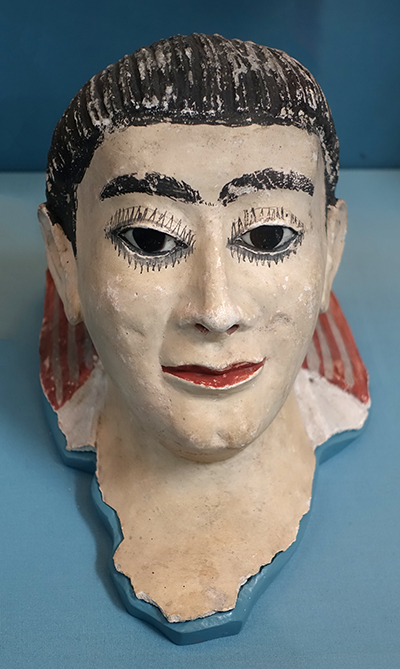
Roman Period: 30 BC - 395 AD
Plaster Mask
Painted plaster mask of a young man with inlaid glass eyes.
Circa 100 AD - 120 AD.
Height 21 cm, width 18 cm, depth 28 cm.
Catalog: Akhmim, EA24781
Photo: Don Hitchcock 2018
Source: Original, British Museum
Text: Card at museum display, http://www.britishmuseum.org/, © Trustees of the British Museum, CC BY-NC-SA 4.0
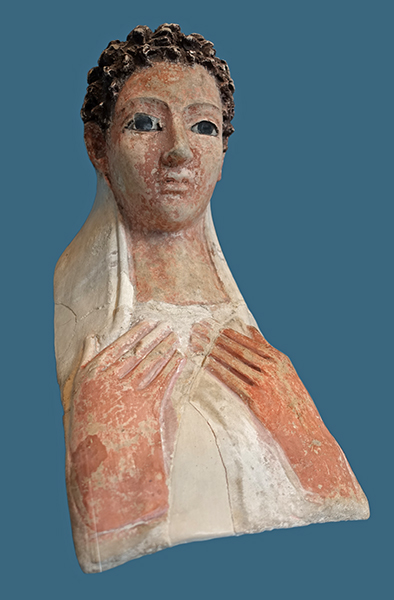
Roman Period: 30 BC - 395 AD
Plaster Mask
Circa 120 AD - 150 AD.
Painted plaster mask of a youth with inlaid calcite eyes. Painted representation of Osiris on mantle at the back of the neck.
Below the ears and hands are holes for pegs to attach the headpiece to a coffin
Height 290 mm, width 215 mm, depth 470 mm.
Catalog: Plaster, calcite, EA24779
Photo: Don Hitchcock 2018
Source: Original, British Museum
Text: Card at museum display, http://www.britishmuseum.org/, © Trustees of the British Museum, CC BY-NC-SA 4.0

Roman Period: 30 BC - 395 AD
Mummy Mask
Circa 120 AD - 150 AD.
Painted plaster portrait-bust of a girl with inlaid glass eyes. There is a painted funerary scene at the back of the neck, and some gilded detail.
Height: 280 mm, width 218 mm, depth 315 mm.
Catalog: plaster, glass, gold, inlaid, painted, gilded, EA24780
Photo: Don Hitchcock 2018
Source: Original, British Museum
Text: Card at museum display, http://www.britishmuseum.org/, © Trustees of the British Museum, CC BY-NC-SA 4.0
Roman Period: 30 BC - 395 AD
Mummy Portrait
Painted cartonnage mummy-mask with a rosebud garland in the hair and exposed breasts.
Circa 100 AD - 120 AD.
Height 68 cm, width 39 cm
The best-known funerary representations from Roman Egypt are the so-called 'mummy portraits' but plaster masks, often extending over the upper body, were also popular, and are found from the earliest years of the Roman occupation.
The face of this mask was shaped separately by pressing the plaster onto a mold; on some examples this method of manufacture is clearly indicated by finger-marks on the interior. This face was subsequently attached to the headdress and torso, and the somewhat unusual orientation of the head is probably due to a rather awkward join with the other parts.
The anonymous woman wears a yellow tunic, leaving her breasts exposed. A band of cloth runs from the tunic between the breasts onto a colourful collar, at the bottom of which is a winged scarab beetle. In her hair is a garland of rosebuds. Her sleeves bear the protective wings of Isis and Nephthys, and images of other deities appear on the area of the mask behind her hair. These include Anubis and Re-Horakhty. The woman wears earrings, gold bracelets on both wrists, and two rings on the fingers of her left hand. She holds a sprig of leaves, perhaps myrtle.
The style of the earrings, bracelets, and rings suggests a date in the early second century AD; around that time this hairstyle, based on a traditional Egyptian one, became popular in funerary portraits. The style of the facial representation, the hair, and elements of the dress show strong classical influence, but the religious iconographical elements show that the fundamental concepts of the Egyptian way of death were still to be found well into the Roman era, with the scarab symbolising both the solar cycle and the regeneration of life, and Isis, Nephthys, and the other deities protecting the owner.
Little is known about the specific findspots of such masks, although they seem to have been particularly popular in Middle Egypt. This object is unprovenanced, but it has been argued that it may be associated with the types of mask that covered a considerable part of the upper body, and which have been found from the Roman Period, in particular the later second and third centuries AD, at Deir el-Medina and Deir el-Bahari in the Theban region.
Catalog: Cartonnage, plaster, linen, painted, EA29476
Photo: Don Hitchcock 2018
Source: Original, British Museum
Text: Card at museum display, http://www.britishmuseum.org/, © Trustees of the British Museum, CC BY-NC-SA 4.0
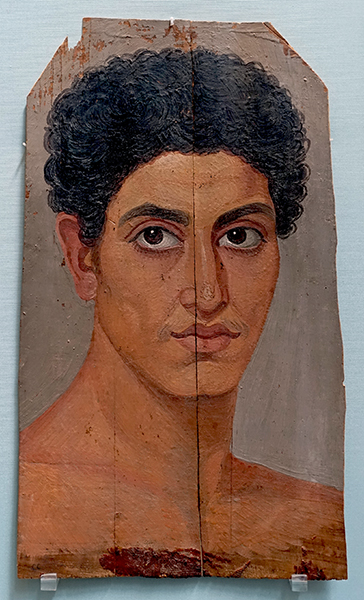
Roman Period: 30 BC - 395 AD
Mummy Portrait
Limewood panel bearing portrait in encaustic and tempera of naked young man with curly hair.
Painted with the encaustic method, a painting technique in which pigments are mixed with hot liquid wax.
Circa 80 AD - 120 AD.
Height 358 mm, thickness 1.5 mm, width 207 mm.
Catalog: lime wood, wax, egg, oil, Fayum, Hawara, EA74711
Photo: Don Hitchcock 2018
Source: Original, British Museum
Text: Card at museum display, http://www.britishmuseum.org/, © Trustees of the British Museum, CC BY-NC-SA 4.0
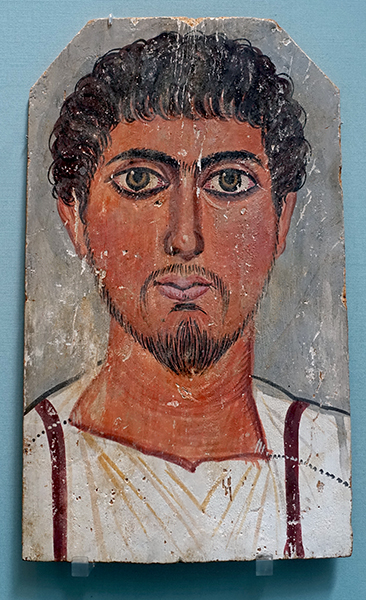
Roman Period: 30 BC - 395 AD
Mummy Portrait
Early second century AD.
Oak panel bearing tempera portrait of bearded man wearing white tunic with purple clavi.
Length 302 mm, width 180 mm, weight 128 gm.
Catalog: Oak, tempera, Rubaiyat, EA63397
Photo: Don Hitchcock 2018
Source: Original, British Museum
Text: Card at museum display, http://www.britishmuseum.org/, © Trustees of the British Museum, CC BY-NC-SA 4.0

Roman Period: 30 BC - 395 AD
Mummy Mask
Painted plaster portrait-head of a bearded man. The mask has inlaid glass eyes and includes a painted vignette of a mummy at the back of the neck. The left ear is chipped.
Circa 120 AD - 150 AD.
Height 260 mm, width 163 mm, depth 250 mm.
Catalog: Plaster, glass, painted, inlaid, EA24902
Photo: Don Hitchcock 2018
Source: Original, British Museum
Text: Card at museum display, http://www.britishmuseum.org/, © Trustees of the British Museum, CC BY-NC-SA 4.0
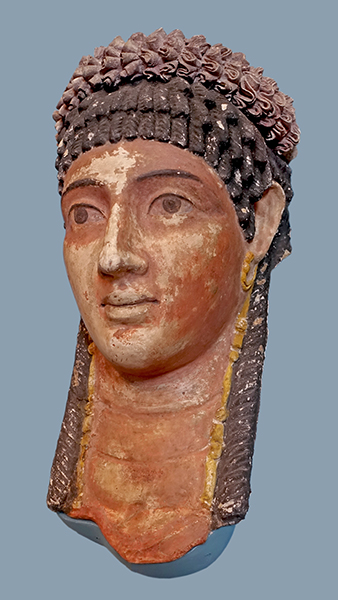
Roman Period: 30 BC - 395 AD
Mummy Mask
Circa 100 AD - 120 AD.
Painted plaster mask of a woman: the mask is broken at the back of the head. The painted surface is lost in places, notably on the nose and brow and the proper right cheek.
At the base of the neck the folds of a red tunic appear. In the woman's ears are double hoop earrings of gold, strung with three beads. Below the ears hang two matching chains of oblong beads separated by groups of one square bead flanked by two small round beads.
The mask may be dated by the jewellery, hairstyle and sober, rather matronly appearance, to the early years of the second century AD.
All the jewellery is rendered in yellow ochre paint, some perhaps modern. On her head the woman wears an elaborate wreath of rosebuds, originally pink but now faded. In front of the wreath the hair is arranged in three tiers of corkscrew curls, brushed back over the ears, behind which fall corkscrew locks, of which only one survives complete on either side. Behind the wreath the hair is painted black with carbon pigment.
The eyebrows are carefully drawn, the upper lid of the eye outlined in black, the pupil and iris crudely painted in black and brown. The skin, including the whites of the eyes, is covered with a pinkish-brown wash. The long neck is as if divided in tiers by Venus rings. The physiognomy of the face also suggests a fleshy appearance.
Height 345 mm, width 200 mm, depth 280 mm.
The mask may be dated by the jewellery, hairstyle and sober, rather matronly appearance to the early years of the second century AD.
Catalog: Plaster, painted, EA29477
Photo: Don Hitchcock 2018
Source: Original, British Museum
Text: Card at museum display, http://www.britishmuseum.org/, © Trustees of the British Museum, CC BY-NC-SA 4.0
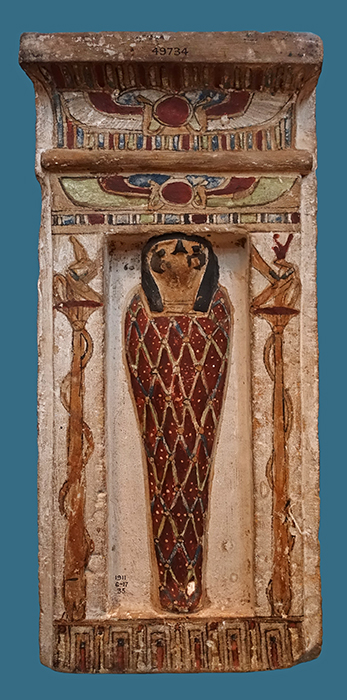
Roman Period: 30 BC - 395 AD
Sandstone shrine
Sandstone shrine with painted relief decoration of a hawk.
Height 450 mm, length 180 mm, width 207 mm.
Catalog: Sandstone, EA49734
Photo: Don Hitchcock 2018
Source: Original, British Museum
Text: Card at museum display, http://www.britishmuseum.org/, © Trustees of the British Museum, CC BY-NC-SA 4.0
Roman Period: 30 BC - 395 AD
Mummy of a Falcon
Mummy of a falcon wrapped in linen, in a painted cartonnage case, orginally enclosed in the sandstone shrine above.
Length 375 mm.
Catalog: Plaster, linen, hawk tissue, EA49734
Photo: Don Hitchcock 2018
Source: Original, British Museum
Text: Card at museum display, http://www.britishmuseum.org/, © Trustees of the British Museum, CC BY-NC-SA 4.0
Roman Period: 30 BC - 395 AD
Mareis
Gilded cartonnage mummy-mask of Mareis. Obsidian and limestone eyes cased in bronze (lost on left side). There is a one line inscription in Greek on the forehead, and painted funerary scenes on the front and back.
Height 51 cm, width 38 cm, circa 20 AD - 40 AD
Middle Egypt, Faiyum, Hawara
Catalog: Plaster, painted, gilded, Faiyum, Hawara, Middle Egypt, EA21807
Photo (left): Don Hitchcock 2015
Photo (right): © Trustees of the British Museum
Source: Original, British Museum
Text: http://www.britishmuseum.org/research/ © Trustees of the British Museum
Roman Period: 30 BC - 395 AD
Mareis
These photographs bring out the gilded nature of the piece, and also show that it is what may be called a 'helmet' rather than a Mummy-Mask.
This type of covering for the head and shoulders of the mummy is a more complete version of the Masque-Plastron-Dosseret configuration, seen in the second and third century AD, see below.
Catalog: Plaster, linen, gold, obsidian, limestone, bronze, Hawara, EA21807
Photo: Don Hitchcock 2018
Source: Original, British Museum
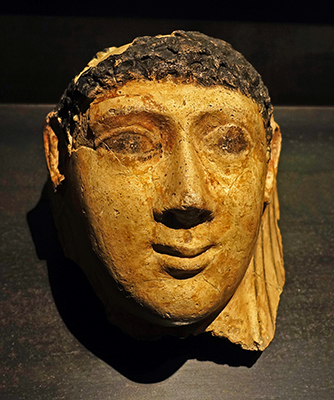
Roman Period: 30 BC - 395 AD
Mummy mask
Mummy mask of a young man, early Roman Period, 1st century AD.
Catalog: Plaster, painted, ÄS 800
Photo: Don Hitchcock 2018
Source: Original, Ägyptischen Museum München
Text: Museum card, © Ägyptischen Museum München
Roman Period: 30 BC - 395 AD
The book of Traversing Eternity of Fedumont
Funerary papyrus of Fedumont containing the Book of Traversing Eternity (short version); black outline vignettes and Hieratic text in two columns recto; Hieratic title verso.
Length 663 mm (frame), width 313 mm (frame).
Catalog: Papyrus, EA10091
Photo: Don Hitchcock 2018
Source: Original, British Museum
Text: Card at Museum, http://www.britishmuseum.org/research/search_the_collection_database/, © Trustees of the British Museum, CC BY-NC-SA 4.0
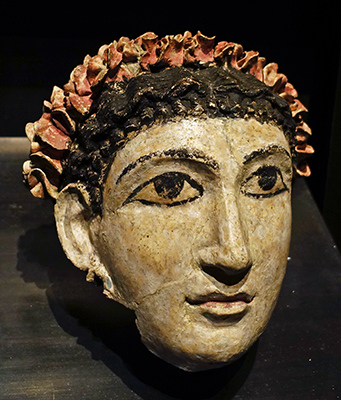
Roman Period: 30 BC - 395 AD
Mummy Mask
Mummy Mask of a woman with a wreath of flowers.
Early Roman Period, 1st century AD.
Catalog: Plaster, painted, ÄS 799
Photo: Don Hitchcock 2018
Source: Original, Ägyptischen Museum München
Text: Museum card, © Ägyptischen Museum München

Roman Period: 30 BC - 395 AD
Mummy Portrait
Mummy portrait of an old woman.
Early Roman Period, 1st century AD.
Catalog: Wood, painted, El-Rubajat, ÄS 1
Photo: Don Hitchcock 2018
Source: Original, Ägyptischen Museum München
Text: Museum card, © Ägyptischen Museum München
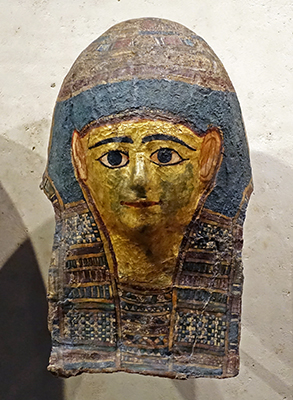
Roman Period: 30 BC - 395 AD
Mummy Mask
The mask is composed of cartonnage, the material from which many Egyptian mummy masks and coffins were made, consisting of linen or papyrus held together with glue.
The idealised facial features with a slight smile show a transfigured one, who is withdrawn from all earthly things by the golden skin colour and is brought closer to the gods. In the Book of the Dead these are described as follows:
'Your hair is made of lapis lazuli, Re appears on your face so that it is clothed in gold.'
Photo: Don Hitchcock 2018
Source: Original, Ägyptischen Museum München
Text: Museum card, © Ägyptischen Museum München
Additional text: Collins Dictionary
Roman Period: 30 BC - 395 AD
Cupid and Psyche
Cupid and Psyche in conversation, engraved on Sardonyx, Roman, first century BC.
Cupid (love), tied by both legs, has raised one hand in a gesture of speech, which shows him talking to his counterpart, Psyche (spirit), in a - certainly contrary - conversation.
Catalog: Sardonyx, often used for engraved gems
Photo: Don Hitchcock 2018
Source and text: Original, Museum August Kestner, Hannover

Roman Period: 30 BC - 395 AD
Aline
Family Burial: Mummy portrait of the lady Aline
1st half of the 1st century AD.
Dimensions: 420 x 325 x 20 mm
In the Roman period mummies previously covered with a mask for better identification were replaced in the Fayum with painted portraits on linen or wood panels. Often they are real portraits showing the person at an advanced age and painted during their lifetime. This portrait shows Aline, daughter of Herodotus, who died at the age of 35 years.
The custom to place portraits on the mummy was limited to a small area. The circa 750 preserved paintings are the only evidence from Egypt of Hellenistic portrait painting. On the basis of dress, hairstyle and jewellery which orients itself on the Roman Emperors' fashion it is possible to date these portraits precisely. Alina's curls neatly arranged correspond to the fashion under the Emperor Tiberius and thus she died during his 10th year of rule.
The mummy of Aline was found together with the mummy of her husband and 3 children. Her husband and older child are covered with mummy masks while she and the two younger children are covered with flat mummy portraits.
Richard von Kaufmann, a Berlin art collector, conducted his own excavations in 1892 in Hawara, a site in the Fayum. He came across a Roman burial chamber in which a total of eight stacked mummies lay. At the bottom, a mummy with the painted portrait of a mature woman came to light, in the immediate vicinity of a stele (ÄM 11415). The Greek inscription gives the name Aline, the age of death at 35 years and year 10 of an unnamed emperor. All this information refers to the female funeral, of which today only the picture has been preserved. This was isolated on the spot from the mummy and the mummy itself unwound. The excavator also cut off the head with the intention to give it to the physician Rudolf Virchow for the purpose of a face reconstruction, which was also implemented. Unfortunately, although today we have taken every opportunity to examine this work using modern examination methods, since the head as well as all other body parts can no longer be found, it remains unresolved whether it is a real portrait or an idealised representation of the deceased.
Catalog: Hawara: Tempera painting on linen, partially gilded, ÄM 11411
Photo: Don Hitchcock 2018
Source: Original, Staatliche Museen zu Berlin, Neues Museum, Germany
Text: © Card at the Staatliche Museen zu Berlin, Jana Helmbold-Doyé at http://www.smb-digital.de/, (CC BY-NC-SA 3.0 DE)
Additional text: http://www.egyptian-museum-berlin.com/c34.php
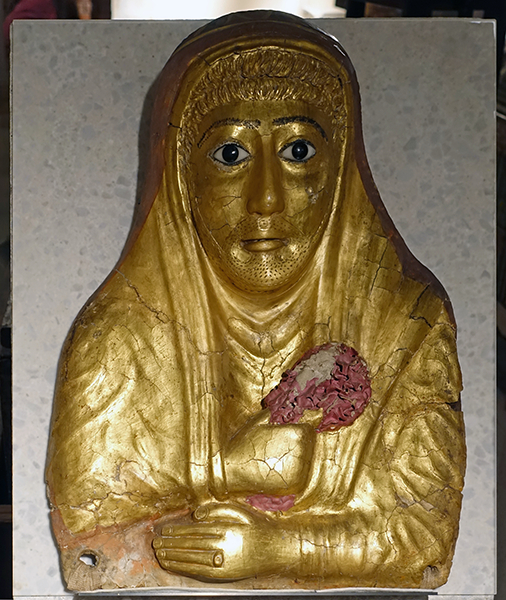
Roman Period: 30 BC - 395 AD
Husband of Aline
Family Burial: Mummy mask of the lady Aline's husband.
1st half of the 1st century AD.
Dimensions: 537 x 428 x 128 mm
The excavator Richard von Kaufmann does not give any details about the mummification of the man with the mask and since this body was also unwrapped on the spot in Egypt. Today only the mask itself remains. It was made of textile/cardboard, the stucco layer is provided in large parts with a gold coating. Two holes on the bottom of the mask bear witness to its original attachment to the body.
We can see a man with a full beard and two rows of curled strands of hair over his forehead. Both arms are bent and wrapped in a toga. Underneath he wears a tunic, a kind of long shirt. The cloth pulled over the head, a capite velato, or head covering, distinguishes the man as offering himself to the gods according to a Roman rite. His gesture can at the same time be understood as a humble attitude towards the gods to secure their goodwill. In his right hand he is holding a wreath or garland of rose petals.
The only jewellery is to be found on the ring finger of his left hand - a signet ring with an undecorated oval plate. Rings were among the most popular pieces of jewellery of the Romans. The ornate, expensive rings of the Roman men were often not only jewellery, but also had the purpose of sealing documents as a sign of authenticity. At this time, official documents were not provided with a signature, but sealed with the seal of the sender. This ring can be understood as an attribute of a man who belonged to the upper part of the bourgeois-aristocratic system.
The assumption that he is a person of high social status is reinforced by the intricately worked eyes: while the sclera and iris are made of white and black stone respectively, the eyelashes were made from carefully cut bronze sheet. Unlike other masks, however, the brows are not made of glass but painted black.
Catalog: Hawara: Textile, stuccoed, gilded, painted. Eye inlays white and black stone, eyelashes bronze (metal), ÄM 11414
Photo: Don Hitchcock 2018
Source: Original, Staatliche Museen zu Berlin, Neues Museum, Germany
Text: © Card at the Staatliche Museen zu Berlin, Jana Helmbold-Doyé at http://www.smb-digital.de/, (CC BY-NC-SA 3.0 DE)

Roman Period: 30 BC - 395 AD
Augustus (?)
Upper part of a statue of a king (Caesar Augustus / Octavian?) from the start of the Roman period.
Catalog: Granodiorite, ÄS 20
Photo: Don Hitchcock 2018
Source: Original, Ägyptischen Museum München
Text: Museum card, © Ägyptischen Museum München
Roman Period: 30 BC - 395 AD
Daughter of Aline
Family Burial: Mummies with painted portraits.
1st half of the 1st century AD, dimensions: 1035 x 310 x 240 mm.
The largest of the three mummies of children from the grave of the Aline is enclosed by a tape winding, which consists of uncoloured as well as reddish to brownish linen bandages. Two ends of the unstained bands were knotted on the left narrow side of the body, approximately at the level of the calf. The head and chest area is still today, as well as the feet, enclosed by textile cartons.
While the mask, which also embraces the upper body as in a bust, depicts a young woman, the investigation revealed that it is the mummy of a 6- to 7-year-old girl. The mask shows a well-fed, richly decorated young woman with her arms bent. This is elaborately painted and provided in the area of skin and jewellery with a gold coating. Her hairstyle consists of a long fringe and small three dimensionally worked curls on the temples. Her black hair leaves the ears free.
The woman wears a violet-coloured coat, which is pulled up over her head, and underneath a tunic with black strips of cloth, called clavi. In her right hand she holds a garland made of rose petals. Hedgehog earrings, a pearl necklace with a lunula pendant, two bracelets on the upper arms, two double-headed snake-bangles on the forearms and an oval signet ring on the little finger of the left hand can be seen as jewellery. The chest panel ends at the bottom with a colour guide and rosettes. On the top and the back of the mask is the goddess Nut in the form of a vulture, who spreads his wings protectively.
This list clearly indicates a rich and at the same time protected social position of the deceased. This impression is reinforced by the no less impressive shroud.
Catalog: Hawara: Mummy; Cardboard / textile; painted and partly gilded, ÄM 12125/6 (AE 12125/02 on the online catalog)
Photo: Don Hitchcock 2018
Source: Original, Staatliche Museen zu Berlin, Neues Museum, Germany
Text: © Card at the Staatliche Museen zu Berlin, Jana Helmbold-Doyé at http://www.smb-digital.de/, (CC BY-NC-SA 3.0 DE)
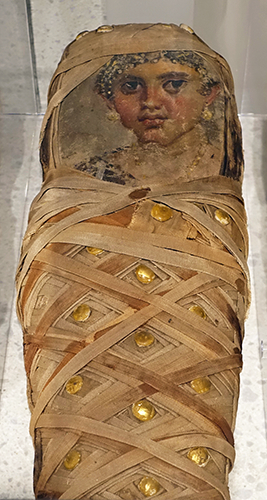
Roman Period: 30 BC - 395 AD
Daughter of Aline
Family Burial: Mummy of a human female child with painted portrait.
1st half of the 1st century AD, dimensions: 830 x 270 x 200 mm
Examination of the child's mummy using computer tomography (CT) revealed that the girl was at most four years old. Her body is carefully bound by a textile winding. In the diamond shapes so formed, stucco buttons are visible, which are covered with ochre painting and partially covered with gold foil.
On the mummy portrait, a serious-looking girl looks out at us from a colourfully executed face with cherubic round features. Her curly hair seems to be set back, while her temples and forehead are draped in a series of carefully arranged ringlets. She wears a dark brown tunic with a wide-cut rhomboid neck opening and white textile stripes, Clavi. Due to the poor state of preservation it is not clear whether there is a thin undergarment in pale pink underneath. The girl wears a laurel wreath in her hair, as well as golden hedgehog earrings and a golden chain on which a crescent-shaped pendant may be suspected.
Catalog: Hawara: Mummy; Textile, painted (tempera); Stucco, painted and partly gilded, ÄM 11412
Photo: Don Hitchcock 2018
Source: Original, Staatliche Museen zu Berlin, Neues Museum, Germany
Text: © Card at the Staatliche Museen zu Berlin, Jana Helmbold-Doyé at http://www.smb-digital.de/, (CC BY-NC-SA 3.0 DE)
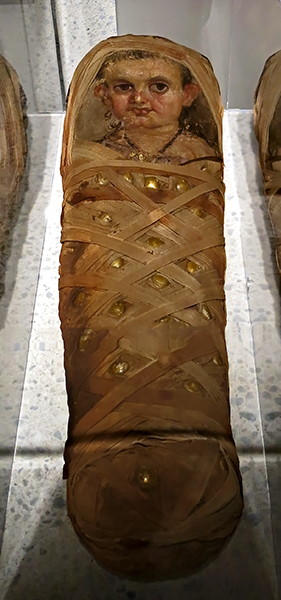
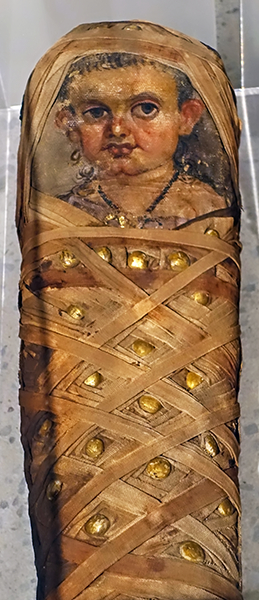
Roman Period: 30 BC - 395 AD
Child of Aline
Family Burial: Mummy of a human child with painted portrait.
1st half of the 1st century AD, dimensions: 780 x 230 x 220 mm
The portrait shows the chubby face of a child with curly dark hair, whose head is surrounded by a laurel wreath of golden leaves. So far, this mummy has been interpreted as the burial of a boy due to the location of the hands on the lower abdomen.
However, Barbara Borg and Cecilia Fluck have argued against the mummy portrayal as a boy with the following arguments: crescent-shaped pendants, lunulae, are apotropaic ( having the power to avert evil influences or bad luck - Don ) protective amulets derived from ancient Egyptian prototypes, which were supposed to protect women and girls and were therefore worn exclusively by them as pendants. Only very rarely are representations of boys depicted with a lunula. In this case it is a tripartite pendant whose outer elements depict lunulae, whereas the middle part is not clearly recognisable. Furthermore, attention is drawn to the lilac robe, which was also reserved solely for the female sex, and also the bared shoulder to emphasise the feminine charms and in reference to representations of the goddess of love Aphrodite.
All observations undoubtedly identify the portrait as being of a girl - a conclusion which is diametrically opposed by the results of the CT scans. The CT scans show that this is the mummy of a boy who is about 2½ years old.
Catalog: Hawara: Mummy; Textile, painted (tempera); Stucco, painted and partly gilded, ÄM 11413
Photo: Don Hitchcock 2015, 2018
Source: Original, Staatliche Museen zu Berlin, Neues Museum, Germany
Text: © Card at the Staatliche Museen zu Berlin, Jana Helmbold-Doyé at http://www.smb-digital.de/, (CC BY-NC-SA 3.0 DE)
Roman Period: 30 BC - 395 AD
Mummy of a child
Mummy of a four year old child, circa 80 AD.
Catalog: Organic material, wood, wax, linen, gold, Hawara, ÄS 1307
Photo: Don Hitchcock 2018
Source: Original, Ägyptischen Museum München
Text: Museum card, © Ägyptischen Museum München
Roman Period: 30 BC - 395 AD
Head of a priest
Head from the statue of a priest, first century AD.
Catalog: Quartzite, ÄS 6785
Photo: Don Hitchcock 2015, 2018
Source: Original, Ägyptischen Museum München
Text: Museum card, © Ägyptischen Museum München
Roman Period: 30 BC - 395 AD
Stela of Thaubastis
Stela of Thaubastis with three children, 1st - 2nd Century AD.
Catalog: Limestone, ÄS 5987
Photo: Don Hitchcock 2015
Source: Original, Ägyptischen Museum München
Text: © Ägyptischen Museum München
Roman Period: 30 BC - 395 AD
Figures of cats
Rectangular bronze container for mummified cat; two figures of cats on top, as well as a cat mummy wrapped in linen.
Length 153 mm (mummy case), length 106 mm (mummy), width 51 mm (mummy case)
Catalog: Linen, cat tissue, bronze, Saqqara (Memphis), EA22540
Photo: Don Hitchcock 2015
Source: Original, British Museum
Text: © Card with the display at the British Museum, http://www.britishmuseum.org/ , © Trustees of the British Museum, CC BY-NC-SA 4.0
Roman Period: 30 BC - 395 AD
Mummy case for a fish
Wooden container for a mummified fish in the form of a hawk-headed fish; one black glass eye remains.
Length 280 mm.
Catalog: Painted wood, Saqqara (Memphis), EA36169
Photo: Don Hitchcock 2018
Source: Original, British Museum
Text: Card with the display at the British Museum, https://www.britishmuseum.org/, © Trustees of the British Museum, CC BY-NC-SA 4.0

Roman Period: 30 BC - 395 AD
Mummified Kitten
Mummified kitten wrapped in linen.
Height 228 mm.
Catalog: Linen, cat tissue, EA11134
Photo: Don Hitchcock 2018
Source: Original, British Museum
Text: Card with the display at the British Museum, https://www.britishmuseum.org/, © Trustees of the British Museum, CC BY-NC-SA 4.0

Roman Period: 30 BC - 395 AD
Mummified Cat
Mummy of an adult cat. The hind legs are pushed up against the pelvis and the forelegs drawn down the body. The skeleton appears to be complete with no signs of trauma, and there is soft tissue present. The wrappings, consisting of narrow strips of linen of light and dark brown, have been skilfully arranged so as to form a repeating lozenge pattern. The facial features have been modelled with applied buttons of coarse linen for the eyes and the corners of the mouth have been internally padded to give a raised appearance. The mouth and whiskers are further represented by linen threads, and the eyes and mouth have been emphasised with brown paint.
Height 510 mm.
Catalog: Linen, cat tissue, EA6752
Photo: Don Hitchcock 2018
Source: Original, British Museum
Text: Card with the display at the British Museum, https://www.britishmuseum.org/, © Trustees of the British Museum, CC BY-NC-SA 4.0
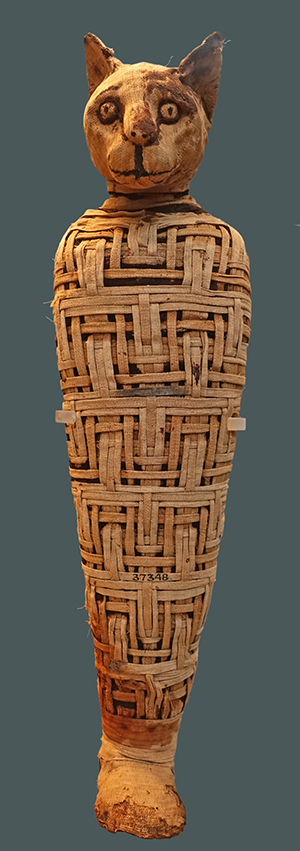
Roman Period: 30 BC - 395 AD
Mummified Cat
Mummy of a cat. Linen wrappings arranged in a geometric pattern.
Height 460 mm.
Catalog: Linen, cat tissue, Abydos, EA37348
Photo: Don Hitchcock 2018
Source: Original, British Museum
Text: Card with the display at the British Museum, https://www.britishmuseum.org/, © Trustees of the British Museum, CC BY-NC-SA 4.0
Stone table
Stone table used for the purification of mummies of Apis bulls, Memphis, after 600 BC.
Mummies of sacred bulls
Burials of sacred bulls have been found at several sites in Egypt. They were usually interred in large stone-built tombs. The most elaborate of these are the burials of the Apis bulls at Saqqara, in the extensive underground complex known as the Serapeum. The bulls were mummified and buried in massive stone sarcophagi. Their trappings included jewellery, amulets, and even shabti figures to work for their owners in the afterlife.
The embalming of the Apis bull was a heavily ritualised process, based closely on the procedures for human mummification. A demotic papyrus in Vienna preserves the details of the ritual, and the stone tables on which mummification was carried out have been found at Memphis.
Similar treatment was accorded to the bulls of Buchis at Armant. Their tombs, dating to the Ptolemaic and Roman periods, were excavated by Robert Mond and Oliver Myers for the Egypt Exploration Society in the 1930s. A large number of the mummies were discovered intact, together with their burial equipment and associated cult objects including funerary stelae, offering tables and ritual vessels.
Rephotography: Don Hitchcock 2018
Source: Poster, British Museum
Text: Poster with the display at the British Museum, https://www.britishmuseum.org/, © Trustees of the British Museum, CC BY-NC-SA 4.0
Roman Period: 30 BC - 395 AD
Mummified Bull
Mummy of a young bull
Height 457 mm, length 737 mm.
Linen wrappings, laid in a geometric pattern on the chest, and with false eyes.
Catalog: Linen, bull tissue, Thebes, EA6773
Photo: Don Hitchcock 2018, 2015
Source: Original, British Museum
Text: Card with the display at the British Museum, https://www.britishmuseum.org/, © Trustees of the British Museum, CC BY-NC-SA 4.0
Roman Period: 30 BC - 395 AD
Scarab
A rectangular wooden box for a scarab beetle, with the figure of a scarab on top.
Length 50 mm, width 28 mm.
Catalog: Wood, EA36155
Photo: Don Hitchcock 2015
Source: Original, British Museum
Text: Card with the display at the British Museum, https://www.britishmuseum.org/, © Trustees of the British Museum, CC BY-NC-SA 4.0
Additional text: www.metmuseum.org/
Roman Period: 30 BC - 395 AD
Temple Relief
This piece is labelled on the museum card as:
Temple relief: Pharaoh offering before the divine couple Geb and Nut.
( The figure on the left of the image appears to be wearing a version of the Deshret, the Red Crown of lower Egypt, with part of it resembling the Atef Crown of Osiris, and holds an ankh and a was-sceptre, a stylised animal head at the top of a long, straight staff with a forked end. The was-sceptre was associated with ancient Egyptian deities, as well as with the Pharaoh.
The figure on the right of the image appears to be male, wearing a wig and a kilt, and is offering with both hands. On the register above him are two empty cartouches, a common occurrence at the Temple of Dendera - Don )
Catalog: Sandstone, Dendera, early first century AD, Gl. 85
Photo: Don Hitchcock 2018
Source: Original, Ägyptischen Museum München
Text: © Ägyptischen Museum München

Roman Period: 30 BC - 395 AD
Seated Figure
Seated figure in a long tunic, a piece of cloth in hand, first - third century AD.
Catalog: Limestone, ÄS 6766
Photo: Don Hitchcock 2015
Source: Original, Ägyptischen Museum München
Text: Museum card, © Ägyptischen Museum München
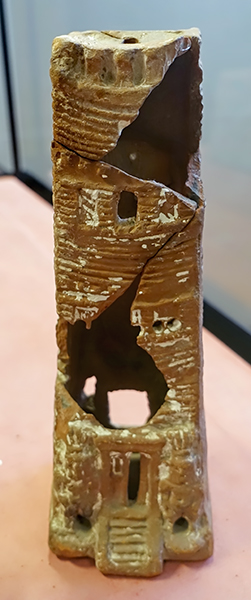
Roman Period: 30 BC - 395 AD
Lamp
House model, used as a lamp. Two images of Bes standing on either side of a doorway preceded by a staircase.
Height 245 mm, width 84 mm, thickness 85 mm.
Catalog: Terracotta, E 32572
Location: Aile Sully, Salle 331 - La maison et le mobilier, Vitrine 3
Photo: Don Hitchcock 2018
Source and text: Original, Louvre Museum, https://collections.louvre.fr/
Roman Period: 30 BC - 395 AD
Obelisk
Obelisk of Titus Sextius Africanus
Circa 50 AD.
In Egypt, obelisks - usually set up in pairs flanking temple entrances - were erected in honour of the sun god, often on the occasion of a regnal jubilee. Augustus had had the first obelisks brought over to Rome and set up in the Circus Maximus as monuments to his recent victory over Egypt. Later, obelisks were used to decorate sanctuaries to Egyptian gods in Rome. When supply failed to meet demand, obelisks began to be made in Rome itself.
The inscription on this obelisk names a certain Titus Sextius Africanus, a prefect in Egypt in the year 59 AD. Its original location in ancient Rome is unknown. Around 1775 it was moved to the Villa Albani, after the sculptor Paolo Cavaceppi had restored the top and bottom of the original centre stone. Brought to Paris in 1797 by Napoleon, as loot from his Italian campaign, it was erected there as part of a monument to general Desaix at the Place des Victoires. The future King Ludwig I - still only crown prince at the time - bought the obelisk in 1815. From 1830 up until the second world war it was displayed in the Egyptian Hall of the Glyptothek. From 1972 to 2007 it marked the entrance to the Egyptian Museum's previous location in the Munich Residence.
Catalog: Rose granite, Rome, Gl. WAF 39
Photo: Don Hitchcock 2018
Source: Original, Ägyptischen Museum München
Text: Museum card, © Ägyptischen Museum München
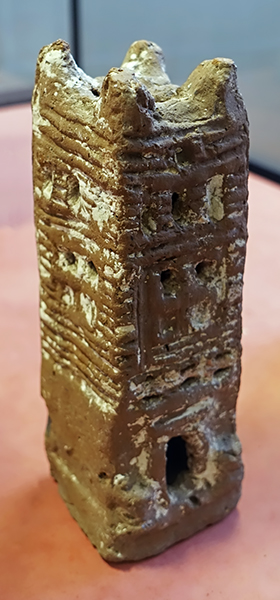
Roman Period: 30 BC - 395 AD
Model of a house
Height 200 mm.
Catalog: Terracotta, E 11886
Location: Aile Sully, Salle 331 - La maison et le mobilier, Vitrine 3
Photo: Don Hitchcock 2018
Source and text: Original, Louvre Museum, https://collections.louvre.fr/
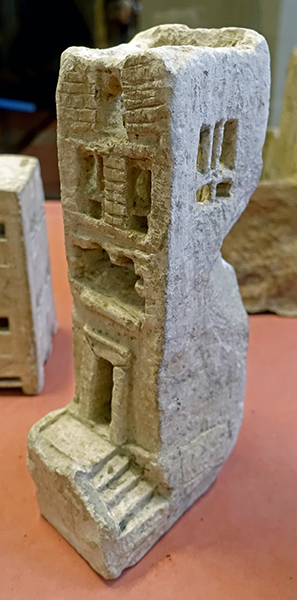
Roman Period: 30 BC - 395 AD
Model of a house
Height 275 mm.
Catalog: Limestone, E 11885
Location: Aile Sully, Salle 331 - La maison et le mobilier, Vitrine 3
Photo: Don Hitchcock 2018
Source and text: Original, Louvre Museum, https://collections.louvre.fr/
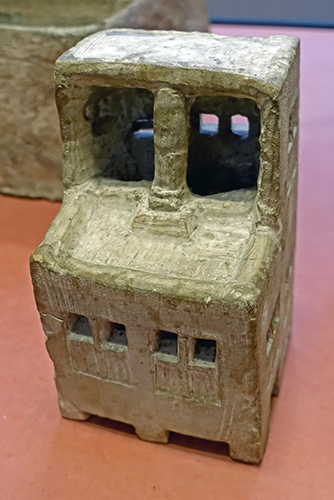
Roman Period: 30 BC - 395 AD
Model of a house
This is a three-storey house.
Workshops on the ground floor, above that are reception rooms, and above that again, private rooms and a terrace.
Height 170 mm, width 110 mm, thickness 107 mm.
Catalog: Limestone, E 5357
Location: Aile Sully, Salle 331 - La maison et le mobilier, Vitrine 3
Photo: Don Hitchcock 2018
Source and text: Original, Louvre Museum, https://collections.louvre.fr/
Roman Period: 30 BC - 395 AD
Vessels
(left) Alabaster vessel with large hole in one side. (The ring of 37168 was inside this with one faience blue disk bead and one faience blue ring bead).
Height 141 mm, diameter 20 mm, Accession Number LDUCE-UC37174
(centre) Alabaster vessel with one large and two smaller holes in the lower part, Accession Number LDUCE-UC37098
(right) Alabaster vessel, two pieces joined, with section of shoulder and part of rim missing, from Kafr Ammar, Grave 99.
Length 13 mm, diameter 62 mm, LDUCE-UC37097.
Photo: Don Hitchcock 2018
Source: Original, Petrie Museum, London, England
Text: Card / online catalogue, the Petrie Museum, © 2015 UCL. CC BY-NC-SA license.
Roman Period: 30 BC - 395 AD
Jewellery
1. Gold Necklace
Gold necklace of nine flat hollow beads decorated, as well as two gold tubular beads and fifty small gold ring beads.
From Kafr Ammar, Grave 99.
length 277 mm, bead length 16 mm, bead width 8 mm, string length 325 mm, Accession Number LDUCE-UC37095
2. Gold Ring
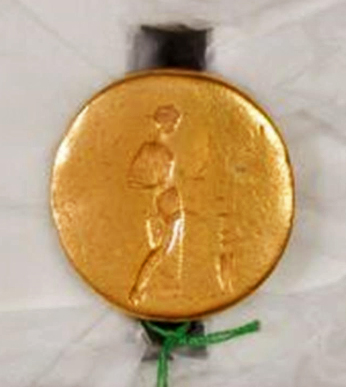
Gold finger ring with large circular bezel with incised female figure in draped robe.
From Kafr Ammar tomb 99, Tomb 99.
Length 23 mm, height 20 mm, Accession Number LDUCE-UC8707.
Photo: © 2017 University College London. Licensed under CC BY-NC-SA licence
Source: Original, Petrie Museum, London, England
Text: Card / online catalogue, the Petrie Museum, © 2015 UCL. CC BY-NC-SA license.
3. Bead
White stone barrel bead with large hole, on silver wire.
From Kafr Ammar, Grave 99.
Length 18 mm, width 17 mm, Accession Number LDUCE-UC37096.
3. Beads
Faience, double-ring beads of white, blue, black and yellow glaze. Original stringing (?).
From Kafr Ammar, Accession Number LDUCE-UC37175.
4. Ivory disk
Ivory disk pierced in centre, plain on the back, with four incised rings. Repair or adaptation to the central hole can be seen from the remains of a shaft of the same material, perhaps spindle remains?
From Kafr Ammar tomb 99, Tomb 99.
Diameter 29 mm, weight 3 gm, Accession Number LDUCE-UC37101.
Photo: Don Hitchcock 2018
Source: Original, Petrie Museum, London, England
Text: Card / online catalogue, the Petrie Museum, © 2015 UCL. CC BY-NC-SA license.
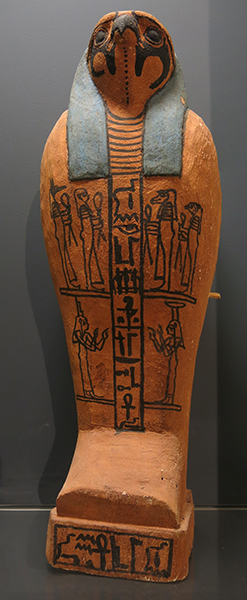
Roman Period: 30 BC - 395 AD
Falcon head, Osiris
Miniature sarcophagus, falcon head with a shroud, Usekh collar.
Decoration, first register: 4 sons of Horus.
Second register: Isis (standing, with the sign of Isis), Nephthys (standing, with the sign of Nephthys).
( note that by this time the standard of workmanship had fallen dramatically. The paintings are no better than outlines, just rough drafts, and the hieroglyphs are poorly delineated. Isis and Nephthys are barely recognisable, and the headdress/sign of Nephthys is incomplete. - Don )
![]()

Hieroglyphs for Isis and Nephthys.
Height 600 mm, width 220 mm, thickness 190 mm.
Catalog: Wood, painted, Tehneh = Akoris, east bank Middle Egypt, Aile Sully, Room 323, Crypt of Osiris, Vitrine 6, E 12181
Photo and Hieroglyphs: Don Hitchcock 2015, 2021
Hieroglyphs redrawn after Budge (1920)
Source and text: Original, Louvre Museum, Paris, France, https://collections.louvre.fr/
Roman period: 30 BC - 395 AD
Mummy mask of Pasyg
(included here for an explanation of the Masque-Plastron-Dosseret convention)
This and similar masks can be divided into three sections:
•Masque, or mask, usually moulded in three dimensions.
•Plastron, or bib, often mostly flat.
•Dosseret, a projection back from the mask, forming a kind of helmet.
Many were found at Touna el-Gebel. They were attached to the mummy with cords or thin strips of fabric.
In the first century, they were in parallel with the chest, but later in the second and third centuries AD they were placed almost at right angles to the chest, perhaps symbolising the rebirth of the deceased.
Photot: Don Hitchcock 2015
Source: Original, Staatliche Museen zu Berlin, Neues Museum, Germany
Text adapted from http://jfbradu.free.fr/egypte/LA%20RELIGION/LE%20SARCOPHAGE/masques-plastron.php3

Roman Period: 30 BC - 395 AD
Pasyg
Mummy mask of Pasyg, also known as Pa-remet-syg.
Circa 1st century AD.
Mummy mask of Pa-remet-syg with Demotic* inscription.
Dimensions: 420 x 310 x 560 mm.
This mummy mask belongs to a group of objects from the middle Egyptian cemetery of Meir. It depicts a young man whose elaborately designed mask captivates with its colourful splendour and its richness in detail. There are numerous protective divine beings and symbols. Thus, the back is dominated by a ba souls bird, which stretches out its arms and wings. On both sides are gods accompanied by the goddesses Isis and Nephthys.
Mention should also be made of the insert at chest height on the front, which shows a crouching Ibis on a neb sign, or basket.
![]() The nebet hieroglyph portrayed the concept of two words that sounded identical. Neb, 'all' and neb, 'lord' or 'master'. The glyph was used interchangably to represent these concepts. The hieroglyph for the basket was the outline of a bowl, which approximated the appearance of Egyptian wicker baskets. The hieroglyph was often painted yellow or green to match the colour of the plants (rushes, palm leaves and grasses) used to make them. More detailed images of the symbol showed horizontal lines or a checkerboard pattern to give the appearance of basket weaving.
The nebet hieroglyph portrayed the concept of two words that sounded identical. Neb, 'all' and neb, 'lord' or 'master'. The glyph was used interchangably to represent these concepts. The hieroglyph for the basket was the outline of a bowl, which approximated the appearance of Egyptian wicker baskets. The hieroglyph was often painted yellow or green to match the colour of the plants (rushes, palm leaves and grasses) used to make them. More detailed images of the symbol showed horizontal lines or a checkerboard pattern to give the appearance of basket weaving.
The Ibis is a manifestation of the (now) mobile dead and therefore their godlike nature.
( Note that this mask, VÄGM 1989/111, appears to be the inner mask of Pa-remet-syg, with the head of the mummy inside it, with the outer mask shown below, ÄM 34436, fitting over the top of the inner mask - Don )
* The mask of Pa-remet-syg (Greek form Promsiko) is the only one from Meir which shows the name of the owner on the back, as well as the name of his father Pshentahe in Demotic script form, that is in 'letter writing' form, written and read from right to left, while earlier hieroglyphics could be written from top to bottom, left to right, or right to left.
Catalog: Textile (material / cardboard); primed, painted, partially gilded; Glass (inlays), Meir, VÄGM 1989/111
Photo: (at top, left and right) Don Hitchcock 2018
Photo: (below) © Margarete Büsing, http://www.smb-digital.de/, (CC BY-NC-SA 3.0 DE)
Source: Original, Staatliche Museen zu Berlin, Neues Museum, Germany
Text: © Card at the Staatliche Museen zu Berlin, Jana Helmbold-Doyé at http://www.smb-digital.de/, (CC BY-NC-SA 3.0 DE)
Additional text: Wikipedia, http://www.egyptianmyths.net/basket.htm
Roman Period: 30 BC - 395 AD
Pasyg
Mummy mask of Pasyg, also recorded as Aischines or Aischynes in Greek. Aischines was also the name of a famous orator from Athens, who lived in the 4th Century BC.
Circa 1st century AD.
Both these names, Pasyg and Aischines, have a root referring to physical weakness, while his father is probably called Malakos, meaning mild or effeminate, and was known in Egyptian as Pashertaihet, and in Greek as Psentaes, literally 'the son of a cow', or 'coward'. The individuals in the Meir burials operated comfortably in a bilingual society, including Greek and Egyptian names (Riggs 2006).
( note that the online catalog lists this mummy mask as being of an unknown man, while the museum card records it as being of the man Pasyg - Don )
Dimensions: 500 x 300 x 550 mm (including base)
The mummy mask shows a young, beardless man with hair in ringlets, which can be seen on the forehead under the coloured headscarf. The cloth is formed in the shape of an Egyptian triangular wig, on the front of which are depicted jackals, representations of the god Anubis, as well as eight Uraeus, the stylized, upright form of an Egyptian cobra, used as a symbol of sovereignty, royalty, deity and divine authority in ancient Egypt.
In the middle is a broad necklace, a neck or shoulder collar, under which a scarab protects its wings, shown here as separate from the body of the scarab. Around the back of the head there is a frieze with the four Horus sons, Amset, Duamutef, Hapi and Kebechsenuf, sacrificed before the central-dominating god Horus. Horus, as Lord of Heaven, appears in a falcon shape with a sun-disc. In the brief hieroglyphic inscriptions, the gods are named, but neither the title nor name of the deceased, to whose grave the mask belonged, is shown.
( Note that this mask, ÄM 34436, appears to be the outer mask of Pa-remet-syg, fitting over the top of the inner mask, VÄGM 1989/111, shown above - Don )
Catalog: Textile (material / cardboard); primed, painted, partially gilded, Meir, ÄM 34436
Photo: (top left and right, bottom left) Don Hitchcock 2018
Photo: (bottom right) © Margarete Büsing, http://www.smb-digital.de/, (CC BY-NC-SA 3.0 DE)
Source: Original, Staatliche Museen zu Berlin, Neues Museum, Germany
Text: © Card at the Staatliche Museen zu Berlin, Jana Helmbold-Doyé at http://www.smb-digital.de/, (CC BY-NC-SA 3.0 DE)
Additional text: Wikipedia

Roman Period: 30 BC - 395 AD
Mask of a woman
Mummy mask of a woman with a rose petal wreath
Circa 1st century AD, of the Masque-Plastron-Dosseret form.
Textile (material / cardboard); primed, painted, partially gilded; Flax fibers (hair); Faience (inlays)
Dimensions: 530 x 370 x 590 mm (incl. Base)
The Berlin Museum presents a total of four mummy masks from the early Roman Empire, all of which originate from the central Egyptian town of Meir. This example is the mask of a wealthy woman, who is lavishly decorated with jewellery.
She wears earrings, two necklaces, finger rings, and bracelets. New research has shown that the curly hair was imitated from black coloured flax. On the hair there is also a wide hair wreath, which has, in addition to colourfully painted leaves of rose petals, a centrally positioned oval medallion.
She is clad in the Roman fashion with a dark red chiton, on which bands (clavi) are to be seen in gold-studded dark green. In addition, the back of the head is surrounded by a frieze depicting Egyptian gods. The central figure shows the god Osiris, approached on both sides in a procession of gods, with the deceased at the rear.
Catalog: Meir: plaster and linen, ÄM 34434
Photo: Don Hitchcock 2018
Source: Original, Staatliche Museen zu Berlin, Neues Museum, Germany
Text: © Card at the Staatliche Museen zu Berlin, Jana Helmbold-Doyé, at http://www.smb-digital.de/, (CC BY-NC-SA 3.0 DE)
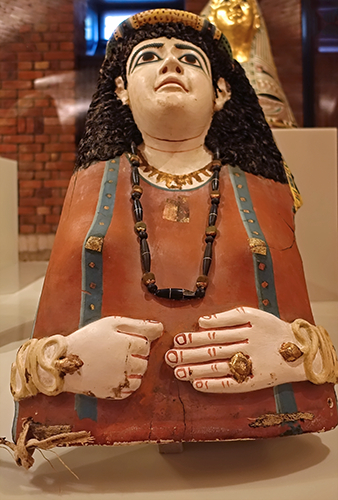
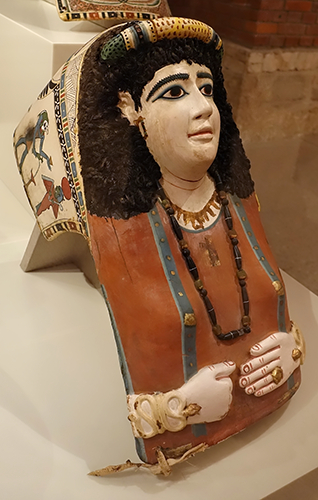
Roman Period: 30 BC - 395 AD
Mask of a woman
Mummy mask of a woman with bracelets in the form of snakes.
Circa 1st century AD.
Textile (material / cardboard); primed, painted, partially gilded; Flax fibers (hair); Faience (inlays)
Dimensions: 520 x 360 x 570 mm (incl. Base)
Masks such as these typically come from Roman graves in Central Egyptian Meir. Although the woman is unknown, she was in the upper class, since a funeral with a mask of this kind was granted only to wealthy people.
We can see that the woman has the pale complexion preferred by the Romans instead of the darker skin common in Egypt. Fittingly, the elegant presentation of her clothes, jewellery and hairstyle shows the Roman fashions of her time. Protective amulets include the snake bracelets and the lunula pendant found on the shorter necklace. These crescent-shaped pendants, lunulae, are apotropaic (supposedly having the power to avert evil influences or bad luck) amulets derived from ancient Egyptian prototypes, which specifically protect women and girls and were therefore worn exclusively by them.
Her black curly hair was imitated with dyed flax and adorned with a simple hair ring made of different plants. At the top and the back of the mask is the soulbird Ba, who spreads his wings protectively, shown with a female head and a bird's body. On both sides, on cloth strips, gods sacrifice, burn incense and pour water into a bowl on a high stand.
Catalog: Meir: plaster and linen, ÄM 34435
Photo: Don Hitchcock 2018
Source: Original, Staatliche Museen zu Berlin, Neues Museum, Germany
Text: © Card at the Staatliche Museen zu Berlin, Jana Helmbold-Doyé, at http://www.smb-digital.de/, (CC BY-NC-SA 3.0 DE)
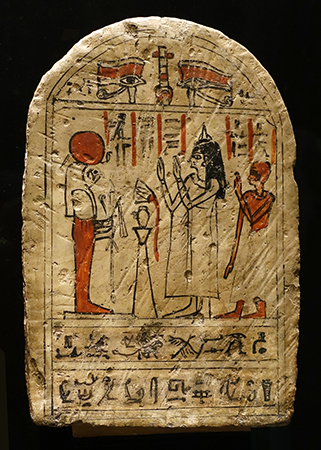
Roman period: 30 BC - 395 AD
Tjereri
Stela of Tjereri, for the god Re-Horakhty.
Circa 1st - 2nd century AD.
( Note that this stela has been painted only, not carved as a relief - Don )
Catalog: Limestone, Abydos (?), ÄS 47
Photo: Don Hitchcock 2018
Source: Original, Ägyptischen Museum München
Text: Museum card, © Ägyptischen Museum München
Roman period: 30 BC - 395 AD
Masque-plastron and dosseret
Mask and bib and dosseret of the deceased.
Painted and gilded wood, 200 AD - 299 AD
Masque-Plastron-Dosseret of a woman with a bib, West Hermopolis (Touna el-Gebel) 3rd century AD Wood stuccoed and painted, gold leaf.
The deceased, dressed in a purple tunic, wears numerous jewels, and in gold, two bracelets, three rings, two necklaces and earrings. All around the head, at the junction with the dosseret, were twenty-six painted wooden uraei, five of which are still in place.
In this case, the head was at right angles to the bib/chest.
Height 575 mm, length 840 mm, width 290 mm.
Catalog: Wood, gilded, inlaid eyes, painted, Touna el-Gebel, Middle Egypt, E 12167
Location: Aile Denon, Salle 183, Egyptian funerary art, Vitrine 22.
Photo (left): Don Hitchcock 2015
Museum photo (right): three quarters face © 2012 Louvre Museum / Georges Poncet, https://collections.louvre.fr/ark:/53355/cl010017883
Source and text: Original, Louvre Museum, https://collections.louvre.fr/
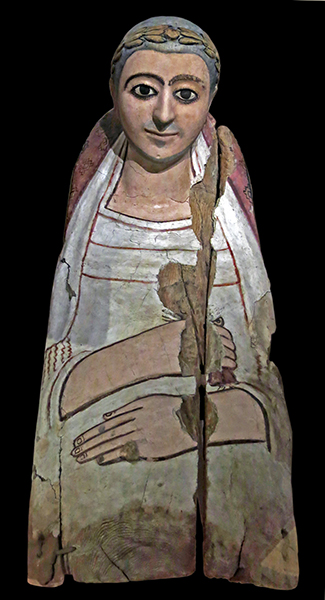
Roman period: 30 BC - 395 AD
Masque-Plastron and Dosseret
Circa 200 AD - 299 AD
The old man wore a tunic, fringed shawl, a crown of foliage, beard, collar, moustache, ring.
Height 510 mm, length 700 mm, width 290 mm.
Catalog: Fig wood, stuccoed and painted and gilded plaster, Touna el-Gebel, Middle Egypt, E 12170,
E 12174 E 12175 F
Location: Aile Denon, Salle 183, Egyptian funerary art, Vitrine 12.
Photo: Don Hitchcock 2015
Source and text: Original, Louvre Museum, https://collections.louvre.fr/

Roman period: 30 BC - 395 AD
Masque-Plastron and Dosseret
Circa 200 AD - 299 AD
The man had short hair, a crown of foliage, a beard, necklace, earrings, ring, tunic, and a fringed shawl.
Height 475 mm, length 730 mm, width 310 mm.
Catalog: Wood, stucco, painting, gilding, Touna el-Gebel, Middle Egypt,
E 12177
Location: Aile Denon, Salle 183, Egyptian funerary art, Vitrine 22.
Photo: Don Hitchcock 2015
Source and text: Original, Louvre Museum, https://collections.louvre.fr/
Roman period: 30 BC - 395 AD
Masque-Plastron, Dosseret and Shroud
Circa 100 AD - 149 AD
_______________
( Note that the Masque-Plastron, Dosseret and Shroud are the only parts that have survived. The rest of the coffin has been simulated in order to display the ensemble effectively - Don )
_______________
Masque-Plastron and Dosseret:
A young man with short curly hair, a beard, nemes hairstyle, holding an ankh sign.
Height 320 mm, length 615 mm, width 500 mm.
_______________
Shroud:
Behedety (hawk, sun disk, wings outstretched). To the right: reception of the dead, ilustration: weighing of the heart. To the left: series of deities (standing, in front) ba-bird, chadouf. On the feet: Nut (standing, holding a hes vase), ba-bird. Under the feet: Osiris (shroud, atef crown)
Length 1372 mm, width 455 mm.
_______________
Catalog: Gilding, inlay, painting, agglomerated and stuccoed fabric (inlaid glass eyes), Touna el-Gebel, Middle Egypt,
E 32634 A (Masque-Plastron and Dosseret), E 32634 B (Shroud)
Location: Aile Denon, Salle 183, Egyptian funerary art, Vitrine 22.
Photo: Don Hitchcock 2015
Source and text: Original, Louvre Museum, https://collections.louvre.fr/
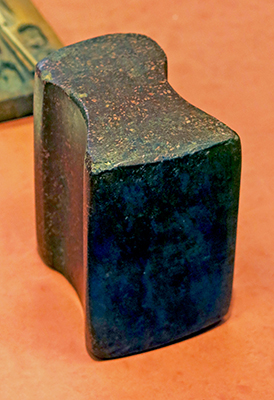
Roman period: 30 BC - 395 AD
Crusher
Height 90 mm, length 101 mm, width 64 mm.
A porphyry tool used to crush blue pigment.
Catalog: porphyry, Esna / Latopolis, N 3032, Thédenat-Duvent n° 58, Denon n° 264
Location: Aile Sully, Salle 335, Writing and the scribes, Vitrine 2
Photo: Don Hitchcock 2015
Source and text: Original, Louvre Museum, https://collections.louvre.fr/
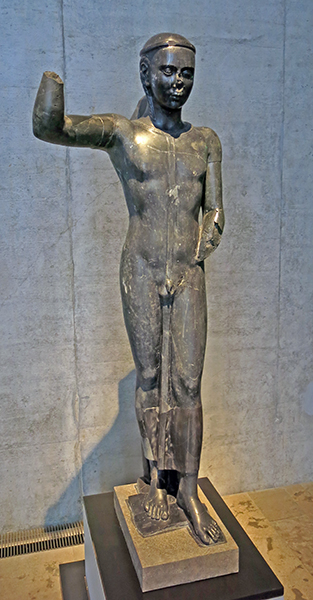
Roman period: 30 BC - 395 AD
The God Min
Standing - striding figure of the god Min, circa 130 AD.
Catalog: Marmor, Villa Hadriana (Tivoli) Gl.WAF 32
Photo: Don Hitchcock 2015
Source: Original, Ägyptischen Museum München
Text: Museum card, © Ägyptischen Museum München
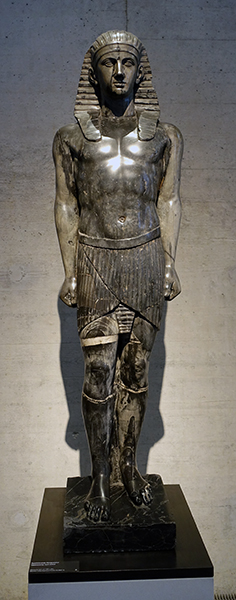
Roman period: 30 BC - 395 AD
Royal Statue
Royal statue from the Roman period, but in the Egyptian style, circa 135 AD.
Catalog: Marmor, Villa Hadriana (Tivoli) Gl.WAF 14
Photo: Don Hitchcock 2018
Source: Original, Ägyptischen Museum München
Text: Museum card, © Ägyptischen Museum München
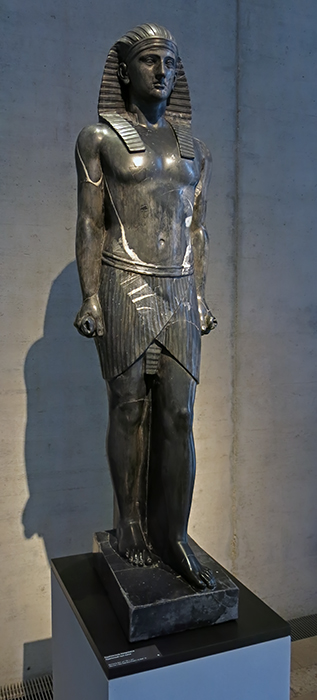
Roman period: 30 BC - 395 AD
Royal Statue
Royal statue from the Roman period, but in the Egyptian style, circa 135 AD.
Catalog: Marmor, Villa Hadriana (Tivoli) Gl.WAF 15
Photo: Don Hitchcock 2015
Source: Original, Ägyptischen Museum München
Text: Museum card, © Ägyptischen Museum München
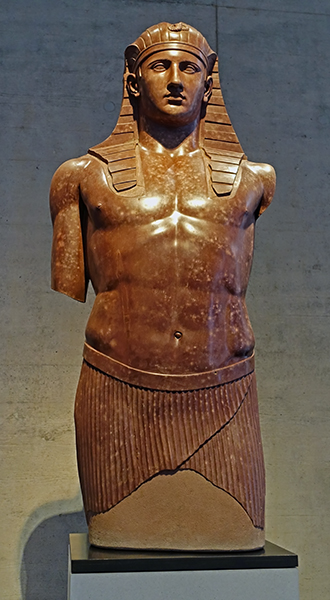
Roman period: 30 BC - 395 AD
Antinous
Egyptianised standing-striding figure of Antinous, a favourite of Emperor Hadrian, circa 135 AD.
Catalog: Marmor, Villa Hadriana (Tivoli) Gl.WAF 24
Photo: Don Hitchcock 2015
Source: Original, Ägyptischen Museum München
Text: Museum card, © Ägyptischen Museum München
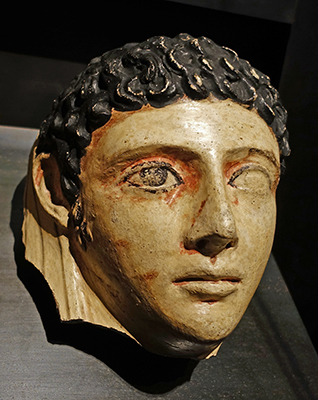
Roman Period: 30 BC - 395 AD
Mummy mask
Mummy mask of a young man, 2nd century AD.
Catalog: Plaster, painted, ÄS 13
Photo: Don Hitchcock 2018
Source: Original, Ägyptischen Museum München
Text: Museum card, © Ägyptischen Museum München
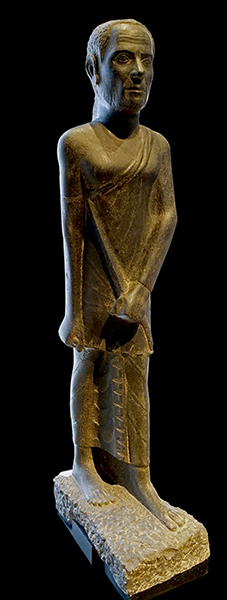
Roman period: 30 BC - 395 AD
Old Man
Standing - striding figure of an old man, circa 1st - 2nd century AD.
Catalog: Granite, Alexandria, Gl.23
Photo: Don Hitchcock 2018
Source: Original, Ägyptischen Museum München
Text: Museum card, © Ägyptischen Museum München
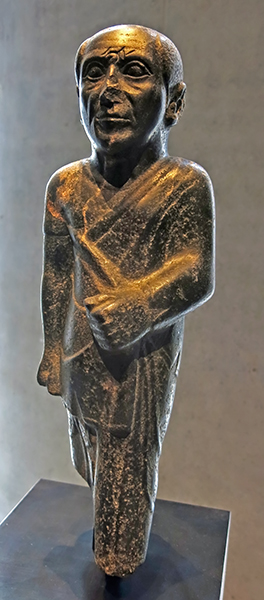
Roman period: 30 BC - 395 AD
Priest
Standing - striding figure of a priest with aged features, around the turn of the first century AD.
Catalog: Gabbro, ÄS 22
Photo: Don Hitchcock 2015
Source: Original, Ägyptischen Museum München
Text: Museum card, © Ägyptischen Museum München
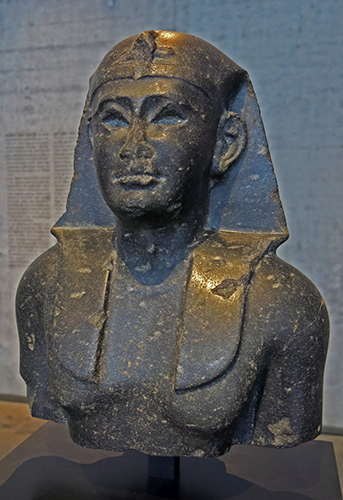
Roman period: 30 BC - 395 AD
Upper part of a statue of a king (Augustus?)
Catalog: Granodiorite, ÄS 20
Photo: Don Hitchcock 2015
Source: Original, Ägyptischen Museum München
Text: Museum card, © Ägyptischen Museum München
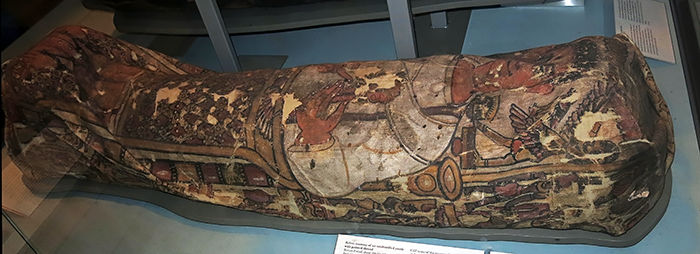
Roman Period: 30 BC - 395 AD
Mummy with shroud
Mummy of an unidentified youth with painted shroud.
Roman period, about 200 - 250 AD, Probably from Thebes / Luxor.
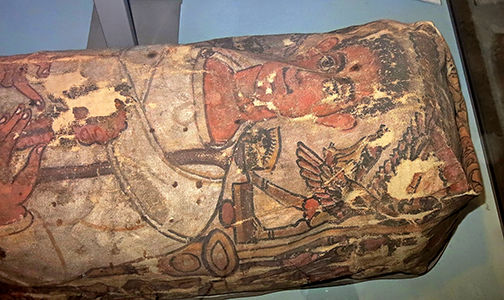
Roman Period: 30 BC - 395 AD
Mummy with shroud
During the Roman period, the outer shroud frequently bore a full-length painted figure of the deceased in classical dress. This example, painted in tempera, depicts the dead man holding a garland of rosebuds and a sprig of myrtle.
Below the waist is an 'apron' decorated with a winged solar disc and a rhomboidal bead-net pattern: the ties of this apron extend to the shoulders. To each side of the central figure are scenes relating to burial and resurrection, drawn from both Egyptian and Roman sources.

Roman Period: 30 BC - 395 AD
Mummy with shroud
CAT scans of the mummy show that the skeleton is in excellent condition. The arms are placed at the sides, and the head is slightly flexed forward, a position observed in a number of mummies of this period. Scans also show that a section of wooden pole had been used by the embalmers to support the spinal portion of the body. The state of fusion of the long bones suggests that the young man died in late adolescence, in agreement with the appearance of the portrait on the shroud.
The mummy is loosely bandaged and wrapped in a linen shroud, ornamented with a tempera painted portrait. The skull has all teeth present. There are no obvious fractures. The thorax and abdomen are apparently empty. There are no fractures or dislocations of the ribs, spinal column, pelvis, or hips. The lumbar and dorsal intervertebral discs appear opaque. The arms are extended. The hands with extended fingers are in contact with the outer aspect of the thighs. In the legs, there is a crack fracture in the medial part of the lower end of the right tibia. The menisci are opaque. There are no lines of arrested growth.
Catalog: EA6709
Photo (upper two): Don Hitchcock 2015
Photo (lowest, at left): © Trustees of the British Museum
Source: Original, British Museum
Text: http://www.britishmuseum.org/, © Trustees of the British Museum
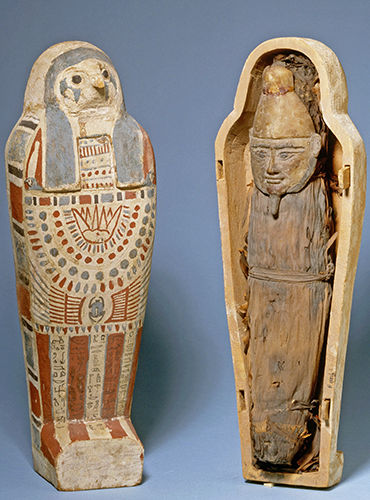
Roman Period: 30 BC - 395 AD
Corn mummy
Corn mummy from Tuna el-Gebel, the necropolis of Khmun, Hermopolis Magna, located in Middle Egypt.
0 - 200 AD, Roman period, 50 cm.
Sycomore fig wood, earth, grain
Ficus sycomorus grows to 20 metres tall and 6 metres wide, grown in rich soils along rivers and in mixed woodlands. The fruit is a large and edible fig, 2-3 cm in diameter. It was the ancient Egyptian Tree of Life. It was widely cultivated in ancient Egypt.
Photo: https://www.google.com/culturalinstitute/asset-viewer/mummy-of-corn/SgG5mTcdSCntYg?projectId=art-project
Text: http://www.rmo.nl/collectie/-topstukken-/?1273
Roman Period: 30 BC - 395 AD.
Crocodile
Mummy mask for a crocodile with traces of the mummy wrappings inside, first - second century AD
Catalog: Stucco, linen, glass, ÄS 6809
Photo: Don Hitchcock 2018
Source: Original, Ägyptischen Museum München
Text: Museum card, © Ägyptischen Museum München
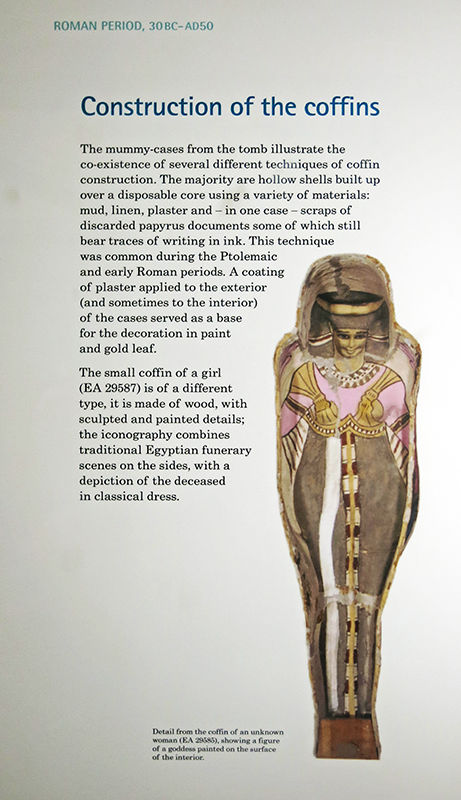
Roman Period: 30 BC - 395 AD
Construction of the coffins
Roman Period, 30 BC - 50 AD
The mummy-cases from the tomb illustrate the coexistence of several different techniques of coffin construction. The majority are hollow shells built up over a disposable core using a variety of materials: mud, linen, plaster and - in one case - scraps of discarded papyrus documents some of which still bear traces of writing in ink. This technique was common during the Ptolemaic and early Roman periods. A coating of plaster applied to the exterior (and sometimes to the interior) of the cases served as a base for the decoration in paint and gold leaf.
The small coffin of a girl (EA29587) is of a different type, it is made of wood, with sculpted and painted details; the iconography combines traditional Egyptian funerary scenes on the sides, with a depiction of the deceased in classical dress.
Catalog: EA29585
Photo: Poster at the British Museum, © Trustees of the British Museum
Rephotography: Don Hitchcock 2015

Roman Period: 30 BC - 395 AD
Mummy of a young man
Mummy of a young man, Roman period, after 30 BC. Provenance unknown.
The arrangement of the outer bandages of this mummy in a rhomboidal pattern was a fashion introduced about the 26th Dynasty (664 BC - 525 BC) and became common during the Ptolemaic and Roman periods. Such wrapping is sometimes associated with a gilded cartonnage mask, body plaques and sandals (as here), or with a plaster head or portrait panel.
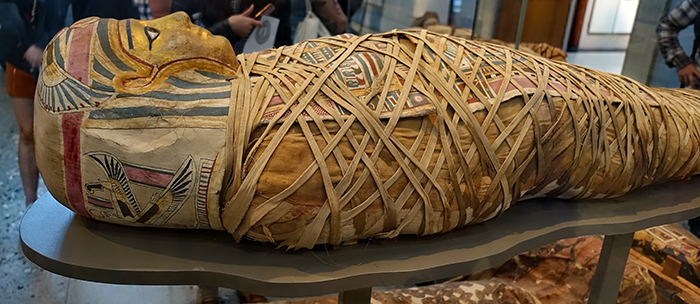
Roman Period: 30 BC - 395 AD
Mummy of a young man
CAT scans show that the body is that of a young man who died aged no more than 21-23 years. The skeleton is in good anatomical condition but sections of the spine are missing. The arms are crossed on the chest, and the skull appears to be empty. Linen packing is visible in the abdominal area, but it is uncertain whether or not this material contains the internal organs.
Catalog: EA2400
Photo: Don Hitchcock 2015, 2018
Source: Original, British Museum
Text: Card at museum display © Trustees of the British Museum

Roman Period: 30 BC - 395 AD
Mummy of a young man
Further information about EA2400:
Rectangular wooden coffin with a cornice around the top; containing the mummy of a man aged 20-21, name unknown.
Skull - The head and chest are covered by a cartonnage mask with a gilded face, the artificial eyes of which and the eyebrows are outlined in dark blue glass, with protective deities at the sides of the head and funerary deities represented on the lappets of the wig. Mouth partly open. All teeth present. The cervical spine is widely dislocated at the level of the 4th vertebra, and the 5th is lying loose in the neck. The 6th and 7th cervical vertebrae are in normal anatomical relationship with the dorsal spine.
Thorax and Abdomen - Covered by a painted cartonnage pectoral, decorated with a winged solar disc with uraei and a vignette, showing Anubis mummifying the deceased, flanked by Isis and Nephthys, beneath. There is linen packing in the left upper zone of the thorax, and also in the pelvis and abdomen. The 5th, 6th, 7th, and 12th dorsal vertebrae are missing; the remaining dorsal vertebrae and lumbar spine appear normal.
The upper four ribs on both sides are normal; all the rest are dislocated at their costo-vertebral articulations, and are lying haphazardly, but not fractured. The pelvis and hips appear normal. Iliac epiphyses not quite fused, hence inference of age. The penis is bandaged separately.
Arms - flexed at the elbows, forearms crossed over the breast, right over left, hands on shoulders. Legs - Faint lines of arrested growth at lower ends of tibiae, otherwise no joint or bone lesion. Many fragments of the linen mummy-wrappings, removed during restoration in September 1970, are now stored separately.
Photo: © Trustees of the British Museum
Text: http://www.britishmuseum.org/ © Trustees of the British Museum
Roman Period: 30 BC - 395 AD
Man from Akhmim
Mummy of an unidentified man, from Akhmim, 169 cm long.
Late Ptolemaic or Roman period, 1st century BC - 1st century AD.
The outer wrappings of this mummy have been coated with a thick layer of a black resinous substance, perhaps bitumen. Over this are placed elaborate coverings made of painted and gilded cartonnage.
These consist of a mask, with a winged scarab beetle and solar disc on the top of the head; a body-cover incorporating a collar, and decorated with figures of various deities including Osiris and the sky-goddess Nut; and a footcase with sandals elaborately modelled in a twisted and gilded linen.
Photo: Don Hitchcock 2015
Source: Original, British Museum
Text: Card at museum display, © Trustees of the British Museum
Roman Period: 30 BC - 395 AD
Man from Akhmim
X-rays of the body show that the arms are fully extended. The skeleton, that of an adult man of robust build, appears to be in good condition. A dense packing material, perhaps sand or mud, is visible within the thoracic and abdominal cavities.
Mummy of a heavily built adult man, name unknown. The body is enclosed in a cartonnage cover of separate pieces. There is a gilded and painted cartonnage mummy-mask and open-work covers for body and feet. The mummy is thickly coated with a black resinous substance, resembling pitch.
Skull - Mouth slightly open. No obvious fractures. There is a fairly dense lobulated mass within the skull. The cervical spine appears to be intact.
Thorax and Abdomen - The cavities are filled with sand, mud, or some dense amorphous material. No fractures in ribs, spinal column, pelvis, or hips.
Arms - Extended. Hands with extended fingers, the palmar surface in contact with the outer aspect of the thighs.
Legs - No fractures, dislocations, or lines of arrested growth.
Catalog: EA29782
Photo: Don Hitchcock 2015
Source: Original, British Museum
Text: Card at museum display, http://www.britishmuseum.org/, © Trustees of the British Museum
Text: http://www.britishmuseum.org/, © Trustees of the British Museum
Roman Period: 30 BC - 395 AD
Man from Akhmim
Catalog: EA29782
Photo: Don Hitchcock 2018
Source: Original, British Museum
Text: Card at museum display, © Trustees of the British Museum

Roman Period: 30 BC - 395 AD
Man from Akhmim
The base (under the feet) is also gilded.
Catalog: EA29782
Photo: Don Hitchcock 2018
Source: Original, British Museum
Text: Card at museum display, http://www.britishmuseum.org/, © Trustees of the British Museum
Text: http://www.britishmuseum.org/, © Trustees of the British Museum
Roman Period: 30 BC - 395 AD
Soter
Base-board and cover of the wooden coffin of Soter (Saviour), son of Cornelius Pollius and Archon of Thebes / Luxor, with polychrome painted and gilded decoration and inscriptions.
Roman Period, circa 100 - 120 AD, from Sheikh Abd el-Qurna, tomb 32 (probably), Thebes / Luxor.
Length 213 cm, width 77 cm.
The base board is rectangular, originally joined to the cover by mortise and tenon joints, decorated with a full-length representation of Nut, with laden fruit tree behind, shown with eight long tresses, in Greek style, and wearing a chaplet of red flowers, wearing a floral collar, necklace, chain with pendants and snake-bracelets, with representations of Isis and Nephthys, in mourning, on each side of head, with a vertical register of hieroglyphs, containing an invocation to the goddess, down the centre of the body, traces of a black resinous substance adhere in places.
The interior of the vaulted cover is decorated with another representation of Nut, with hands raised above head, surrounded by the twelve signs of the zodiac, arranged anti-clockwise, and, on the left side, the twelve hours of the night and, on the right, the twelve hours of the day, and is inscribed in places.
Catalog: EA6705
Photo (left): Don Hitchcock 2015
Photo (right): © Trustees of the British Museum
Source: Original, British Museum
Text: Card with the display at the British Museum, http://www.britishmuseum.org/, © Trustees of the British Museum

Roman Period: 30 BC - 395 AD
Soter
Coffin of Soter.
This shows the exterior of the coffin above.
Catalog: EA6705
Photo: Don Hitchcock 2015
Source: Original, British Museum
Text: Card with the display at the British Museum, © Trustees of the British Museum
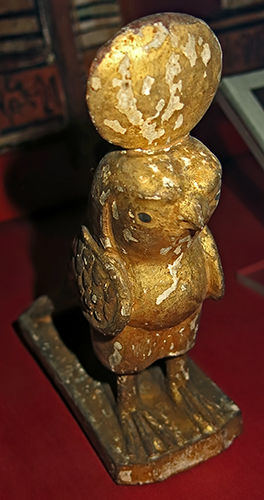
Roman Period: 30 BC - 395 AD
Gilded wooden falcon
Gilded wooden falcon from the lid of the coffin of Soter.
The statuette was placed in the centre of the lid, where a slot was cut to accommodate it.
Catalog: EA6705
Photo: Don Hitchcock 2015
Source: Original, British Museum
Text: Card with the display at the British Museum, © Trustees of the British Museum
Roman Period: 30 BC - 395 AD
Figure of a hawk
The exterior is decorated with funerary deities and architectural motifs. A gilded and painted wooden figure of a hawk, crowned with solar disc, which would have surmounted the lid, also survives, as shown above. The slot in the centre of the lid which accepted the hawk may be seen in this photograph.
Catalog: EA6705
Photo: Don Hitchcock 2015
Source: Original, British Museum
Text: Card with the display at the British Museum, © Trustees of the British Museum
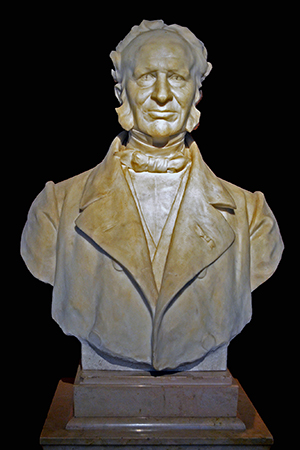
Frédéric Cailliaud was an explorer and scientist from Nantes in France, who spent seven years in Egypt, where he rediscovered Roman-era emerald mines and explored the Eastern and Western Deserts. His crowning discovery came when he ventured south of the present-day border of Sudan and Ethiopia and rediscovered Meroë, the capital city of the ancient kingdom of Kush.
Calliaud acquired the coffin and mummy of Petamenophis (Padiimenipet) and sent them to the Bibliotheque Nationale in 1823.
Photo: Selbymay
Permission: Creative Commons Attribution-Share Alike 3.0 Unported license
Text: adapted from https://archive.aramcoworld.com/issue/201301/the.explorations.of.fr.d.ric.cailliaud.htm
Additional text: Wikipedia
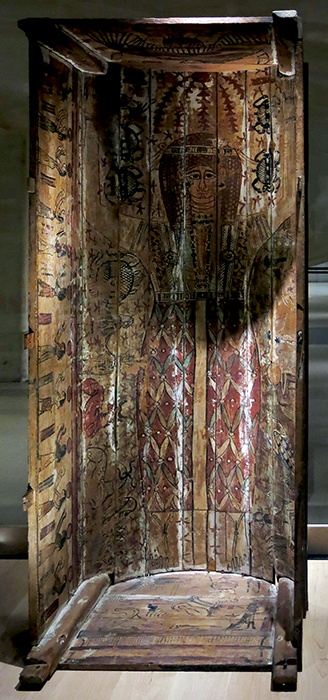
Roman period: 30 BC - 395 AD
Padiimenipet
Padiimenipet (Petamenophis), son of Soter, died 2nd June 116 AD at the age of 21.
Shown is his rectangular coffin with corner posts.
Inscriptions: Cleopatra (mother), Soter (father), Cornelius Pollion, (grandfather),
( during the reign of Emperor ) Trajan.
On the inside is an image of the goddess Nut, arms raised, with images of scarabs, and images of the Egyptian zodiac. This theme can be seen more clearly in the image of the interior of Soter's coffin, above.
Height 700 mm, length 2010 mm, width 810 mm.
Catalog: Painted wood, TT 32 Djehoutymes, Khokha, Thebes West, E 13048, CM 33
Location: Aile Denon, Salle 183, Egyptian funerary art, Vitrine 6
Photo: Don Hitchcock 2015
Source and text: Original, Louvre Museum, https://collections.louvre.fr/
Additional text: Wikipedia
Roman period: 30 BC - 395 AD
Padiimenipet
Padiimenipet (Petamenophis), son of Soter, died 2nd June 116 AD at the age of 21.
Drawing of the mummy of Petamenophis / Padiimenipet by F. Cailliaud.
Location: Aile Denon, Salle 183, Egyptian funerary art
Drawing: Poster, Louvre Museum
Rephotography: Don Hitchcock 2015
Source and text: Louvre Museum, https://collections.louvre.fr/
( A good monograph by Christina Riggs on The Coffins of the Soter Family and the Temple of Deir el-Medina may be found at:
https://www.ifao.egnet.net/bifao/106/14/
- Don )
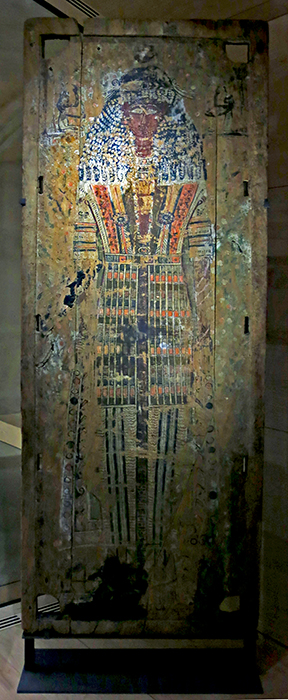
Roman period: 30 BC - 395 AD
Padiimenipet
Padiimenipet (Petamenophis), son of Soter, died 2nd June 116 AD at the age of 21.
Shown is his coffin floor.
Height 48 mm, length 2140 mm, width 850 mm.
Catalog: Painted wood, TT 32 Djehoutymes, Khokha, Thebes West, E 13016, CM 1
Location: Aile Denon, Salle 183, Egyptian funerary art, Vitrine 6
Photo: Don Hitchcock 2015
Source and text: Original, Louvre Museum, https://collections.louvre.fr/
Additional text: Wikipedia

Roman period: 30 BC - 395 AD
Funerary crown
Padiimenipet (Petamenophis), son of Soter, died 2nd June 116 AD at the age of 21.
Shown is his funerary crown. which was placed on the mummy, diameter 335 mm.
The circumference of the crown, with decorations, was 1380 mm. It evokes the myrtle wreath that was placed on the head of the dead to pay a last tribute in Greek rituals. The crowns were, more generally, signs of social importance.
( Either the diameter or the circumference is in error. π x 335 ≈ 1052 mm! - Don )
Catalog: Gilded wood, copper, and rushes, TT 32 Djehoutymes, Khokha, Thebes West, E 13417, CM 399
Location: Aile Denon, Salle 183, Egyptian funerary art, Vitrine 6
Photo: Don Hitchcock 2015
Source and text: Original, Louvre Museum, https://collections.louvre.fr/
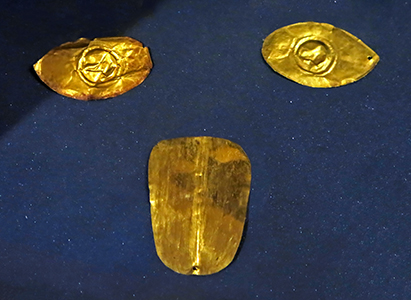
Roman period: 30 BC - 395 AD
Gold plates
Three gold plates showing a tongue and open eyes were found on the face of Petamenophis to symbolically ensure the return and eternal functioning of the deceased's senses.
Thus, he could argue before the court of Osiris.
E 4924 (left): Eye, embossed gold leaf, length 30 mm, width 19 mm, thickness 0.5 mm.
E 4928 (right): Eye, embossed gold leaf, length 31 mm, width: 19 mm, thickness 0.1 mm.
( I suspect that this thickness is either a complete typo or possibly meant to be 1 mm - Don )
E 4925 (centre): Tongue, embossed gold leaf, length 26 mm, width: 18 mm, thickness 0.7 mm.
Catalog: Gold, Tomb TT32, Sheikh abd el-Gourna, Thebes, E 4924, E 4925, E 4928
Location: Aile Denon, Salle 183, Egyptian funerary art, Vitrine 6
Photo: Don Hitchcock 2015
Source and text: Original, Louvre Museum, https://collections.louvre.fr/
Roman Period: 30 BC - 395 AD
Tphous
Base board and vaulted cover of the sycomore fig wood coffin of Tphous, daughter of Heraclius Soter and Serapous, from Sheikh Abd el-Qurna, Thebes / Luxor, dated to the Roman Period, circa 100 - 120 AD, probably from Tomb 32.
The base board is rectangular and there are four corner posts. The gable ends are decorated with painted scarabs and winged solar discs with rearing uraei (serpents), with registers of hieroglyphs and one panel of Greek inscription, the latter records that Tphous died aged 6 years, 8 months and 2 days in the reign of Hadrian, and was interred in the family tomb some 10 months later.
On each side of the coffin the dead girl, accompanied by Anubis, is shown in the presence of Osiris with, on one side, the Apis bull and Ra-Horakhty and, on the other, two of the Sons of Horus, behind.
Below a solar barque is towed by three jackals, joined by a snake. The rest of the surface is decorated with funerary deities, inscriptions and other decorative motifs.
Catalog: EA6708
Photo: Don Hitchcock 2015
Source: Original, British Museum
Text: Card with the display at the British Museum, http://www.britishmuseum.org/, © Trustees of the British Museum
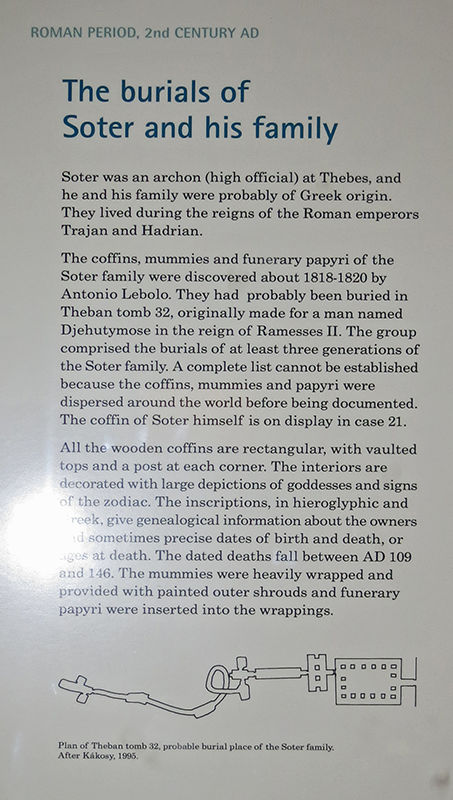
Roman Period: 30 BC - 395 AD
Soter and his family
The burials of Soter and his family.
Soter was an archon (high official) at Thebes / Luxor, and he and his family were probably of Greek origin. They lived during the reigns of the Roman emperors Trajan and Hadrian.
The coffins, mummies and funerary papyri of the Soter family were discovered about 1818 - 1820 by Antonio Lebolo. They had probably been buried in Theban tomb 32, originally made for a man named Djehutymose in the reign of Ramesses II. The group comprised the burials of at least three generations of the Soter family. A complete list cannot be established because the coffins, mummies and papyri were dispersed around the world before being documented. The coffin of Soter himself is on display in case 21.
All the wooden coffins are rectangular, with vaulted tops and a post at each corner. The interiors are decorated with large depictions of godesses and signs of the zodiac. The inscriptions, in hieroglyphic and Greek, give general genealogical information about the owners and sometimes precise dates of birth and death, or ages at death. The dated deaths fall between AD 109 and AD 146. The mummies were heavily wrapped and provided with painted outer shrouds and funerary papyri were inserted into the wrappings.
Photo: Poster, British Museum
Rephotography: Don Hitchcock 2015
Text: Poster, British Museum © Trustees of the British Museum
Diagram on poster: after Kákosy (1995)
Roman Period: 30 BC - 395 AD
Daughter of Candace, named Cleopatra
Polychrome painted wooden base-board and vaulted cover of the coffin of the daughter of Candace, Cleopatra, who died at the age of eleven years, decorated and inscribed. Candace is known to have been the wife of Soter.
Roman Period, circa 100 - 120 AD, from Sheikh Abd el-Qurna, probably tomb 32, Thebes / Luxor.
The base-board is rectangular and decorated with with a full-length representation of Nut with stylised tree behind, Nut's shoulders are flanked by representations of Isis and Nephthys in mourning, each with a standing female attendant or funerary deity, who holds a crown aloft.
Couchant jackals, seated upon shrines, are shown on either side of Nut's feet, and a large deposit of black resin, with scraps of linen adhering, marks the outline of the mummy, now displayed elsewhere.
The lid is vaulted with four corner posts and gable sections decorated in a pseudo-architectural style. The interior is also decorated with a representation of Nut, surrounded by the twelve signs of the zodiac arranged clockwise with, on the left side, the twelve hours of the day and, on the right the twelve hours of the night. The exterior is decorated with registers of polychrome painted funerary deities and other decorative motifs.
Length 1845 mm (baseboard), width 750 mm (baseboard), height 100 mm (baseboard), length: 1780 mm (lid), width 660 mm (lid), height 680 mm (lid), height: 700 mm (combined lid and baseboard)
Catalog: EA6706
Photo: Don Hitchcock 2015
Source: Original, British Museum
Text: Card with the display at the British Museum, http://www.britishmuseum.org/, © Trustees of the British Museum
Roman period: 30 BC - 395 AD
Daughter of Candace, named Cleopatra
The exterior is decorated with typical Egyptian scenes, including the weighing of the heart before Osiris, and guardian-deities of the gates of the underworld. The interior decoration is similar to that of the coffin of Soter. A large figure of the goddess Nut occupies the centre, with radiating sun disc and the sun-god as falcon above her head, and the Apis bull at her feet.
Catalog: EA6706
Photo: Don Hitchcock 2015
Source: Original, British Museum
Text: Card with the display at the British Museum, © Trustees of the British Museum
Roman period: 30 BC - 395 AD
Daughter of Candace, named Cleopatra
Goddesses personifying the hours of day and night are painted along the sides, and the spaces between these figures and that of Nut are occupied by the signs of the zodiac.
Catalog: EA6706
Photo: © Trustees of the British Museum
Source: Original, British Museum
Text: Card with the display at the British Museum, © Trustees of the British Museum
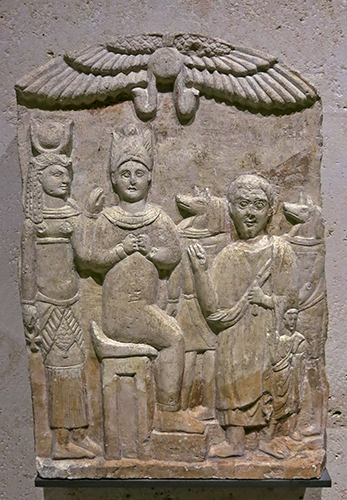
Roman period: 30 BC - 395 AD
Funerary Stele
The stele, decorated with a winged solar disc with two uraei in its arch, depicts an Egyptian scene of the introduction of the deceased before the god Osiris and the goddess Isis.
This Egyptian iconography is mixed with elements of Greek-Roman tradition, particularly in the attitude and dress of the deceased.
Osiris is seated on a throne, Isis is standing, wearing the headdress of Hathor over that of a vulture.
( The deceased is accompanied by two images of Anubis, who guide the dead to Osiris - Don )
3rd quarter of the 1st century AD.
Height 560 mm, width 400 mm, thickness 80 mm.
Catalog: Limestone, Abydos, El-Araba el-Madfouna, N 146, AF 75, Drovetti n° 341
Location: Aile Denon, Salle 183, Egyptian funerary art, Vitrine 13
Photo: Don Hitchcock 2015
Source and text: Original, Louvre Museum, https://collections.louvre.fr/
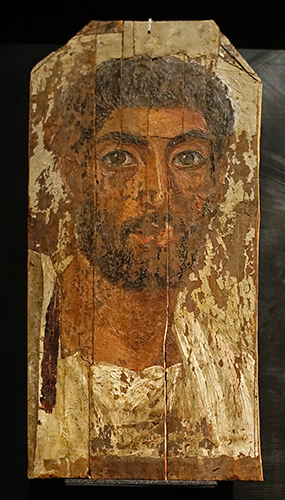
Roman Period: 30 BC - 395 AD
Mummy Portrait
Mummy portrait of a young man, 2nd century AD.
Catalog: Wood, painted, El-Rubajat, ÄS 5
Photo: Don Hitchcock 2018
Source: Original, Ägyptischen Museum München
Text: Museum card, © Ägyptischen Museum München
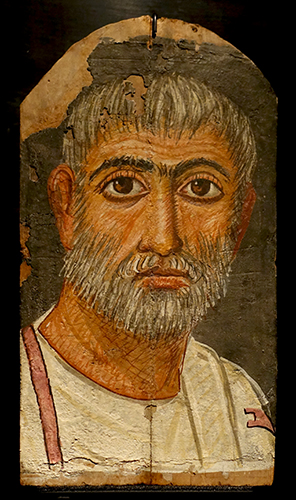
Roman Period: 30 BC - 395 AD
Mummy Portrait
Mummy portrait of an old man, 2nd century AD.
Catalog: Wood, stucco, painted, El-Rubajat, ÄS 3
Photo: Don Hitchcock 2018
Source: Original, Ägyptischen Museum München
Text: Museum card, © Ägyptischen Museum München
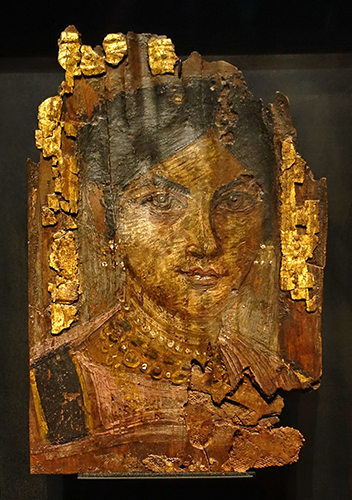
Roman Period: 30 BC - 395 AD
Mummy Portrait
Mummy portrait of a woman, 2nd century AD.
( This portrait of a beautiful young woman shows her with many necklaces, pearl ear-pendants, and a broad collar - Don )
Catalog: Wood, painted, gilded, Hawara, ÄS 2972
Photo: Don Hitchcock 2018
Source: Original, Ägyptischen Museum München
Text: Museum card, © Ägyptischen Museum München
Additional text: Wikipedia

Roman period: 30 BC - 395 AD
Funerary Stele
This stele gathers together many symbols of rebirth of the deceased, whether they are related to the solar cycle or to Osiris. In the upper register, the deceased represented as Osiris is surrounded by Anubis and a falcon-headed god, probably Horus.
In the second register, the mummy is shown in a boat, on the way to the tomb. In the lower register, two canids carry the emblems of Osiris, the crook heka and the flail nekhekha.
( The two canines in the lower register are beautifully rendered. At the sides, two very long Uraei twine around the framework provided by lotus flowers on very long stems, whereby the talented artist lifts the design of this stele above the ordinary - Don )
Height 700 mm, width 460 mm, thickness 70 mm.
Catalog: Limestone, Abydos, El-Araba el-Madfouna, N 145, Salt n° 3700
Location: Aile Denon, Salle 183, Egyptian funerary art, Vitrine 13
Photo: Don Hitchcock 2015
Source and text: Original, Louvre Museum, https://collections.louvre.fr/
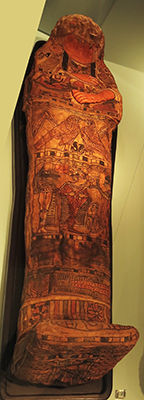
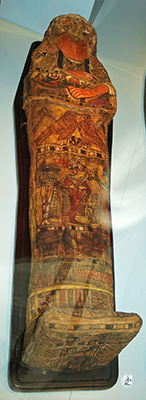
Roman period: 30 BC - 395 AD
Mummy of a boy
The images on the body show that the artist was not skilled in traditional Egyptian art.
Mummy, linen, plaster; location Oxyrynchus (?) ca 0 - 100 AD. Roman Imperial Period.
This mummy, a teenager from el-Behnasa near the oasis Fayoem, bears all the traditional elements of decoration. But certain elements of it show that these were no longer properly understood. Even the bad proportions of the painted figures and fake hieroglyphs give the impression of an extinct culture. Only the survival of the ancient religion kept these forms alive. Soon the rise of Christianity helped to put it to an end.
This mummy shows us a final flowering of the entire repertoire of Egyptian funerary art. Unfortunately, the origin of this piece is not known with certainty. According to the sellers the mummy came from just south of Fayoem at el-Behnasa. In Roman times, this was the thriving county town of Oxyrhynchos, named after a species of fish of the Nile River which was important in Egyptian mythology as the fish that ate the penis of Osiris. Of the city itself, with its pillar lined main streets, numerous temples (but also two Christian churches and a synagogue), theatre, gymnasium and badge building there is now almost nothing left. The tomb buildings of the notables of the city, were mausoleums whose walls were adorned with almost life-size statues of the deceased have been lost due to vandalism and modern construction. Only the loose grave images can still be found in many museum collections.
Excavations in the ruins of the city by the English archaeologists Grenfell and Hunt between 1897 and 1907 led to thousands of papyrus fragments to light. As a result, we can despite all the devastation still obtain a very good picture of life in the Romano-Egyptian city.
Although Egypt had been ruled at the time for about five hundred years by the Greeks and Romans, still the majority of the urban population regarded themselves as pure Egyptian. Only the elite of the city was Greek or Roman, even if their way of life is not substantially different from that of the native population. This way of life was characterised by a subtle blending of Egyptian and Hellenistic elements. In addition to the Greek Zeus and the Roman Jupiter the Egyptian Serapis was also worshiped in the temples of the city.
Especially in the funeral rites, many ancient traditions were still maintained.
According to radiological examination this is the mummy of a child aged from 13 to 15 years old. The mummy is entirely wrapped in resin soaked linen. Over the face is a mask strapped with linen bands. The mask consists of several layers of linen with stucco, in which the face and hands are moulded in relief. Over the abdomen is a large piece of linen, while the legs and feet are packed in some loose pieces. The entire surface is painted with traditional Egyptian motifs. The face, which is severely damaged, was pink in colour. Around the back is a pattern of large wings showing that the head is protected. Furthermore, the head and upper body are presented as if they were shrouded in a cloak. The embossed pink hands come out from its folds. In the right hand, the dead holds a twig, or possibly a bunch of emmer wheat, a well-known symbol of the promise of life after death. The left hand holds a folded flower garland, which expresses the hope that the dead will be declared righteous in the Judgement of the Dead by the gods of the afterlife.
The rest of the decoration is arranged in horizontal sections, which are separated from each other by bands of coloured blocks. On either side of the head kneel the goddesses Isis and Nephthys, while the jackal god Anubis is seated behind. Protecting the neck are two falcon figures, with behind each on the one hand is the god Osiris, on the other is Anubis.
On the chest can be seen Anubis watching over a painted representation of the mummy, in a stereotypical manner. Strangely, the mummy lies in a boat with high arched bow and stern, which itself stands on a bier in the form of a standing lion. Below some Canopic jars are seen (which were no longer used at this time). On the far left is a god with a falcon, and on the right a mummy with the head of Qebehsenuef, the Son of Horus. In the preparation of mummies, his canopic jar was used for the intestines.
Under the left arm of the boy is a sphinx with a falcon's head, a god figure that we see more often depicted in the art of this time. The belly of the dead is protected by two falcons standing under a sky with stars, probably representations of the sun god Re-Harakhty.
The panel below shows a woman's figure offering a sacrifice of incense to the gods Osiris and Anubis. Perhaps this woman is the deceased himself, even though the skeletal remains appear to be rather that of a boy. The alternative is to see this figure as Isis. Two sphinxes repelling evil lie underneath, while these panels are framed around by djed pillars. The feet are in painted sandals, between which a key of life, an ankh, is shown. On the soles is an ornamental bow, with the crown of Isis between grid patterns. Ties with ornamental rosettes and striped friezes keep these components in place.
Ostensibly here there is still a complete mastery of the Egyptian funerary symbolism. However, details such as the boat on the bier, or unidentifiable genii, betray the lack of genuine understanding. Noteworthy also are the bad proportions of the various figures and text panels written with fake hieroglyphics in various scenes. Egyptian art was at this time dying. Only the survival of the ancient religious beliefs justified its survival in a changing society, until the spread of Christianity ended it completely.
Photo: Don Hitchcock 2014
Source: Original, Rijksmuseum van Oudheden, National Museum of Antiquities, Leiden.
Additional text: http://www.rmo.nl/onderwijs/museumkennis/verhalen/mummie-uit-de-romeinse-tijd

Roman period: 30 BC - 395 AD
Coffin
Coffin of wood and a mummy cover of wood and plaster, circa 50 AD, possibly from Faijum.
Catalog: Faijum? Ägyptisches museum, Inv. No VAGM 1983/16
Photo: Don Hitchcock 2015
Source: Original, Staatliche Museen zu Berlin, Neues Museum, Germany
Text: © Card at the Staatliche Museen zu Berlin/
Roman period: 30 BC - 395 AD
Coffin
Closeup of the head of the sarcophagus.
Catalog: Faijum? Ägyptisches museum, Inv. No VAGM 1983/16
Photo: Don Hitchcock 2015
Source: Original, Staatliche Museen zu Berlin, Neues Museum, Germany
Text: © Card at the Staatliche Museen zu Berlin
Roman period: 30 BC - 395 AD
Coffin
Original label in the museum:
Sarkophag Sarcophagus
Sarg mit der Darstellung des ägyptischen Jenseit gerichte und Mumienhülle Holz,
Gips; um 50 n. Chr; Faijum ? (ET); Ägyptisches Museum, Inv.-Nr. VAGM 1983/16
Erworben vom Verein zur Förderung des Ägyptischen Museums e.V.
Catalog: Faijum? Ägyptisches museum, Inv. No VAGM 1983/16
Photo: Don Hitchcock 2015
Source: Original, Staatliche Museen zu Berlin, Neues Museum, Germany
Text: © Card at the Staatliche Museen zu Berlin
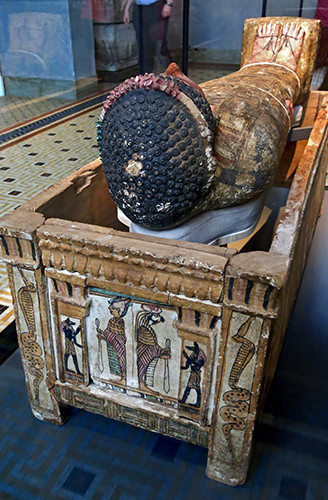
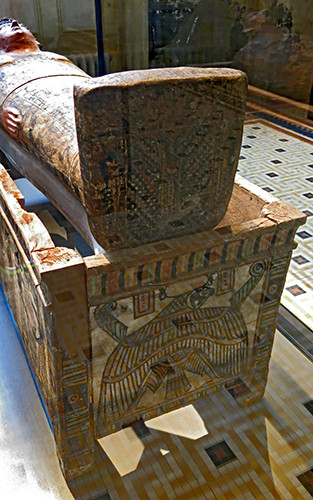
Roman period: 30 BC - 395 AD
Coffin
Head and Foot of the Coffin
Catalog: Faijum? Ägyptisches museum, Inv. No VAGM 1983/16
Photo: Don Hitchcock 2015
Source: Original, Staatliche Museen zu Berlin, Neues Museum, Germany
Text: © Card at the Staatliche Museen zu Berlin
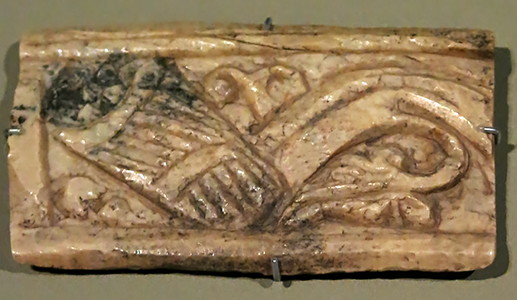
Roman period: 30 BC - 395 AD
Relief panel
Fruit basket on its side, with scrollwork, 1st - 2nd centuries AD.
Catalog: Bone, ÄS 5934
Photo: Don Hitchcock 2015
Source and text: Ägyptischen Museum München
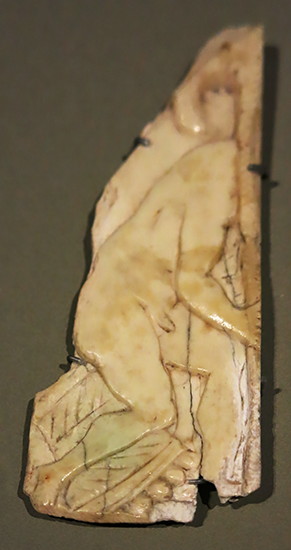
Roman period: 30 BC - 395 AD
Relief panel
Relief panel showing part of a bucolic scene: a man with shepherd's crook, over a basket of fruit, 1st - 2nd centuries AD.
Catalog: Bone, ÄS 2043
Photo: Don Hitchcock 2015
Source and text: Ägyptischen Museum München
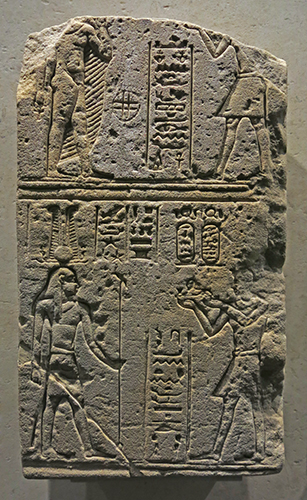
Roman period: 30 BC - 395 AD
Ptah
Relief with scenes showing the king offering before a child god and Ptah.
1st - 2nd Century AD.
Photo: Don Hitchcock 2015
Catalog: Sandstone, unknown catalog number
Source: Original, Ägyptischen Museum München
Text: Museum card, © Ägyptischen Museum München
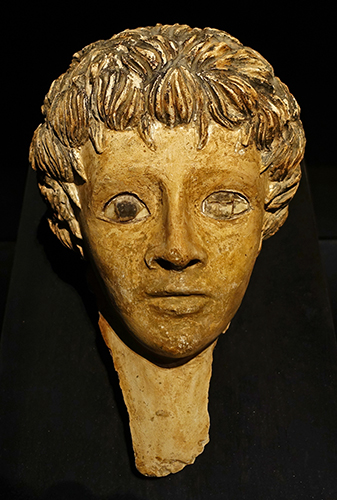
Roman period: 30 BC - 395 AD
Mummy mask
Mummy mask of a young man, circa 150 AD.
Catalog: Plaster, limestone, glass, ÄS 7088
Photo: Don Hitchcock 2018
Source: Original, Ägyptischen Museum München
Text: Museum card, © Ägyptischen Museum München
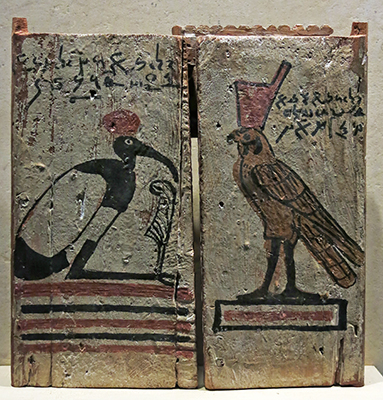
Roman period: 30 BC - 395 AD
Shrine Doors
Doors from a sacred shrine, bearing a blessing in Demotic script.
1st - 2nd Century AD.
Photo: Don Hitchcock 2015
Catalog: Wood, Tuna el-Gebel (?), ÄS 1384
Source: Original, Ägyptischen Museum München
Text: Museum card, © Ägyptischen Museum München
Roman period: 30 BC - 395 AD
Portrait
Circa 100 AD - 200 AD
Wax encaustic portrait on wood of a girl with short (or pulled back) hair; face damaged by a tool; intact left eye aquamarine blue. Central gold leaf pendant on head and small gold earrings; gold chain necklace with oval pendant in centre. Dark purple red chiton and brown himation; background pale blue. Panel split longitudinally, in three major sections.
Collected from Hawara Cemetery, Mummy no. 33. From a group burial with 34 and 35 (UC30088) and two mummies with portraits removed before burial.
The encaustic method is a painting technique in which pigments are mixed with hot liquid wax.
Height 330 mm, width 188 mm, Accession Number LDUCE-UC36215.
Photo: Don Hitchcock 2015
Source: Original, Petrie Museum, London, England
Text: Card / online catalogue, the Petrie Museum, © 2015 UCL. CC BY-NC-SA license
Roman period: 30 BC - 395 AD
Portrait
Circa 100 AD - 200 AD
Wax portrait on wood of a woman with short black curly hair, wearing silvered glass or coral and gold pendant earrings, and two strings of beads- one of amethyst or garnet and beryl, with gold, and the other of silvered glass or coral and gold.
Light purple chiton, with dark purple himation over each shoulder, which has yellow bands at each edge. The middle of the portrait is lost.
Collected at Hawara Cemetery, Mummy No 35, From a group burial with portraits nos 33 and 34, and two mummies with portraits removed before burial, leaving an empty space.
Height 397 mm, length 222 mm, Accession Number LDUCE-UC30088.
Photo: Don Hitchcock 2015
Source: Original, Petrie Museum, London, England
Text: Card / online catalogue, the Petrie Museum, © 2015 UCL. CC BY-NC-SA license
Roman period: 30 BC - 395 AD
Portrait
Second Century AD.
Wax encaustic portrait on a wood panel of a young woman with dark hair in rows of curls across the forehead. The skin pigment is extremely patchy but predominantly cream, the lips maroon, the eyes dark brown and white. There is no trace of jewellery except for ball ear rings. She is wearing a peach/ red chiton and a darker red haematon. The background is blue-grey.
The encaustic method is a painting technique in which pigments are mixed with hot liquid wax.
The portrait is virtually complete, but in two main pieces, restored from fragments (including Temp. No.427, on left side as viewed). It is longitudinally cracked. There are traces of oiled bandages from mummy binding at the top and lower edge, where there are a few small linen patches. The back is stained in places by oil.
Length 356 mm, width 197 mm, Accession Number LDUCE-UC38103
Photo: Don Hitchcock 2015
Source: Original, Petrie Museum, London, England
Text: Card / online catalogue, the Petrie Museum, © 2015 UCL. CC BY-NC-SA license
Roman period: 30 BC - 395 AD
Portrait
Encaustic wax mummy portrait of the head and shoulders of a dark haired young man, clean shaven, facing left, wearing a gold fillet. The portrait is on a thin wooden panel.
The encaustic method is a painting technique in which pigments are mixed with hot liquid wax.
From Hawara, length 350 mm, width 230 mm, Accession Number LDUCE-UC19613
Photo: Don Hitchcock 2015
Source: Original, Petrie Museum, London, England
Text: Card / online catalogue, the Petrie Museum, © 2015 UCL. CC BY-NC-SA license
Roman period: 30 BC - 395 AD
Portrait
Encaustic wax mummy portrait of the hair and shoulders of dark curly-haired young man with slight beard and moustache, face left, wearing a gold fillet, pink toga and white scarf, on a thin wooden panel.
The encaustic method is a painting technique in which pigments are mixed with hot liquid wax.
From Hawara, Height 335 mm, width 175 mm, Accession Number LDUCE-UC19612
Photo: Don Hitchcock 2015
Source: Original, Petrie Museum, London, England
Text: Card / online catalogue, the Petrie Museum, © 2015 UCL. CC BY-NC-SA license
Roman period: 30 BC - 395 AD
Portrait
Lime (Tilia sp.) panel from Hawara cemetery with encaustic wax mummy portrait of Petrie's 'red youth', with curly light beard and moustache, and face left. Sharp tool was used to delineate the shape of the face, ears and eyebrows.
Encaustic wax mummy portrait of head and shoulders of curly-headed male youth with light beard and moustache, face left, on thin wood panel.
The encaustic method is a painting technique in which pigments are mixed with hot liquid wax.
Height 395 mm, width 270 mm, Accession Number LDUCE-UC19610
Photo: Don Hitchcock 2015
Source: Original, Petrie Museum, London, England
Text: Card / online catalogue, the Petrie Museum, © 2015 UCL. CC BY-NC-SA license
Roman period: 30 BC - 395 AD
Portrait
Wax encaustic portrait on wood panel of a man with dark hair in curls, skin reddish-brown, lips deep pink, eyes dark brown and white. The head faces towards the right. The portrait is broken off at the neck. There is a cream surround to the portrait, which is split longitudinally into three main sections. The left and central panels are complete, but the right panel is fragmentary around edge. There is damage to the paint on the hair and neck. Marked 'BB' in pencil on reverse. From Hawara cemetery, Body BB.
Height 226 mm, width 159 mm, Accession Number LDUCE-UC38315
Gilt stucco border
Shown with the portrait described above is the right side of a gilt stucco border for the wax encaustic mummy portrait with part of the curved top, made on a linen canvas base and applied as a loose arch of decoration over the picture.
The gilding has an embossed vine pattern with bunches of grapes and leaves from a sinusoidal stem in the panel.
Hawara, Accession Number LDUCE-UC42571
Photo: Don Hitchcock 2015
Source: Original, Petrie Museum, London, England
Text: Card / online catalogue, the Petrie Museum, © 2015 UCL. CC BY-NC-SA license
Roman period: 30 BC - 395 AD
Portrait
Panel portrait painted in encaustic, cut at the upper corners for insertion in the wrappings of the mummified body. The portrait depicts a woman with a short hairstyle and separated curls around the brow, wearing a deep red purple tunic with dark purple clavus band, gold ball earrings, and gold bead necklace with a gold ring pendant. The woman is identified in Greek letters either side of neck as Isarous, an Egyptian name in Greek form, one of the only encaustic panel portraits with a name.
Collected at Hawara Cemetery.
Height 365 mm, width 180 mm, Accession Number LDUCE-UC19611.
Photo: Don Hitchcock 2015
Source: Original, Petrie Museum, London, England
Text: Card / online catalogue, the Petrie Museum, © 2015 UCL. CC BY-NC-SA license

Roman period: 30 BC - 395 AD
Mummy of an unknown man
A Portrait is painted on the shroud.
Mummy, linen, location Thebes / Luxor, ca 200-250 AD. Roman Imperial Period.
Photo: Don Hitchcock 2014
Source: Original, Rijksmuseum van Oudheden, National Museum of Antiquities, Leiden.
Roman period: 30 BC - 395 AD
Mummy of a male child
Mummy of a male child, in a painted linen shroud and wooden coffin.
Roman Period, circa 230 AD - 250 AD. Provenance unknown.
Catalog: EA6715
Photo: Don Hitchcock 2015
Source: Original, British Museum
Text: http://www.britishmuseum.org/, card with the display at the British Museum, © Trustees of the British Museum
Roman period: 30 BC - 395 AD
Wooden coffin of a male child
The mummy in its shroud was contained in a painted wooden coffin, consisting of a flat base-board, with a raised edge, which is decorated with a painted representation of Nut, on a white ground; the convex lid is decorated with a painted representation of a snake and a floral garland on a white ground with red edges and sides.
Skull - No obvious fractures. The cervical spine appears intact.
Thorax and Abdomen - These cavities appear empty. The ribs, spinal column, pelvis, and hips are normal. No fractures or dislocations. The intervertebral discs, especially the lumbar, are partially opaque. The whole of the body surface shows a flecked appearance, probably due to particles of sand in the resinous covering.
Arms - Extended. Hands, with fingers extended, the palmar surfaces in contact with the outer aspect of the thighs.
Legs - Menisci opaque. Bones appear normal. No lines of arrested growth. Wrapped in a linen shroud bearing tempera representation of the deceased in Graeco-Roman costume, wearing white sandals and holding a bunch of laurel leaves in his left hand, right hand raised, hair painted red with white spots, the meaning of the four black marks on the forehead is unknown.
The mummy, aged 7 - 10 years at death is wrapped in a shroud on which is depicted the boy wearing a tunic, mantle and slippers, and holding a sprig of myrtle. A wreath of rosebuds is worn on the head. CAT scans of the mummy suggest an age at death of 8 to 10 years.
Mummy: height 850 mm, width 215 mm
Coffin: length 955 mm, width 320 mm.
( It seems likely, given the decoration on the coffin, that the boy had been killed by a snake, possibly the Egyptian Cobra, which is known to enter houses on occasion. The four black marks on the boy's head painted on the shroud could then be interpreted as intended to show the marks of snakebite - Don )
Catalog: EA6715
Photo: Don Hitchcock 2018
Source: Original, British Museum
Text: http://www.britishmuseum.org/, card with the display at the British Museum, © Trustees of the British Museum

Roman period: 30 BC - 395 AD
Mummy mask
Mummy mask of a man, 2nd century AD.
Catalog: Plaster, paint, El-Rubajat ÄS 798
Photo: Don Hitchcock 2018
Source: Original, Ägyptischen Museum München
Text: Museum card, © Ägyptischen Museum München
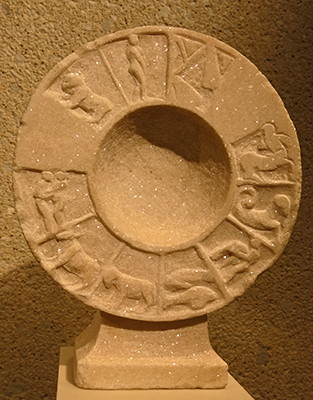
Roman period: 30 BC - 395 AD
Signs of the zodiac
Depiction of the signs of the zodiac, 2nd century AD.
Catalog: Marble, SK 1050
Photo: Don Hitchcock 2015
Source: Original, Staatliche Museen zu Berlin, Neues Museum, Germany
Text: © Card at the Staatliche Museen zu Berlin, (CC BY-NC-SA 3.0 DE)
Roman Period: 30 BC - 395 AD
Offering Tray
Offering tray in the shape of a sacred lake with a crocodile and frogs, 2nd - 3rd century AD.
Catalog: Limestone, ÄS 7087
Photo: Don Hitchcock 2015
Source: Original, Ägyptischen Museum München
Text: © Ägyptischen Museum München

Roman Period: 30 BC - 395 AD
Ganymede
Early 3rd century AD.
Catalog: Marble, Behnasa, ÄS 4198
Photo: Don Hitchcock 2018
Source: Original, Ägyptischen Museum München
Text: Museum card, © Ägyptischen Museum München
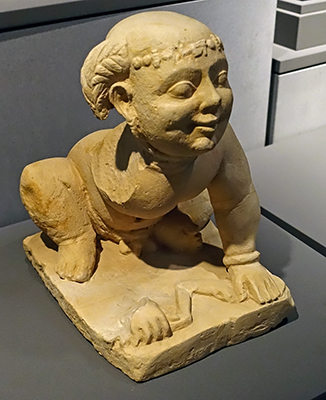
Roman Period: 30 BC - 395 AD
Harpocrates
Figure of a small child, Harpocretes, 2nd - 4th century AD.
Catalog: Limestone, ÄS 6933
Photo: Don Hitchcock 2018
Source: Original, Ägyptischen Museum München
Text: Museum card, © Ägyptischen Museum München
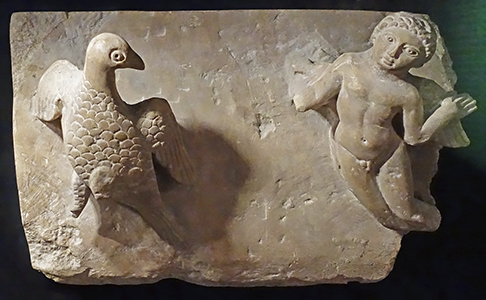
Roman Period: 30 BC - 395 AD
Ganymede and eagle
3rd - 4th century AD
Catalog: Limestone, ÄS 4285
Photo: Don Hitchcock 2018
Source: Original, Ägyptischen Museum München
Text: Museum card, © Ägyptischen Museum München
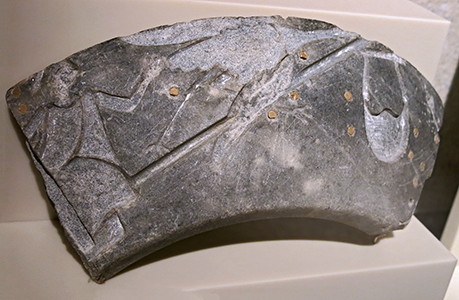
Roman period: 30 BC - 395 AD (disputed, may be Ptolemaic)
Berlin celestial globe (fragment)
Although of unknown provenance, similar astronomical devices would be expected in Roman times in Egypt, notably predated by the astronomical model of the universe, powered by water, of Ctesibius, a Greek inventor and mathematician in Alexandria, in Ptolemaic Egypt.
Size: 75 x 320 x 150 mm.
From left to right the constellations Cassiopeia, Schwan, Lyra and in part Hercules are preserved. One interpretation is that the wide line through the wing of the Swan may indicate the Milky Way. However, see below for a more likely explanation. The constellations were originally in colour.
Kühne (1987) concludes that the fragment dates to the Hellenistic period, 3rd-century BC, as well as the following:
The fragment SK 1050 a in the Neues Museum in Berlin has been interpreted as being part of an ancient vessel garnished with arbitrary astronomical ornaments. The fragment was in fact part of a sophisticated astronomical instrument:
(1) Structures of the fragment indicate that the celestial globe was fitted with a water-clock similar to the design by Ctesibius and that this water-clock propelled an astronomical model of the universe. Ctesibius was a Greek engineer, inventor, and mathematician in Alexandria, in Ptolemaic Egypt, active between 285 BC – 222 BC.
(2) Iconographic parallels between SK1050A and the Atlas Farnese suggest that the latter was intended to be a replica of the Berlin celestial globe. The word 'Atlas' now refers to any set of maps of the globe, and this usage is ultimately derived from the Atlas Farnese sculpture.
(3) The arrangement of the ‘star-markings’ on SK1050A might be explained as geometrical constructions to establish spherical coordinate transformations.
In consequence, SK1050A appears to be the product of a profound astronomer while some evidence beyond that prompts the hypothesis that the fragment is from the celestial globe of Archimedes.
Catalog: Marble, SK 1050 a
Photo: Don Hitchcock 2015
Source: Original, blue marble, Staatliche Museen zu Berlin, Neues Museum, Germany
Text: © Card at the Staatliche Museen zu Berlin, http://www.smb-digital.de/, (CC BY-NC-SA 3.0 DE)
Additional text: http://members.westnet.com.au/gary-david-thompson/page11-16.html, Wikipedia.com
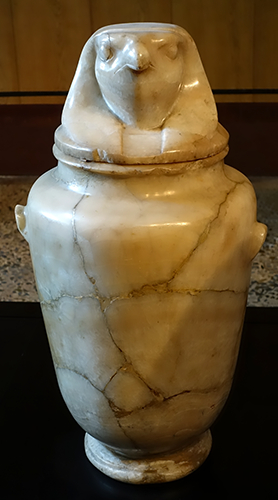
Roman period: 30 BC - 395 AD
Urn in the form of a canopic jar
Circa 100 AD.
Catalog: Calcite/alabaster, ÄM 13790
Photo: Don Hitchcock 2018
Source: Staatliche Museen zu Berlin, Neues Museum, Germany
Text: © Card at the Staatliche Museen zu Berlin, (CC BY-NC-SA 3.0 DE)
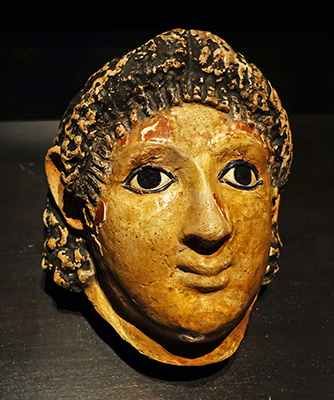
Roman period: 30 BC - 395 AD
Mummy Mask
Mummy mask of a young woman with inlaid eyes, circa 100 AD.
Catalog: Plaster, glass, Hawara, ÄS 14
Photo: Don Hitchcock 2018
Source: Original, Ägyptischen Museum München
Text: Museum card, © Ägyptischen Museum München

Roman period: 30 BC - 395 AD
Mummy with a golden face mask
The use of gold was connected to the belief that the sun god Re, with whom the mummy hoped to be united, had flesh of pure gold.
The mask was created from layers of wet linen gummed together, usually shaped over a mould and then given a thin outer coating of plaster. Once it had hardened, it could then be gilded or painted.
Photo: Don Hitchcock 2014
Source: Original, Rijksmuseum van Oudheden, National Museum of Antiquities, Leiden.
Text: http://www.britishmuseum.org/explore/highlights/highlight_objects/aes/g/gilded_cartonnage_mummy_mask.aspx, © Trustees of the British Museum
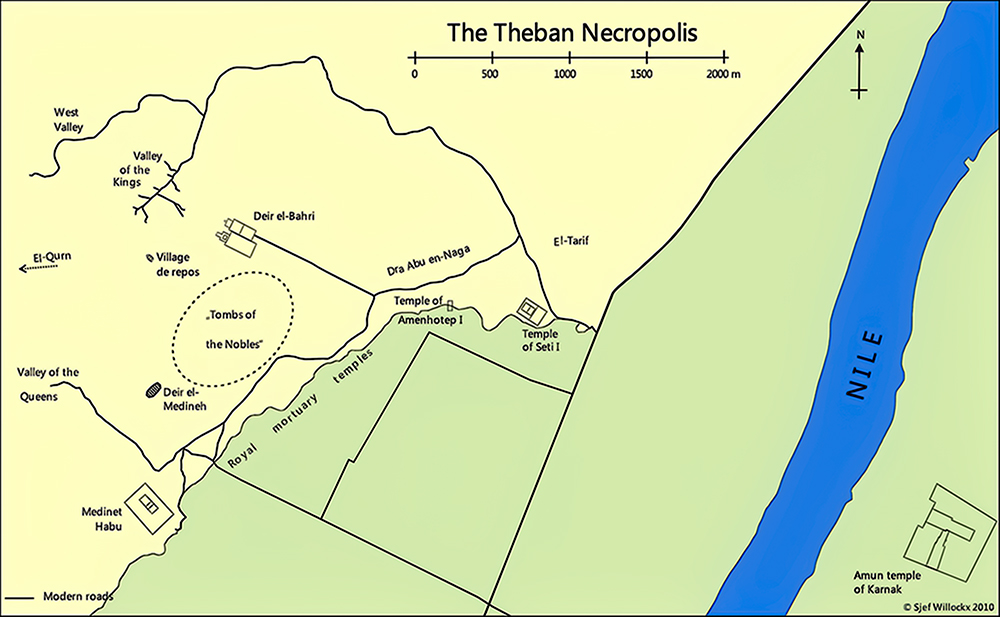

Thebes and the Theban necropolis
Ancient Thebes, on the east bank of the Nile, was no longer standing in Roman times. Its ruins lie within the modern Egyptian city of Luxor, with the Theban Necropolis including the Valley of the Kings on the west bank. The city of Diospolis Magna (Luxor) grew up on the Nile's east bank, and Memnonia, on the west bank, where the Mortuary Temple of Ramesses III is located, was administered by the city of Hermonthis (Armant). Luxor Temple, shown on this map, is a complex constructed mainly under Amenhotep III & Ramesses II, added to by Tutankhamun and others.
The funerary traditions developed for the Egyptian elite remained stronger here than elsewhere. Mummification practices were respected, traditional iconography was assimilated and cartonnage was used (stuccoed linen especially).
Map (upper) © Sjef Willockx
Source: https://www.researchgate.net/publication/307547254_Map_of_the_Theban_Necropolis_2010b
Map (lower) google maps
Text: Louvre Museum, https://collections.louvre.fr/

Roman period: 30 BC - 395 AD
Masque-plastron
A Masque-plastron is a face mask and bib, or breast plate, originally in wood or gold, but often of cartonnage and plaster during the Ptolemaic Period.
Today similar items of costume, for totally different purposes, include the protective mask and chest protectors used by fencers and baseball catchers, as well as the combined mask and bib for dress up costumes of film and TV characters for children.
This URL gives a good overview of the use of funerary masks in ancient Egypt:
http://www.touregypt.net/featurestories/masks.htm
The woman wears a Usekh collar, earrings, and wig, circa 100 AD - 199 AD
The decoration on the stuccoed fabric is in cream, red, green, and black, and includes a representation of Anubis.
Height 450 mm, width 370 mm.
Catalog: Painted and gilded cardboard and linen fibre, N 2878 A
Location: Room 183, Egyptian funerary art, Vitrine 7.
Photo: Don Hitchcock 2015
Source and text: Original, Louvre Museum, https://collections.louvre.fr/

Roman period: 30 BC - 395 AD
Masque-plastron
Mask and bib of the deceased depicted as Hathor, circa 100 BC - 100 AD
Painted and gilded cardboard.
The deceased is depicted naked on this mummy cover.
Since the Late Period, the deceased could be conjoined with Hathor.
In the Roman period, representations of the naked Hathor are very frequent in funerary contexts: goddess of beauty, she embodies the idea of eternal life in the full enjoyment of her senses, like an equivalent of Osiris for men.
Height 555 mm, width 360 mm.
Catalog: Stuccoed fabric, gilded, blue-pink-black-green, West Hermopolis (Touna el-Gebel, Egypt), AF 13203, E 12056 ERR, E 12042?
Location: Room 183, Egyptian funerary art, Vitrine 7.
Photo: Don Hitchcock 2015
Source and text: Original, Louvre Museum, https://collections.louvre.fr/
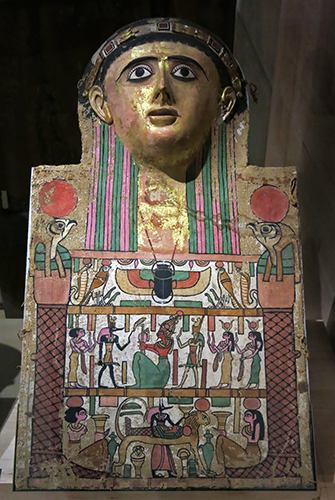
Roman period: 30 BC - 395 AD
Pebos, Masque-plastron
Mask and bib of Pebos, father of Crates, dead at 73. circa 150 AD - 199 AD.
This masque-plastron, or mask and bib, shows the subject wearing a crown and a nemes headdress ( though much stylised - Don ), and short curly hair.
Shown flanking the bib are two gods shown as falcons, wearing sun disc headdresses. Below the mask of the face of the deceased is a scarab beetle. In the registers are a series of deities wearing sun discs.
( In the first register is a winged scarab (shown as a pendant on a cord around the neck of Pebos) between two falcons with solar disc headdresses, flanked by two Uraei also wearing sun discs.
In the second register Osiris is shown seated, adored by, on the left, the goddess Nephthys, wearing her symbol of a basket on top of the glyph representing the plan of an estate, and Anubis wearing the Pschent, the double crown of Egypt. On the far right Osiris is adored by two goddesses, each wearing the Hathor crown of cow horns and a sun disc. At the near right is a falcon headed god, Horus, also wearing the Pschent, the double crown of Egypt.
In the third register is Anubis, standing, holding a vase, supervising the embalming of the deceased on an embalming bed in the shape of a lion. The lion of the table and the goddesses at each end are shown with sun disc headdresses. Two spouted Hes-vases stand at either end of the embalming bed - Don )
Height 745 mm, width 415 mm, thickness 110 mm.
Catalog: Gilded (face and neck), painted, stuccoed fabric, tomb 1407, Deir el-Medina, Thebes West, E 14542 BIS
Location: Room 183, Egyptian funerary art, Vitrine 10.
Photo: Don Hitchcock 2015
Source and text: Original, Louvre Museum, https://collections.louvre.fr/
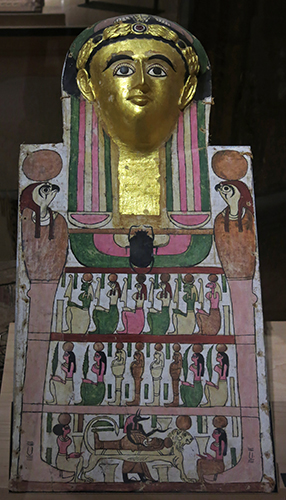
Roman period: 30 BC - 395 AD
Crates, Masque-plastron
Crates, son of Pebos, died at 17 years 8 months 17 days, circa 150 AD - 199 AD.
This masque-plastron, or mask and bib, shows the subject wearing a crown and a nemes headdress ( though much stylised - Don ).
Shown flanking the bib are two falcon headed gods, wearing sun disc headdresses. Below the mask of the face of the deceased is a scarab beetle. In the first and second registers are a series of deities wearing sun discs.
In the third register is Anubis, standing, holding a vase, supervising the embalming of the deceased on an embalming bed in the shape of a lion. The lion of the table and the goddesses at each end are shown with sun disc headdresses.
Height 750 mm, width 347 mm, thickness 110 mm.
Catalog: Painted stuccoed fabric, gold foil, tomb 1407, Deir el-Medina, Thebes West, E 14542 TER
Location: Room 183, Egyptian funerary art, Vitrine 10.
Photo: Don Hitchcock 2015
Source and text: Original, Louvre Museum, https://collections.louvre.fr/
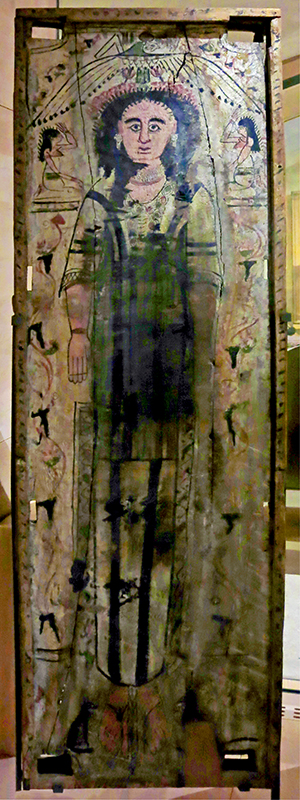
Roman period: 30 BC - 395 AD
Chelidonia
Floor of the rectangular coffin with corner posts of Chelidonia, circa 175 AD - 225 AD.
Painted on the floor of the coffin is a woman, displaying a dress, necklace, earrings, and sandals. There are also images of Isis, Nephthys, vines, and a bunch of grapes.
The writing of the legend is in demotic, as well as three lines of Greek.
Length 1690 mm, width 475 mm, width 440 mm, thickness: 20 mm.
Catalog: Tamarind wood, Thebes west, N 2576 A, Révillout n° 897, CC 243
Location: Aile Denon, Salle 183, Egyptian funerary art, Vitrine 7.
Photo: Don Hitchcock 2015
Source and text: Original, Louvre Museum, https://collections.louvre.fr/
Roman period: 30 BC - 395 AD
Chelidonia
Rectangular coffin with corner posts of Chelidonia, circa 175 AD - 225 AD.
Length 1690 mm, width 530 mm, height 590 mm.
The Greek text reads:
Chelidonia with beautiful curls, after having lived flawlessly 36 years, 6 months and 10 days, thanks to the good care of her daughter Sendiabôs and the help of Etleutos, husband of Chélis (?), Rest in peace. I, Etleutos, wrote the name (?) of my partner.
( note the griffin on the top of the coffin, close to the proximate end in the image upper right. The griffin is a legendary creature with the body, tail, and back legs of a lion. The head and wings are of an eagle and sometimes an eagle's talons are shown as its front feet.
Since classical antiquity, griffins were known for guarding treasures and priceless possessions - Don )
Catalog: Tamarind wood, Tempera painting, Thebes west, N 2576 B, CC 243, Révillout n° 897
Location: Aile Denon, Salle 183, Egyptian funerary art, Vitrine 7.
Photo: Don Hitchcock 2015
Source and text: Original, Louvre Museum, https://collections.louvre.fr/
Additional text: Wikipedia
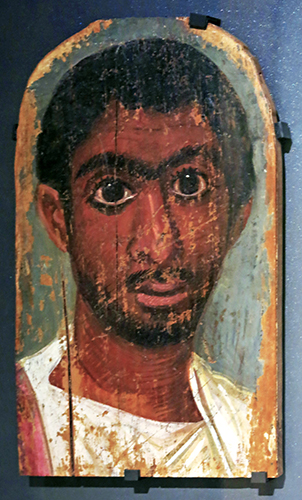
Roman period: 30 BC - 395 AD
Portrait of a mummy
Portrait of a man, middle of the third century AD
He wears a tunic, a beard, and moustache.
This portrait was made during the period of 'Military Anarchy', which opened with the assassination of Severus Alexander in 235 AD, and the end of the Severan dynasty, which led to the 'Crisis of the Third Century' which lasted until the coming to power of Diocletian, in 284 AD. During his reign he stabilised the Roman Empire.
Height 300 mm, width 185 mm, thickness 2 mm.
The wood used for this is linden, which would have had to be imported from temperate regions of Europe. It is a large, deciduous tree, reaching typically 20 metres to 40 metres in height. Linden trees produce soft and easily worked timber, which has very little grain. It was often used by Germanic tribes for constructing shields. It is a popular wood for model building and for intricate carving.
Painted with the encaustic method, a painting technique in which pigments are mixed with hot liquid wax.
Catalog: linden wood, wax (wax-based binder), pigment, Thebes west, N 2732 2, P 209
Location: Aile Denon, Salle 183, Egyptian funerary art.
Photo: Don Hitchcock 2015
Source and text: Original, Louvre Museum, https://collections.louvre.fr/
Additional text: Wikipedia
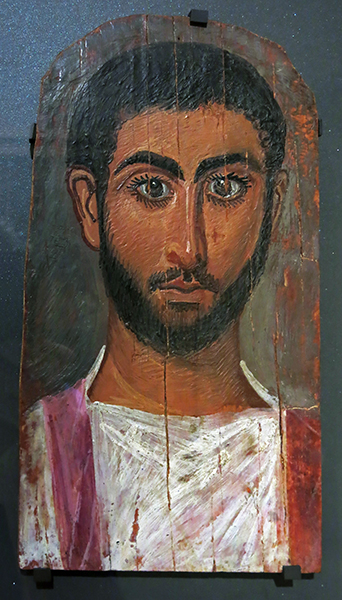
Roman period: 30 BC - 395 AD
Portrait of a mummy
Portrait of a young man, middle of the third century AD
He wears a tunic, short curly hair, beard, and moustache.
This portrait was made during the period of 'Military Anarchy', which opened with the assassination of Severus Alexander in 235 AD, and the end of the Severan dynasty, which led to the 'Crisis of the Third Century' which lasted until the coming to power of Diocletian, in 284 AD. During his reign he stabilised the Roman Empire.
Height 330 mm, width 190 mm, thickness 2 mm.
The wood used for this is linden, which would have had to be imported from temperate regions of Europe. It is a large, deciduous tree, reaching typically 20 metres to 40 metres in height. Linden trees produce soft and easily worked timber, which has very little grain. It was often used by Germanic tribes for constructing shields. It is a popular wood for model building and for intricate carving.
Painted with the encaustic method, a painting technique in which pigments are mixed with hot liquid wax.
Catalog: linden wood, wax (wax-based binder), pigment, Thebes west, N 2732 1, P 208
Location: Aile Denon, Salle 183, Egyptian funerary art
Photo: Don Hitchcock 2015
Source and text: Original, Louvre Museum, https://collections.louvre.fr/
Additional text: Wikipedia
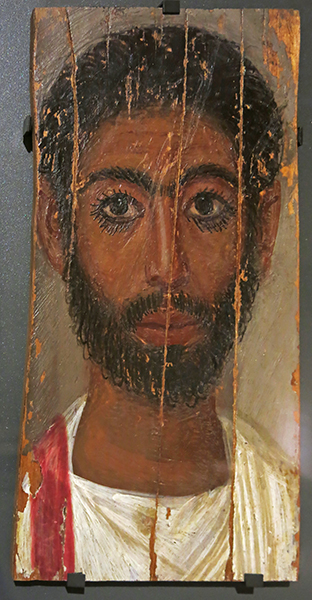
Roman period: 30 BC - 395 AD
Portrait of a mummy
Portrait of a young man, middle of the third century AD
He wears a tunic, short curly hair, beard, and moustache.
This portrait was made during the period of 'Military Anarchy', which opened with the assassination of Severus Alexander in 235 AD, and the end of the Severan dynasty, which led to the 'Crisis of the Third Century' which lasted until the coming to power of Diocletian, in 284 AD. During his reign he stabilised the Roman Empire.
Height 330 mm, width 185 mm, thickness 2 mm.
The wood used for this is linden, which would have had to be imported from temperate regions of Europe. It is a large, deciduous tree, reaching typically 20 metres to 40 metres in height. Linden trees produce soft and easily worked timber, which has very little grain. It was often used by Germanic tribes for constructing shields. It is a popular wood for model building and for intricate carving.
Painted with the encaustic method, a painting technique in which pigments are mixed with hot liquid wax.
Catalog: linden wood, wax (wax-based binder), pigment, Thebes west, N 2732 3, P 210
Location: Aile Denon, Salle 183, Egyptian funerary art.
Photo: Don Hitchcock 2015
Source and text: Original, Louvre Museum, https://collections.louvre.fr/
Additional text: Wikipedia
The three portraits above are thought to be by the same artist, and to have the same provenance, based on the common style, the reddish clavus on the shoulder in each of the three portraits, and the close resemblance of the three paintings.
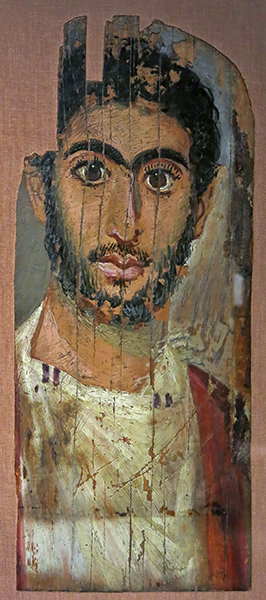
Roman period: 30 BC - 395 AD
Portrait of a mummy
Portrait of a young man, middle of the third century AD
He wears a tunic, coat, short curly hair, beard, moustache, and collar.
Height 425 mm, width 180 mm.
Painted with the encaustic method, a painting technique in which pigments are mixed with hot liquid wax.
Catalog: linden wood, wax (wax-based binder), pigment, Thebes west, AF 6723
Location: Aile Denon, Salle 183, Egyptian funerary art.
Photo: Don Hitchcock 2015
Source and text: Original, Louvre Museum, https://collections.louvre.fr/
Additional text: Wikipedia
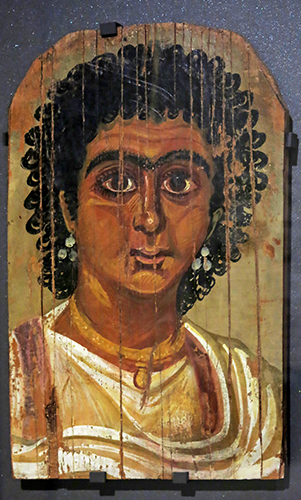
Roman period: 30 BC - 395 AD
Portrait of a Mummy
Portrait of a woman wearing a dress, and with short curly hair, earrings, and a pendant necklace.
Height 300 mm, width 187 mm, thickness 2 mm.
Painted with the encaustic method, a painting technique in which pigments are mixed with hot liquid wax.
Catalog: linden wood, wax (wax-based binder), pigment, Thebes west, N 2733 2, P 211
Location: Aile Denon, Salle 183, Egyptian funerary art, Vitrine 8.
Photo: Don Hitchcock 2015
Source and text: Original, Louvre Museum, https://collections.louvre.fr/
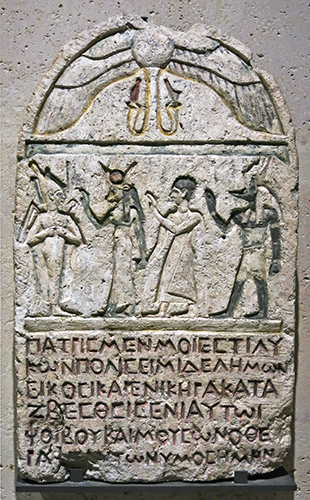
Roman period: 30 BC - 395 AD
Elemon
Funerary arched stele of Elemon showing the deceased in Egyptian dress led by Anubis and Hathor to Osiris, first Century AD.
The inscription reads: My homeland is Lycopolis; I am Elemon, who saw his fate end in his 21st year. A servant of Phoebus and and the Muses, I was famous everywhere.
( In the upper register is a winged sun disc, associated with divinity, royalty and power often shown flanked, as here, by two Uraei, representations of a sacred serpent as an emblem of supreme power, worn on the headdresses of ancient Egyptian deities and sovereigns. In this case one Ureaus wears the Deshret, the red crown of upper Egypt, and one the Hedjet, the white crown of lower Egypt - Don )
Height 670 mm, width 415 mm, thickness 8 mm.
Catalog: Limestone, Assiut (Lycopolis, City of the Wolf), N 330, AF 44
Location: Aile Denon, Salle 183, Egyptian funerary art, Vitrine 5
Photo: Don Hitchcock 2015
Source and text: Original, Louvre Museum, https://collections.louvre.fr/
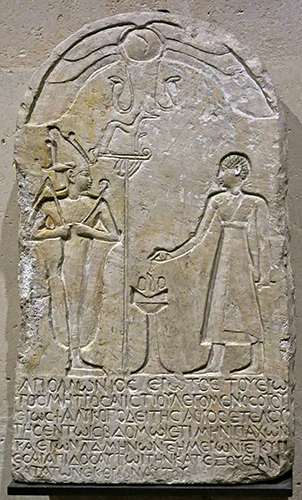
Roman period: 30 BC - 395 AD
Apollonios
Funerary stele of Apollonios in Egyptian dress, with Osiris, 1st Century AD.
The scene shows a man in a skirt, standing in front of Osiris, worshipping, shown in bas relief.
( Wepwawet, shown as a jackal/wolf, possibly representing Lycopolis, City of the Wolf, stands on a royal standard, a pole with a horizontal headpiece supported by just one brace, and with flags attached on the other side of the pole.
In the upper register is a winged sun disc, associated with divinity, royalty and power often shown flanked, as here, by two Uraei, representations of a sacred serpent as an emblem of supreme power, worn on the headdresses of ancient Egyptian deities and sovereigns.
A horned altar, used for burning incense when worshipping the gods, is shown on a pedestal in front of the man - Don )
Inscriptions: Apollonios, son of Eros, grandson of Eros, and of Aristion, his mother, known as the son of Erospsa, from Lykopolis, died prematurely in the seventh year (of the reign of the king?), on the 21st of the month of Pakhon, at the age of 34 years, 5 months, and 256 days. Lord Serapis (Osiris), grant him triumph over his enemies.
Height 560 mm, width 365 mm, thickness 70 mm.
Catalog: Limestone, Assiut (Lycopolis), N 328
Location: Aile Denon, Salle 183, Egyptian funerary art, Vitrine 5
Photo: Don Hitchcock 2015
Source and text: Original, Louvre Museum, https://collections.louvre.fr/
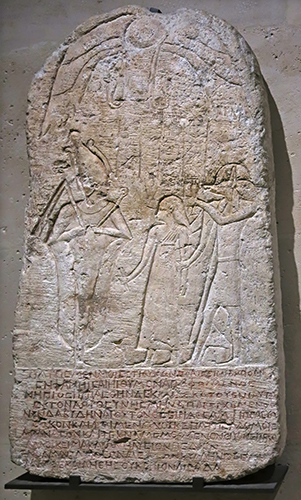
Roman period: 30 BC - 395 AD
Apollonios
Funerary arched stele of Apollōn showing the deceased in Egyptian dress led by Anubis to Osiris, 1st Century AD. Hieroglyphic inscription to Osiris in the upper part and Greek inscription claiming the deceased to be a follower of Anubis of Abydos.
Translation of the Greek inscription:
My homeland is Lycopolis. I am Apollo and I have lost my life in the land of Pharaohs. I was still a child, when I was kidnapped at the age of sixteen and a half, after having reached the sixth month of my premature fate. Now I serve the throne of Osiris from Abydos and I have not set foot inside the mansion of the dead. The sons of the immortals face a predestined death, as well but they dwell in the Elysian plain of the Blessed. Hermes Cyllenius took me there, among the sons of the gods, he put me up and I did not drink from the stream of Lethe
(trans. Jiménez San Cristóbal)
Height 1010 mm, width 530 mm, thickness 80 mm.
Catalog: Limestone, Assiut (Lycopolis), N 329, Salt n° 3736
Location: Aile Denon, Salle 183, Egyptian funerary art, Vitrine 5
Photo: Don Hitchcock 2015
Source and text: Original, Louvre Museum, https://collections.louvre.fr/
Additional text: Wikipedia
Roman period: 30 BC - 395 AD
Crocodile Mask
Stucco mask for a crocodile mummy, circa 2nd Century AD.
The crocodile was the sacred animal of the god Sobek.
Mummifying the carcasses of sacred animals and donating them to the temples of the corresponding deities assured the donors of the special blessing of this deity.
Catalog: Stucco, painted, origin unknown, Inv. no. 2009.367
Photo: Don Hitchcock 2018
Source and text: Original, Museum August Kestner, Hannover
Roman period: 30 BC - 395 AD
Mummy Mask
Mummy Mask of an older woman.
( Note that this well formed mask was probably made to accept a head covering such as a wreath or a wig, now missing - Don )
Catalog: Plaster, glass, ÄS 795
Photo: Don Hitchcock 2018
Source and text: Original, Museum August Kestner, Hannover
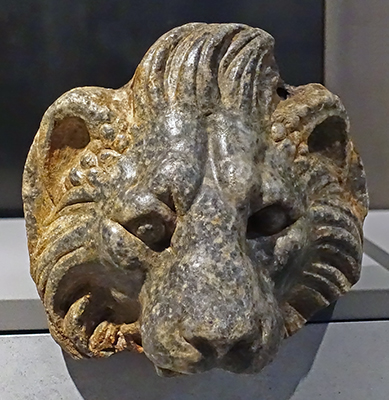 Roman period: 30 BC - 395 AD
Roman period: 30 BC - 395 AD
Water Spout
Water spout in the shape of a lion's head, 2nd - 3rd Century AD.
Catalog: Diorite, Behnasa, ÄS 4293
Photo: Don Hitchcock 2018
Source: Original, Ägyptischen Museum München
Text: © Ägyptischen Museum München

Roman period: 30 BC - 395 AD
Rectangular Cornice Stele
Solar Theology Funerary Stele.
Above the classical scene of embalming by Anubis, framed by Isis and Nephthys, the deceased is shown naked, facing an Egyptian mongoose, the ichneumon, an animal with a well established solar connotation, and a solar disc.
The ichneumon (Herpestes ichneumon) or Egyptian mongoose has been a sacred animal in Egypt since the Middle Kingdom. The ability of the mongoose to catch snakes resulted in the myth that Re took on the shape of an ichneumon in order to fight Apophis. This solar identification explains why the sun's disk is sometimes found on statuettes of ichneumons.
The two bulls, each topped by a solar disc, are certainly Apis and Mnevis, associated with Re.
Anubis is shown standing beside the mummy lying on a lion shaped embalming bed, flanked by Isis and Nephthys, who are crouching, and worshipping.
The writing on the stele is demotic. The style of the stele places it circa 332 - 395 AD.
Height 490 mm, width 360 mm, thickness 90 mm, weight 21 kg.
Catalog: Limestone, protruding bas-relief, engraving, painting (traces of red and black), Heliopolis (Tell Hisn, Egypt), N 279
Location: Aile Denon, Salle 183, Egyptian funerary art
Photo: Don Hitchcock 2015
Source and text: Original, Louvre Museum, https://collections.louvre.fr/
Additional text: Wikipedia
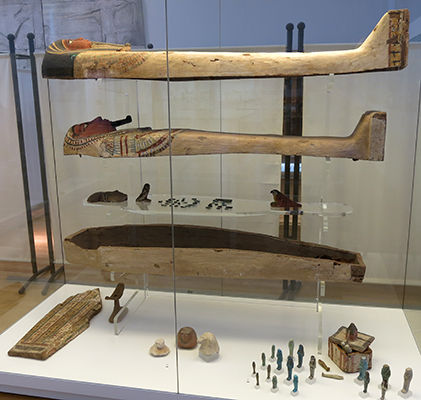
Roman period: 30 BC - 395 AD
Less expensive coffin
This is an interesting burial, one which mimics the form of the magnificent burials that have been detailed above, but one which was obviously not nearly so expensive, nor so steeped in tradition.
The outward forms of the ceremonial coffins are there, but the substance shows that either there was either insufficient wealth to create the traditional coffins of the elite, or that the traditions had already been largely forgotten, and perhaps the burial is from the end of the reign of the pharoahs.
The paintings on the coffins mimic the complex hieroglyphics of the more expensive coffins, but there is no substance to them, they are decorations only.
Photo: Don Hitchcock 2014
Source: Original, Ägyptische Museum der Universität Bonn

Roman period: 30 BC - 395 AD
Less expensive coffin
The carving of the face is workmanlike, but the painting and finish of the casket is of inferior quality.
Photo: Don Hitchcock 2014
Source: Original, Ägyptische Museum der Universität Bonn
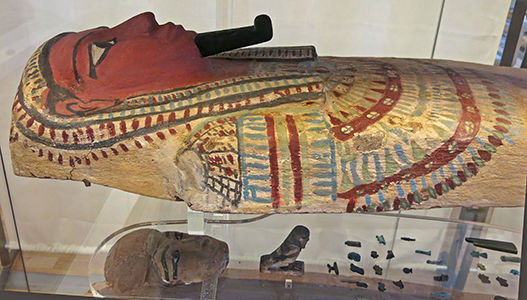
Roman period: 30 BC - 395 AD
Less expensive coffin
We can see that the complex hieroglyphics of the elite are here reduced to a few daubs of colour.
Photo: Don Hitchcock 2014
Source: Original, Ägyptische Museum der Universität Bonn
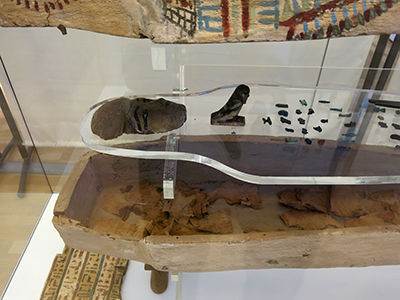
Roman period: 30 BC - 395 AD
Less expensive coffin
The casket is made from planks of wood joined together, a much cheaper method than carving the entire coffin from the trunk of a single tree, which is the method used for many of the more expensive funerals.
Photo: Don Hitchcock 2014
Source: Original, Ägyptische Museum der Universität Bonn
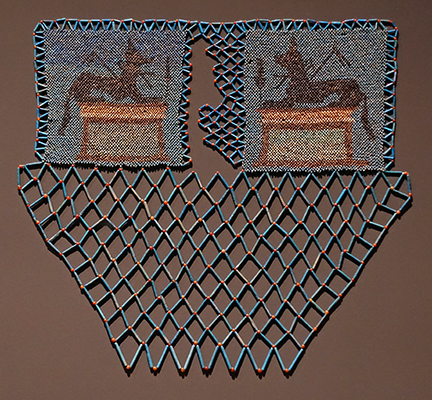
Roman period: 30 BC - 395 AD
Mummy net
Mummy net with crouching jackals (the god Anubis)
1st - 2nd century AD.
Catalog: Faience, stone, ÄS 7210
Photo: Don Hitchcock 2018
Source: Original, Ägyptischen Museum München
Text: Museum card, © Ägyptischen Museum München
Roman period: 30 BC - 395 AD
Mummy Tags
Two labels, above in Demotic and below in Coptic for identifying mummies by name.
The Demotic label above is from the Roman Period, the 2nd Century AD. Fortuitously it had been turned over between 2015 and 2018 to reveal the other side between the time of the two photographs.
The Coptic label below is from the 4th to 5th Century AD.
Catalog: Wood, Akhmim (ÄS 1387), ÄS 1387, ÄS 905
Photo: Don Hitchcock 2015, 2018
Source: Original, Ägyptischen Museum München
Text: Museum card, © Ägyptischen Museum München
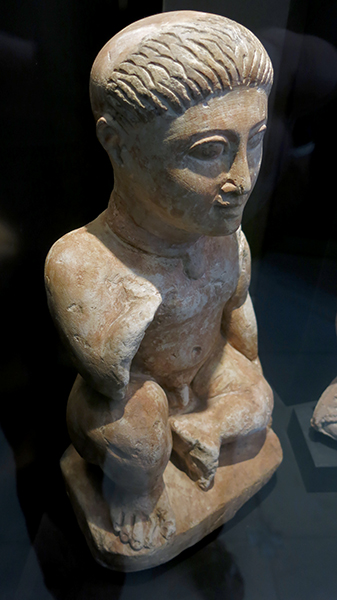
Roman Period: 30 BC - 395 AD
Initiate
Figure of an initiate of the Isis mysteries.
4th century AD.
Probably a tomb figure.
From Antinoöpolis (?)
Catalog: Limestone, Inv. 64/164
Photo: Don Hitchcock 2015
Source and text: Badisches Landesmuseum Karlsruhe Germany
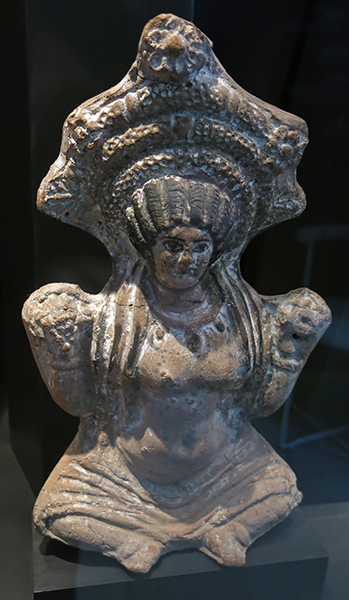
Roman Period: 30 BC - 395 AD
Statue
The subject is either the deceased in prayer posture, or the goddess of the dead.
150 AD - 200 AD.
Catalog: Terracotta, Inv. H 816
Photo: Don Hitchcock 2015
Source and text: Badisches Landesmuseum Karlsruhe Germany

Roman Period: 30 BC - 395 AD
Mummy mask
Mummy mask of a woman with a necklace, fourth century AD.
Catalog: Plaster, painted and gilded, ÄS 1070
Photo: Don Hitchcock 2018
Source: Original, Ägyptischen Museum München
Text: Museum card, © Ägyptischen Museum München
Animal Mummies

The crocodile was regarded as an extremely fierce animal, often used to terrify enemies during war.
The crocodile cult was devoted to Sebek, god of fertility, and the sun god, Re. Typically, crocodiles were raised in a life of complete luxury, indulged until they died. In the early years of this cult, dead crocodiles were lavishly mummified with gold and other precious things.
However, as mummification gradually became a production process, less effort was exerted in their mummification and eventually consisted simply of cloth wrappings and the application of resin, a preserving agent. When found in extremely large quantities, crocodile mummies, like many other sorts of animal offerings, contained only reeds or random body parts. At the main temple of Shedet, later called Crocodilopolis, sacred crocodiles were mummified and displayed in temple shrines or carried in processions.
Location unknown, 300-200 BC, Ptolemaic Dynasty. 314 cm long.
When X-rayed, the mummy was actually of two small crocodiles.
Photo: Don Hitchcock 2014
Source: Original, Rijksmuseum van Oudheden, National Museum of Antiquities, Leiden.
Additional text: Wikipedia
X-ray information: http://www.anp-archief.nl/page/80591/nl
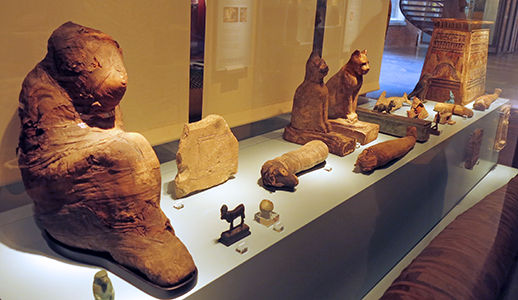
A group of animal mummies, including dogs and cats.
The first large animal on the left is the mummy of a baboon.
Baboon: 380-30 BC., 530 x 260 x 535 mm, AMM 15
Photo: Don Hitchcock 2014
Source: Original, Rijksmuseum van Oudheden, National Museum of Antiquities, Leiden.
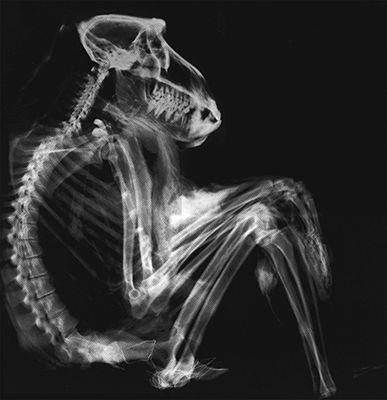
This is an xray of the mummified baboon in the image above.
Photo: Rijksmuseum van Oudheden
Permission: Creative Commons Attribution-Share Alike 3.0 Unported licence.
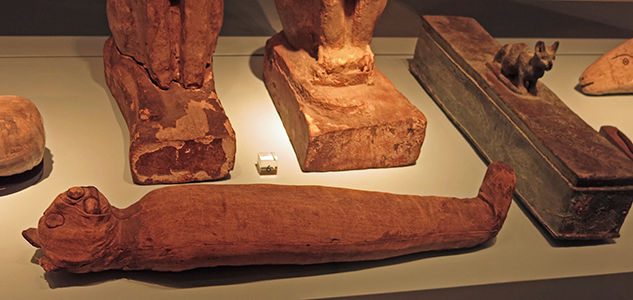
Cat mummy, and a box for a cat mummy at its feet.
Photo: Don Hitchcock 2014
Source: Original, Rijksmuseum van Oudheden, National Museum of Antiquities, Leiden.

Mummy of a falcon in a painted cartonnage case, originally enclosed in a sandstone shrine, Roman Period, after 30 BC. Provenance unknown.
Catalog: EA49734
Photo: Don Hitchcock 2015
Source: Original, British Museum
Text: http://www.britishmuseum.org/, card with the display at the British Museum, © Trustees of the British Museum
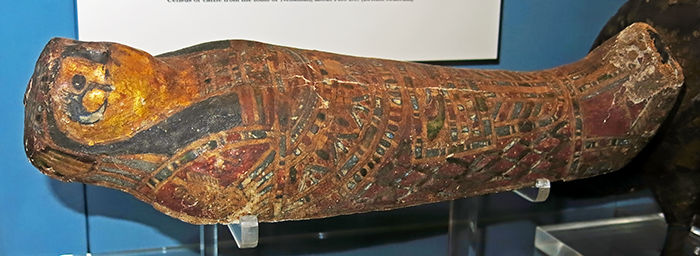
The British Museum site describes this as a mummy-case containing a mummified hawk wrapped in linen from the Roman Period.
Catalog: EA49734
Photo: Don Hitchcock 2015
Source: Original, British Museum
Text: http://www.britishmuseum.org/, card with the display at the British Museum, © Trustees of the British Museum

The mummy of the bird, length 375 mm.
Catalog: EA49734
Photo: Don Hitchcock 2015
Source: Original, British Museum
Text: http://www.britishmuseum.org/, card with the display at the British Museum, © Trustees of the British Museum
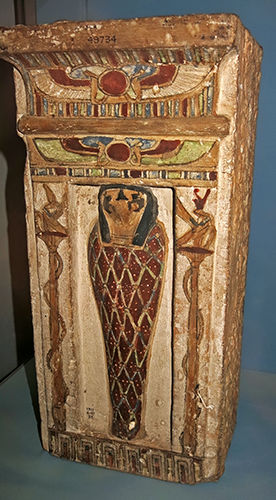
Sandstone shrine in which the mummy of the bird and its case were found.
Height 450 mm, width 207 mm, length 180 mm.
Catalog: EA49734
Photo: Don Hitchcock 2015
Source: Original, British Museum
Text: http://www.britishmuseum.org/, card with the display at the British Museum, © Trustees of the British Museum
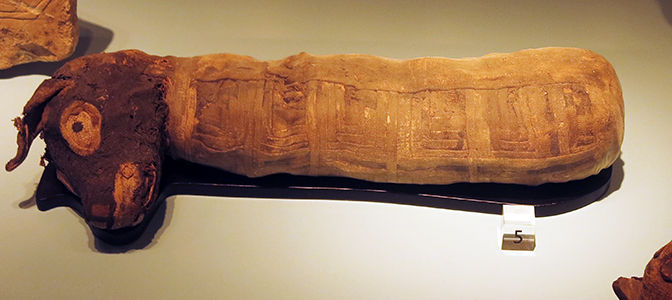
Dog mummy. The dog was only a young animal when it either died or was killed to make a mummy out of it.
0-200 AD, Roman Imperial Period.
Dogs were used as domestic pets, guardians, herders, and police assistants. Several dog breeds could be found in ancient Egypt, the most popular being the greyhound, basenji, and saluki, all very good for hunting. From the First Dynasty, Egyptians venerated several jackal deities, with the most prominent one being Anubis. He was represented as a canine or a canine headed human.
Traditionally, Anubis has been identified as a jackal, but its generally black colouring, symbolic of the afterlife and rebirth, is not typical of jackals and may instead denote a wild dog. Because dogs and jackals roamed the desert's edge, where the dead were generally buried, they were seen as protectors of cemeteries.
Photo: Don Hitchcock 2014
Source: Original, Rijksmuseum van Oudheden, National Museum of Antiquities, Leiden.
Additional text: Wikipedia
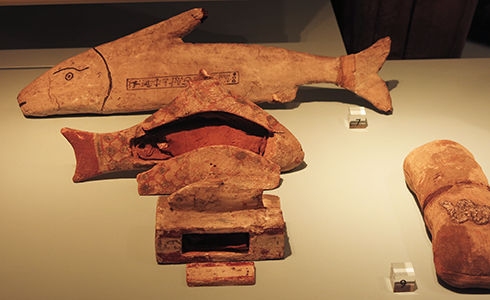
These fish mummies were placed in fish shaped receptacles, possibly because they were not a very good subject for mummification.
Fish were mummified in mass quantities as offerings to the gods. They were wrapped in linen and held together by bands of cloth soaked in sticky resin, permanently encasing the mummies. Many times, black circles representing the eyes were painted on the hardened linen. Several species of fish have been identified, but due to the deteriorating condition of the mummies, scientists are unable to conclude if the organs were typically removed during the process of mummification.
Photo: Don Hitchcock 2014
Source: Original, Rijksmuseum van Oudheden, National Museum of Antiquities, Leiden.
Text: Wikipedia
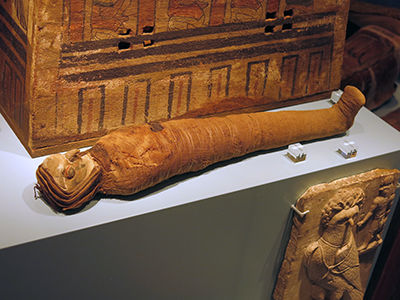
Falcon: The conical body tapers towards a pointed caudal end with dummy feet. The head is well modelled and the face covered by a cartonnage mask moulded in gesso over coarse linen; the linen is visible through damaged spots at the right eyebrow, the bill (where the gesso is completely missing), and the throat. The mask is cream-coloured with details in black (irises, markings around the eyes) and red (details of the bill, rims of the eyes, dotted line on the throat, swastikas on the jaws).
The mask is surrounded by the striated lappets (decorative flap or fold in a ceremonial headdress) of a divine wig made of doubled strips of linen, alternating natural and dark brown; the back of the wig is lost and instead the head is covered by a crumpled layer of plain linen. There are remains of horizontal strips of linen under the throat.
Photo: Don Hitchcock 2014
Source: Original, Rijksmuseum van Oudheden, National Museum of Antiquities, Leiden.
Text: http://www.rmo.nl/collectie/zoeken?object=F+1975%2F11.3

Otherwise the body is wrapped in a single sheet of medium-fine natural linen (warp-faced tabby weave, about 12 x 28 threads/cm2) which shows a join along the centre of the back and over the soles of the dummy feet. The upper body, however, is much damaged and shows the irregular layers of interior wrappings of similar quality (partly added during a modern restoration, fixed by numerous concentric windings of thin yarn). There are several black and dark brown stains and some shiny patches on the exterior sheet.
95 x 520 x 81 mm
Photo and text: http://www.rmo.nl/collectie/zoeken?object=F+1975%2F11.3
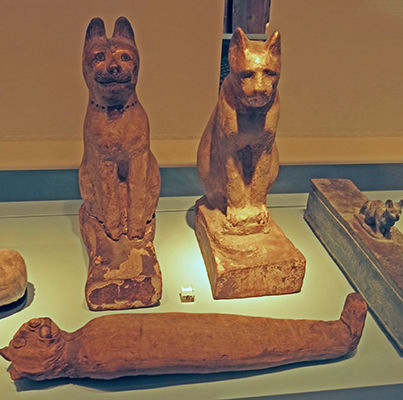
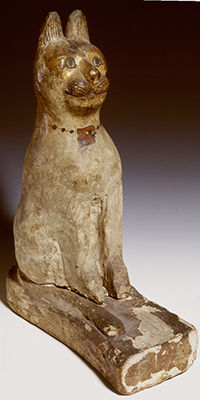
This wooden cat figure serves as a sheath for the mummy of a cat. To this end, it is manufactured in two parts and hollowed out on the inside. The mummy is still in it.
The cavity is open at the bottom and is closed by placing the figure on a pedestal This base has a form of the hieroglyph 'protection', which is often a sign associated with cats. The base and pedestal are covered with stucco and painted. Around the neck is a necklace with a picture of an amulet of the protective eye (wedjat). On top of the head a scarab is painted between the ears. Everything indicates that this cat was embalmed and buried with great care.
Height: 41 cm, late period or Ptolemaic.
Photo (left): Don Hitchcock 2014
Photo (right): https://www.google.com/culturalinstitute/asset-viewer/holder-for-a-cat-mummy/tgHi0pLW5_LIrg?projectId=art-project
Source: Original, Rijksmuseum van Oudheden, National Museum of Antiquities, Leiden.
Text: http://www.rmo.nl/onderwijs/museumkennis/verhalen/kattensarcofaag-en--mummie
References
- Budge E., 1920: Egyptian Hieroglyphic Dictionary, Vol. 1 (1920), London, John Murray, Albemarle St.
- Goelet O., 1998: A Commentary on the Corpus of Literature and Tradition which constitutes the Book of Going Forth By Day, San Francisco: Chronicle Books.
- Harer W., 1985: Pharmacological and Biological Properties of the Egyptian Lotus, Journal of the American Research Center in Egypt, Vol. 22 (1985), pp. 49-54 Published by: American Research Center in Egypt DOI: 10.2307/40000390
- Kákosy L., 1995: 'The Soter Tomb in Thebes', in S.P, Vleeming (ed.), Hundred-Gated Thebes: Acts of a Colloqium on Thebes and the Theban area in the Graeco-Roman Period, Leiden: Brill, 61- 67
- Kühne L., 1987: 'Evidence for a new interpretation of the Berlin Celestial Globe fragment SK1050A, http://philsci-archive.pitt.edu/8814/1/SK1050A_100.pdf, Balliol.org
- Liebpert U., 1701: Thesauri Regii et Electoralis Brandenburgici Volume Tertium,Volume 3, [Volume III of the Thesaurus Brandenburgicus selectus with Greek and Roman coins and cut stones, sculptures, small bronzes, terracottas, Aegyptiaca, clay lamps, clay and glass vessels], p. 402
- Martin G., 1991: Hidden Tombs of Memphis, Thames and Hudson, London 1991
- Maspero G., 1903: History of Egypt, Chaldea, Syria, Babylonia, and Assyria, London : Grolier Society
- Pommerening, T., Marinova, E., Hendrickx, S., 2010: The Early Dynastic origin of the water-lily motif, Chronique d’Egypte, 85 (2010): 14-40
- Raven M., 1980: Papyrus-sheaths and Ptah-Sokar-Osiris Statues, RMO, 1980 - 296 pages
- Riggs C., 2006: The Beautiful Burial in Roman Egypt: Art, Identity, and Funerary Religion, OUP Oxford, 5 Jan. 2006 - History - 336 pages
- Strudwick N., 2006: Masterpieces of Ancient Egypt, University of Texas Press, 1 Nov. 2006 - Social Science - 352 pages
- Taylor J., 2010: Journey Through the Afterlife: Ancient Egyptian Book of the Dead, Harvard University Press, 2010 - History - 320 pages
- Welsby D., 1998: The Kingdom of Kush, Princeton: Markus Wiener Publishers, 1998
Back to Don's Maps
 Back to Archaeological Sites
Back to Archaeological Sites
 Back to Egypt Index Page
Back to Egypt Index Page

